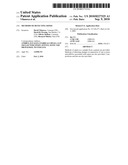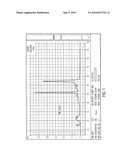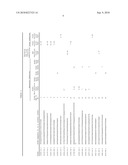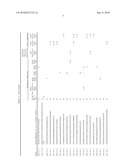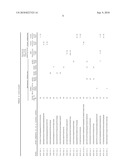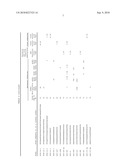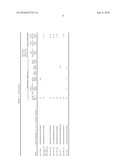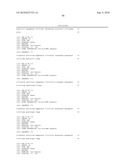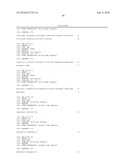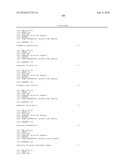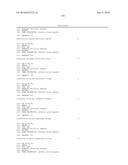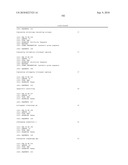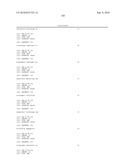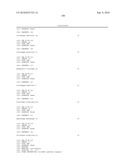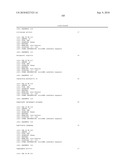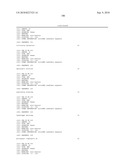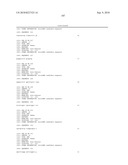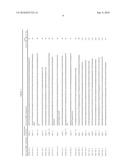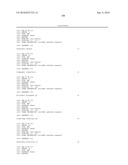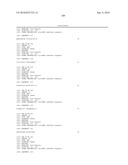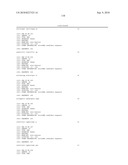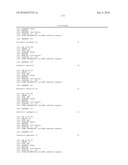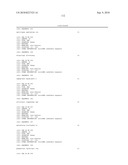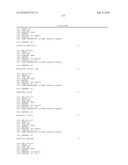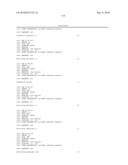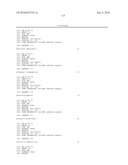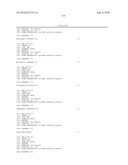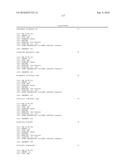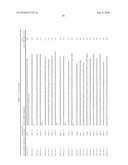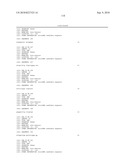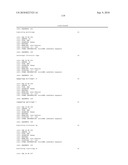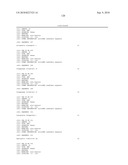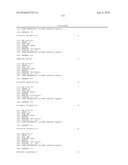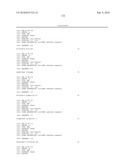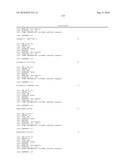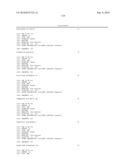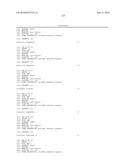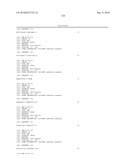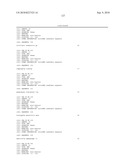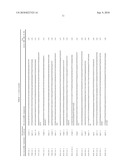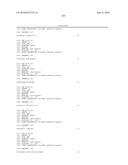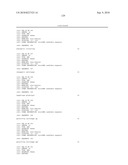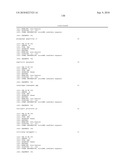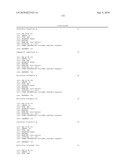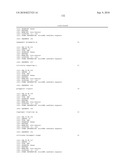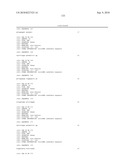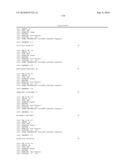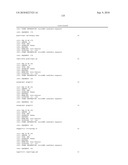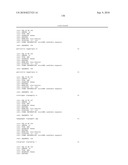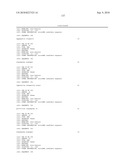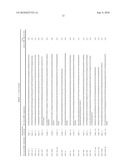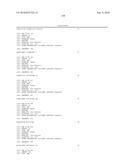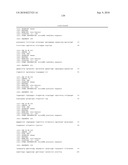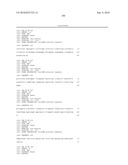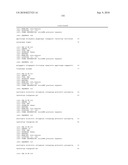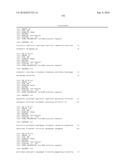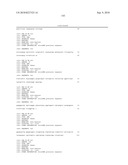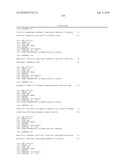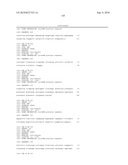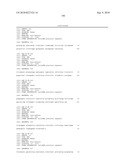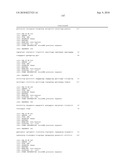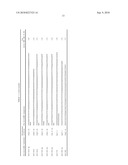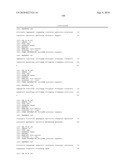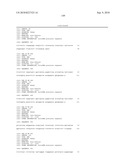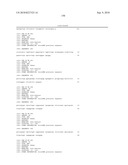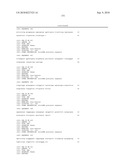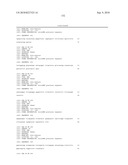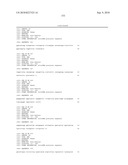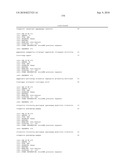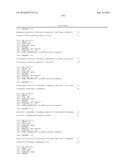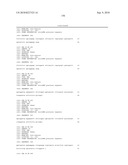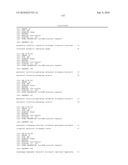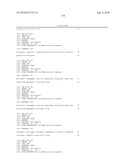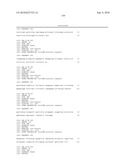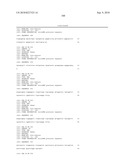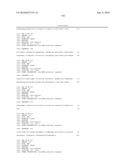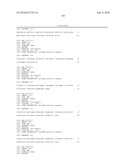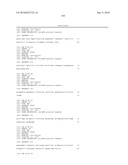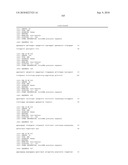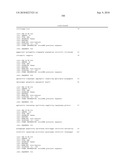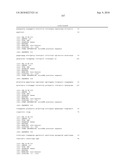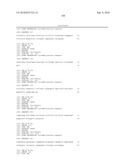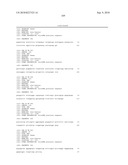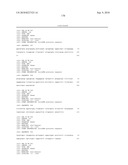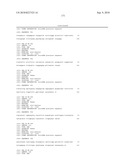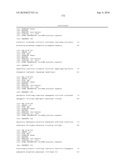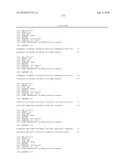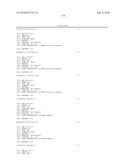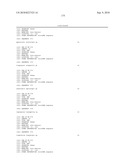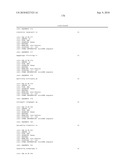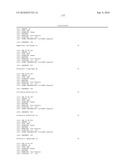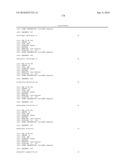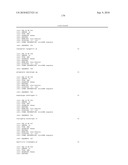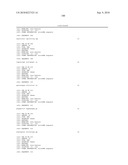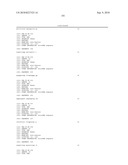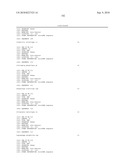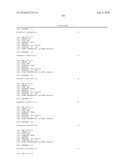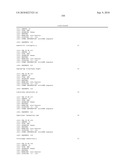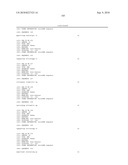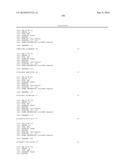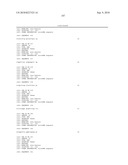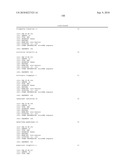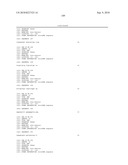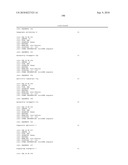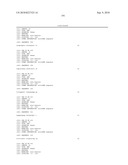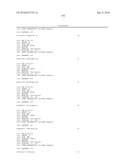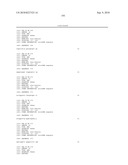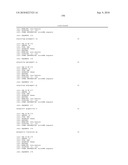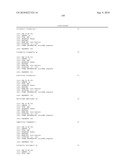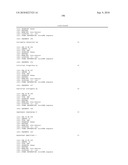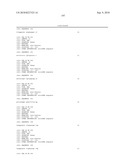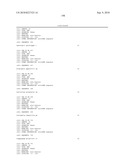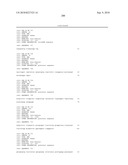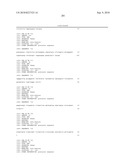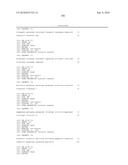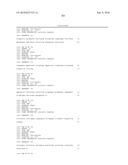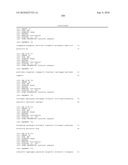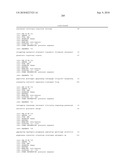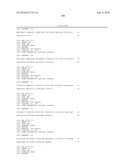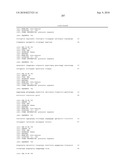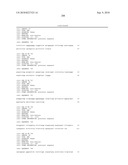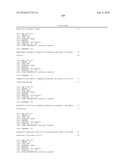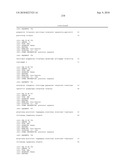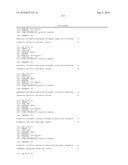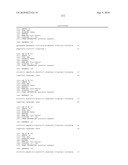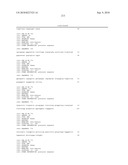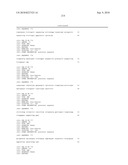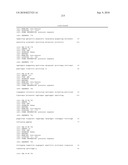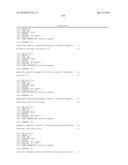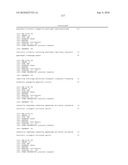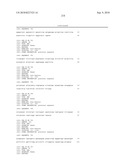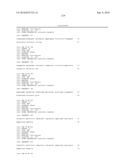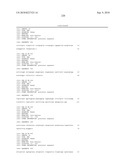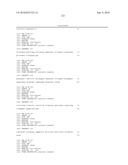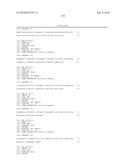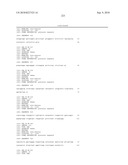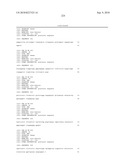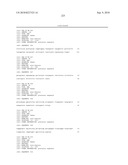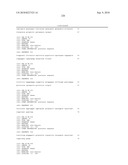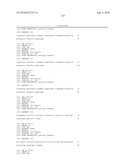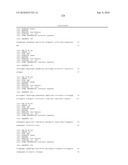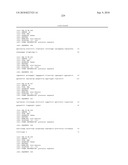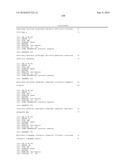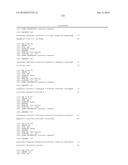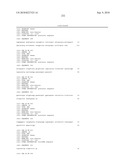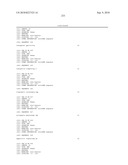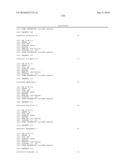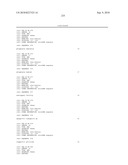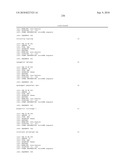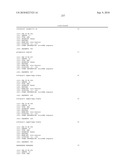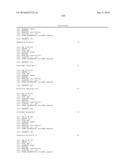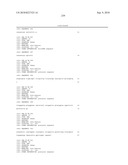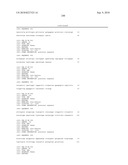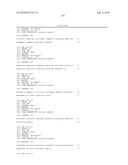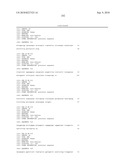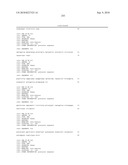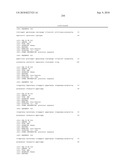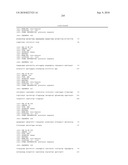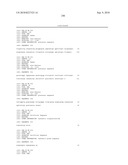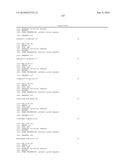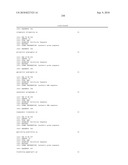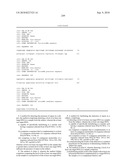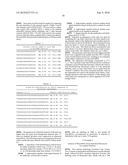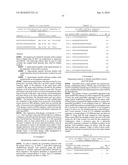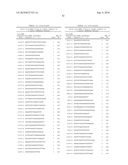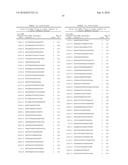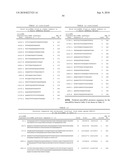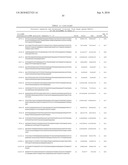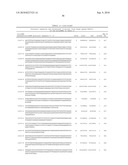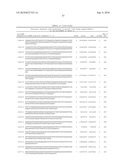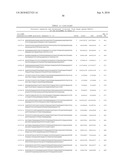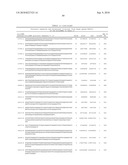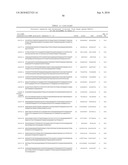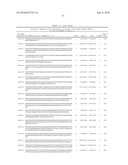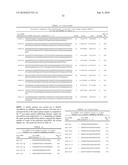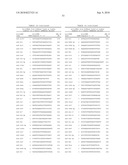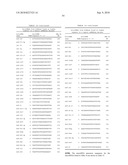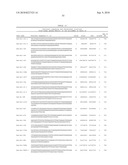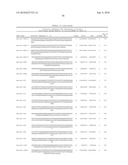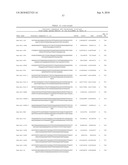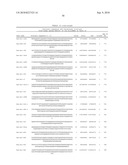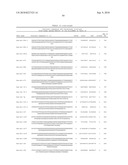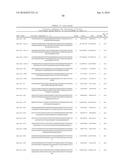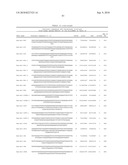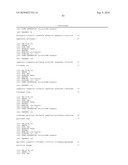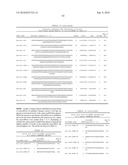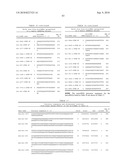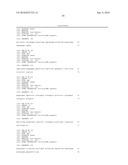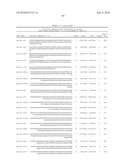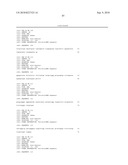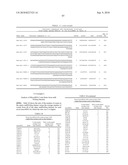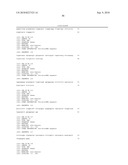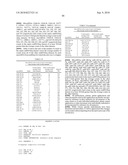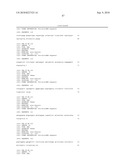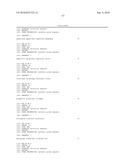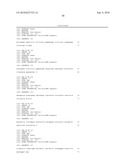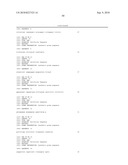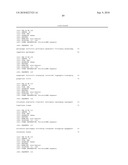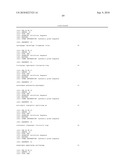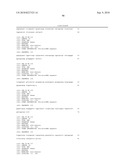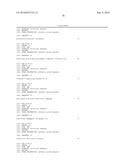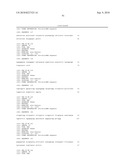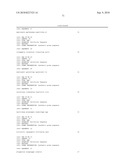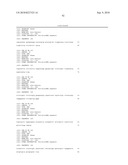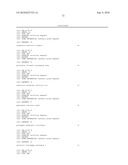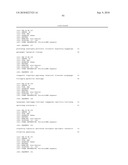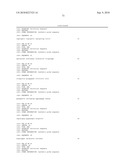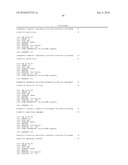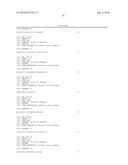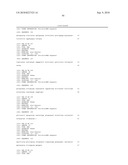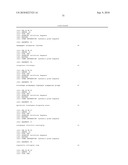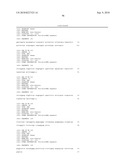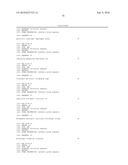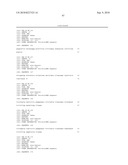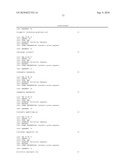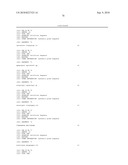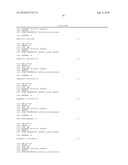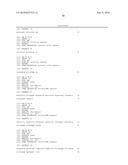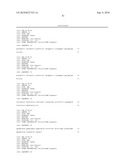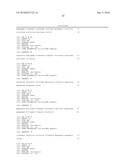Patent application title: METHODS OF DETECTING SEPSIS
Inventors:
David Vilanova (Caraman, FR)
David H. Persing (San Martin, CA, US)
Olivier Delfour (Caraman, FR)
Olivier Delfour (Caraman, FR)
Bernard Michot (Pern, FR)
Bernard Michot (Pern, FR)
IPC8 Class: AC12Q168FI
USPC Class:
435 6
Class name: Chemistry: molecular biology and microbiology measuring or testing process involving enzymes or micro-organisms; composition or test strip therefore; processes of forming such composition or test strip involving nucleic acid
Publication date: 2010-09-09
Patent application number: 20100227325
Claims:
1. A method for detecting the presence of sepsis in a subject, the method
comprising detecting a level of at least one target RNA in a sample from
the subject, wherein the at least one target RNA:is capable of
specifically hybridizing to a nucleic acid having a sequence selected
from SEQ ID NOs: 1 to 86; or(ii) comprises a sequence that is
complementary to at least 15 contiguous nucleotides of a sequence
selected from SEQ ID NOs: 1 to 86; or(iii) comprises at least 15
contiguous nucleotides of a sequence selected from SEQ ID NOs: 196 to
399, 950, 565 to 707, and 863 to 897;wherein a level of at least one
target RNA in the sample that is greater than a normal level of the at
least one target RNA indicates the presence of sepsis in the subject.
2. The method of claim 1, wherein the method further comprises comparing the level of the at least one target RNA in the sample to a normal level of the at least one target RNA.
3. A method for facilitating the detection of sepsis in a subject, comprising:(a) detecting a level of at least one target RNA in a sample from the subject, wherein the at least one target RNA:is capable of specifically hybridizing to a nucleic acid having a sequence selected from SEQ ID NOs: 1 to 86; or(ii) comprises a sequence that is complementary to at least 15 contiguous nucleotides of a sequence selected from SEQ ID NOs: 1 to 86; or(iii) comprises at least 15 contiguous nucleotides of a sequence selected from SEQ ID NOs: 196 to 399, 950, 565 to 707, and 863 to 897; and(b) communicating the results of the detection to a medical practitioner for the purpose of determining whether the subject has sepsis.
4. The method of claim 1, wherein detecting a level of at least one target RNA in a sample comprises:(a) hybridizing nucleic acids of the sample with at least one polynucleotide that is complementary to a target RNA in the sample or to a complement thereof; and(b) detecting at least one complex comprising a polynucleotide hybridized to at least one nucleic acid selected from the target RNA, a DNA amplicon of the target RNA, and a complement of the target RNA.
5. A method for detecting the presence of sepsis in a subject, comprising:(a) obtaining a sample from the subject,(b) providing the sample to a laboratory for detection of the level of at least one target RNA in the sample, wherein the at least one target RNA:(i) is capable of specifically hybridizing to a nucleic acid having a sequence selected from SEQ ID NOs: 1 to 86; or(ii) comprises a sequence that is complementary to at least 15 contiguous nucleotides of a sequence selected from SEQ ID NOs: 1 to 86; or(iii) comprises at least 15 contiguous nucleotides of a sequence selected from SEQ ID NOs: 196 to 399, 950, 565 to 707, and 863 to 897; and(c) receiving from the laboratory a communication indicating the level of at least one target RNA in the sample;wherein a level of at least one target RNA that is greater than a normal level of the at least one target RNA indicates the presence of sepsis.
6. The method of claim 1, wherein the method further comprises isolating nucleic acids from the sample.
7. The method of claim 6, wherein the nucleic acids comprise RNA that has been separated from DNA.
8. The method of claim 1, wherein at least one target RNA in its mature form comprises fewer than 30 nucleotides.
9. The method of claim 1, wherein at least one target RNA is a microRNA.
10. The method of claim 1, wherein levels of at least two target RNAs are detected, wherein at least two of the target RNAs:are capable of specifically hybridizing to a nucleic acid having a sequence selected from SEQ ID NOs: 1 to 86; or(ii) comprise a sequence that is complementary to at least 15 contiguous nucleotides of a sequence selected from SEQ ID NOs: 1 to 86; or(iii) comprise at least 15 contiguous nucleotides of a sequence selected from SEQ ID NOs: 196 to 399, 950, 565 to 707, and 863 to 897; andwherein the at least two target RNAs are different.
11. The method of claim 10, wherein detection of a level of at least one target RNA that is greater than a normal level of the at least one target RNA indicates the presence of sepsis.
12. The method of claim 10, wherein detection of levels of at least two target RNAs that are greater than normal levels of the at least two target RNAs indicates the presence of sepsis.
13. The method of claim 10, wherein levels of at least three target RNAs are detected, wherein at least three of the target RNAs:are capable of specifically hybridizing to a nucleic acid having a sequence selected from SEQ ID NOs: 1 to 86; or(ii) comprise a sequence that is complementary to at least 15 contiguous nucleotides of a sequence selected from SEQ ID NOs: 1 to 86; or(iii) comprise at least 15 contiguous nucleotides of a sequence selected from SEQ ID NOs: 196 to 399, 950, 565 to 707, and 863 to 897; andwherein the at least three target RNAs are different.
14. The method of claim 13, wherein detection of a level of at least one target RNA that is greater than a normal level of the at least one target RNA indicates the presence of sepsis.
15. The method of claim 13, wherein detection of levels of at least two target RNAs that are greater than normal levels of the at least two target RNAs indicates the presence of sepsis.
16. The method of claim 13, wherein detection of levels of at least three target RNAs that are greater than normal levels of the at least three target RNAs indicates the presence of sepsis.
17. The method of claim 10, wherein levels of at least five target RNAs are detected.
18. The method of claim 10, wherein a level is detected of at least one target RNA that:(i) does not specifically hybridize to a nucleic acid having a sequence selected from SEQ ID NOs: 1 to 86; or(ii) does not comprise a sequence that is complementary to at least 15 contiguous nucleotides of a sequence selected from SEQ ID NOs: 1 to 86; and(iii) does not comprise at least 15 contiguous nucleotides of a sequence selected from SEQ ID NOs: 196 to 399, 950, 565 to 707, and 863 to 897.
19. The method of claim 1, wherein at least one target RNA:(a) is capable of specifically hybridizing to a sequence selected from SEQ ID NOs: 1, 2, 3, 4, 5, 7, 10, 12, 16, 18, 22, 24, 25, 26, 28, 30, 31, 32, 35, 36, 37, 41, 42, 43, 44, 53, 54, 55, 60, 61, 63, 65, 66, 68, 71, 77, 80, 81, 82, 83 and 85; or(b) comprises a sequence that is complementary to at least 15 contiguous nucleotides of a sequence selected from SEQ ID NOs: 1, 2, 3, 4, 5, 7, 10, 12, 16, 18, 22, 24, 25, 26, 28, 30, 31, 32, 35, 36, 37, 41, 42, 43, 44, 53, 54, 55, 60, 61, 63, 65, 66, 68, 71, 77, 80, 81, 82, 83 and 85.
20. The method of claim 19, wherein detection of a level of the at least one target RNA that is greater than a normal level of the at least one target RNA indicates the presence of sepsis caused by viral infection.
21. The method of claim 1, wherein at least one target RNA:(a) is capable of specifically hybridizing to a sequence selected from SEQ ID NOs: 6, 8, 11, 13, 14, 15, 17, 19, 20, 21, 23, 27, 29, 30, 33, 34, 35, 38, 39, 45, 46, 47, 48, 49, 52, 56, 57, 58, 59, 60, 62, 63, 64, 65, 67, 69, 71, 73, 74, 76, 78, 79, 84 and 86; or(b) comprises a sequence that is complementary to at least 15 contiguous nucleotides of a sequence selected from SEQ ID NOs: 6, 8, 11, 13, 14, 15, 17, 19, 20, 21, 23, 27, 29, 30, 33, 34, 35, 38, 39, 45, 46, 47, 48, 49, 52, 56, 57, 58, 59, 60, 62, 63, 64, 65, 67, 69, 71, 73, 74, 76, 78, 79, 84 and 86.
22. The method of claim 21, wherein detection of a level of the at least one target RNA that is greater than a normal level of the at least one target RNA indicates the presence of sepsis caused by bacterial infection.
23. The method of claim 1, wherein at least one target RNA:(a) is capable of specifically hybridizing to a sequence selected from SEQ ID NOs: 6, 11, 13, 15, 17, 19, 20, 21, 27, 29, 33, 34, 35, 38, 45, 46, 47, 48, 49, 56, 58, 69, 71, 73, 76, 84 and 86; or(b) comprises a sequence that is complementary to at least 15 contiguous nucleotides of a sequence selected from SEQ ID NOs: 6, 11, 13, 15, 17, 19, 20, 21, 27, 29, 33, 34, 35, 38, 45, 46, 47, 48, 49, 56, 58, 69, 71, 73, 76, 84 and 86.
24. The method of claim 23, wherein detection of a level of the at least one target RNA that is greater than a normal level of the at least one target RNA indicates the presence of sepsis caused by an infection of gram negative bacteria.
25. The method of claim 1, wherein at least one target RNA:(a) is capable of specifically hybridizing to a sequence selected from SEQ ID NOs: 23, 30, 39, 52, 57, 60 65, 67 and 79; or(b) comprises a sequence that is complementary to at least 15 contiguous nucleotides of a sequence selected from SEQ ID NOs: 23, 30, 39, 52, 57, 60 65, 67 and 79.
26. The method of claim 25, wherein detection of a level of the at least one target RNA that is greater than a normal level of the at least one target RNA indicates the presence of sepsis caused by an infection of gram positive bacteria.
27. The method of claim 1, wherein at least one target RNA:(a) is capable of specifically hybridizing to a sequence selected from SEQ ID NOs: 8, 14, 59, 62, 63, 64, 74 and 78; or(b) comprises a sequence that is complementary to at least 15 contiguous nucleotides of a sequence selected from SEQ ID NOs: 8, 14, 59, 62, 63, 64, 74 and 78.
28. The method of claim 27, wherein detection of a level of the at least one target RNA that is greater than a normal level of the at least one target RNA indicates the presence of sepsis caused by an infection of gram positive bacteria or mycobacteria.
29. The method of claim 1, wherein at least one target RNA:(a) is capable of specifically hybridizing to a sequence selected from SEQ ID NOs: 9, 50, 51, 70, 72 and 75; or(b) comprises a sequence that is complementary to at least 15 contiguous nucleotides of a sequence selected from SEQ ID NOs: 9, 50, 51, 70, 72 and 75.
30. The method of claim 29, wherein detection of a level of the at least one target RNA that is greater than a normal level of the at least one target RNA indicates the presence of unmethylated CpG nucleic acids caused by a bacterial infection, a viral infection, or both.
31. The method of claim 1, wherein at least one target RNA:(a) is capable of specifically hybridizing to a sequence selected from SEQ ID NOs: 1, 2, 3, 4, 5, 7, 10, 12, 16, 18, 22, 24, 25, 26, 28, 30, 31, 32, 35, 36, 37, 41, 42, 43, 44, 53, 54, 55, 60, 61, 63, 65, 66, 68, 71, 77, 80, 81, 82, 83 and 85; or(b) comprises a sequence that is complementary to at least 15 contiguous nucleotides of a sequence selected from SEQ ID NOs: 1, 2, 3, 4, 5, 7, 10, 12, 16, 18, 22, 24, 25, 26, 28, 30, 31, 32, 35, 36, 37, 41, 42, 43, 44, 53, 54, 55, 60, 61, 63, 65, 66, 68, 71, 77, 80, 81, 82, 83 and 85.
32. The method of claim 31, wherein detection of a level of the at least one target RNA that is greater than a normal level of the at least one target RNA indicates stimulation of at least one toll-like receptor that recognizes virally-derived molecules.
33. The method of claim 1, wherein at least one target RNA:(a) is capable of specifically hybridizing to a sequence selected from SEQ ID NOs: 6, 8, 11, 13, 14, 15, 17, 19, 20, 21, 23, 27, 29, 30, 33, 34, 35, 38, 39, 45, 46, 47, 48, 49, 52, 56, 57, 58, 59, 60, 62, 63, 64, 65, 67, 69, 71, 73, 74, 76, 78, 79, 84 and 86; or(b) comprises a sequence that is complementary to at least 15 contiguous nucleotides of a sequence selected from SEQ ID NOs: 6, 8, 11, 13, 14, 15, 17, 19, 20, 21, 23, 27, 29, 30, 33, 34, 35, 38, 39, 45, 46, 47, 48, 49, 52, 56, 57, 58, 59, 60, 62, 63, 64, 65, 67, 69, 71, 73, 74, 76, 78, 79, 84 and 86.
34. The method of claim 33, wherein detection of a level of the at least one target RNA that is greater than a normal level of the at least one target RNA indicates stimulation of at least one toll-like receptor that recognizes bacterially-derived molecules.
35. The method of claim 1, wherein at least one target RNA:(a) is capable of specifically hybridizing to a sequence selected from SEQ ID NOs: 6, 11, 13, 15, 17, 19, 20, 21, 27, 29, 33, 34, 35, 38, 45, 46, 47, 48, 49, 56, 58, 69, 71, 73, 76, 84 and 86; or(b) comprises a sequence that is complementary to at least 15 contiguous nucleotides of a sequence selected from SEQ ID NOs: 6, 11, 13, 15, 17, 19, 20, 21, 27, 29, 33, 34, 35, 38, 45, 46, 47, 48, 49, 56, 58, 69, 71, 73, 76, 84 and 86.
36. The method of claim 35, wherein detection of a level of the at least one target RNA that is greater than a normal level of the at least one target RNA indicates stimulation of at least one toll-like receptor that recognizes gram positive bacterially-derived molecules.
37. The method of claim 1, wherein at least one target RNA:(a) is capable of specifically hybridizing to a sequence selected from SEQ ID NOs: 23, 30, 39, 52, 57, 60 65, 67 and 79; or(b) comprises a sequence that is complementary to at least 15 contiguous nucleotides of a sequence selected from SEQ ID NOs: 23, 30, 39, 52, 57, 60 65, 67 and 79.
38. The method of claim 37, wherein detection of a level of the at least one target RNA that is greater than a normal level of the at least one target RNA indicates stimulation of at least one toll-like receptor that recognizes gram positive bacterially-derived molecules.
39. The method of claim 1, wherein at least one target RNA:(a) is capable of specifically hybridizing to a sequence selected from SEQ ID NOs: 8, 14, 59, 62, 63, 64, 74 and 78; or(b) comprises a sequence that is complementary to at least 15 contiguous nucleotides of a sequence selected from SEQ ID NOs: 8, 14, 59, 62, 63, 64, 74 and 78.
40. The method of claim 39, wherein detection of a level of the at least one target RNA that is greater than a normal level of the at least one target RNA indicates stimulation of at least one toll-like receptor that recognizes gram positive bacterially-derived molecules, mycobacterially-derived molecules, or both.
41. The method of claim 1, wherein at least one target RNA:(a) is capable of specifically hybridizing to a sequence selected from SEQ ID NOs: 9, 50, 51, 70, 72 and 75; or(b) comprises a sequence that is complementary to at least 15 contiguous nucleotides of a sequence selected from SEQ ID NOs: 9, 50, 51, 70, 72 and 75.
42. The method of claim 41, wherein detection of a level of the at least one target RNA that is greater than a normal level of the at least one target RNA indicates stimulation of at least one toll-like receptor that recognizes unmethylated CpG nucleic acids caused by bacterial infection, viral infection, or both.
43. The method of claim 1, wherein at least one target RNA comprises at least 15 contiguous nucleotides of a sequence selected from SEQ ID NOs: 226 to 289, 565 to 604, and 863 to 868.
44. The method of claim 1, wherein at least one target RNA comprises at least 15 contiguous nucleotides of a sequence selected from SEQ ID NOs: 231, 236, 237, 242, 245, 253, 260, 261, 262, 263, 266, 269, 275, 287, 303, 342, 352, 566, 567, 568, 571, 570, 573, 574, 575, 577, 579, 580, 581, 588, 591, 598, 601, 608, 612, 613, 624, 626, 629, 632, 635, 637, 641, 642, 644, and 648.
45. The method of claim 1, wherein at least one target RNA comprises at least 15 contiguous nucleotides of a sequence selected from SEQ ID NOs: 231, 236, 242, 260, 261, 266, 287, 566, 567, 568, 571, 570, 574, 580, 581, 588, 598, 601, 608, 624, 626, 629, and 632.
46. The method of claim 1, wherein the sample from the subject is a blood sample.
47. The method of claim 46, wherein the sample is monocytes.
48. A synthetic polynucleotide comprising a first region, wherein the first region comprises a sequence of at least 8 contiguous nucleotides that is identical or complementary to a sequence of at least 8 contiguous nucleotides of one of SEQ ID NOs: 1 to 67 and 215 to 399 and 950.
49. The synthetic polynucleotide of claim 48, wherein the first region comprises a sequence of at least 9 contiguous nucleotides that is identical or complementary to a sequence of at least 9 contiguous nucleotides of one of SEQ ID NOs: 1 to 67 and 215 to 399 and 950.
50. The synthetic polynucleotide of claim 48, wherein the first region comprises a sequence of at least 10 contiguous nucleotides that is identical or complementary to a sequence of at least 10 contiguous nucleotides of one of SEQ ID NOs: 1 to 67 and 215 to 399 and 950.
51. The synthetic polynucleotide of claim 48, wherein the first region comprises a sequence of at least 12 contiguous nucleotides that is identical or complementary to a sequence of at least 12 contiguous nucleotides of one of SEQ ID NOs: 1 to 67 and 215 to 399 and 950.
52. The synthetic polynucleotide of claim 48, wherein the polynucleotide comprises a detectable label.
53. The synthetic polynucleotide of claim 52, wherein the detectable label is a FRET label.
54. The synthetic polynucleotide of claim 48, wherein the first region is identical or complementary to a region of a target RNA.
55. The synthetic polynucleotide of claim 54, wherein the polynucleotide further comprises a second region that is not identical or complementary to a region of the target RNA.
56. A composition comprising a plurality of synthetic polynucleotides, wherein at least one polynucleotide comprises a first region comprising a sequence of at least 8 contiguous nucleotides that is identical or complementary to a sequence of at least 8 contiguous nucleotides of one or more of SEQ ID NOs: 1 to 67 and 215 to 399 and 950.
57. The composition of claim 56, wherein at least two polynucleotides of the plurality of synthetic polynucleotides comprise a first region comprising a sequence of at least 9 contiguous nucleotides that is identical or complementary to a sequence of at least 9 contiguous nucleotides of one or more of SEQ ID NOs: 1 to 67 and 215 to 399 and 950, and wherein the first regions of the at least two polynucleotides are different.
58. The composition of claim 56, wherein at least three polynucleotides of the plurality of synthetic polynucleotides comprise a first region comprising a sequence of at least 10 contiguous nucleotides that is identical or complementary to a sequence of at least 10 contiguous nucleotides of one or more of SEQ ID NOs: 1 to 67 and 215 to 399 and 950, and wherein the first regions of the at least three polynucleotides are different.
59. The composition of claim 56, wherein at least five polynucleotides of the plurality of synthetic polynucleotides comprise a first region comprising a sequence of at least 12 contiguous nucleotides that is identical or complementary to a sequence of at least 12 contiguous nucleotides of one or more of SEQ ID NOs: 1 to 67 and 215 to 399 and 950, and wherein the first regions of the at least five polynucleotides are different.
60. A kit comprising a synthetic polynucleotide of claim 48.
61. A kit comprising a composition of claim 56.
62. The kit of claim 60, wherein the kit further comprises at least one polymerase.
63. The kit of claim 60, wherein the kit further comprises dNTPs.
Description:
[0001]This application claims priority to U.S. Provisional Application No.
61/149,277, filed Feb. 2, 2009, which is incorporated by reference herein
in its entirety for any purpose.
1. BACKGROUND
[0002]Sepsis is the presence in the blood or other tissues of pathogenic microorganisms or their toxins combined with the host's inflammatory response, known as systemic inflammatory response syndrome ("SIRS") caused by the infection. The immune response is mediated by a class of proteins called toll-like receptors ("TLR") that recognize structurally-conserved molecules broadly shared by microorganisms but which are distinguishable from host molecules.
[0003]Once microorganisms have breached barriers such as the skin or intestinal tract, the body's TLRs recognize them and stimulate an immune response. Thus, in addition to symptoms caused by the microbial infection itself, sepsis is also characterized by symptoms of acute inflammation brought on by the host's immune response. These latter symptoms may include fever and elevated white blood cell count, or low white blood cell count and low body temperature. SIRS is characterized by hemodynamic compromise and resultant metabolic dysregulation, and may be accompanied by symptoms such as high heart rate, high respiratory rate and elevated body temperature. The immunological response also causes widespread activation of acute phase proteins, affecting the complement system and the coagulation pathways, which then cause damage to the vasculature and organs. Various neuroendocrine counter-regulatory systems are then activated as well, often compounding the problem.
[0004]Sepsis is often treated in the intensive care unit with intravenous fluids and antibiotics and/or antiviral compounds. However sepsis progresses quickly, and so even with immediate and aggressive treatment, severe sepsis can lead to organ failure and death. Severe sepsis is estimated to cause 215,000 deaths per year in the United States, more than acute myocardial infarction, stroke or pneumonia, which is likely due to late diagnosis or misdiagnosis of sepsis.
[0005]Thus, there is a need for early molecular markers in detecting sepsis.
2. SUMMARY
[0006]Methods for detecting the presence of sepsis in a subject are provided. In some embodiments, a method comprises detecting a level of at least one target RNA in a sample from the subject. In some embodiments, the at least one target RNA (1) is capable of specifically hybridizing to a nucleic acid having a sequence selected from SEQ ID NOs: 1 to 86; or (ii) comprises a sequence that is complementary to at least 15 contiguous nucleotides of a sequence selected from SEQ ID NOs: 1 to 86; or (iii) comprises at least 15 contiguous nucleotides of a sequence selected from SEQ ID NOs: 196 to 399, 950, 565 to 707, and 863 to 897. In some embodiments, a method comprises comparing the level of the at least one target RNA in the sample to a normal level of the at least one target RNA. In some embodiments, a level of at least one target RNA in the sample that is greater than a normal level of the at least one target RNA indicates the presence of sepsis in the subject.
[0007]Methods for facilitating the detection of sepsis in a subject are also provided. In some embodiments, the method comprises detecting a level of at least one target RNA in a sample from the subject. In some embodiments, the at least one target RNA (i) is capable of specifically hybridizing to a nucleic acid having a sequence selected from SEQ ID NOs: 1 to 86; or (ii) comprises a sequence that is complementary to at least 15 contiguous nucleotides of a sequence selected from SEQ ID NOs: 1 to 86; or (iii) comprises at least 15 contiguous nucleotides of a sequence selected from SEQ ID NOs: 196 to 399, 950, 565 to 707, and 863 to 897. In some embodiments, a method comprises communicating the results of the detection to a medical practitioner for the purpose of determining whether the subject has sepsis.
[0008]In some embodiments, detecting a level of at least one target RNA in a sample comprises hybridizing nucleic acids of the sample with at least one polynucleotide that is complementary to a target RNA in the sample or to a complement thereof. In some embodiments, a method further comprises detecting at least one complex comprising a polynucleotide hybridized to at least one nucleic acid selected from the target RNA, a DNA amplicon of the target RNA, and a complement of the target RNA.
[0009]In some embodiments, a method for detecting the presence of sepsis in a subject comprises obtaining a sample from the subject and providing the sample to a laboratory for detection of the level of at least one target RNA in the sample. In some embodiments, the at least one target RNA: (i) is capable of specifically hybridizing to a nucleic acid having a sequence selected from SEQ ID. NOs: 1 to 86; or (ii) comprises a sequence that is complementary to at least 15 contiguous nucleotides of a sequence selected from SEQ ID NOs: Ito 86; or (iii) comprises at least 15 contiguous nucleotides of a sequence selected from SEQ ID NOs: 196 to 399, 950, 565 to 707, and 863 to 897. In some embodiments, the method comprises receiving from the laboratory a communication indicating the level of at least one target RNA in the sample. In some embodiments, a level of at least one target RNA that is greater than a normal level of the at least one target RNA indicates the presence of sepsis.
[0010]In some embodiments, a method comprises detecting levels of at least two, at least three, at least five, or at least ten target RNAs. In some embodiments, detection of a level of at least one target RNA that is greater than a normal level of the at least one target RNA indicates the presence of sepsis. In some embodiments, detection of levels of at least two target RNAs that are greater than normal levels of the at least two target RNAs indicates the presence of sepsis. In some embodiments, detection of levels of at least three target RNAs that are greater than normal levels of the at least two target RNAs indicates the presence of sepsis. In some embodiments, detection of levels of at least five target RNAs that are greater than normal levels of the at least two target RNAs indicates the presence of sepsis.
[0011]In some embodiments, a method comprises detecting a level of at least one target RNA that (i) does not specifically hybridize to a nucleic acid having a sequence selected from SEQ ID NOs: 1 to 86; and (ii) does not comprise a sequence that is complementary to at least 15 contiguous nucleotides of a sequence selected from SEQ ID NOs: 1 to 86; and (iii) does not comprise at least 15 contiguous nucleotides of a sequence selected from SEQ ID NOs: 196 to 399, 950, 565 to 707, and 863 to 897.
[0012]In some embodiments, a synthetic polynucleotide is provided. In some embodiments, a synthetic polynucleotide comprises a first region, wherein the first region comprises a sequence of at least 8, at least 9, at least 10, at least 11, at least 12, at least 13, at least 14, at least 15, at least 16, at least 17, or at least 18 contiguous nucleotides that is identical or complementary to a sequence of at least 8 contiguous nucleotides of one of SEQ ID NOs: 1 to 67, 215 to 399, and 950. In some embodiments, the first region is identical or complementary to a region of a target RNA. In some embodiments, a synthetic polynucleotide comprises a second region that is not identical or complementary to a region of the target RNA. In some embodiments, a synthetic polynucleotide comprises a detectable label. In some embodiments, a synthetic polynucleotide comprises a FRET label.
[0013]In some embodiments, a composition is provided. In some embodiments, a composition comprises a plurality of synthetic polynucleotides. In some embodiments, a kit is provided. In some embodiments, a kit comprises a synthetic polynucleotide. In some embodiments, a kit comprises a composition. In some embodiments, a kit comprises at least one polymerase and/or dNTPs.
[0014]Further embodiments and details of the inventions are described below
3. BRIEF DESCRIPTION OF THE FIGURES
[0015]FIG. 1 shows an electropherogram obtained on an Agilent Bioanalyser 2100 to assess the quality of total RNA purified as described in Example 1 from human monocyte cell line THP-1 after stimulation for 8 h with an agonist, Pam3CSK4.
4. DETAILED DESCRIPTION
[0016]4.1. Detecting Sepsis
[0017]4.1.1. General Methods
[0018]Methods detecting sepsis by measuring levels of microRNA species are provided. In some embodiments, elevated levels of microRNA species are indicative of sepsis. In some embodiments, reduced levels of microRNA species are indicative of sepsis. In some embodiments, the method comprises detecting an above-normal level of at least one target RNA that is capable of specifically hybridizing to a sequence selected from SEQ ID NOs: 1 to 86. In some embodiments, the method comprises detecting an above-normal level of at least one target RNA that comprises at least 15, at least 16, at least 17, at least 18, at least 19, at least 20, at least 21, at least 22, at least 23, or at least 24 contiguous nucleotides of a sequence selected from SEQ ID NO.: 196 to 399, 950, 565 to 707, and 863 to 897. In some embodiments, the method comprises detecting an above-normal level of at least one target RNA that comprises a sequence that is complementary to at least 15, at least 16, at least 17, at least 18, at least 19, at least 20, at least 21, at least 22, at least 23, or at least 24 contiguous nucleotides of a sequence selected from SEQ ID NO.:1 to 86. In some embodiments, the target RNA, in its mature form, comprises fewer than 30 nucleotides. The target RNA, in some embodiments, is a microRNA.
[0019]In the present disclosure, "a sequence selected from" encompasses both "one sequence selected from" and "one or more sequences selected from." Thus, when "a sequence selected from" is used, it is to be understood that one, or more than one of the listed sequences may be chosen.
[0020]Detection of a level of target RNA that is greater than a normal level of target RNA indicates the presence of sepsis in the patient from whom the sample is taken sample. In some embodiments, the detecting is done quantitatively. In other embodiments, the detecting is done qualitatively. In some embodiments, detecting a target RNA comprises forming a complex comprising a polynucleotide and a nucleic acid selected from a target RNA, a DNA amplicon of a target RNA, and a complement of a target RNA. In some embodiments, the level of the complex is then detected and compared to a normal level of the same complex. The level of the complex, in some embodiments, correlates with the level of the target RNA in the sample.
[0021]"Sepsis" is an infection accompanied by an acute inflammatory reaction (systemic inflammatory response syndrome) with systemic manifestations associated with release of endogenous mediators of inflammation into the bloodstream. If left untreated, sepsis can become severe sepsis, which is often accompanied by the failure of at least one organ or septic shock, which is severe sepsis accompanied by organ hypoperfusion and hypotension that are poorly responsive to initial fluid resuscitation. The systemic inflammatory response is mediated by toll-like receptors ("TLRs").
[0022]"Toll-like receptors" or "TLRs" are a class of proteins in vertebrates and invertebrates that recognize particular structurally conserved molecules on microorganisms that are distinguishable from host molecules, and which mediate immune cell responses. TLRs are located either on the surface of cells or in cellular compartments and are classified by the types of molecules they recognize and that stimulate them, as shown in Table 1.
TABLE-US-00001 TABLE 1 Receptor Ligand(s) Microorganism TLR Location TLR1 Multiple triacyl Bacteria Cell surface lipopeptides TLR2 Multiple glycolipids Bacteria Cell surface (TLR2a, Multiple lipopeptides Bacteria TLR2b) Multiple lipoproteins Bacteria Lipoteichoic acid Bacteria Peptidoglycan (Gram positive) bacteria Pam3CSK4 Bacteria TLR3 Double-stranded Viruses Cell compartment RNA, polyl:C TLR4 Lipopolysaccharide Gram-negative Cell surface (TLR4a, bacteria TLR4b) TLR5 Flagellin Bacteria Cell surface TLR7 Single-stranded RNA Virus Cell compartment TLR9 Unmethylated CpG Bacteria, viral Cell compartment DNA
[0023]Stimulation of various TLRs results in over-expression of one or more target RNAs, as shown in Table 2. In some embodiments, one or more target RNAs is over-expressed as a result of stimulation of a subset of TLRs that recognize bacteria (e.g., TLR1, TLR2, TLR4 or TLR5). In some embodiments, one or more target RNAs is over-expressed as a result of stimulation of a subset of TLRs that recognize viruses (e.g. TLR3 or TLR7). In some embodiments, one or more target RNAs is over-expressed as a result of stimulation of a subset of TLRs that recognize molecules common to both bacteria and viruses (TLR9). In some embodiments, one or more target RNAs is over-expressed as a result of stimulation of a subset of TLRs that recognize gram-negative bacteria (e.g., TLR4a and TLR4b). In some embodiments, one or more target RNAs is over-expressed as a result of stimulation of a subset of TLRs that recognize both gram-negative and gram-positive bacteria (e.g., TLR2a, TLR2b and TLR5). In some embodiments, one or more target RNAs is over-expressed as a result of stimulation of a subset of TLRs that recognize gram-positive bacteria, gram-negative bacteria and mycobacteria (e.g., TLR2a).
[0024]Table 2, below, lists 86 hybridization probes that have been found to be complimentary to, and to hybridize with, target RNAs in human monocytes stimulated with various toll-like receptor agonists (ligands). These target RNAs can be detected at elevated levels in stimulated THP-1 cells as demonstrated in Example 1. Sixty-seven of the probes are complementary to, and hybridize with, novel target RNA species that are expressed in human cells. The other nineteen probes are complementary to, and hybridize with, publicly known microRNAs that have been submitted by others to miRBase (http://microrna.sanger.ac.uk; see Griffiths-Jones S. et al. (2007) Nucl. Acids Res. 36:154-158): hsa-miR-1227, hsa-miR-125b, hsa-miR-125b, hsa-miR-142-3p, hsa- miR-155, hsa-miR-16, hsa-miR-195*, hsa-miR-214, hsa-miR-29b, hsa-miR-326, hsa-miR-371-3p, hsa-miR-371-5p, hsa-miR-374b*, hsa-miR-520c-5p, hsa-miR-526a, hsa-miR-518d-5p, hsa-miR-524-5p, hsa-miR-525-3p, hsa-miR-525-5p, hsa-miR-579, hsa-miR-885-3p and hsa-miR-99b). However, to the knowledge of the inventors, these known microRNAs have not been disclosed to have utility for detection of sepsis. The sequences of those microRNAs are shown in Table 4. Certain candidate microRNAs that may hybridize to certain probes listed in Table 2 are shown in Table 11.
[0025]Table 12, below, lists microRNAs that are present at elevated levels in a sepsis patient sample. Some pairs of microRNAs listed in Table 12 have the same sequences. In such instances, the precursor gene for that microRNA sequence is located at multiple locations in the genome, so the sequence may be from any of those genes. When a precursor gene for a particular microRNA sequence is present at multiple locations in the genome, multiple candidate names are shown (based on each of the precursor genes), with the same ranking and same sequence. One or more of those candidates may be upregulated in the sepsis patient sample. Some of the microRNAs listed in Table 12 are isomirs of one another. When multiple isomirs are listed in Table 12, one or more than one of the isomirs may be present at elevated levels in a sample from a patient with sepsis.
[0026]Table 14 lists microRNAs from miRBase that are present at elevated levels in a sepsis patient sample.
[0027]Table 16 lists microRNA star forms that are present at elevated levels in a sepsis patient sample. While the mature microRNAs for the listed star forms have been identified and are submitted into miRBase, none of the star forms in Table 16 have, to the inventors' knowledge, been previously identified or submitted to miRBase.
[0028]In some embodiments, a method comprises detecting multiple isomirs with a single probe. Detection of an elevated level of one or multiple isomirs is considered to be indicative of sepsis. When multiple microRNAs having the same sequence but are expressed from different genes, one or more of the genes may be upregulated in a sepsis patient. Detection of a microRNA expressed from any one of the genes is considered to be indicative of sepsis.
[0029]For convenience of reference herein, and not by way of limitation, some "target RNA" species are denominated "microRNAs" in the tables set forth herein and Example 1. In some embodiments, the target RNA is a single mature microRNA capable of specifically hybridizing to a hybridization probe set forth in Table 2. In some embodiments, a target RNA is a single mature microRNA that comprises a sequence that is complementary to at least 15 contiguous nucleotides of a sequence selected from SEQ ID NO.:1 to 86. In some embodiments, a target RNA is a single mature microRNA that comprises at least 15 contiguous nucleotides of a sequence selected from SEQ ID NOs: 196 to 399, 950, 565 to 707, and 863 to 897. In some embodiments, target RNA may include a plurality of target RNAs, all of which are capable of specifically hybridizing to a single complementary probe sequence (for example, when two or more target microRNAs are isomirs). In some embodiments, the so-denominated "microRNA" is one or more RNA species capable of specifically hybridizing to the respective hybridization probe, such that one or more target RNAs do not meet canonical definitions for mature microRNAs. In some embodiments, a target RNA is an mRNA. In some embodiments, the "target RNA" is a piwi-interacting RNA (piRNA), i.e., a small RNA expressed in animal cells that is distinct in size (26-31 nt) from microRNA and that forms distinct complexes with Piwi proteins that are involved in transcriptional gene silencing.
[0030]Mature human microRNAs are typically composed of 17-27 contiguous ribonucleotides, and often are 21 or 22 nucleotides in length. The sequences of some target microRNAs that can be detected in accordance with the present disclosure can be found within the pre-microRNA sequences shown in Tables 3, 13, 15, and 17 (SEQ ID NOs: 87 to 177, 948, 400 to 564, 949, 708 to 862, and 898 to 932). The sequences of some publicly known microRNAs are shown in Tables 4 and 14. Further, in some embodiments, a microRNA comprises at least 10, at least 11, at least 12, at least 13, at least 14, at least 15, at least 16, at least 17, at least 18, at least 19, at least 20, at least 21, at least 22, at least 23, at least 24, at least 25, or at least 26 contiguous nucleotides of a sequence in Table 11, 12, or 16 (SEQ ID NOs: 215 to 399, 950, and 863 to 897).
[0031]While not intending to be bound by theory, mammalian microRNAs mature as described herein. A gene coding for a microRNA is transcribed, leading to production of a microRNA precursor known as the "pri-microRNA" or "pri-miRNA." The pri-miRNA can be part of a polycistronic RNA comprising multiple pri-miRNAs. In some circumstances, the pri-miRNA forms a hairpin with a stem and loop, which may comprise mismatched bases. The hairpin structure of the pri-miRNA is recognized by Drosha, which is an RNase III endonuclease protein. Drosha can recognize terminal loops in the pri-miRNA and cleave approximately two helical turns into the stem to produce a 60-70 nucleotide precursor known as the "pre-microRNA" or "pre-miRNA." Drosha can cleave the pri-miRNA with a staggered cut typical of RNase III endonucleases yielding a pre-miRNA stem loop with a 5' phosphate and an approximately 2-nucleotide 3' overhang. Approximately one helical turn of the stem (about 10 nucleotides) extending beyond the Drosha cleavage site can be essential for efficient processing. The pre-miRNA is subsequently actively transported from the nucleus to the cytoplasm by Ran-GTP and the export receptor Exportin-5.
[0032]The pre-miRNA can be recognized by Dicer, another RNase III endonuclease. In some circumstances, Dicer recognizes the double-stranded stem of the pre-miRNA. Dicer may also recognize the 5' phosphate and 3' overhang at the base of the stem loop. Dicer may cleave off the terminal loop two helical turns away from the base of the stem loop leaving an additional 5' phosphate and an approximately 2-nucleotide 3' overhang. The resulting siRNA-like duplex, which may comprise mismatches, comprises the mature microRNA and a similar-sized fragment known as the microRNA*. The microRNA and microRNA* may be derived from opposing arms of the pri-miRNA and pre-miRNA. The mature microRNA is then loaded into the RNA-induced silencing complex ("RISC"), a ribonucleoprotein complex. In some cases, the microRNA* also has gene silencing or other activity.
TABLE-US-00002 TABLE 2 Bacterial and Viral Infection Bacterial Infection Unmethylated Viral infection Gram+, CpG Viral Viral Probe Myco-bacteria, gram+, gram+, (bacterial, nucleic nucleic SEQ ID Gram- gram- Gram- Gram- gram- Viral) acid acid Probe Probe Sequence (5' to 3' without linker) NO. TLR2a TLR2b TLR4b TLR4a TLR5 TLR9 TLR3 TLR7 10096-L3-1 TTCAGAATGTTAAGTCCCTATCCTTCGAT 1 12.00 10118-L4-1 AGAGCAACAGAGGGTTTGTGTAGGACTATGAGAGTGGCG 2 10179-L4-1 TGGAACCTTTAGCAGCCAAACAGATTGCACAATCTC 3 14.00 10201-L4-1 CCCATTAAGAAATTGCAAGGCTAATAAAAATCATGC 4 12.00 10201-R4-1 GCAGGATTCTACCAGCCAGCCCTCAGGG 5 5.00 10225-L3-1 AATTAGGCAGTTAATATATTGTAACTAATA 6 11 10231-L3-1 GTGCAGCAGCCCGCGCCAGCCTCCGCAGCCGCC 7 2.70 10562_A-L4-1 CCCTACCTGTCAGTGTGACCATCACGAGCCTCCTGAGACCTCCTCTC 8 17 10630-L3-1 TTCATACAAACCTCCAACATTAAATTGCTA 9 22.00 11556-L4-1 ACAAACCACTAAGGAAGGAAGTGGCATACATTCTGCT 10 7.00 11744-R4-1 GGAAAATGTTTGGCGTCAAGTTCTTAAAAATGCTTCCTCCTCTTTTTT 11 4.31 13 CC 12381-L4-1 GACAGAGAGAGTGAGAGTGCGAGCTCACAGG 12 5.00 12428-R4-1 GCTCTTTAGCACTTTTACCCTTTGAAAATATAAAATCAC 13 7 5 12432-L4-1 AAAGACTCATCAGATCCATTTCCAAAGTACAGCTC 14 15 12473-L4-1 TGCCAGAGGCTGTAATTGGTCTCAGGTAGTCTCTG 15 6 6 3817-L2-2 TCCCTGCAGCTGGCCAGCAATTACCGCCTGCCAG 16 3.00 3923-L3-1 AACACAAGAAGAAACGCCTGGTGCAGAGCC 17 11 3953-R3-2 ACTCCAGCCTCCGCCGCCTCAGCTTCCCGAGC 18 1.77 3995-L2-2 CTATAAAACTTCGAAAAGTCCCTCCTCCTCACGT 19 7 4214-R4-1 AAAGCTGGCAGGGCTTGTGAGCTCTGCAGG 20 12 4256-L1-1 AAATAATCAAGCTGTCACATCTTAAAAATC 21 14 4315_I-L4-1 ACACCTCTGCGCCCCTCAGGCGCCCTGGGCCTCGGCGCCCCGCCCGTC 22 CCAG 1.91 4440-L3-2 TTTGACATTCAGAGCACTGGGCAGAAATCACA 23 2 448-L4-1 GCTTCTGATGATCTATTAATGCAATACATCAGGGTGAG 24 7.00 4483-L3-1 ATGTCATTGAAAGGGGGTATAATTGTGGTCTCC 25 14.00 4504-L3-1 ATTGATTTTACATTTTCCTGCCCTGCTAC 26 8.00 4972-R3-2 AGATCAAACAGGCTGTGAAGAAGCTCTATGAC 27 8 5230-L4-1 CCCAGGGTCACCCAACACACTCTGCCTTGAGCCTC 28 7.00 5316-R3-1 AAATTAAATTGACACTTTGAAGCATTAATCTA 29 56 5342-L3-1 CACCACCAAACCAAATGCCGCTGCTCTCCTTCCA 30 4.30 2.70 5491-L3-2 TGCCTCCGCGGCCGCAGGTAATGACCTGGAAGG 31 7.00 12.00 5598-R2-2 CTCCCACCTCCGTGAAGCTATTTTTAACTGTGCA 32 2.30 5619-R3-1 ATTGGATCAAACAGACGGGCACAATCA 33 35 5749-R3-1 ACAAGCATCATAATCCCCCTTTTGACTT 34 5.60 7 21 5956-L3-1 GCTCTGCCAACCCCAAATCCGTCAAGACGCATAG 35 5 11.00 6087-L4-1 CTGTCTCCATTACTGCCTGCCACCTTCTCCATC 36 5.00 1.00 6192-L3-1 AGATAAAAAACCACCCACCCAGCAC 37 8.00 6395-R1-2 GCTCAGAGCCAGTGTAATCCTCCTCTTGTGT 38 8 6428-R1-1 TGCCACTCTCATCACAGGGTGCAATAGCATA 39 14 6433-L4-1 CAGCTAGCTCTTGCTGCCTCTGCTGCTCAGCCTTCT 40 6511-R4-1 AGCTAACAATATATTAAAACATAATATCTATTTAGCAGGT 41 5.00 6647-R2-1 CTCAGCCCCAGCTGGAGAATTTTTCCCCTCATTA 42 1.70 6693-L3-2 GAAAGAATTACACTTGACAGAGGCAGAGGAAAATGC 43 4.60 6998-L2-1 CAGCACAGTGGAGAAAAGTAACTGTCTTT 44 9.00 7094-L3-1 ATGACAGGATAATAACATTACATTAAAA 45 44 7158-R3-1 TACATTTATAGATTCCCTCTTCAGCCATA 46 8 7271-L2-1 CAGCTATTTTATTCTTGACATCAATTTCTGAAA 47 13 7411-L3-2 CTGCTGTTTTATTGTCACAGCTGGAGCCAGTTC 48 18 7824-R3-1 TGGTGCCAGCTTCATCGCCG 49 13 7828-R1-1 GCCAATCAATAATTCTGTGCCAAGCAACT 50 73.00 7997-L1-1 TCCGTTACACTAATTGCCATGATTTAGTCCAA 51 238.00 8012-L3-1 CCATCTTTACTAGATTTATAATTTGAG 52 39 8016-R3-1 AGAGGGGGTTGCTGAGCCGCCTGCAAGA 53 13.00 8075-L3-1 CCCAGCTACACCTCCACGCA 54 5.00 8433_D-L4-1 ACTAAAAGGAGCCGGAGGAGCTGGAGAGACGCGGGGCCGAGCCGGG 55 7.40 8468-L3-2 AGCCATCCATTTAAATGAAAATCAGCACTGATACA 56 18 13 31 8505-L3-1 CTACGTGTGTCCTTTCTTTCACATTTGCTG 57 41 9229-R3-1 CTGACATTTATCTTCAGCATCTAG 58 16 43 9369-R3-2 GAATTTTCCCCTGCACAGTTAGGACAGGATGCATG 59 5 9391-R3-1 CAGCTGCCAGGGAGACATAGAAATTAAAAACAA 60 3 5.00 3.00 9576-L3-2 TCTGTTGATTGATTATATTTATCAGTGTAGAAGA 61 10.00 9638-R3-1 TGGTCATCAAACCTCAGCCTCTATCCCATCAA 62 6 9654-L4-1 GTTGAGAGTGAGCATAGCTTTGACTCTGCAAACTAAAAGTTCCAGG 63 28 14.00 9688-L2-1 GCTAAATGGCCCCAGACTGTTCTGCTGCA 64 13 9840-L3-2 TTCAGGTTTTTATAAATCAGGATGTCAACAAAT 65 3 3.00 9850-L3-1 CTGCCAAGATACCTGATTT 66 11.00 9850-R3-1 CCAGAAGATGCAGAAGACAG 67 12 12 miR-1227 CTGGGGAAAAGGGTGGCACG 68 7.00 miR-125b TCACAAGTTAGGGTCTCAGGGA 69 5 miR-142-3p TCCATAAAGTAGGAAACACTACA 70 1.87 miR-155 ACCCCTATCACGATTAGCATTAA 71 1 2.50 1.42 1.33 0.90 miR-16 CGCCAATATTTACGTGCTGCTA 72 2.39 miR-195* GGAGCAGCACAGCCAATATTGG 73 780 93 107 miR-214 ACTGCCTGTCTGTGCCTGCTGT 74 2352 1910 miR-29b AACACTGATTTCAAATGGTGCTA 75 2.02 miR-326 CTGGAGGAAGGGCCCAGAGG 76 8 44 181 miR-371-3p ACACTCAAAAGATGGCGGCACTT 77 11.00 miR-371-5p AGTGCCCCCACAGTTTGAGT 78 4 miR-374b* AATGATAATACAACCTGCTAAG 79 621 miR-520c-5p CAGAAAGTGCTTCCCTCTAGAG 80 9.00 miR-526a miR-518d-5p miR-524-5p GAGAAAGTGCTTCCCTTTGTAG 81 34.00 miR-525-3p CGCTCTAAAGGGAAGCGCCTTC 82 14.00 miR-525-5p AGAAAGTGCATCCCTCTGGAG 83 9.00 miR-579 AATCGCGGTTTATACCAAATGAA 84 1.29 miR-885-3p TATCCACTACACCCCGCTGCCT 85 3.80 miR-99b CGCAAGGTCGGTTCTACGGGTG 86 5 8 5
TABLE-US-00003 TABLE 3 Chromosomal Pre- Pre-microRNA Candidate location Pre-microRNA sequences micro RNA SEQ ID NO. 10096-L3-1 5q14.3 AAGTCTTACAATTCAGGGATAGGAAGCTATGATTTACATAATGAACATGGCAAAGAGACCTATAAAGAAATAA- GACTT 87 10118-L4-1 9q33.3 CGCCACTCTCATAGTCCTACACAAACCCTCTGTTGCTCTTCTATTAGACCATGCTAACCAATTCTGAGGGCTG- TGAGGGGTA 88 GGTG 10179-L4-1 3q13.31 GTTGAGATTGTGCAATCTGTTTGGCTGCTAAAGGTTCCAAATTATGTGGGCATTCTGCAGCCCCACAGAGTGG- TAGAATTTCT 89 TC 10201-L4-1 6p12.2 GCATGATTTTTATTAGCCTTGCAATTTCTTAATGGGCTCCCCTGAGGGCTGGCTGGTAGAATCCTGC 90 10201-R4-1 6p12.2 GCATGATTTTTATTAGCCTTGCAATTTCTTAATGGGCTCCCCTGAGGGCTGGCTGGTAGAATCCTGC 91 10225-L3-1 10q26.13 TATTAGTTACAATATATTAACTGCCTAATTTAAAAATAAAACTATCTTTATGAAGGGCAATTAACCACTAAGT- GTAATTGATA 92 10231-L3-1 9p11.2 GGCGGCTGCGGAGGCTGGCGCGGGCTGCTGCACCTTTAACGCTTTCTGGCGCTGACAGGCGGCGGCCCAGCTA- AAGTTC 93 ACAGCGCC 10562_A-L4-1 8p12 GAGAGGAGGTCTCAGGAGGCTCGTGATGGTCACACTGACAGGTAGGGCTTTCACTCCCATCCCCTCTTGATAC- TCACCTGC 94 CGCCCCCGACCCCTCTC 10630-L3-1 1p35.3 TAGCAATTTAATGTTGGAGGTTTGTATGAACTTGAAGCTTATTTCAGTTGGTTGCCTGGAACCTTCTGCATTC- TTTGCTG 95 11556-L4-1 10q23.32 AGCAGAATGTATGCCACTTCCTTCCTTAGTGGTTTGTCCGCCAACATTAACAGGCCATTGGGTGGATGAAGTA- GGTAAATTTT 96 GCT 11744-R4-1 1q32.2 GGAGAGCTGTGTTTCATGTGATTAGAGACTGTTTGTGCCTCTGTCCATTAGGAAAAAAGAGGAGGAAGCATTT- TTAAGAACTT 97 GACGCCAAACATTTTCC 12381-L4-1 6p21.33 CCTGTGAGCTCGCACTCTCACTCTCTCTGTCTCTGTGTCAGGAGTGAATGGTGTGGGCTCCTCAGG 98 12428-R4-1 8p12 GCTAAAGTTGCTTCTGCCCTTTGAAAATATGAAAGCCCTTGAGTGATTTTATATTTTCAAAGGGTAAAAGTGC- TAAAGAGC 99 12432-L4-1 8p12 TGAGCTGTACTTTGGAAATGGATCTGATGAGTCTTTTAATAGAAGAAAATCATCATTATTTCCCAAGAGCTCA 100 12473-L4-1 9p21.3 CAGAGACTACCTGAGACCAATTACAGCCTCTGGCATTTGTGCTGCTAAATTTGTAATGAGTTGCAGGTGTTTG- TG 101 3817-L2-2 2q13 TCTGGCAGGCGGTAATTGCTGGCCAGCTGCAGGGATTACAGCCCTGTGAGCTGTGTTCAGGGCCCTGTGCCAG- G 102 3923-L3-1 19p12 GGCTCTGCACCAGGCGTTTCTTCTTGTGTTTCCTCTTCTCTTCTGGAGAGGGATGAAGGAGATCCTTTGTGAG- AGGC 103 3953-R3-2 9q33.3 GCTCCTGCTCCGCCGCGGGAGCTGCTCCGGCGGCCGCAGGGCTCGCTCGGGAAGCTGAGGCGGCGGAGGCTGG- AGT 104 3995-L2-2 7p21.1 TGGCCTGACGTGAGGAGGAGGGACTTTTCGAAGTTTTATAGGAAAGTTTCCGCTTTCCAGTCCCCCTCCCCCG- TCCCA 105 4214-R4-1 8p12 GAGGTTGGACAGGCTTCTCCACACTGAGCTTTACAGGCCCGCTCCCTCCCCTGCAGAGCTCACAAGCCCTGCC- AGCTTT 106 4256-L1-1 2p22.1 GATTTTTAAGATGTGACAGCTTGATTATTTTACAAGGCCAAAACCCTGATTCAAGCCTGCAATTTTAAGAATC 107 4315_I-L4-1 1q22 CTGGGACGGGCGGGGCGCCGAGGCCCAGGGCGCCTGAGGGGCGCAGAGGTGTCAGCGTGCAACCGCCGCCCCC- CAGC 948 GTTCCCGCCACCACCGCCACCACCCTCAAAGCCCGG 4440-L3-2 7q11.22 GTGATGTGATTTCTGCCCAGTGCTCTGAATGTCAAACTGAAGAAATTCAGTGAAATGCGGGTAAACGGCGGGA- GTAACTATG 108 AC 448-L4-1 8q21.12 CTCACCCTGATGTATTGCATTAATAGATCATCAGAAGCAGTTGTCATTCCAGTGATATATTAGTGCAATACAT- GAGAATGAG 109 4483-L3-1 16q12.1 GGAGACCACAATTATACCCCCTTTCAATGACATGTCTGGGGTTGCAGTGACTCCAGACAAAGAAGCTGAAATG- TATGAAAGT 110 TTCC 4504-L3-1 13q14.3 GTAGCAGGGCAGGAAAATGTAAAATCAATAAATAATCAGGCTGAATTTTAATTGAATATATTCCTAAGGCCAT- GCTGAC 111 4972-R3-2 3p26.3 CATCAGGTCGAATCAGGGTGTTGACCTTGGCCACATCAATGTCATAGAGCTTCTTCACAGCCTGTTTGATCTG- GTG 112 5230-L4-1 9q33.2 GAGGCTCAAGGCAGAGTGTGTTGGGTGACCCTGGGTAGGGCTTGGTTGGCCACTTACCACATGGTTGCCACTG- GGGCCTT 113 5316-R3-1 13q14.3 CTGAACAAATAGCAGATGTTGATGAATATTAATTTGTGCTTAGATTAATGCTTCAAAGTGTCAATTTAATTTC- TGTTTTACTATT 114 CAG 5342-L3-1 8p21.2 TGGAAGGAGAGCAGCGGCATTTGGTTTGGTGGTGGGCAGATTTTCTTTTACGACTGCTAAATGCCTGCCTTTC- TCCCCA 115 5491-L3-2 6p21.33 GCCTCCCCTTCCAGGTCATTACCTGCGGCCGCGGAGGCAACAGCTGCCACCATGGCCTGATGAGTGATCTGGT- GGGCGAC 116 GGC 5598-R2-2 11q13.2 CTCCCACGGCCTGAAGCTGCTGCCAAGCTATTTTTGGTTCTGCACAGTTAAAAATAGCTTCACGGAGGTGGGA- G 117 5619-R3-1 15q25.3 CTCATTGAGGGAAGATTGAGCAGAACTGGCATTGCTTGCTTTCGTCAAATTGATTGTGCCCGTCTGTTTGATC- CAATTCAGTG 118 AG 5749-R3-1 18q23 ACAGGCTCATCCCTCTGAACAGATGAGATTAGTCGATCATGTAAAGTCAAAAGGGGGATTATGATGCTTGT 119 5956-L3-1 1q41 CTATGCGTCTTGACGGATTTGGGGTTGGCAGAGCAGGCTGCCCCTGCTTTCTATCCCCATTCAGTCCACTTAT- AG 120 6087-L4-1 9q33.1 GATGGAGAAGGTGGCAGGCAGTAATGGAGACAGAATTTCTGTTAACTGCTGTAATTAATGTTATGTCTCATC 121 6192-L3-1 11q25 GTGCTGGGTGGGTGGTTTTTTATCTTCACGGATTTATGGAGTCCTTAAAACATCTGTTCCGTTCTGATTCCCC- CGCTCAGTAC 122 6395-R1-2 14q11.2 GTTCCGAGGCAGGCTTTCCTCCTCTCTGCAGGGGAGAGGCTCCCTCACACAAGAGGAGGATTACACTGGCTCT- GAGC 123 6428-R1-1 2p24.1 AAACTGGAACACATTCCTCAAGGGAGCAGGAAAGCATGAGAAGACAGTATGCTATTGCACCCTGTGATGAGAG- TGGCAGTTT 124 6433-L4-1 1q24.2 AGAAGGCTGAGCAGCAGAGGCAGCAAGAGCTAGCTGCACATACCCAGCAACAGCCTTCCACTTCTGATCAGTC- TTCT 125 6511-R4-1 1q24.1 AGCAAATTTACTATTGGGAATAAATATTTGATGCAGGTGAACACCTGCTAAATAGATATTATGTTTTAATATA- TTGTTAGCT 126 6647-R2-1 1q23.3 CTCAGTATCTTCAGCTTGGGAAACTGACCTCGTTAATTTTAATGAGGGGAAAAATTCTCCAGCTGGGGCTGAG 127 6693-L3-2 11q24.1 GACTGCAGGCATTTTCCTCTGCCTCTGTCAAGTGTAATTCTTTCTTGATGAATGACAAGGCAGGATAATAGGC- TGTGGTC 128 6998-L2-1 11p14.1 AAAGACAGTTACTTTTCTCCACTGTGCTGCTACCACCAATTTGGTGGCTATTAATAGCTGGCAGATTAACTTC- TTT 129 7094-L3-1 2p23.2 TTTTAATGTAATGTTATTATCCTGTCATTTAATTTAGCAATGACAAGTGATGATGAGATTTTGATTTGCATTA- GAA 130 7158-R3-1 3q13.31 ATTCAACACAGATTCAGGTGCTCTCAACAGCCATGAAAATATATGGCTGAAGAGGGAATCTATAAATGTAATG- AAT 131 7271-L2-1 11p12 AGGTGATGTTTTCAGAAATTGATGTCAAGAATAAAATAGCTGTTGGCAGTTACAACTGTTTGGATGTCATTTT- ACAAAACAATT 132 GCCT 7411-L3-2 18q22.3 GAGTGTGAACTGGCTCCAGCTGTGACAATAAAACAGCAGGTGGCTGCTGTCATTAGGGGTGGCAGATGAGGCA- GGGGACT 133 AACATTC 7824-R3-1 6q16.2 CCTGGATGCTGTTTCATTATGTAGAGTCAGGCAAAAGACAGACGGATGTGTGTGTGAGGCGGCGATGAAGCTG- GCACCAGG 134 7828-R1-1 11q24.3 GAGATTAGCGAAAGGGATTCTGGCCAAATCCCTGATCAAGTTGCTTGGCACAGAATTATTGATTGGCAAATCT- T 135 7997-L1-1 2q31.1 TTGGACTAAATCATGGCAATTAGTGTAACGGAAATGTTTACAGCAATCTCTGATGGCAGTTCTACTAATGCAA- TGATTTAGCT 136 CAA 8012-L3-1 3q11.2 AAATATTTATGTACTCAAATTATAAATCTAGTAAAGATGGCATTTCACCTTATACTAGTTATTTATTAATAAT- GAGAGCTGTATTT 137 8016-R3-1 12q21.1 AGAGGGGTGACTGCGGGGCTTGTTGCGCTGAAGATTTACAATGTACTTCTTGCAGGCGGCTCAGCAACCCCCT- CT 138 8075-L3-1 10q22.1 CAGCTGGCCTGGTGCCCTGGTGCGTGGAGGTGTAGCTGGGCTCTGACCCAGCTCCTCAAACAGGTTCCATATG- GCCCTCC 139 CGGCTG 8433_D-L4-1 17q25.3 CCCGGCTCGGCCCCGCGTCTCTCCAGCTCCTCCGGCTCCTTTTAGTGCATAAATTAGTGATGGCATTTCCCGG- AGAGCGGA 140 GCACAACACAGGGCGCCGGGCTCGGG 8468-L3-2 15q23 GAGAGATTGTATCAGTGCTGATTTTCATTTAAATGGATGGCTATGAGATTTTTTAAAGCATGCCAAAAATCTG- TTTGTACATCT 141 CTC 8505-L3-1 2p16.1 CAGCAAATGTGAAAGAAAGGACACACGTAGGTACTGTCATTTAGGTAATGTCATCTATGATCAGTTTTTGTTT- CATTTTTTGCTG 142
9229-R3-1 11q25 CTGACATTTACTTTCACTCATGAGCACAGGGGTGACCAGCCCCACCAGTCCTAGATGCTGAAGATAAATGTCA- G 143 9369-R3-2 Xq26.3 TCCCCTGATTTCCCTCTGTGGAAGAATGTGTGAATTCACATGCATCCTGTCCTAACTGTGCAGGGGAAAATTC- CAGTCAGGG 144 GA 9391-R3-1 2p14 TAGCTGCCTCAGAGTAGAAAATAAAACTCAACAAGATTTTATCTTGTTTTTAATTTCTATGTCTCCCTGGCAG- CTG 145 9576-L3-2 1p21.2 TTAAATTCTTCTACACTGATAAATATAATCAATCAACAGAGAACATGCTCTGAGGAATTAATTGTTGTCAGTT- GATGTATTTAA 146 9638-R3-1 8p21.3 GCTATAATGGAAAACTGATGGCTTTTATCTCCCCAACTTTATGACTATTGATGGGATAGAGGCTGAGGTTTGA- TGACCATTTA 147 ATAGC 9654-L4-1 3p25.3 CCTGGAACTTTTAGTTTGCAGAGTCAAAGCTATGCTCACTCTCAACAATTGTAGAGAGGCTTTCTGGCTGGGC- AATCTAAAAA 148 ACCGGG 9688-L2-1 Xq26.2 TGCAGCAGAACAGTCTGGGGCCATTTAGCTTAGGGGCAAATAGTTCCTCATACTTCAAAGAGCCCTAAGGACA- TTGCTGCA 149 9840-L3-2 5q14.1 CTTGTATTTGTTGACATCCTGATTTATAAAAACCTGAACAAGTTCAGTTTCAATAATTCTTTTTGTTCAAGGA- ACACAAG 150 9850-L3-1 5p15.2 CCAGGAGAAATCAGGTATCTTGGCAGTGTGACCACCATGAATAAACAACAACTCTGGTGGCCTGTCTTCTGCA- TCTTCTGG 151 9850-R3-1 5p15.2 CCAGGAGAAATCAGGTATCTTGGCAGTGTGACCACCATGAATAAACAACAACTCTGGTGGCCTGTCTTCTGCA- TCTTCTGG 152 miR-1227 19p13.3 GTGGGGCCAGGCGGTGGTGGGCACTGCTGGGGTGGGCACAGCAGCCATGCAGAGCGGGCATTTGACCCCGTGC- CACCCT 153 TTTCCCCAG miR-125b 21q21.1 ACCAGACTTTTCCTAGTCCCTGAGACCCTAACTTGTGAGGTATTTTAGTAACATCACAAGTCAGGCTCTTGGG- ACCTAGGCG 154 GAGGGGA miR-125b 11q24.1 TGCGCTCCTCTCAGTCCCTGAGACCCTAACTTGTGATGTTTACCGTTTAAATCCACGGGTTAGGCTCTTGGGA- GCTGCGAGT 155 CGTGCT miR-142-3p 17q23.2 GACAGTGCAGTCACCCATAAAGTAGAAAGCACTACTAACAGCACTGGAGGGTGTAGTGTTTCCTACTTTATGG- ATGAGTGTA 156 CTGTG miR-155 21q21.3 CTGTTAATGCTAATCGTGATAGGGGTTTTTGCCTCCAACTGACTCCTACATATTAGCATTAACAG 157 miR-16 13q14.2 GTCAGCAGTGCCTTAGCAGCACGTAAATATTGGCGTTAAGATTCTAAAATTATCTCCAGTATTAACTGTGCTG- CTGAAGTAAG 158 GTTGAC miR-16 3q25.33 GTTCCACTCTAGCAGCACGTAAATATTGGCGTAGTGAAATATATATTAAACACCAATATTACTGTGCTGCTTT- AGTGTGAC 159 miR-195* 17p13.1 AGCTTCCCTGGCTCTAGCAGCACAGAAATATTGGCACAGGGAAGCGAGTCTGCCAATATTGGCTGTGCTGCTC- CAGGCAGG 160 GTGGTG miR-214 1q24.3 GGCCTGGCTGGACAGAGTTGTCATGTGTCTGCCTGTCTACACTTGCTGTGCAGAACATCCGCTCACCTGTACA- GCAGGCAC 161 AGACAGGCAGTCACATGACAACCCAGCCT miR-29b 7q32.3 CTTCAGGAAGCTGGTTTCATATGGTGGTTTAGATTTAAATAGTGATTGTCTAGCACCATTTGAAATCAGTGTT- CTTGGGGG 162 miR-29b 1q32.2 CTTCTGGAAGCTGGTTTCACATGGTGGCTTAGATTTTTCCATCTTTGTATCTAGCACCATTTGAAATCAGTGT- TTTAGGAG 163 miR-326 11q13.4 CTCATCTGTCTGTTGGGCTGGAGGCAGGGCCTTTGTGAAGGCGGGTGGTGCTCAGATCGCCTCTGGGCCCTTC- CTCCAGC 164 CCCGAGGCGGATTCA miR-371-3p 19q13.42 GTGGCACTCAAACTGTGGGGGCACTTTCTGCTCTCTGGTGAAAGTGCCGCCATCTTTTGAGTGTTAC 165 miR-371-5p 19q13.42 GTGGCACTCAAACTGTGGGGGCACTTTCTGCTCTCTGGTGAAAGTGCCGCCATCTTTTGAGTGTTAC 166 miR-374b* Xq13.2 ACTCGGATGGATATAATACAACCTGCTAAGTGTCCTAGCACTTAGCAGGTTGTATTATCATTGTCCGTGTCT 167 miR-518d-5p 19q13.42 TCCCATGCTGTGACCCTCTAGAGGGAAGCACTTTCTGTTGTCTGAAAGAAACCAAAGCGCTTCCCTTTGGAGC- GTTACGGTT 168 TGAGA miR-520c-5p 19q13.42 TCTCAGGCTGTCGTCCTCTAGAGGGAAGCACTTTCTGTTGTCTGAAAGAAAAGAAAGTGCTTCCTTTTAGAGG- GTTACCGTTT 169 GAGA miR-526a 19q13.42 GTGACCCTCTAGAGGGAAGCACTTTCTGTTGAAAGAAAAGAACATGCATCCTTTCAGAGGGTTAC 170 miR-526a 19q13.42 CTCAGGCTGTGACCCTCTAGAGGGAAGCACTTTCTGTTGCTTGAAAGAAGAGAAAGCGCTTCCTTTTAGAGGA- TTACTCTTT 171 GAG miR-524-5p 19q13.42 TCTCATGCTGTGACCCTACAAAGGGAAGCACTTTCTCTTGTCCAAAGGAAAAGAAGGCGCTTCCCTTTGGAGT- GTTACGGTT 172 TGAGA miR-525-3p 19q13.42 CTCAAGCTGTGACTCTCCAGAGGGATGCACTTTCTCTTATGTGAAAAAAAAGAAGGCGCTTCCCTTTAGAGCG- TTACGGTTT 173 GGG miR-525-5p 19q.13.42 CTCAAGCTGTGACTCTCCAGAGGGATGCACTTTCTCTTATGTGAAAAAAAAGAAGGCGCTTCCCTTTAGAGCG- TTACGGTTT 174 GGG miR-579 5p13.3 CATATTAGGTTAATGCAAAAGTAATCGCGGTTTGTGCCAGATGACGATTTGAATTAATAAATTCATTTGGTAT- AAACCGCGATT 175 ATTTTTGCATCAAC miR-885-3p 3p25.3 CCGCACTCTCTCCATTACACTACCCTGCCTCTTCTCCATGAGAGGCAGCGGGGTGTAGTGGATAGAGCACGGG- T 176 miR-99b 19q13.41 GGCACCCACCCGTAGAACCGACCTTGCGGGGCCTTCGCCGCACACAAGCTCGTGTCTGTGGGTCCGTGTC 177
TABLE-US-00004 TABLE 4 Mature microRNA Sequences (5' to 3') microRNA sequence SEQ ID NO miR-1227 CGUGCCACCCUUUUCCCCAG 196 miR-125b UCCCUGAGACCCUAACUUGUGA 197 00miR-142-3p CAUAAAGUAGAAAGCACUACU 198 miR-155 UUAAUGCUAAUCGUGAUAGGGGU 199 miR-16 UAGCAGCACGUAAAUAUUGGCG 200 miR-195* CCAAUAUUGGCUGUGCUGCUCC 201 miR-214 ACAGCAGGCACAGACAGGCAGU 202 miR-29b UAGCACCAUUUGAAAUCAGUGUU 203 miR-326 CCUCUGGGCCCUUCCUCCAG 204 miR-371-3p AAGUGCCGCCAUCUUUUGAGUGU 205 miR-371-5p ACUCAAACUGUGGGGGCACU 206 miR-374b* CUUAGCAGGUUGUAUUAUCAUU 207 miR-518d-5p CUCUAGAGGGAAGCACUUUCUG 208 miR-520c-5p miR-526a miR-524-5p CUACAAAGGGAAGCACUUUCUC 209 miR-525-3p GAAGGCGCUUCCCUUUAGAGCG 210 miR-525-5p CUCCAGAGGGAUGCACUUUCU 211 miR-579 UUCAUUUGGUAUAAACCGCGAUU 212 miR-885-3p AGGCAGCGGGGUGUAGUGGAUA 213 miR-99b CACCCGUAGAACCGACCUUGCG 214
[0033]In Table 2, the expression levels of target RNAs measured for stimulation of each of the identified TLRs are expressed as fold-changes in expression relative to expression levels measured in total RNA from human monocytes of healthy donors (see Example 1).
[0034]In some embodiments, target RNAs can be measured in samples collected at one or more times from a patient to monitor the status or progress of sepsis in the patient.
[0035]In some embodiments, the clinical sample to be tested is obtained from individuals who exhibit one or more symptoms of a systemic inflammatory response, including a body temperature greater than 38° C. or less than 36° C., a heart rate greater than 90 beats/minute, a respiratory rate greater than 20 breaths/min (or Paco2 less than 32 mm Hg), and a white blood cell count greater than 12,000 cells/μL or less than 4000 cells/μL, or with a content of greater than 10% immature forms. In some embodiments, the clinical sample to be tested is obtained from individuals who exhibit two or more of the above-described symptoms. In some embodiments, the clinical sample to be tested is obtained from asymptomatic individuals who are at risk for contracting sepsis, such as individuals who are elderly, immuno-compromised, critically ill, or are currently patients in, or have recently been discharged from, a hospital.
[0036]In some embodiments, the methods described herein are used for early detection of sepsis in a sample of human cells, such as those obtained by routine blood test. In some embodiments, the sample of human cells is a sample of human leukocytes. In some embodiments, the sample of human cells is a sample of human monocytes. Although for simplicity the discussion below refers to a sample of human monocytes, the skilled artisan will appreciate that the sample of human cells that can be used in the disclosed methods can include any human cells in which TLRs are expressed.
[0037]Thus, in some embodiments, methods of the present disclosure can be used for routine screening of individuals at risk for sepsis. In some embodiments, methods herein are used to (1) screen individuals who are elderly, (2) screen individuals who are immuno-compromised, (3) screen individuals who are critically ill or (4) screen individuals who are patients in, or have recently been discharged from, a hospital. In some embodiments, methods herein are used to screen neonates (less than 90 days old) with fever.
[0038]In some embodiments, the methods described herein can be used to determine the source of the underlying infection in a septic individual for targeted treatment of the underlying infection. In some embodiments, an increase in expression levels of one or more target RNAs associated with the stimulation of TLR2a, TLR2b, TLR4a, TLR4b or TLR5 indicates the presence of a bacterial infection in a septic individual. In some embodiments, an increase in expression levels of one or more target RNAs associated with the stimulation of TLR4a or TLR4b indicates the presence of an infection of gram-negative bacterial infection in the septic individual. In some embodiments, an increase in expression levels of one or more target RNAs associated with stimulation of TLR2a. TLR2b or TLR5 without concomitant stimulation of either TLR4a or TLR4b indicates the presence of a gram-positive bacterial infection in the septic individual. In some embodiments, an increase in expression levels of one or more target RNAs associated with stimulation of TLR2a without concomitant stimulation of TLR4a or TLR4b indicates the presence of either a gram-positive bacterial infection or a mycobacterial infection. In some embodiments, an increase in expression levels of one or more target RNAs associated with the stimulation of TLR3 or TLR7 indicates the presence of a viral infection. In some embodiments, an increase in expression levels of one or more target RNAs associated with the stimulation of TLR9 indicates the presence of a viral infection and/or a bacterial infection. In some embodiments, an increase in expression levels of: (i) one or more target RNAs associated with stimulation of TLR2a, TLR2b, TLR4a, TLR4b or TLR5; and (ii) one or more target RNAs associated with stimulation of TLR3 or TLR7 indicates the presence of both viral and bacterial infection.
[0039]In some embodiments, the methods described herein can be used to assess the effectiveness of a treatment for sepsis in a patient. In some embodiments, the target RNA expression levels are determined at various times during the treatment, and are compared to target RNA expression levels from an archival sample taken from the patient, e.g., by blood test, before the manifestation of any signs of sepsis or before beginning treatment. Ideally, target RNA expression levels in the normal blood sample evidence no aberrant changes in target RNA expression levels. Thus, in such embodiments, the progress of treatment of an individual with sepsis can be assessed by comparison to a sample from the same individual when he was healthy or prior to beginning treatment.
[0040]In some embodiments, the sample to be tested is a bodily fluid, such as blood, sputum, mucus, saliva, urine, semen, etc. In some embodiments, a sample to be tested is a blood sample. In some embodiments, the blood sample is whole blood, plasma, serum, or blood cells. In some embodiments, the blood sample is separated monocytes and/or lymphocytes. Monocytes and/or lymphocytes can be separated from whole blood by any method. In some embodiments, monocytes can be separated from whole blood or a fractionated or separated portion of whole blood using antibodies, e.g., to a cell surface receptor on the monocytes (such as CD14). In some such embodiments, the antibodies are coupled to beads, such as magnetic beads.
[0041]The clinical sample to be tested is, in some embodiments, freshly obtained. In other embodiments, the sample is a fresh frozen specimen.
[0042]In embodiments in which the method comprises detecting expression of more than one target RNA, the expression levels of the plurality of target RNAs may be detected concurrently or simultaneously in the same assay reaction. In some embodiments, expression levels are detected concurrently or simultaneously in separate assay reactions. In some embodiments, expression levels are detected at different times, e.g., in serial assay reactions.
[0043]In some embodiments, a method comprises detecting the level of at least one target RNA in a sample from a subject, wherein detection of a level of at least one target RNA that is greater than a normal level of the at least one target RNA indicates the presence of sepsis in the subject. In some embodiments, a method comprises detecting the level of at least one target RNA in a sample from a subject and comparing the level of the at least one target RNA in the sample to a normal level of the at least one target RNA, wherein a level of at least one target RNA in the sample that is greater than a normal level of the at least one target RNA indicates the presence of sepsis in the subject.
[0044]In some embodiments, a method of facilitating diagnosis of sepsis in a subject is provided. Such methods comprise detecting the level of at least one target RNA in a sample from the subject. In some embodiments, information concerning the level of at least one target RNA in the sample from the subject is communicated to a medical practitioner. A "medical practitioner," as used herein, refers to an individual or entity that diagnoses and/or treats patients, such as a hospital, a clinic, a physician's office, a physician, a nurse, or an agent of any of the aforementioned entities and individuals. In some embodiments, detecting the level of at least one target RNA is carried out at a laboratory that has received the subject's sample from the medical practitioner or agent of the medical practitioner. The laboratory carries out the detection by any method, including those described herein, and then communicates the results to the medical practitioner. A result is "communicated," as used herein, when it is provided by any means to the medical practitioner. In some embodiments, such communication may be oral or written, may be by telephone, in person, by e-mail, by mail or other courier, or may be made by directly depositing the information into, e.g., a database accessible by the medical practitioner, including databases not controlled by the medical practitioner. In some embodiments, the information is maintained in electronic form. In some embodiments, the information can be stored in a memory or other computer readable medium, such as RAM, ROM, EEPROM, flash memory, computer chips, digital video discs (DVD), compact discs (CDs), hard disk drives (HDD), magnetic tape, etc.
[0045]In some embodiments, methods of detecting the presence sepsis are provided. In some embodiments, methods of diagnosing sepsis are provided. In some embodiments, the method comprises obtaining a sample from a subject and providing the sample to a laboratory for detection of at least one target RNA level in the sample. In some embodiments, the method further comprises receiving a communication from the laboratory that indicates the at least one target RNA level in the sample. In some embodiments, sepsis is present if the level of at least one target RNA in the sample is greater than a normal level of the at least one target RNA. A "laboratory," as used herein, is any facility that detects the level of at least one target RNA in a sample by any method, including the methods described herein, and communicates the level to a medical practitioner. In some embodiments, a laboratory is under the control of a medical practitioner. In some embodiments, a laboratory is not under the control of the medical practitioner.
[0046]When a laboratory communicates the level of at least one target RNA to a medical practitioner, in some embodiments, the laboratory communicates a numerical value representing the level of at least one target RNA in the sample, with or without providing a numerical value for a normal level. In some embodiments, the laboratory communicates the level of at least one target RNA by providing a qualitative value, such as "high," "elevated." etc.
[0047]As used herein, when a method relates to detecting sepsis, determining the presence of sepsis, and/or diagnosing sepsis, the method includes activities in which the steps of the method are carried out, but the result is negative for the presence of sepsis. That is, detecting, determining, and diagnosing sepsis include instances of carrying out the methods that result in either positive or negative results (e.g., whether target RNA levels are normal or greater than normal).
[0048]As used herein, the term "subject" means a human. In some embodiments, the methods described herein may be used on samples from non-human animals.
[0049]The common, or coordinate, expression of target RNAs that are physically proximal to one another in the genome permits the informative use of such chromosome-proximal target RNAs in methods herein.
[0050]Table 3 identifies the chromosomal location of each of the 86 target RNAs capable of specifically hybridizing to a nucleic acid comprising a sequence selected from SEQ ID NOs: 1 to 86 in Table 2. Table 13 identifies the chromosomal location of the target RNAs capable of specifically hybridizing to a nucleic acid comprising a sequence selected from SEQ ID NOs: 226 to 399 and 950 in Table 12. Table 15 identifies the chromosomal location of the target RNAs capable of specifically hybridizing to a nucleic acid comprising a sequence selected from SEQ ID NOs: 565 to 707 in Table 14. Table 17 identifies the chromosomal location of the target RNAs capable of specifically hybridizing to a nucleic acid comprising a sequence selected from SEQ ID NOs: 863 to 897 in Table 16. Thus, in some embodiments, the level of expression of one or more target RNAs located within about 1 kilobase (kb), within about 2 kb, within about 5 kb, within about 10 kb, within about 20 kb, within about 30 kb, within about 40 kb, and even within about 50 kb of the chromosomal locations in Table 2 and Table 14 is detected in lieu of, or in addition to, measurement of expression of the respective tabulated target RNA in the methods described herein. See Baskerville, S. and Bartel D. P. (2005) RNA 11:241-247.
[0051]In some embodiments, in combination with detecting one or more target RNAs capable of specifically hybridizing to a nucleic acid comprising a sequence selected from SEQ ID NOs:1 to 67 and/or detecting one or more target RNAs comprising at least 15 contiguous nucleotides of a sequence selected from SEQ ID NOs: 196 to 399, 950, 565 to 707, and 863 to 897 and/or detecting one or more target RNAs that comprise a sequence that is complementary to at least 15 contiguous nucleotides of a sequence selected from SEQ ID NOs:1 to 67, methods herein further comprise detecting the level(s) of expression of at least one microRNA from the human miRNome.
[0052]In some embodiments, at least one target RNA is capable of specifically hybridizing to a nucleic acid comprising a sequence selected from SEQ ID NOs: 1 to 86.
[0053]In some embodiments, at least one target RNA comprises at least 15 contiguous nucleotides that are complementary to at least a portion of a sequence selected from SEQ ID NOs: 1 to 86. In some embodiments, at least one target RNA comprises at least 15 contiguous nucleotides of a sequence selected from SEQ ID NOs: 196 to 399, 950, 565 to 707, and 863 to 897. In some embodiments, a target RNA, in its mature form, comprises fewer than 30 nucleotides. In some embodiments, a target RNA is a microRNA.
[0054]In some embodiments, more than one target RNA is detected simultaneously in a single reaction. In some embodiments, at least 2, at least 3, at least 5, or at least 10 target RNAs are detected simultaneously in a single reaction. In some embodiments, all target RNAs are detected simultaneously in a single reaction.
[0055]In some embodiments, an increase in expression of one or more target RNAs capable of specifically hybridizing to a nucleic acid comprising a sequence selected from SEQ ID NO: 1 to 86 in Table 2 in a sample is indicative of the presence of sepsis in an individual from whom the sample of blood or tissue has been taken. In some embodiments, an increase in expression of one or more target RNAs that comprise at least 15 contiguous nucleotides that are complementary to at least a portion of a sequence selected from SEQ ID NO: 1 to 86 in Table 2 in a sample is indicative of the presence of sepsis in an individual from whom the sample of blood or tissue has been taken. In some embodiments, an increase in expression of one or more target RNAs that comprise at least 15 contiguous nucleotides of a sequence selected from SEQ ID NOs: 196 to 399, 950, 565 to 707, and 863 to 897 in a sample is indicative of the presence of sepsis in an individual from whom the sample of blood or tissue has been taken.
[0056]In some embodiments, an increase in expression of one or more target RNAs capable of specifically hybridizing to a nucleic acid comprising a sequence selected from SEQ ID NO: 1, 2, 3, 4, 5, 7, 10, 12, 16, 18, 22, 24, 25, 26, 28, 30, 31, 32, 35, 36, 37, 41, 42, 43, 44, 53, 54, 55, 60, 61, 63, 65, 66, 68, 71, 77, 80, 81, 82, 83 or 85 in Table 2 is indicative of the presence of sepsis caused by viral infection.
[0057]In some embodiments, an increase in expression of one or more target RNAs capable of specifically hybridizing to a nucleic acid comprising a sequence selected from SEQ ID NO: 6, 8, 11, 13, 14, 15, 17, 19, 20, 21, 23, 27, 29, 30, 33, 34, 35, 38, 39, 45, 46, 47, 48, 49, 52, 56, 57, 58, 59, 60, 62, 63, 64, 65, 67, 69, 71, 73, 74, 76, 78, 79, 84 or 86 in Table 2 in a sample of human monocytes is indicative of the presence of sepsis caused by a bacterial infection. In some embodiments, an increase in expression of one or more target RNAs capable of specifically hybridizing to a nucleic acid comprising a sequence selected from SEQ ID NO: 6, 11, 13, 15, 17, 19, 20, 21, 27, 29, 33, 34, 35, 38, 45, 46, 47, 48, 49, 56, 58, 69, 71, 73, 76, 84 or 86 in Table 2 in a sample of human monocytes is indicative of the presence of sepsis caused by an infection of gram-negative bacteria. In some embodiments, an increase in expression of one or more target RNAs capable of specifically hybridizing to a nucleic acid comprising a sequence selected from SEQ ID NO: 23, 30, 39, 52, 57, 60 65, 67 or 79 in Table 2 in a sample of human monocytes is indicative of the presence of sepsis caused by an infection of gram positive bacteria. In some embodiments, an increase in expression of one or more target RNAs capable of specifically hybridizing to a nucleic acid comprising a sequence selected from SEQ ID NO: 8, 14, 59, 62, 63, 64, 74 or 78 in Table 2 in a sample of human monocytes is indicative of the presence of sepsis caused by an infection of gram positive bacteria or mycobacteria.
[0058]In some embodiments, an increase in expression of one or more target RNAs capable of specifically hybridizing to a nucleic acid comprising a sequence selected from SEQ ID NO: SEQ ID NO: 9, 50, 51, 70, 72 or 75 in Table 2 in a sample of human monocytes is indicative of the presence of unmethylated CpG nucleic acids caused by a bacterial and/or a viral infection.
[0059]In some embodiments, an increase in expression of one or more target RNAs capable of specifically hybridizing to a nucleic acid comprising a sequence selected from SEQ ID NO: 1, 2, 3, 4, 5, 7, 10, 12, 16, 18, 22, 24, 25, 26, 28, 30, 31, 32, 35, 36, 37, 41, 42, 43, 44, 53, 54, 55, 60, 61, 63, 65, 66, 68, 71, 77, 80, 81, 82, 83 or 85 in Table 2 in a sample of human monocytes is indicative of stimulation of a toll-like receptor that recognizes virally-derived molecules. In some embodiments, these toll-like receptors are selected from TLR3 and TLR7.
[0060]In some embodiments, an increase in expression of one or more target RNAs capable of specifically hybridizing to a nucleic acid comprising a sequence selected from SEQ ID NO: 6, 8, 11, 13, 14, 15, 17, 19, 20, 21, 23, 27, 29, 30, 33, 34, 35, 38, 39, 45, 46, 47, 48, 49, 52, 56, 57, 58, 59, 60, 62, 63, 64, 65, 67, 69, 71, 73, 74, 76, 78, 79, 84 or 86 in Table 2 in a sample of human monocytes is indicative of stimulation of a toll-like receptor that recognizes bacterially-derived molecules. In some embodiments, these toll-like receptors are selected from TLR2a, TLR2b, TLR4a, TLR4b and TLR5. In some embodiments, an increase in expression of one or more target RNAs capable of specifically hybridizing to a nucleic acid comprising a sequence selected from SEQ ID NO: 6, 11, 13, 15, 17, 19, 20, 21, 27, 29, 33, 34, 35, 38, 45, 46, 47, 48, 49, 56, 58, 69, 71, 73, 76, 84 or 86 in Table 2 in a sample of human monocytes is indicative of stimulation of a toll-like receptor that recognizes molecules derived from gram-negative bacteria. In some embodiments, these toll-like receptors are selected from TLR2a, TLR2b, TLR4a, TLR4b and TLR5. In some embodiments, an increase in expression of one or more target RNAs capable of specifically hybridizing to a nucleic acid comprising a sequence selected from SEQ ID NO: 23, 30, 39, 52, 57, 60 65, 67 or 79 in Table 2 in a sample of human monocytes is indicative of stimulation of a toll-like receptor that recognizes molecules derived from gram-positive bacteria. In some embodiments, these toll-like receptors are selected from TLR2a, TLR2b and TLR5. In some embodiments, an increase in expression of one or more target RNAs capable of specifically hybridizing to a nucleic acid comprising a sequence selected from SEQ ID NO: 8, 14, 59, 62, 63, 64, 74 or 78 in Table 2 in a sample of human monocytes is indicative of stimulation of a toll-like receptor that recognizes molecules derived from gram-positive bacteria or mycobacteria, such as TLR2a.
[0061]In some embodiments, an increase in expression of one or more target RNAs capable of specifically hybridizing to a nucleic acid comprising a sequence selected from SEQ ID NO: 9, 50, 51, 70, 72 or 75 in Table 2 in a sample of human monocytes is indicative of stimulation of TLR9, which recognizes unmethylated CpG nucleic acids caused by a bacterial and/or a viral infection.
[0062]In some embodiments, an increase in expression of one or more target RNAs comprising at least 15, at least 16, at least 17, at least 18, at least 19, at least 20, at least 21, at least 22, at least 23, or at least 24 contiguous nucleotides of a sequence selected from SEQ ID NOs: 226 to 289, 565 to 604, and 863 to 868 in a sample of human monocytes is indicative of sepsis. In some embodiments, an increase in expression of one or more target RNAs comprising at least 15, at least 16, at least 17, at least 18, at least 19, at least 20, at least 21, at least 22, at least 23, or at least 24 contiguous nucleotides of a sequence selected from SEQ ID NOs: 231, 236, 237, 242, 245, 253, 260, 261, 262, 263, 266, 269, 275, 287, 303, 342, 352, 566, 567, 568, 571, 570, 573, 574, 575, 577, 579, 580, 581, 588, 591, 598, 601, 608, 612, 613, 624, 626, 629, 632, 635, 637, 641, 642, 644, and 648 in a sample of human monocytes is indicative of sepsis. In some embodiments, an increase in expression of one or more target RNAs comprising at least 15, at least 16, at least 17, at least 18, at least 19, at least 20, at least 21, at least 22, at least 23, or at least 24 contiguous nucleotides of a sequence selected from SEQ ID NOs: 231, 236, 242, 260, 261, 266, 287, 566, 567, 568, 571, 570, 574, 580, 581, 588, 598, 601, 608, 624, 626, 629, and 632 in a sample of human monocytes is indicative of sepsis. In some embodiments, an increase in expression of one or more target RNAs comprising at least 15, at least 16, at least 17, at least 18, at least 19, at least 20, at least 21, at least 22, at least 23, or at least 24 contiguous nucleotides of a sequence selected from SEQ ID NOs: 231, 236, 237, 242, 245, 253, 260, 261, 262, 263, 266, 269, 275, 287, 303, 342, and 352 in a sample of human monocytes is indicative of sepsis. In some embodiments, an increase in expression of one or more target RNAs comprising at least 15, at least 16, at least 17, at least 18, at least 19, at least 20, at least 21, at least 22, at least 23, or at least 24 contiguous nucleotides of a sequence selected from SEQ ID NOs: 231, 236, 242, 260, 261, 266, and 287 in a sample of human monocytes is indicative of sepsis.
[0063]4.1.2. Exemplary Controls
[0064]In some embodiments, a normal level (a "control") for each target RNA can be determined as an average level or range that is characteristic of normal human monocytes or other reference material, against which the level measured in the sample can be compared. The determined average or range of target RNA in normal subjects can be used as a benchmark for detecting above-normal or below-normal levels of target RNA indicative of sepsis. In some embodiments, normal levels of target RNA can be determined using individual or pooled RNA-containing samples from one or more individuals, such as from healthy individuals or from intensive care patients with similar clinical severity of disease (e.g., having matched ICU clinical (APACHE II) scores) to those diagnosed with sepsis syndrome, but without diagnosis of sepsis syndrome.
[0065]In some embodiments, determining a normal level of expression of a target RNA comprises detecting a complex comprising a probe hybridized to a nucleic acid selected from a target RNA, a DNA amplicon of the target RNA, and a complement of the target RNA. That is, in some embodiments, a normal level of expression can be determined by detecting a DNA amplicon of the target RNA, or a complement of the target RNA rather than the target RNA itself. In some embodiments, a normal level of such a complex is determined and used as a control. The normal level of the complex, in some embodiments, correlates to the normal level of the target RNA. Thus, when a normal level of a target is discussed herein, that level can, in some embodiments, be determined by detecting such a complex.
[0066]In some embodiments, a control comprises RNA from cells of a single individual, e.g., a healthy individual or an intensive care patient with similar clinical severity of disease (e.g., having matched ICU clinical (APACHE II) scores) to a patient being tested for sepsis, but without diagnosis of sepsis syndrome. In some embodiments, a control comprises RNA from a pool of cells from multiple individuals. In some embodiments, a control comprises commercially-available human RNA, such as, for example, total RNA from CD14+ cells. In some embodiments, a normal level or normal range has already been predetermined prior to testing a sample for an elevated level.
[0067]In some embodiments, the normal level of target RNA can be determined from one or more continuous cell lines, typically cell lines previously shown to have expression levels of the at least one target RNA that approximate the level of expression in normal human monocytes.
[0068]In some embodiments, a method comprises detecting the level of expression of at least one target RNA. In some embodiments, a method further comprises comparing the level of expression of at least one target RNA to a normal level of expression of the at least one target RNA. In some embodiments, a method further comprises comparing the level of expression of at least one target RNA to a control level of expression of the at least one target RNA. A control level of expression of the at least one target RNA is, in some embodiments, the level of expression of the at least one target RNA in a normal cell. In some such embodiments, a control level may be referred to as a normal level. In some embodiments, a greater level of expression of the at least one target RNA relative to the level of expression of the at least one target RNA in a normal cell indicates sepsis. In some embodiments, a reduced level of expression of the at least one target RNA relative to the level of expression of the at least one target RNA in a normal cell indicates sepsis.
[0069]In some embodiments, the level of expression of the at least one target RNA is compared to a reference level of expression, e.g., from a patient with a confirmed case of sepsis syndrome. In some such embodiments, a similar level of expression of the at least one target RNA relative to the reference sample indicates sepsis.
[0070]In some embodiments, a level of expression of at least one target RNA that is at least about two-fold greater than a normal level of expression of the respective at least one target RNA indicates the presence of sepsis. In some embodiments, a level of expression of at least one target RNA that is at least about two-fold greater than the level of the respective at least one target RNA in a control sample comprised of normal cells indicates the presence of a sepsis. In various embodiments, a level of expression of at least one target RNA that is at least about 3-fold, at least about 4-fold, at least about 5-fold, at least about 6-fold, at least about 7-fold, at least about 8-fold, at least about 9-fold, or at least about 10-fold greater than the level of expression of the respective at least one target RNA in a control sample comprised of normal cells indicates the presence of sepsis. In various embodiments, a level of expression of at least one target RNA that is at least about 3-fold, at least about 4-fold, at least about 5-fold, at least about 6-fold, at least about 7-fold, at least about 8-fold, at least about 9-fold, or at least about 10-fold greater than a normal level of expression of the at least one target RNA indicates the presence of sepsis.
[0071]In some embodiments, a level of expression of at least one target RNA that is reduced by at least about two-fold relative to a normal level of expression of the respective at least one target RNA indicates the presence of sepsis. In some embodiments, a level of expression of at least one target RNA that is reduced by at least about two-fold as compared to the level of the respective at least one target RNA in a control sample comprised of normal cells indicates the presence of a sepsis. In various embodiments, a level of expression of at least one target RNA that is reduced by at least about 3-fold, at least about 4-fold, at least about 5-fold, at least about 6-fold, at least about 7-fold, at least about 8-fold, at least about 9-fold, or at least about 10-fold as compared to the level of expression of the respective at least one target RNA in a control sample comprised of normal cells indicates the presence of sepsis. In various embodiments, a level of expression of at least one target RNA that is reduced by at least about 3-fold, at least about 4-fold, at least about 5-fold, at least about 6-fold, at least about 7-fold, at least about 8-fold, at least about 9-fold, or at least about 10-fold as compared to a normal level of expression of the at least one target RNA indicates the presence of sepsis.
[0072]In some embodiments, a control level of expression of a target RNA is determined contemporaneously, such as in the same assay or batch of assays, as the level of expression of the target RNA in a sample. In some embodiments, a control level of expression of a target RNA is not determined contemporaneously as the level of expression of the target RNA in a sample. In some such embodiments, the control level of expression has been determined previously.
[0073]In some embodiments, the level of expression of a target RNA is not compared to a control level of expression, for example, when it is known that the target RNA is expressed at very low levels, or not at all, in normal cells. In such embodiments, detection of a high level of the target RNA in a sample is indicative of sepsis.
[0074]4.1.3. Exemplary Methods of Preparing RNAs
[0075]Target RNA can be prepared by any appropriate method. Total RNA can be isolated by any method, including, but not limited to, the protocols set forth in Wilkinson, M. (1988) Nucl. Acids Res. 16(22):10, 933; and Wilkinson, M. (1988) Nucl. Acids Res. 16(22): 10934, or by using commercially-available kits or reagents, such as the TRIzol® reagent (Invitrogen®), Total RNA Extraction Kit (iNtRON Biotechnology), Total RNA Purification Kit (Norgen Biotek Corp.), RNAqueous® (Ambion), MagMAXT® (Ambion), RecoverAll® (Ambion), RNeasy (Qiagen), etc.
[0076]In some embodiments, small RNAs are isolated or enriched. In some embodiments "small RNA" refers to RNA molecules smaller than about 200 nucleotides (nt) in length. In some embodiments, "small RNA" refers to RNA molecules smaller than about 100 nt, smaller than about 90 nt, smaller than about 80 nt, smaller than about 70 nt, smaller than about 60 nt, smaller than about 50 nt, or smaller than about 40 nt.
[0077]Enrichment of small RNAs can be accomplished by method. Such methods include, but are not limited to, methods involving organic extraction followed by adsorption of nucleic acid molecules on a glass fiber filter using specialized binding and wash solutions, and methods using spin column purification. Enrichment of small RNAs may be accomplished using commercially-available kits, such as mirVana® Isolation Kit (Applied Biosystems), mirPremier® microRNA Isolation Kit (Sigma-Aldrich), PureLink® miRNA Isolation Kit (Invitrogen), miRCURY® RNA isolation kit (Exiqon), microRNA Purification Kit (Norgen Biotek Corp.), miRNeasy kit (Qiagen), etc. In some embodiments, purification can be accomplished by the TRIzol® (Invitrogen) method, which employs a phenol/isothiocyanate solution to which chloroform is added to separate the RNA-containing aqueous phase. Small RNAs are subsequently recovered from the aqueous by precipitation with isopropyl alcohol. In some embodiments, small RNAs can be purified using chromatographic methods, such as gel electrophoresis using the flashPAGE® Fractionator available from Applied Biosystems.
[0078]In some embodiments, small RNA is isolated from other RNA molecules to enrich for target RNAs, such that the small RNA fraction (e.g., containing RNA molecules that are 200 nucleotides or less in length, such as less than 100 nucleotides in length, such as less than 50 nucleotides in length, such as from about 10 to about 40 nucleotides in length) is substantially pure, meaning it is at least about 80%, 85%, 90%, 95% pure or more, but less than 100% pure, with respect to larger RNA molecules. Alternatively, enrichment of small RNA can be expressed in terms of fold-enrichment. In some embodiments, small RNA is enriched by about, at least about, or at most about 5×, 10×, 20×, 30×, 40×, 50×, 60×, 70×, 80×, 90×, 100×, 110×, 120×, 130×, 140×, 150×, 160×, 170×, 180×, 190×, 200×, 210×, 220×, 230×, 240×, 250×, 260×, 270×, 280×, 290×, 300×, 310×, 320×, 330×, 340×, 350×, 360×, 370×, 380×, 390×, 400×, 410×, 420×, 430×, 440×, 450×, 460×, 470×, 480×, 490×, 500×, 600×, 700×, 800×, 900×, 1000×, 1100×, 1200×, 1300×, 1400×, 1500×, 1600×, 1700×, 1800×, 1900×, 2000×, 3000×, 4000×, 5000×, 6000×, 7000×, 8000×, 9000×, 10,000× or more, or any range derivable therein, with respect to the concentration of larger RNAs in an RNA isolate or total RNA in a sample.
[0079]In yet other embodiments, expression is measured in a sample in which RNA has not first been purified from the cells.
[0080]In some embodiments, RNA is modified before target RNAs are detected. In some embodiments, the modified RNA is total RNA. In other embodiments, the modified RNA is small RNA that has been purified from total RNA or from cell lysates, such as RNA less than 200 nucleotides in length, such as less than 100 nucleotides in length, such as less than 50 nucleotides in length, such as from about 10 to about 40 nucleotides in length. RNA modifications that can be utilized in the methods described herein include, but are not limited to, the addition of a poly-dA or a poly-dT tail, which can be accomplished chemically or enzymatically, and/or the addition of a small molecule, such as biotin.
[0081]In some embodiments, one or more target RNAs are reverse transcribed. In some embodiments, where present, RNA is modified when it is reverse transcribed, such as when a poly-dA or a poly-dT tail is added to the cDNA during reverse transcription. In other embodiments, RNA is modified before it is reverse transcribed. In some embodiments, total RNA is reverse transcribed. In other embodiments, small RNAs are isolated or enriched before the RNA is reverse transcribed.
[0082]When a target RNA is reverse transcribed, a complement of the target RNA is formed. In some embodiments, the complement of the target RNA is detected rather than the target RNA itself (or a DNA copy thereof). Thus, when the methods discussed herein indicate that a target RNA is detected, or the level of a target RNA is determined, such detection or determination may be carried out on a complement of the target RNA instead of or in addition to, the target RNA itself. In some embodiments, when the complement of the target RNA is detected rather than the target RNA, a probe is used that is complementary to the complement of the target RNA. In such embodiments, the probe comprises at least a portion that is identical in sequence to the target RNA, although it may contain thymidine in place of uridine, and/or comprise other modified nucleotides.
[0083]In some embodiments, the method of detecting one or more target RNAs comprises amplifying cDNA complementary to said target RNA. Such amplification can be accomplished by any method. Exemplary methods include, but are not limited to, real time PCR, endpoint PCR, and amplification using T7 polymerase from a T7 promoter annealed to a cDNA, such as provided by the SenseAmp Plus® Kit available at Implen, Germany.
[0084]When a target RNA or a cDNA complementary to a target RNA is amplified, in some embodiments, a DNA amplicon of a target RNA is formed. A DNA amplicon may be single stranded or double-stranded. In some embodiments, when a DNA amplicon is single-stranded, the sequence of the DNA amplicon is related to the target RNA in either the sense or antisense orientation. In some embodiments, the DNA amplicon of the target RNA is detected rather than the target RNA itself. Thus, when the methods discussed herein indicate that a target RNA is detected, or the level of a target RNA is determined, such detection or determination may be carried out on a DNA amplicon of the target RNA instead of, or in addition to, the target RNA itself. In some embodiments, when the DNA amplicon of the target RNA is detected rather than the target RNA, a probe is used that is complementary to the complement of the target RNA. In some embodiments, when the DNA amplicon of the target RNA is detected rather than the target RNA, a probe is used that is complementary to the target RNA. Further, I some embodiments, multiple probes may be used, and some probes may be complementary to the target RNA and some probes may be complementary to the complement of the target RNA.
[0085]In some embodiments, the method of detecting one or more target RNAs comprises RT-PCR, as described below. In some embodiments, detecting one or more target RNAs comprises real-time monitoring of an RT-PCR reaction, which can be accomplished by any method. Such methods include, but are not limited to, the use of TaqMan®, Molecular beacon, or Scorpion probes (i.e., FRET probes) and the use of intercalating dyes, such as SYBR green, EvaGreen, thiazole orange, YO-PRO, TO-PRO, etc.
[0086]4.1.4. Exemplary Analytical Methods
[0087]As described above, methods are presented for detecting sepsis in a sample from a patient. In some embodiments, the method comprises detecting a level of expression of at least one target RNA capable of specifically hybridizing to a nucleic acid comprising a sequence selected from SEQ ID NOs: 1 to 86 set forth in Table 2 that is greater in the sample than a normal level of expression of the at least one target RNA in a control sample, such as a sample from a patient that has not been diagnosed with sepsis syndrome, or a sample of normal human monocytes. In some embodiments, a method comprises detecting a level of one or more target RNAs that comprise a sequence that is complementary to at least 15 contiguous nucleotides of a sequence selected from SEQ ID NOs: 1 to 86 that is greater in the sample than a normal level of expression of the at least one target RNA in a control sample. In some embodiments, a method comprises detecting a level of one or more target RNAs that comprise at least 15 contiguous nucleotides of a sequence selected from SEQ ID NOs: 196 to 399, 950, 565 to 707, and 863 to 897 that is greater in the sample than a normal level of expression of the at least one target RNA in a control sample. In some embodiments, a target RNA, in its mature form, comprises fewer than 30 nucleotides. In some embodiments, a target RNA is a microRNA.
[0088]In some embodiments, such as those described above, the method further comprises detecting a level of expression of at least one target RNA of the human miRNome that does not specifically hybridize to a nucleic acid comprising a sequence selected from SEQ ID NOs: 1 to 86 and does not comprise at least 15 contiguous nucleotides of a sequence selected from SEQ ID NOs: 196 to 399, 950, 565 to 707, and 863 to 897, that is greater in the sample than a normal level of expression of the at least one target RNA in a control sample. As used herein, the term "human miRNome" refers to all microRNA genes in a human cell and the mature microRNAs produced therefrom.
[0089]Any analytical procedure capable of permitting specific and quantifiable (or semi-quantifiable) detection of the desired at least one target RNA may be used in the methods herein presented. Such analytical procedures include, but are not limited to, the microarray methods set forth in Example 1, the microbead methods set forth in Example 2, and methods known to those skilled in the art.
[0090]In some embodiments, detection of a target RNA comprises forming a complex comprising a polynucleotide that is complementary to a target RNA or to a complement thereof, and a nucleic acid selected from the target RNA, a DNA amplicon of the target RNA, and a complement of the target RNA. Thus, in some embodiments, the polynucleotide forms a complex with a target RNA. In some embodiments, the polynucleotide forms a complex with a complement of the target RNA, such as a cDNA that has been reverse transcribed from the target RNA. In some embodiments, the polynucleotide forms a complex with a DNA amplicon of the target RNA. When a double-stranded DNA amplicon is part of a complex, as used herein, the complex may comprise one or both strands of the DNA amplicon. Thus, in some embodiments, a complex comprises only one strand of the DNA amplicon. In some embodiments, a complex is a triplex and comprises the polynucleotide and both strands of the DNA amplicon. In some embodiments, the complex is formed by hybridization between the polynucleotide and the target RNA, complement of the target RNA, or DNA amplicon of the target RNA. The polynucleotide, in some embodiments, is a primer or probe.
[0091]In some embodiments, a method comprises detecting the complex. In some embodiments, the complex does not have to be associated at the time of detection. That is, in some embodiments, a complex is formed, the complex is then dissociated or destroyed in some manner, and components from the complex are detected. An example of such a system is a TaqMan® assay. In some embodiments, when the polynucleotide is a primer, detection of the complex may comprise amplification of the target RNA, a complement of the target RNA, or a DNA amplicon of a target RNA.
[0092]In some embodiments the analytical method used for detecting at least one target RNA in the methods set forth herein includes real-time quantitative RT-PCR. See Chen, C. et al. (2005) Nucl. Acids Res. 33:e179 and PCT Publication No. WO 2007/117256, which are incorporated herein by reference in its entirety. In some embodiments, the analytical method used for detecting at least one target RNA includes the method described in U.S. Publication No. US2009/0123912 A1, which is incorporated herein by reference in its entirety. In an exemplary method described in that publication, an extension primer comprising a first portion and second portion, wherein the first portion selectively hybridizes to the 3' end of a particular microRNA and the second portion comprises a sequence for universal primer, is used to reverse transcribe the microRNA to make a cDNA. A reverse primer that selectively hybridizes to the 5' end of the microRNA and a universal primer are then used to amplify the cDNA in a quantitative PCR reaction.
[0093]In some embodiments, the analytical method used for detecting at least one target RNA includes the use of a TaqMan® probe. In some embodiments, the analytical method used for detecting at least one target RNA includes a TaqMan® assay, such as the TaqMan° MicroRNA Assays sold by Applied Biosystems, Inc. In an exemplary TaqMan® assay, total RNA is isolated from the sample. In some embodiments, the assay can be used to analyze about 10 ng of total RNA input sample, such as about 9 ng of input sample, such as about 8 ng of input sample, such as about 7 ng of input sample, such as about 6 ng of input sample, such as about 5 ng of input sample, such as about 4 ng of input sample, such as about 3 ng of input sample, such as about 2 ng of input sample, and even as little as about 1 ng of input sample containing microRNAs.
[0094]The TaqMan® assay utilizes a stem-loop primer that is specifically complementary to the 3'-end of a target RNA. In an exemplary TaqMan® assay, hybridizing the stem-loop primer to the target RNA is followed by reverse transcription of the target RNA template, resulting in extension of the 3' end of the primer. The result of the reverse transcription is a chimeric (DNA) amplicon with the step-loop primer sequence at the 5' end of the amplicon and the cDNA of the target RNA at the 3' end. Quantitation of the target RNA is achieved by real time RT-PCR using a universal reverse primer having a sequence that is complementary to a sequence at the 5' end of all stem-loop target RNA primers, a target RNA-specific forward primer, and a target RNA sequence-specific TaqMan® probe.
[0095]The assay uses fluorescence resonance energy transfer ("FRET") to detect and quantitate the synthesized PCR product. Typically, the TaqMan® probe comprises a fluorescent dye molecule coupled to the 5'-end and a quencher molecule coupled to the 3'-end, such that the dye and the quencher are in close proximity, allowing the quencher to suppress the fluorescence signal of the dye via FRET. When the polymerase replicates the chimeric amplicon template to which the TaqMan® probe is bound, the 5'-nuclease of the polymerase cleaves the probe, decoupling the dye and the quencher so that FRET is abolished and a fluorescence signal is generated. Fluorescence increases with each RT-PCR cycle proportionally to the amount of probe that is cleaved.
[0096]Additional exemplary methods for RNA detection and/or quantification are described, e.g., in U.S. Publication No. US 2007/0077570 (Lao et al.), PCT Publication No. WO 2007/025281 (Tan et al.), U.S. Publication No. US2007/0054287 (Bloch), PCT Publication No. WO2006/0130761 (Bloch), and PCT Publication No. WO 2007/011903 (Lao et al.), which are incorporated by reference herein in their entireties for any purpose.
[0097]In some embodiments, quantitation of the results of real-time RT-PCR assays is done by constructing a standard curve from a nucleic acid of known concentration and then extrapolating quantitative information for target RNAs of unknown concentration. In some embodiments, the nucleic acid used for generating a standard curve is an RNA (e.g., microRNA) of known concentration. In some embodiments, the nucleic acid used for generating a standard curve is a purified double-stranded plasmid DNA or a single-stranded DNA generated in vitro.
[0098]In some embodiments, where the amplification efficiencies of the target nucleic acids and the endogenous reference are approximately equal, quantitation is accomplished by the comparative Ct (cycle threshold, e.g., the number of PCR cycles required for the fluorescence signal to rise above background) method. Ct values are inversely proportional to the amount of nucleic acid target in a sample. In some embodiments, Ct values of the target RNA of interest can be compared with a control or calibrator, such as RNA (e.g., microRNA) from normal tissue. In some embodiments, the Ct values of the calibrator and the target RNA samples of interest are normalized to an appropriate endogenous housekeeping gene.
[0099]In addition to the TaqMan® assays, other real-time RT-PCR chemistries useful for detecting and quantitating PCR products in the methods presented herein include, but are not limited to, Molecular Beacons, Scorpion probes and intercalating dyes, such as SYBR Green, EvaGreen, thiazole orange, YO-PRO, TO-PRO, etc., which are discussed below.
[0100]In some embodiments, real-time RT-PCR detection is performed specifically to detect and quantify the expression of a single target RNA. The target RNA, in some embodiments, is selected from a target RNA capable of specifically hybridizing to a nucleic acid comprising a sequence selected from SEQ ID NOs: 1 to 86. In some embodiments, the target RNA specifically hybridizes to a nucleic acid comprising a sequence selected from SEQ ID NOs: 6, 8, 11, 13, 14, 15, 17, 19, 20, 21, 23, 27, 29, 30, 33, 34, 35, 38, 39, 45, 46, 47, 48, 49, 52, 56, 57, 58, 59, 60, 62, 63, 64, 65, 67, 69, 71, 73, 74, 76, 78, 79, 84 and 86. In some embodiments, the target RNA specifically hybridizes to a nucleic acid comprising a sequence selected from SEQ ID NOs: 8, 14, 23, 30, 39, 52, 57, 59, 60, 62, 63, 64, 65, 67, 74, 76, 78 and 79. In some embodiments, the target RNA specifically hybridizes to a nucleic acid comprising a sequence selected from SEQ ID NOs: 6, 17, 19, 20, 21, 27, 29, 33, 34, 35, 38, 45, 46, 47, 48, 49, 69 and 84. In some embodiments, the target RNA specifically hybridizes to a nucleic acid comprising a sequence selected from SEQ ID NOs: 8, 14, 59, 62, 63, 64, 74, and 78. In some embodiments, the target RNA specifically hybridizes to a nucleic acid comprising a sequence selected from SEQ ID NOs: 1, 2, 3, 4, 5, 7, 10, 12, 16, 18, 22, 24, 25, 26, 28, 30, 31, 32, 37, 41, 42, 43, 44, 53, 54, 55, 61, 66, 68, 77, 80, 81, 82, 83 and 85. In some embodiments, the target RNA specifically hybridizes to a nucleic acid comprising a sequence selected from SEQ ID NOs: 9, 50, 51, 70, 72 and 75. In some embodiments, the target RNA comprises at least 15 contiguous nucleotides of a sequence selected from SEQ ID NOs: 196 to 399, 950, 565 to 707, and 863 to 897. In some embodiments, the target RNA comprises at least 15 contiguous nucleotides of a sequence selected from SEQ ID NOs: 231, 236, 237, 242, 245, 253, 260, 261, 262, 263, 266, 269, 275, 287, 303, 342, 352, 566, 567, 568, 571, 570, 573, 574, 575, 577, 579, 580, 581, 588, 591 598 601, 608, 612, 613, 624, 626, 629, 632, 635, 637, 641, 642, 644, and 648. In some embodiments, the target RNA comprises at least 15 contiguous nucleotides of a sequence selected from SEQ ID NOs: 226 to 289, 565 to 604, or 863 to 868. In some embodiments, the target RNA comprises a sequence that is complementary to at least 15 contiguous nucleotides of a sequence selected from SEQ ID NOs: 1 to 86. In some embodiments, a target RNA, in its mature form, comprises fewer than 30 nucleotides. In some embodiments, a target RNA is a microRNA.
[0101]In various embodiments, real-time RT-PCR detection is utilized to detect, in a single multiplex reaction, at least 2, at least 3, at least 4, at least 5, at least 6, at least 7, or at least 8 target RNAs. At least one target RNA, in some embodiments, is capable of specifically hybridizing to a nucleic acid comprising a sequence selected from SEQ ID NOs: 1 to 86. In some embodiments, at least one target RNA comprises at least 15 contiguous nucleotides of a sequence selected from SEQ ID NOs: 196 to 399, 950, 565 to 707, and 863 to 897. In some embodiments, at least one target RNA comprises a sequence that is complementary to at least 15 contiguous nucleotides of a sequence selected from SEQ ID NOs: 1 to 86. In some embodiments, a target RNA, in its mature form, comprises fewer than 30 nucleotides. In some embodiments, a target RNA is a microRNA.
[0102]In some embodiments, the method comprises detecting expression in a multiplex RT-PCR reaction of at least 2, at least 3, at least 5, at least 10, at least 15, at least 20, at least 25, at least 30, at least 35, or at least 40 target RNAs, wherein each target RNA is capable of specifically hybridizing to a nucleic acid comprising a sequence selected from SEQ ID NOs: 6, 8, 11, 13, 14, 15, 17, 19, 20, 21, 23, 27, 29, 30, 33, 34, 35, 38, 39, 45, 46, 47, 48, 49, 52, 56, 57, 58, 59, 60, 62, 63, 64, 65, 67, 69, 71, 73, 74, 76, 78, 79, 84 and 86. In some embodiments, the method comprises detecting greater than normal expression, using a single multiplex RT-PCR reaction, of at least 2, at least 3, at least 4, at least 5, at least 6, at least 7, at least 8, at least 9, at least 10, at least 12, or at least 15 target RNAs, wherein each target RNA is capable of specifically hybridizing to a nucleic acid comprising a sequence selected from SEQ ID NOs: 8, 14, 23, 30, 39, 52, 57, 59, 60, 62, 63, 64, 65, 67, 74, 76, 78 and 79. In some embodiments, the method comprises detecting greater than normal expression, using a single multiplex RT-PCR reaction, of at least 2, at least 3, at least 4, at least 5, at least 6, at least 7, at least 8, at least 9, at least 10, at least 12, or at least 15 target RNAs, wherein each target RNA is capable of specifically hybridizing to a nucleic acid comprising a sequence selected from SEQ ID NOs: 6, 17, 19, 20, 21, 27, 29, 33, 34, 35, 38, 45, 46, 47, 48, 49, 69 and 84. In some embodiments, the method comprises detecting expression in a multiplex RT-PCR reaction of at least 2, at least 3, at least 4, at least 5, at least 6, at least 7, or at least 8 target RNAs, wherein each target RNA is capable of specifically hybridizing to a nucleic acid comprising a sequence selected from SEQ ID NOs: 8, 14, 59, 62, 63, 64, 74, and 78. In some embodiments, the method comprises detecting expression in a multiplex RT-PCR reaction of at least 2, at least 3, at least 5, at least 10, at least 15, at least 20, at least 25, or at least 30 target RNAs, wherein each target RNA is capable of specifically hybridizing to a nucleic acid comprising a sequence selected from SEQ ID NOs: 1, 2, 3, 4, 5, 7, 10, 12, 16, 18, 22, 24, 25, 26, 28, 30, 31, 32, 37, 41, 42, 43, 44, 53, 54, 55, 61, 66, 68, 77, 80, 81, 82, 83 and 85. In some embodiments, the method comprises detecting expression in a multiplex RT-PCR reaction of at least 2, at least 3, at least 4, at least 5, or at least 6 target RNAs, wherein each target RNA is capable of specifically hybridizing to a nucleic acid comprising a sequence selected from SEQ ID NOs: 9, 50, 51, 70, 72 and 75. In some embodiments, the method comprises detecting expression in a multiplex RT-PCR reaction of at least two, at least five, at least 10, at least 15, at least 20, at least 25, or at least 30 target RNAs, wherein each target RNA is capable of specifically hybridizing to a nucleic acid comprising a sequence selected from SEQ ID NOs: 231, 236, 237, 242, 245, 253, 260, 261, 262, 263, 266, 269, 275, 287, 303, 342, 352, 566, 567, 568, 571, 570, 573, 574, 575, 577, 579, 580, 581, 588, 591, 598, 601, 608, 612, 613, 624, 626, 629, 632, 635, 637, 641, 642, 644, and 648. In some embodiments, the method comprises detecting expression in a multiplex RT-PCR reaction of at least two, at least five, at least 10, at least 15, or at least 20 target RNAs, wherein each target RNA is capable of specifically hybridizing to a nucleic acid comprising a sequence selected from SEQ ID NOs: 231, 236, 242, 260, 261, 266, 287, 566, 567, 568, 571, 570, 574, 580, 581, 588, 598, 601, 608, 624, 626, 629, and 632. In some embodiments, the method comprises detecting expression in a multiplex RT-PCR reaction of at least two, at least five, at least 10, at least 15, at least 20, at least 25, at least 30, at least 40, at least 50, at least 60, or at least 70 target RNAs, wherein each target RNA is capable of specifically hybridizing to a nucleic acid comprising a sequence selected from SEQ ID NOs: 226 to 289, 565 to 604, and 863 to 868.
[0103]In some multiplex embodiments, a plurality of probes, such as TaqMan®, probes, each specific for a different RNA target, is used. In some embodiments, each target RNA-specific probe is spectrally distinguishable from the other probes used in the same multiplex reaction.
[0104]In some embodiments, quantitation of real-time RT PCR products is accomplished using a dye that binds to double-stranded DNA products, such as SYBR Green, EvaGreen, thiazole orange, YO-PRO, TO-PRO, etc. In some embodiments, the assay is the QuantiTect SYBR Green PCR assay from Qiagen. In this assay, total RNA is first isolated from a sample. Total RNA is subsequently poly-adenylated at the 3'-end and reverse transcribed using a universal primer with poly-dT at the 5'-end. In some embodiments, a single reverse transcription reaction is sufficient to assay multiple target RNAs. Real-time RT-PCR is then accomplished using target RNA-specific primers and an miScript Universal Primer, which comprises a poly-dT sequence at the 5'-end. SYBR Green dye binds non-specifically to double-stranded DNA and upon excitation, emits light. In some embodiments, buffer conditions that promote highly-specific annealing of primers to the PCR template (e.g., available in the QuantiTect SYBR Green PCR Kit from Qiagen) can be used to avoid the formation of non-specific DNA duplexes and primer dimers that will bind SYBR Green and negatively affect quantitation. Thus, as PCR product accumulates, the signal from SYBR Green increases, allowing quantitation of specific products.
[0105]Real-time RT-PCR is performed using any RT-PCR instrumentation available in the art. Typically, instrumentation used in real-time RT-PCR data collection and analysis comprises a thermal cycler, optics for fluorescence excitation and emission collection, and optionally a computer and data acquisition and analysis software.
[0106]In some embodiments, the analytical method used in the methods described herein is a DASL® (cDNA-mediated Annealing, Selection, Extension, and Ligation) Assay, such as the MicroRNA Expression Profiling Assay available from Illumina, Inc. (See http://www.illumina.com/downloads/MicroRNAAssayWorkflow.pdf). In some embodiments, total RNA is isolated from a sample to be analyzed by any method. Additionally, in some embodiments, small RNAs are isolated from a sample to be analyzed by any method. Total RNA or isolated small RNAs may then be polyadenylated (>18 A residues are added to the 3'-ends of the RNAs in the reaction mixture). The RNA is reverse transcribed using a biotin-labeled DNA primer that comprises from the 5' to the 3' end, a sequence that includes a PCR primer site and a poly-dT region that binds to the poly-dA tail of the sample RNA. The resulting biotinylated cDNA transcripts are then hybridized to a solid support via a biotin-streptavidin interaction and contacted with one or more target RNA-specific polynucleotides. The target RNA-specific polynucleotides comprise, from the 5'-end to the 3'-end, a region comprising a PCR primer site, region comprising an address sequence, and a target RNA-specific sequence.
[0107]In some DASL® embodiments, the target RNA-specific sequence comprises at least 8, at least 9, at least 10, at least 11, at least 12, at least 13, at least 14, at least 15, at least 16, at least 17, at least 18, at least 19, at least 20, at least 21, at least 22, at least 23, or at least 24 contiguous nucleotides having a sequence identically present in, or complementary to a region of, one of SEQ ID NOs: 1 to 86, 196 to 399, 950, 565 to 707, and 863 to 897. In some embodiments, the target RNA-specific sequence comprises a probe sequence that is complementary to at least a portion of a microRNA of the human miRNome.
[0108]After hybridization, the target RNA-specific polynucleotide is extended, and the extended products are then eluted from the immobilized cDNA array. A second PCR reaction using a fluorescently-labeled universal primer generates a fluorescently-labeled DNA comprising the target RNA-specific sequence. The labeled PCR products are then hybridized to a microbead array for detection and quantitation.
[0109]In some embodiments, the analytical method used for detecting and quantifying the expression of the at least one target RNA in the methods described herein is a bead-based flow cytometric assay. See Lu J. et al. (2005) Nature 435:834-838, which is incorporated herein by reference in its entirety. An example of a bead-based flow cytometric assay is the xMAP® technology of Luminex, Inc. (See http://www.luminexcorp.com/technology/index.html). In some embodiments, total RNA is isolated from a sample and is then labeled with biotin. The labeled RNA is then hybridized to target RNA-specific capture probes (e.g., FlexmiR® products sold by Luminex, Inc. at http://www.luminexcorp.com/products/assays/index.html) that are covalently bound to microbeads, each of which is labeled with 2 dyes having different fluorescence intensities. A streptavidin-bound reporter molecule (e.g., streptavidin-phycoerythrin, also known as "SAPE") is attached to the captured target RNA and the unique signal of each bead is read using flow cytomeby. In some embodiments, the RNA sample (total RNA or enriched small RNAs) is first polyadenylated, and is subsequently labeled with a biotinylated 3DNA® dendrimer (i.e., a multiple-aim DNA with numerous biotin molecules bound thereto), such as those sold by Marligen Biosciences as the Vantage® microRNA Labeling Kit, using a bridging polynucleotide that is complementary to the 3'-end of the poly-dA tail of the sample RNA and to the 5'-end of the polynucleotide attached to the biotinylated dendrimer. The streptavidin-bound reporter molecule is then attached to the biotinylated dendrimer before analysis by flow cytometry. See http://www.marligen.com/vantage-microma-labeling-kit.html. In some embodiments, biotin-labeled RNA is first exposed to SAPE, and the RNA/SAPE complex is subsequently exposed to an anti-phycoerythrin antibody attached to a DNA dendrimer, which can be bound to as many as 900 biotin molecules. This allows multiple SAPE molecules to bind to the biotinylated dendrimer through the biotin-streptavidin interaction, thus increasing the signal from the assay.
[0110]In some embodiments, the analytical method used for detecting and quantifying the expression of the at least one target RNA in the methods described herein is by gel electrophoresis and detection with labeled probes (e.g., probes labeled with a radioactive or chemiluminescent label), such as by Northern blotting. In some embodiments, total RNA is isolated from the sample, and then is size-separated by SDS polyacrylamide gel electrophoresis. The separated RNA is then blotted onto a membrane and hybridized to radiolabeled complementary probes. In some embodiments, exemplary probes contain one or more affinity-enhancing nucleotide analogs as discussed below, such as locked nucleic acid ("LNA") analogs, which contain a bicyclic sugar moiety instead of deoxyribose or ribose sugars. See, e.g., Varallyay, E. et al. (2008) Nature Protocols 3(2):190-196, which is incorporated herein by reference in its entirety. In some embodiments, the total RNA sample can be further purified to enrich for small RNAs. In some embodiments, target RNAs can be amplified by, e.g., rolling circle amplification using a long probe that is complementary to both ends of a target RNA ("padlocked probes"), ligation to circularize the probe followed by rolling circle replication using the target RNA hybridized to the circularized probe as a primer. See, e.g., Jonstrup, S. P. et al. (2006) RNA 12:1-6, which is incorporated herein by reference in its entirety. The amplified product can then be detected and quantified using, e.g., gel electrophoresis and Northern blotting.
[0111]In alternative embodiments, labeled probes are hybridized to isolated total RNA in solution, after which the RNA is subjected to rapid ribonuclease digestion of single-stranded RNA, e.g., unhybridized portions of the probes or unhybridized target RNAs. In these embodiments, the ribonuclease treated sample is then analyzed by SDS-PAGE and detection of the radiolabeled probes by, e.g., Northern blotting. See mirVana® miRNA Detection Kit sold by Applied Biosystems, Inc. product literature at http://www.ambion.com/catalog/CatNum.php?1552.
[0112]In some embodiments, the analytical method used for detecting and quantifying the at least one target RNA in the methods described herein is by hybridization to a microarray. See, e.g., Liu, C. G. et al. (2004) Proc. Nat'l Acad. Sci. USA 101:9740-9744; Lim, L. P. et al. (2005) Nature 433:769-773, each of which is incorporated herein by reference in its entirety, and Example 1.
[0113]In some embodiments, detection and quantification of a target RNA using a microarray is accomplished by surface plasmon resonance. See, e.g., Nanotech News (2006), available at http://nano.cancer.gov/news_center/nanotech_news--2006-10-30b.asp. In these embodiments, total RNA is isolated from a sample being tested. Optionally, the RNA sample is further purified to enrich the population of small RNAs. After purification, the RNA sample is bound to an addressable microarray containing probes at defined locations on the microarray. Nonlimiting exemplary probes include probes comprising sequences set forth in SEQ ID NOs: 1 to 86. Exemplary probes also include, but are not limited to, probes comprising a region that is complementary to at least 15 contiguous nucleotides of a sequence selected from SEQ ID NOs: 196 to 399, 950, 565 to 707, and 868 to 897. Exemplary probes also include, but are not limited to, probes comprising at least 15 contiguous nucleotides of a sequence selected from SEQ ID NOs: 1 to 86. In some embodiments, the probes contain one or more affinity-enhancing nucleotide analogs as discussed below, such as locked nucleic acid ("LNA") nucleotide analogs. After hybridization to the microarray, the RNA that is hybridized to the array is first polyadenylated, and the array is then exposed to gold particles having poly-dT bound to them. The amount of bound target RNA is quantitated using surface plasmon resonance.
[0114]In some embodiments, microarrays are utilized in a RNA-primed, Array-based Klenow Enzyme ("RAKE") assay. See Nelson, P. T. et al. (2004) Nature Methods 1(2):1-7; Nelson, P. T. et al. (2006) RNA 12(2):1-5, each of which is incorporated herein by reference in its entirety. In some embodiments, total RNA is isolated from a sample. In some embodiments, small RNAs are isolated from a sample. The RNA sample is then hybridized to DNA probes immobilized at the 5'-end on an addressable array. The DNA probes comprise, in some embodiments, from the 5'-end to the 3'-end, a first region comprising a "spacer" sequence which is the same for all probes, a second region comprising three thymidine-containing nucleosides, and a third region comprising a sequence that is complementary to a target RNA of interest.
[0115]Exemplary target RNAs of interest include, but are not limited to, target RNAs capable of specifically hybridizing to a nucleic acid comprising a sequence selected from SEQ ID NOs: 1 to 86, target RNAs comprising a region that is identical to at least 15 contiguous nucleotides of a sequence selected from 196 to 399, 950, 565 to 707, and 863 to 897, and target RNAs comprising a region that is complementary to at least 15 contiguous nucleotides of a sequence selected from SEQ ID NOs: 1 to 86. Target RNAs also include target RNAs in the miRNome that do not specifically hybridize to a nucleic acid comprising a sequence selected from SEQ ID NOs: 1 to 86. In some embodiments, a target RNA, in its mature form, comprises fewer than 30 nucleotides. In some embodiments, a target RNA is a microRNA.
[0116]After the sample is hybridized to the array, it is exposed to exonuclease Ito digest any unhybridized probes. The Klenow fragment of DNA polymerase I is then applied along with biotinylated dATP, allowing the hybridized target RNAs to act as primers for the enzyme with the DNA probe as template. The slide is then washed and a streptavidin-conjugated fluorophore is applied to detect and quantitate the spots on the array containing hybridized and Klenow-extended target RNAs from the sample.
[0117]In sonic embodiments, the RNA sample is reverse transcribed. In some embodiments, the RNA sample is reverse transcribed using a biotin/poly-dA random octamer primer. When than primer is used, the RNA template is digested and the biotin-containing cDNA is hybridized to an addressable microarray with bound probes that permit specific detection of target RNAs. In some embodiments, the microarray includes at least one probe comprising at least 8, at least 9, at least 10, at least 11, at least 12, at least 13, at least 14, at least 15, at least 16, at least 17, at least 18, at least 19, at least 20, at least 21, at least 22, at least 23, or at least 24 contiguous nucleotides identically present in, or complementary to a region of, a sequence selected from SEQ ID NOs: 1 to 86, 196 to 399, 950, 565 to 707, and 863 to 897. After hybridization of the cDNA to the microarray, the microarray is exposed to a streptavidin-bound detectable marker, such as a fluorescent dye, and the bound cDNA is detected. See Liu C. G. et al. (2008) Methods 44:22-30, which is incorporated herein by reference in its entirety.
[0118]In some embodiments, target RNAs are detected and quantified in an ELISA-like assay using probes bound in the wells of microtiter plates. See Mora J. R. and Getts R. C. (2006) BioTechniques 41:420-424 and supplementary material in BioTechniques 41(4):1-5; U.S. Patent Publication No. 2006/0094025 to Getts et al., each of which is incorporated by reference herein in its entirety. In these embodiments, a sample of RNA that is enriched in small RNAs is either polyadenylated, or is reverse transcribed and the cDNA is polyadenylated. The RNA or cDNA is hybridized to probes immobilized in the wells of a microtiter plates, wherein each of the probes comprises a sequence that is identically present in, or complementary to a region of, one of SEQ ID NOs: 1 to 86, 196 to 399, 950, 565 to 707, and 863 to 897, or a sequence such as one or more sequences of target RNAs (or the reverse complement thereof) of the human miRNome, depending on whether RNA or cDNA is hybridized to the array. In some embodiments, the hybridized RNAs are labeled using a capture sequence, such as a DNA dendrimer (such as those available from Genisphere, Inc., http://www.genisphere.com/about--3dna.html) that is labeled with a plurality of biotin molecules or with a plurality of horseradish peroxidase molecules, and a bridging polynucleotide that contains a poly-dT sequence at the 5'-end that binds to the poly-dA tail of the captured nucleic acid, and a sequence at the 3'-end that is complementary to a region of the capture sequence. If the capture sequence is biotinylated, the microarray is then exposed to streptavidin-bound horseradish peroxidase. Hybridization of target RNAs is detected by the addition of a horseradish peroxidase substrate such as tetramethylbenzidine (TMB) and measurement of the absorbance of the solution at 450 nM.
[0119]In still other embodiments, an addressable microarray is used to detect a target RNA using quantum dots. See Liang, R. Q. et al. (2005) Nucl. Acids Res. 33(2):e17, available at http://www.pubmedcentral.nih.gov/articlerender.fcgi?artid=548377, which is incorporated herein by reference in its entirety. In some embodiments, total RNA is isolated from a sample. In some embodiments, small RNAs are isolated from the sample. The 3'-ends of the target RNAs are biotinylated using biotin-X-hydrazide. The biotinylated target RNAs are captured on a microarray comprising immobilized probes comprising sequences that are identically present in, or complementary to a region of, one or more of SEQ ID NOs: 1 to 86, 196 to 399, 950, 565 to 707, and 863 to 897 and/or probes comprising sequences other than those that are complementary to one or more microRNAs of the human miRNome. The hybridized target RNAs are then labeled with quantum dots via a biotin-streptavidin binding. A confocal laser causes the quantum dots to fluoresce and the signal can be quantified. In alternative embodiments, small RNAs can be detected using a colorimetric assay. In these embodiments, small RNAs are labeled with streptavidin-conjugated gold followed by silver enhancement. The gold nanoparticles bound to the hybridized target RNAs catalyze the reduction of silver ions to metallic silver, which can then be detected colorimetrically with a CCD camera
[0120]In some embodiments, detection and quantification of one or more target RNAs is accomplished using microfluidic devices and single-molecule detection. In some embodiments, target RNAs in a sample of isolated total RNA are hybridized to two probes, one which is complementary to nucleic acids at the 5'-end of the target RNA and the second which is complementary to the 3'-end of the target RNA. Each probe comprises, in some embodiments, one or more affinity-enhancing nucleotide analogs, such as LNA nucleotide analogs and each is labeled with a different fluorescent dye having different fluorescence emission spectra. The sample is then flowed through a microfluidic capillary in which multiple lasers excite the fluorescent probes, such that a unique coincident burst of photons identifies a particular target RNA, and the number of particular unique coincident bursts of photons can be counted to quantify the amount of the target RNA in the sample. See U.S. Patent Publication No. 2006/0292616 to Neely et al., which is hereby incorporated by reference in its entirety. In some alternative embodiments, a target RNA-specific probe can be labeled with 3 or more distinct labels selected from, e.g., fluorophores, electron spin labels, etc., and then hybridized to an RNA sample, such as total RNA, or a sample that is enriched in small RNAs. Nonlimiting exemplary target RNA-specific probes include probes comprising sequences selected from of SEQ ID NOs: 1 to 86. Nonlimiting exemplary target RNA-specific probes include probes comprising sequences that are complementary to sequences selected from of SEQ ID NOs: 1 to 86. Nonlimiting exemplary target RNA-specific probes also include probes comprising at least 15 contiguous nucleotides of, or the complement of at least 15 contiguous nucleotides of, a sequence selected from SEQ ID NOs: 1 to 86, 196 to 399, 950, 565 to 707, and 863 to 897.
[0121]Optionally, the sample RNA is modified before hybridization. The target RNA/probe duplex is then passed through channels in a microfluidic device and that comprise detectors that record the unique signal of the 3 labels. In this way, individual molecules are detected by their unique signal and counted. See U.S. Pat. Nos. 7,402,422 and 7,351,538 to Fuchs et al., U.S. Genomics, Inc., each of which is incorporated herein by reference in its entirety.
[0122]In some embodiments, the detection and quantification of one or more target RNAs is accomplished by a solution-based assay, such as a modified Invader assay. See Allawi H. T. et al. (2004) RNA 10:1153-1161, which is incorporated herein by reference in its entirety. In some embodiments, the modified invader assay can be performed on unfractionated detergent lysates of cells. In other embodiments, the modified invader assay can be performed on total RNA isolated from cells or on a sample enriched in small RNAs. The target RNAs in a sample are annealed to two probes which form hairpin structures. A first probe has a hairpin structure at the 5' end and a region at the 3'-end that has a sequence that is complementary to the sequence of a region at the 5'-end of a target RNA. The 3'-end of the first probe is the "invasive polynucleotide". A second probe has, from the 5' end to the 3'-end a first "flap" region that is not complementary to the target RNA, a second region that has a sequence that is complementary to the 3'-end of the target RNA, and a third region that forms a hairpin structure. When the two probes are bound to a target RNA target, they create an overlapping configuration of the probes on the target RNA template, which is recognized by the Cleavase enzyme, which releases the flap of the second probe into solution. The flap region then binds to a complementary region at the 3'-end of a secondary reaction template ("SRT"). A FRET polynucleotide (having a fluorescent dye bound to the 5'-end and a quencher that quenches the dye bound closer to the 3' end) binds to a complementary region at the 5'-end of the SRT, with the result that an overlapping configuration of the 3'-end of the flap and the 5'-end of the FRET polynucleotide is created. Cleavase recognizes the overlapping configuration and cleaves the 5'-end of the FRET polynucleotide, generates a fluorescent signal when the dye is released into solution.
[0123]4.1.5. Exemplary Polynucleotides
[0124]In some embodiments, polynucleotides are provided. In some embodiments, synthetic polynucleotides are provided. Synthetic polynucleotides, as used herein, refer to polynucleotides that have been synthesized in vitro either chemically or enzymatically. Chemical synthesis of polynucleotides includes, but is not limited to, synthesis using polynucleotide synthesizers, such as OligoPilot (GE Healthcare), ABI 3900 DNA Synthesizer (Applied Biosystems), and the like. Enzymatic synthesis includes, but is not limited, to producing polynucleotides by enzymatic amplification, e.g., PCR.
[0125]In some embodiments, a polynucleotide is provided that comprises at least 8, at least 9, at least 10, at least 11, at least 12, at least 13, at least 14, or at least 15 contiguous nucleotides of a sequence selected from SEQ ID NOs: 1 to 86, 196 to 399, 950, 565 to 707, and 863 to 897 and sequences complementary to SEQ ID NOs: 1 to 86, 196 to 399, 950, 565 to 707, and 863 to 897. In some embodiments, the polynucleotide further comprises a region having a sequence that is not found in, or complementary to, any of SEQ ID NOs: 1 to 86, 196 to 399, 950, 565 to 707, and 863 to 897. In some embodiments, a polynucleotide is provided that comprises at least 8, at least 9, at least 10, at least 11, at least 12, at least 13, at least 14, or at least 15 contiguous nucleotides of a sequence selected from SEQ ID NOs: 1 to 67, 215 to 399, 950, and 863 to 897, and sequences complementary to SEQ ID NOs: 1 to 67, 215 to 399, 950, and 863 to 897. In some embodiments, the polynucleotide further comprises a region having a sequence that is not found in, or complementary to, any of SEQ ID NOs: 1 to 67, 215 to 399, 950, or 863 to 897.
[0126]A "region" can comprise the full-length sequence, or the complement of the full-length sequence, of a particular sequence, such as any of SEQ ID NOs: 1 to 86, 196 to 399, 950, 565 to 707, and 863 to 897, or it can comprise a subsequence, or the complement of a subsequence, of a particular sequence, such as any of SEQ ID NOs: 1 to 86, 196 to 399, 950, 565 to 707, and 863 to 897. Such subsequences may comprise, in some embodiments, 8, 9, 10, 11, 12, 13, 14, 15, 16, 17, 18, 19, 20, 21, 22, 23, 24, 25, 26, 27, 28, 29, or more contiguous nucleotides from a particular SEQ ID NO or its complement.
[0127]In various embodiments, a polynucleotide comprises fewer than 500, fewer than 300, fewer than 200, fewer than 150, fewer than 100, fewer than 75, fewer than 50, fewer than 40, or fewer than 30 nucleotides. In various embodiments, a polynucleotide is between 8 and 200, between 8 and 150, between 8 and 100, between 8 and 75, between 8 and 50, between 8 and 40, or between 8 and 30 nucleotides long.
[0128]In some embodiments, the polynucleotide is a primer. In some embodiments, the primer is labeled with a detectable moiety. In some embodiments, a primer is not labeled. A primer, as used herein, is a polynucleotide that is capable of specifically hybridizing to a target RNA or to a cDNA reverse transcribed from the target RNA or to an amplicon that has been amplified from a target RNA or a cDNA (collectively referred to as "template"), and, in the presence of the template, a polymerase and suitable buffers and reagents, can be extended to form a primer extension product.
[0129]In some embodiments, the polynucleotide is a probe. In some embodiments, the probe is labeled with a detectable moiety. A detectable moiety, as used herein, includes both directly detectable moieties, such as fluorescent dyes, and indirectly detectable moieties, such as members of binding pairs. When the detectable moiety is a member of a binding pair, in some embodiments, the probe can be detectable by incubating the probe with a detectable label bound to the second member of the binding pair. In some embodiments, a probe is not labeled, such as when a probe is a capture probe, e.g., on a microarray or bead. In some embodiments, a probe is not extendable, e.g., by a polymerase. In other embodiments, a probe is extendable.
[0130]In some embodiments, the polynucleotide is a FRET probe that in some embodiments is labeled at the 5'-end with a fluorescent dye (donor) and at the 3'-end with a quencher (acceptor), a chemical group that absorbs (i.e., suppresses) fluorescence emission from the dye when the groups are in close proximity (i.e., attached to the same probe). In other embodiments, the donor and acceptor are not at the ends of the FRET probe. Thus, in some embodiments, the emission spectrum of the donor moiety should overlap considerably with the absorption spectrum of the acceptor moiety.
[0131]4.1.5.1. Exemplary Polynucleotide Modifications
[0132]In some embodiments, the methods of detecting at least one target RNA described herein employ one or more polynucleotides that have been modified, such as polynucleotides comprising one or more affinity-enhancing nucleotide analogs. Modified polynucleotides useful in the methods described herein include primers for reverse transcription, PCR amplification primers, and probes. In some embodiments, the incorporation of affinity-enhancing nucleotides increases the binding affinity and specificity of a polynucleotide for its target nucleic acid as compared to polynucleotides that contain only deoxyribonucleotides, and allows for the use of shorter polynucleotides or for shorter regions of complementarity between the polynucleotide and the target nucleic acid.
[0133]In some embodiments, affinity-enhancing nucleotide analogs include nucleotides comprising one or more base modifications, sugar modifications and/or backbone modifications.
[0134]In some embodiments, modified bases for use in affinity-enhancing nucleotide analogs include 5-methylcytosine, isocytosine, pseudoisocytosine, 5-bromouracil, 5-propynyluracil, 6-aminopurine, 2-aminopurine, inosine, diaminopurine, 2-chloro-6-aminopurine, xanthine and hypoxanthine.
[0135]In some embodiments, affinity-enhancing nucleotide analogs include nucleotides having modified sugars such as 2'-substituted sugars, such as 2'-O-alkyl-ribose sugars, 2'-amino-deoxyribose sugars, 2'-fluoro-deoxyribose sugars, 2'-fluoro-arabinose sugars, and 2'-O-methoxyethyl-ribose (2'MOE) sugars. In some embodiments, modified sugars are arabinose sugars, or d-arabino-hexitol sugars.
[0136]In some embodiments, affinity-enhancing nucleotide analogs include backbone modifications such as the use of peptide nucleic acids (PNA; e.g., an oligomer including nucleobases linked together by an amino acid backbone). Other backbone modifications include phosphorothioate linkages, phosphodiester modified nucleic acids, combinations of phosphodiester and phosphorothioate nucleic acid, methylphosphonate, alkylphosphonates, phosphate esters, alkylphosphonothioates, phosphoramidates, carbamates, carbonates, phosphate triesters, acetamidates, carboxymethyl esters, methylphosphorothioate, phosphorodithioate, p-ethoxy, and combinations thereof.
[0137]In some embodiments, a polynucleotide includes at least one affinity-enhancing nucleotide analog that has a modified base, at least nucleotide (which may be the same nucleotide) that has a modified sugar, and/or at least one internucleotide linkage that is non-naturally occurring.
[0138]In some embodiments, an affinity-enhancing nucleotide analog contains a locked nucleic acid ("LNA") sugar, which is a bicyclic sugar. In some embodiments, a polynucleotide for use in the methods described herein comprises one or more nucleotides having an LNA sugar. In some embodiments, a polynucleotide contains one or more regions consisting of nucleotides with LNA sugars. In other embodiments, a polynucleotide contains nucleotides with LNA sugars interspersed with deoxyribonucleotides. See, e.g., Frieden, M. et al. (2008) Curr. Pham. Des. 14(11):1138-1142.
[0139]4.1.5.2. Exemplary Primers
[0140]In some embodiments, a primer is provided. In some embodiments, a primer is identical or complementary to at least 8, at least 9, at least 10, at least 11, at least 12, at least 13, at least 14, at least 15, at least 16, at least 17, at least 18, at least 19, at least 20, at least 21, at least 22, at least 23, or at least 24 contiguous nucleotides of a target RNA. In some embodiments, a primer may also comprise portions or regions that are not identical or complementary to the target RNA. In some embodiments, a region of a primer that is identical or complementary to a target RNA is contiguous, such that any region of a primer that is not identical or complementary to the target RNA does not disrupt the identical or complementary region.
[0141]In some embodiments, a primer comprises a portion that is identically present in a target RNA. In some such embodiments, a primer that comprises a region that is identically present in the target RNA is capable of selectively hybridizing to a cDNA that has been reverse transcribed from the RNA, or to an amplicon that has been produced by amplification of the target RNA or cDNA. In some embodiments, the primer is complementary to a sufficient portion of the cDNA or amplicon such that it selectively hybridizes to the cDNA or amplicon under the conditions of the particular assay being used.
[0142]As used herein, "selectively hybridize" means that a polynucleotide, such as a primer or probe, will hybridize to a particular nucleic acid in a sample with at least 5-fold greater affinity than it will hybridize to another nucleic acid present in the same sample that has a different nucleotide sequence in the hybridizing region. Exemplary hybridization conditions are discussed in Example 1. In some embodiments, a polynucleotide will hybridize to a particular nucleic acid in a sample with at least 10-fold greater affinity than it will hybridize to another nucleic acid present in the same sample that has a different nucleotide sequence in the hybridizing region.
[0143]Nonlimiting exemplary primers include primers comprising sequences that are identically present in, or complementary to a region of sequences selected from SEQ ID NOs: 1 to 86. Exemplary primers also include, but are not limited to, primers comprising regions that are identical or complementary to at least 15 contiguous nucleotides of sequences selected from SEQ ID NOs: 1 to 86, 196 to 399, 950, 565 to 707, and 863 to 897.
[0144]In some embodiments, a primer is used to reverse transcribe a target RNA, for example, as discussed herein. In some embodiments, a primer is used to amplify a target RNA or a cDNA reverse transcribed therefrom. Such amplification, in some embodiments, is quantitative PCR, for example, as discussed herein. In some embodiments, a primer comprises a detectable moiety.
[0145]4.1.5.3. Exemplary Probes
[0146]In various embodiments, methods of detecting the presence of a sepsis comprise hybridizing nucleic acids of a human sample with a probe. In some embodiments, the probe comprises a portion that is complementary to a target RNA. In some embodiments, the probe comprises a portion that is identically present in the target RNA. In some such embodiments, a probe that is complementary to a target RNA is complementary to a sufficient portion of the target RNA such that it selectively hybridizes to the target RNA under the conditions of the particular assay being used. In some embodiments, a probe that is complementary to a target RNA is complementary to at least 8, at least 9, at least 10, at least 11, at least 12, at least 13, at least 14, at least 15, at least 16, at least 17, at least 18, at least 19, at least 20, at least 21, at least 22, at least 23, or at least 24 contiguous nucleotides of the target RNA. In some embodiments, a probe that is complementary to a target RNA comprises a region that is complementary to at least 8, at least 9, at least 10, at least 11, at least 12, at least 13, at least 14, at least 15, at least 16, at least 17, at least 18, at least 19, at least 20, at least 21, at least 22, at least 23, or at least 24 contiguous nucleotides of the target RNA. That is, a probe that is complementary to a target RNA may also comprise portions or regions that are not complementary to the target RNA. In some embodiments, a region of a probe that is complementary to a target RNA is contiguous, such that any region of a probe that is not complementary to the target RNA does not disrupt the complementary region.
[0147]In some embodiments, the probe comprises a portion that is identically present in the target RNA. In some such embodiments, a probe that comprises a region that is identically present in the target RNA is capable of selectively hybridizing to a cDNA that has been reverse transcribed from the RNA, or to an amplicon that has been produced by amplification of the target RNA or cDNA. In some embodiments, the probe is complementary to a sufficient portion of the cDNA or amplicon such that it selectively hybridizes to the cDNA or amplicon under the conditions of the particular assay being used. In some embodiments, a probe that is complementary to a cDNA or amplicon is complementary to at least 8, at least 9, at least 10, at least 11, at least 12, at least 13, at least 14, at least 15, at least 16, at least 17, at least 18, at least 19, at least 20, at least 21, at least 22, at least 23, or at least 24 contiguous nucleotides of the cDNA or amplicon. In some embodiments, a probe that is complementary to a target RNA comprises a region that is complementary to at least 8, at least 9, at least 10, at least 11, at least 12, at least 13, at least 14, at least 15, at least 16, at least 17, at least 18, at least 19, at least 20, at least 21, at least 22, at least 23, or at least 24 contiguous nucleotides of the cDNA or amplicon. That is, a probe that is complementary to a cDNA or amplicon may also comprise portions or regions that are not complementary to the cDNA or amplicon. In some embodiments, a region of a probe that is complementary to a cDNA or amplicon is contiguous, such that any region of a probe that is not complementary to the cDNA or amplicon does not disrupt the complementary region.
[0148]Nonlimiting exemplary probes include probes comprising sequences set forth in SEQ ID NOs: 1 to 86. Nonlimiting exemplary probes include probes comprising sequences that are identically present in, or complementary to a region of, sequences selected from SEQ ID NOs: 1 to 86, 196 to 399, 950, 565 to 707, and 863 to 897. Exemplary probes also include, but are not limited to, probes comprising regions that are identical or complementary to at least 15 contiguous nucleotides of sequences selected from SEQ ID NOs: 1 to 86, 196 to 399, 950, 565 to 707, and 863 to 897.
[0149]In some embodiments, the method of detectably quantifying one or more target RNAs comprises: (a) isolating total RNA; (b) reverse transcribing a target RNA to produce a cDNA that is complementary to the target RNA; (c) amplifying the cDNA from (b); and (d) detecting the amount of a target RNA using real time RT-PCR and a detection probe.
[0150]As described above, in some embodiments, the real time RT-PCR detection is performed using a FRET probe, which includes, but is not limited to, a TaqMan® probe, a Molecular beacon probe and a Scorpion probe. In some embodiments, the real time RT-PCR detection and quantification is performed with a TaqMan® probe, i.e., a linear probe that typically has a fluorescent dye covalently bound at one end of the DNA and a quencher molecule covalently bound at the other end of the DNA. The FRET probe comprises a sequence that is complementary to a region of the cDNA such that, when the FRET probe is hybridized to the cDNA, the dye fluorescence is quenched, and when the probe is digested during amplification of the cDNA, the dye is released from the probe and produces a fluorescence signal. In such embodiments, the amount of target RNA in the sample is proportional to the amount of fluorescence measured during cDNA amplification.
[0151]The TaqMan® probe typically comprises a region of contiguous nucleotides having a sequence that is complementary to a region of a target RNA or its complementary cDNA that is reverse transcribed from the target RNA template (i.e., the sequence of the probe region is complementary to or identically present in the target RNA to be detected) such that the probe is specifically hybridizable to the resulting PCR amplicon. In some embodiments, the probe comprises a region of at least 6 contiguous nucleotides having a sequence that is fully complementary to or identically present in a region of a cDNA that has been reverse transcribed from a target RNA template, such as comprising a region of at least 8 contiguous nucleotides, at least 10 contiguous nucleotides, at least 12 contiguous nucleotides, at least 14 contiguous nucleotides, or at least 16 contiguous nucleotides having a sequence that is complementary to or identically present in a region of a cDNA reverse transcribed from a target RNA to be detected.
[0152]In some embodiments, the region of the cDNA that has a sequence that is complementary to the TaqMan® probe sequence is at or near the center of the cDNA molecule. In some embodiments, there are independently at least 2 nucleotides, at least 3 nucleotides, at least 4 nucleotides, at least 5 nucleotides of the cDNA at the 5'-end and at the 3'-end of the region of complementarity.
[0153]In some embodiments, Molecular Beacons can be used to detect and quantitate PCR products. Like TaqMan® probes, Molecular Beacons use FRET to detect and quantitate a PCR product via a probe having a fluorescent dye and a quencher attached at the ends of the probe. Unlike TaqMan® probes, Molecular Beacons remain intact during the PCR cycles. Molecular Beacon probes form a stem-loop structure when free in solution, thereby allowing the dye and quencher to be in close enough proximity to cause fluorescence quenching. When the Molecular Beacon hybridizes to a target, the stem-loop structure is abolished so that the dye and the quencher become separated in space and the dye fluoresces. Molecular Beacons are available, e.g., from Gene Link® (see http://www.genelink.com/newsite/products/mbintro.asp).
[0154]In some embodiments, Scorpion probes can be used as both sequence-specific primers and for PCR product detection and quantitation. Like Molecular Beacons, Scorpion probes form a stem-loop structure when not hybridized to a target nucleic acid. However, unlike Molecular Beacons, a Scorpion probe achieves both sequence-specific priming and PCR product detection. A fluorescent dye molecule is attached to the 5'-end of the Scorpion probe, and a quencher is attached to the 3'-end. The 3' portion of the probe is complementary to the extension product of the PCR primer, and this complementary portion is linked to the 5'-end of the probe by a non-amplifiable moiety. After the Scorpion primer is extended, the target-specific sequence of the probe binds to its complement within the extended amplicon, thus opening up the stem-loop structure and allowing the dye on the 5'-end to fluoresce and generate a signal. Scorpion probes are available from, e.g, Premier Biosoft International (see http://www.premierbiosoft.com/tech notes/Scorpion.html).
[0155]In some embodiments, labels that can be used on the FRET probes include colorimetric and fluorescent labels such as Alexa Fluor dyes, BODIPY dyes, such as BODIPY FL; Cascade Blue; Cascade Yellow; coumarin and its derivatives, such as 7-amino-4-methylcoumarin, aminocoumarin and hydroxycoumarin; cyanine dyes, such as Cy3 and Cy5; eosins and erythrosins; fluorescein and its derivatives, such as fluorescein isothiocyanate; macrocyclic chelates of lanthanide ions, such as Quantum Dye®; Marina Blue; Oregon Green; rhodamine dyes, such as rhodamine red, tetramethylrhodamine and rhodamine 6G; Texas Red; fluorescent energy transfer dyes, such as thiazole orange-ethidium heterodimer; and, TOTAB.
[0156]Specific examples of dyes include, but are not limited to, those identified above and the following: Alexa Fluor 350, Alexa Fluor 405, Alexa Fluor 430, Alexa Fluor 488, Alexa Fluor 500. Alexa Fluor 514, Alexa Fluor 532, Alexa Fluor 546, Alexa Fluor 555, Alexa Fluor 568, Alexa Fluor 594, Alexa Fluor 610, Alexa Fluor 633, Alexa Fluor 647, Alexa Fluor 660, Alexa Fluor 680, Alexa Fluor 700, and, Alexa Fluor 750; amine-reactive BODIPY dyes, such as BODIPY 493/503, BODIPY 530/550, BODIPY 558/568, BODIPY 564/570, BODIPY 576/589, BODIPY 581/591, BODIPY 630/650, BODIPY 650/655, BODIPY FL, BODIPY R6G, BODIPY TMR, and, BODIPY-TR; Cy3, Cy5, 6-FAM, Fluorescein Isothiocyanate, HEX, 6-JOE, Oregon Green 488, Oregon Green 500, Oregon Green 514, Pacific Blue, REG, Rhodamine Green, Rhodamine Red, Renographin, ROX, SYPRO, TAMRA, 2', 4',5',7'-Tetrabromosulfonefluorescein, and TET.
[0157]Specific examples of fluorescently labeled ribonucleotides useful in the preparation of RT-PCR probes for use in some embodiments of the methods described herein are available from Molecular Probes (Invitrogen), and these include, Alexa Fluor 488-5-UTP, Fluorescein-12-UTP, BODIPY FL-14-UTP, BODIPY TMR-14-UTP, Tetramethylrhodamine-6-UTP, Alexa Fluor 546-14-UTP, Texas Red-5-UTP, and BODIPY TR-14-UTP. Other fluorescent ribonucleotides are available from Amersham Biosciences (GE Healthcare), such as Cy3-UTP and Cy5-UTP.
[0158]Examples of fluorescently labeled deoxyribonucleotides useful in the preparation of RT-PCR probes for use in the methods described herein include Dinitrophenyl (DNP)-1'-dUTP, Cascade Blue-7-dUTP, Alexa Fluor 488-5-dUTP, Fluorescein-12-dUTP, Oregon Green 488-5-dUTP, BODIPY FL-14-dUTP, Rhodamine Green-5-dUTP, Alexa Fluor 532-5-dUTP, BODIPY TMR-14-dUTP, Tetramethylrhodamine-6-dUTP, Alexa Fluor 546-14-dUTP, Alexa Fluor 568-5-dUTP, Texas Red-12-dUTP, Texas Red-5-dUTP, BODIPY TR-14-dUTP, Alexa Fluor 594-5-dUTP, BODIPY 630/650-14-dUTP, BODIPY 650/665-14-dUTP; Alexa Fluor 488-7-OBEA-dCTP, Alexa Fluor 546-16-OBEA-dCTP, Alexa Fluor 594-7-OBEA-dCTP, Alexa Fluor 647-12-OBEA-dCTP. Fluorescently labeled nucleotides are commercially available and can be purchased from, e.g., Invitrogen.
[0159]In some embodiments, dyes and other moieties, such as quenchers, are introduced into polynucleotide used in the methods described herein, such as FRET probes, via modified nucleotides. A "modified nucleotide" refers to a nucleotide that has been chemically modified, but still functions as a nucleotide. In some embodiments, the modified nucleotide has a chemical moiety, such as a dye or quencher, covalently attached, and can be introduced into a polynucleotide, for example, by way of solid phase synthesis of the polynucleotide. In other embodiments, the modified nucleotide includes one or more reactive groups that can react with a dye or quencher before, during, or after incorporation of the modified nucleotide into the nucleic acid. In specific embodiments, the modified nucleotide is an amine-modified nucleotide, i.e., a nucleotide that has been modified to have a reactive amine group. In some embodiments, the modified nucleotide comprises a modified base moiety, such as uridine, adenosine, guanosine, and/or cytosine. In specific embodiments, the amine-modified nucleotide is selected from 5-(3-aminoallyl)-UTP; 8-[(4-amino)butyl]-amino-ATP and 8-[(6-amino)butyl]-amino-ATP; N6-(4-amino)butyl-ATP, N6-(6-amino)butyl-ATP, N4-[2,2-oxy-bis-(ethylamine)]-CTP; N6-(6-Amino)hexyl-ATP; 8-[(6-Amino)hexyl]-amino-ATP; 5-propargylamino-CTP, 5-propargylamino-UTP. In some embodiments, nucleotides with different nucleobase moieties are similarly modified, for example, 5-(3-aminoallyl)-GTP instead of 5-(3-aminoallyl)-UTP. Many amine modified nucleotides are commercially available from, e.g., Applied Biosystems, Sigma, Jena Bioscience and TriLink.
[0160]Exemplary detectable moieties also include, but are not limited to, members of binding pairs. In some such embodiments, a first member of a binding pair is linked to a polynucleotide. The second member of the binding pair is linked to a detectable label, such as a fluorescent label. When the polynucleotide linked to the first member of the binding pair is incubated with the second member of the binding pair linked to the detectable label, the first and second members of the binding pair associate and the polynucleotide can be detected. Exemplary binding pairs include, but are not limited to, biotin and streptavidin, antibodies and antigens, etc.
[0161]In some embodiments, multiple target RNAs are detected in a single multiplex reaction. In some such embodiments, each probe that is targeted to a unique cDNA is spectrally distinguishable when released from the probe. Thus, each target RNA is detected by a unique fluorescence signal.
[0162]One skilled in the art can select a suitable detection method for a selected assay, e.g., a real-time RT-PCR assay. The selected detection method need not be a method described above, and may be any method.
4.2. Exemplary Compositions and Kits
[0163]In another aspect, compositions are provided. In some embodiments, compositions are provided for use in the methods described herein.
[0164]In some embodiments, a composition comprises at least one polynucleotide. In some embodiments, a composition comprises at least one primer. In some embodiments, a composition comprises at least one probe. In some embodiments, a composition comprises at least one primer and at least one probe.
[0165]In some embodiments, compositions are provided that comprise at least one target RNA-specific primer. The term "target RNA-specific primer" encompasses primers that have a region of contiguous nucleotides having a sequence that is (i) identically present in one of SEQ ID NOs: 1 to 86, 196 to 399, 950, 565 to 707, or 863 to 897, or (ii) complementary to the sequence of a region of contiguous nucleotides found in one of SEQ ID NOs: 1 to 86, 196 to 399, 950, 565 to 707, or 863 to 897.
[0166]In some embodiments, compositions are provided that comprise at least one target RNA-specific probe. The term "target RNA-specific probe" encompasses probes that have a region of contiguous nucleotides having a sequence that is (i) identically present in one of SEQ ID NOs: 1 to 86, 196 to 399, 950, 565 to 707, or 863 to 897, or (ii) complementary to the sequence of a region of contiguous nucleotides found in one of SEQ ID NOs: 1 to 86, 196 to 399, 950, 565 to 707, or 863 to 897.
[0167]In some embodiments, target RNA-specific primers and probes comprise deoxyribonucleotides. In other embodiments, target RNA-specific primers and probes comprise at least one nucleotide analog. Nonlimiting exemplary nucleotide analogs include, but are not limited to, analogs described herein, including LNA analogs and peptide nucleic acid (PNA) analogs. In some embodiments, target RNA-specific primers and probes comprise at least one nucleotide analog which increases the hybridization binding energy (e.g., an affinity-enhancing nucleotide analog, discussed above). In some embodiments, a target RNA-specific primer or probe in the compositions described herein binds to one target RNA in the sample. In some embodiments, a single primer or probe binds to multiple target RNAs, such as multiple isomirs.
[0168]In some embodiments, more than one primer or probe specific for a single target RNA is present in the compositions, the primers or probes capable of binding to overlapping or spatially separated regions of the target RNA.
[0169]It will be understood, even if not explicitly stated hereinafter, that in some embodiments in which the compositions described herein are designed to hybridize to cDNAs reverse transcribed from target RNAs, the composition comprises at least one target RNA-specific primer or probe (or region thereof) having a sequence that is identically present in a target RNA (or region thereof).
[0170]In some embodiments, a target RNA is capable of specifically hybridizing to at least one probe comprising a sequence selected from SEQ ID NOs: 6, 8, 11, 13, 14, 15, 17, 19, 20, 21, 23, 27, 29, 30, 33, 34, 35, 38, 39, 45, 46, 47, 48, 49, 52, 56, 57, 58, 59, 60, 62, 63, 64, 65, 67, 69, 71, 73, 74, 76, 78, 79, 84 and 86. In some embodiments, a target RNA is capable of specifically hybridizing to at least one nucleic acid probe comprising a sequence selected from SEQ ID NOs: 8, 14, 23, 30, 39, 52, 57, 59, 60, 62, 63, 64, 65, 67, 74, 76, 78 and 79. In some embodiments, a target RNA is capable of specifically hybridizing to at least one nucleic acid probe comprising a sequence selected from SEQ ID NOs: 6, 17, 19, 20, 21, 27, 29, 33, 34, 35, 38, 45, 46, 47, 48, 49, 69 and 84. In some embodiments, a target RNA is capable of specifically hybridizing to at least one nucleic acid probe comprising a sequence selected from SEQ ID NOs: 8, 14, 59, 62, 63, 64, 74, and 78. In some embodiments, a target RNA is capable of specifically hybridizing to at least one nucleic acid probe comprising a sequence selected from SEQ ID NOs: 1, 2, 3, 4, 5, 7, 10, 12, 16, 18, 22, 24, 25, 26, 28, 30, 31, 32, 37, 41, 42, 43, 44, 53, 54, 55, 61, 66, 68, 77, 80, 81, 82, 83 and 85. In some embodiments, a target RNA is capable of specifically hybridizing to at least one nucleic acid probe comprising a sequence selected from SEQ ID NOs: 9, 50, 51, 70, 72 and 75. In some embodiments, a target RNA is capable of specifically hybridizing to at least one probe comprising a sequence selected from SEQ ID NOs: 1 to 86. In some embodiments, a target RNA comprises at least 15 contiguous nucleotides of a sequence selected from SEQ ID NOs: 196 to 399, 950, 565 to 707, and 863 to 897. In some embodiments, a target RNA comprises at least 15 contiguous nucleotides of a sequence selected from SEQ ID NOs: 231, 236, 237, 242, 245, 253, 260, 261, 262, 263, 266, 269, 275, 287, 303, 342, 352, 566, 567, 568, 571, 570, 573, 574, 575, 577, 579, 580, 581, 588, 591, 598, 601, 608, 612, 613, 624, 626, 629, 632, 635, 637, 641, 642, 644, and 648. In some embodiments, a target RNA comprises at least 15 contiguous nucleotides of a sequence selected from SEQ ID NOs: 231, 236, 242, 260, 261, 266, 287, 566, 567, 568, 571, 570, 574, 580, 581, 588, 598, 601, 608, 624, 626, 629, and 632. In some embodiments, a target RNA comprises at least 15 contiguous nucleotides of a sequence selected from SEQ ID NOs: 226 to 289, 565 to 604, and 863 to 868. In some embodiments, a target RNA comprises a sequence that is complementary to at least 15 contiguous nucleotides of a sequence selected from SEQ ID NOs: 1 to 86. In some embodiments, a target RNA, in its mature form, comprises fewer than 30 nucleotides. In some embodiments, a target RNA is a microRNA.
[0171]In some embodiments, the composition comprises a plurality of target RNA-specific primers and/or probes for each of at least 2, at least 3, at least 4, at least 5, at least 6, at least 7, or at least 8 target RNAs, the target RNAs comprising a region of contiguous nucleotides having a sequence that is identically present in one of SEQ ID NOs: 87 to 177, 948, 400 to 564, 949, 708 to 862, and 898 to 932. In some embodiments, the plurality includes a target RNA-specific primer and/or probe specific for each of at least 2, at least 3, at least 4, at least 5, at least 6, at least 7, at least 8, at least 9, at least 10, at least 11, or at least 12 target RNAs, the target RNAs comprising a region of contiguous nucleotides having a sequence that is identically present in one of SEQ ID NOs: 87 to 177, 948, 400 to 564, 949, 708 to 862, and 898 to 932. In some embodiments, the plurality includes a target RNA-specific primer and/or probe specific for each of at least 2, at least 3, at least 4, at least 5, at least 6, at least 7, at least 8, at least 9, at least 10, at least 15, at least 20, at least 25, at least 30, at least 40, at least 50, at least 75, or at least 100 target RNAs comprising a region of contiguous nucleotides having a sequence that is identically present in one of SEQ ID NOs: 87 to 177, 948, 400 to 564, 949, 708 to 862, and 898 to 932. It will be understood that, in some embodiments, target RNAs described herein comprise a sequence identically present in a sequence set forth in Table 3, 13, 15, or 17, except that thymine (T) bases in the sequences shown in Table 3, 13, 15, or 17 are replaced by uracil (U) bases in the target RNAs.
[0172]In some embodiments, a composition is an aqueous composition. In some embodiments, the aqueous composition comprises a buffering component, such as phosphate, tris, HEPES, etc., and/or additional components, as discussed below. In some embodiments, a composition is dry, for example, lyophilized, and suitable for reconstitution by addition of fluid. A dry composition may include a buffering component and/or additional components.
[0173]In some embodiments, a composition comprises one or more additional components. Additional components include, but are not limited to, salts, such as NaCl, KCl, and MgCl2; polymerases, including thermostable polymerases; dNTPs; RNase inhibitors; bovine serum albumin (BSA) and the like; reducing agents, such as β-mercaptoethanol; EDTA and the like; etc. One skilled in the art can select suitable composition components depending on the intended use of the composition.
[0174]In some embodiments, an addressable microarray component is provided that comprises target RNA-specific probes attached to a substrate.
[0175]Microarrays for use in the methods described herein comprise a solid substrate onto which the probes are covalently or non-covalently attached. In some embodiments, probes capable of hybridizing to one or more target RNAs or cDNAs are attached to the substrate at a defined location ("addressable array"). Probes can be attached to the substrate in a wide variety of ways, as will be appreciated by those in the art. In some embodiments, the probes are synthesized first and subsequently attached to the substrate. In other embodiments, the probes are synthesized on the substrate. In some embodiments, probes are synthesized on the substrate surface using techniques such as photopolymerization and photolithography.
[0176]In some embodiments, the solid substrate is a material that is modified to contain discrete individual sites appropriate for the attachment or association of the probes and is amenable to at least one detection method. Representative examples of substrates include glass and modified or functionalized glass, plastics (including acrylics, polystyrene and copolymers of styrene and other materials, polypropylene, polyethylene, polybutylene, polyurethanes, TeflonJ, etc.), polysaccharides, nylon or nitrocellulose, resins, silica or silica-based materials including silicon and modified silicon, carbon, metals, inorganic glasses and plastics. In some embodiments, the substrates allow optical detection without appreciably fluorescing.
[0177]In some embodiments, the substrate is planar. In other embodiments, probes are placed on the inside surface of a tube, such as for flow-through sample analysis to minimize sample volume. In other embodiments, probes can be in the wells of multi-well plates. In still other embodiments, probes can be attached to an addressable microbead array. In yet other embodiments, the probes can be attached to a flexible substrate, such as a flexible foam, including closed cell foams made of particular plastics.
[0178]The substrate and the probe can each be derivatized with functional groups for subsequent attachment of the two. For example, in some embodiments, the substrate is derivatized with one or more chemical functional groups including, but not limited to, amino groups, carboxyl groups, oxo groups and thiol groups. In some embodiments, probes are attached directly to the substrate through one or more functional groups. In some embodiments, probes are attached to the substrate indirectly through a linker (i.e., a region of contiguous nucleotides that space the probe regions involved in hybridization and detection away from the substrate surface). In some embodiments, probes are attached to the solid support through the 5' terminus. In other embodiments, probes are attached through the 3' terminus. In still other embodiments, probes are attached to the substrate through an internal nucleotide. In some embodiments the probe is attached to the solid support non-covalently, e.g., via a biotin-streptavidin interaction, wherein the probe biotinylated and the substrate surface is covalently coated with streptavidin.
[0179]In some embodiments, the compositions comprise a microarray having probes attached to a substrate, wherein at least one of the probes (or a region thereof) comprises a sequence that is identically present in, or complementary to a region of, one of SEQ ID NOs: 1 to 86, 196 to 399, 950, 565 to 707, or 863 to 897. In some embodiments, at least 2, at least 5, at least 10, at least 15, at least 20, at least 25, at least 30, at least 40, at least 50, or at least 100 of the probes comprise a sequence that is identically present in, or complementary to a region of one of SEQ ID NOs: 1 to 86, 196 to 399, 950, 565 to 707, or 863 to 897. In some embodiments, the microarray comprises at least one target RNA-specific probe comprising a sequence that is identically present in, or complementary to a region of, one of SEQ ID NOs: 1 to 86, 196 to 399, 950, 565 to 707, or 863 to 897 and at least one target RNA-specific probe comprising a sequence that is identically present in, or complementary to a region of a target RNA of the human miRNome. In some embodiments, the microarray comprises each target RNA-specific probe at only one location on the microarray. In some embodiments, the microarray comprises at least one target RNA-specific probe at multiple locations on the microarray.
[0180]As used herein, the terms "complementary" or "partially complementary" to a target RNA (or target region thereof), and the percentage of "complementarity" of the probe sequence to that of the target RNA sequence is the percentage "identity" to the reverse complement of the sequence of the target RNA. In determining the degree of "complementarity" between probes used in the compositions described herein (or regions thereof) and a target RNA, such as those disclosed herein, the degree of "complementarity" is expressed as the percentage identity between the sequence of the probe (or region thereof) and the reverse complement of the sequence of the target RNA that best aligns therewith. The percentage is calculated by counting the number of aligned bases that are identical as between the 2 sequences, dividing by the total number of contiguous nucleotides in the probe, and multiplying by 100.
[0181]In some embodiments, the microarray comprises at least one probe having a region with a sequence that is fully complementary to a target region of a target RNA. In other embodiments, the microarray comprises at least one probe having a region with a sequence that comprises one or more base mismatches when compared to the sequence of the best-aligned target region of a target RNA.
[0182]As noted above, a "region" of a probe or target RNA, as used herein, may comprise or consist of 8, 9, 10, 11, 12, 13, 14, 15, 16, 17, 18, 19, 20, 21, 22, 23, 24, 25, 26, 27, 28, 29 or more contiguous nucleotides from a particular SEQ ID NO or the complement thereof. In some embodiments, the region is of the same length as the probe or the target RNA. In other embodiments, the region is shorter than the length of the probe or the target RNA.
[0183]In some embodiments, the microarray comprises at least one probe having a region of at least 10, at least 11, at least 13, at least 14, at least 15, at least 16, at least 17, at least 18, at least 19, at least 20, at least 21, at least 22, at least 23, at least 24, or at least 25 contiguous nucleotides with a sequence that is identically present in, or complementary to a region of, one of SEQ ID NOs: 1 to 68, 196 to 399, 950, 565 to 707, or 863 to 897.
[0184]In some embodiments, the microarray comprises at least one probe having a region with a sequence that is identically present in, or complementary to a region of, one of SEQ ID NOs: 6, 8, 11, 13, 14, 15, 17, 19, 20, 21, 23, 27, 29, 30, 33, 34, 35, 38, 39, 45, 46, 47, 48, 49, 52, 56, 57, 58, 59, 60, 62, 63, 64, 65, 67, 69, 71, 73, 74, 76, 78, 79, 84 or 86. In some embodiments, the microarray comprises at least one, at least two, at least three, at least five, at least 10, at least 15, at least 20, at least 25, at least 30, at least 35, or at lest 40 probes that each comprise a region with a sequence that is identically present in, or complementary to a region of, one of SEQ ID NOs: 6, 8, 11, 13, 14, 15, 17, 19, 20, 21, 23, 27, 29, 30, 33, 34, 35, 38, 39, 45, 46, 47, 48, 49, 52, 56, 57, 58, 59, 60, 62, 63, 64, 65, 67, 69, 71, 73, 74, 76, 78, 79, 84 and 86. In some embodiments, the microarray further comprises additional probes that do not have a region with a sequence that is identically present in, or complementary to a region of, one of SEQ ID NOs: 6, 8, 11, 13, 14, 15, 17, 19, 20, 21, 23, 27, 29, 30, 33, 34, 35, 38, 39, 45, 46, 47, 48, 49, 52, 56, 57, 58, 59, 60, 62, 63, 64, 65, 67, 69, 71, 73, 74, 76, 78, 79, 84 or 86.
[0185]In some embodiments, the microarray comprises at least one probe having a region with a sequence that is identically present in, or complementary to a region of, one of SEQ ID NOs: 8, 14, 23, 30, 39, 52, 57, 59, 60, 62, 63, 64, 65, 67, 74, 76, 78 or 79. In some embodiments, the microarray comprises at least one, at least two, at least three, at least five, at least eight, at least 10, at least 12, or at least 15 probes that each comprise a region with a sequence that is identically present in, or complementary to a region of, one of SEQ ID NOs: 8, 14, 23, 30, 39, 52, 57, 59, 60, 62, 63, 64, 65, 67, 74, 76, 78 and 79. In some embodiments, the microarray further comprises additional probes that do not have a region with a sequence that is identically present in, or complementary to a region of, one of SEQ ID NOs: 8, 14, 23, 30, 39, 52, 57, 59, 60, 62, 63, 64, 65, 67, 74, 76, 78 and 79.
[0186]In some embodiments, the microarray comprises at least one probe having a region with a sequence that is identically present in, or complementary to a region of, one of SEQ ID NOs: 6, 17, 19, 20, 21, 27, 29, 33, 34, 35, 38, 45, 46, 47, 48, 49, 69 or 84. In some embodiments, the microarray comprises at least one, at least two, at least three, at least five, at least eight, at least 10, at least 12, or at least 15 probes that each comprise a region with a sequence that is identically present in, or complementary to a region of, one of SEQ ID NOs: 6, 17, 19, 20, 21, 27, 29, 33, 34, 35, 38, 45, 46, 47, 48, 49, 69 or 84. In some embodiments, the microarray further comprises additional probes that do not have a region with a sequence that is identically present in, or complementary to a region of, one of SEQ ID NOs: 6, 17, 19, 20, 21, 27, 29, 33, 34, 35, 38, 45, 46, 47, 48, 49, 69 or 84.
[0187]In some embodiments, the microarray comprises at least one probe having a region with a sequence that is identically present in, or complementary to a region of, one of SEQ ID NOs: 8, 14, 59, 62, 63, 64, 74, or 78. In some embodiments, the microarray comprises at least one, at least two, at least three, at least four, at least five, at least six, at least seven, or at least eight probes that each comprise a region with a sequence that is identically present in, or complementary to a region of, one of SEQ ID NOs: 8, 14, 59, 62, 63, 64, 74, or 78. In some embodiments, the microarray further comprises additional probes that do not have a region with a sequence that is identically present in, or complementary to a region of, one of SEQ ID NOs: 8, 14, 59, 62, 63, 64, 74, or 78.
[0188]In some embodiments, the microarray comprises at least one probe having a region with a sequence that is identically present in, or complementary to a region of, one of SEQ ID NOs: 1, 2, 3, 4, 5, 7, 10, 12, 16, 18, 22, 24, 25, 26, 28, 30, 31, 32, 37, 41, 42, 43, 44, 53, 54, 55, 61, 66, 68, 77, 80, 81, 82, 83 or 85. In some embodiments, the microarray comprises at least one, at least two, at least three, at least four, at least five, at least ten, at least 15, at least 20, at least 25, or at least 30 probes that each comprise a region with a sequence that is identically present in, or complementary to a region of, one of SEQ ID NOs: 1, 2, 3, 4, 5, 7, 10, 12, 16, 18, 22, 24, 25, 26, 28, 30, 31, 32, 37, 41, 42, 43, 44, 53, 54, 55, 61, 66, 68, 77, 80, 81, 82, 83 or 85. In some embodiments, the microarray further comprises additional probes that do not have a region with a sequence that is identically present in, or complementary to a region of, one of SEQ ID NOs: 1, 2, 3, 4, 5, 7, 10, 12, 16, 18, 22, 24, 25, 26, 28, 30, 31, 32, 37, 41, 42, 43, 44, 53, 54, 55, 61, 66, 68, 77, 80, 81, 82, 83 or 85.
[0189]In some embodiments, the microarray comprises at least one probe having a region with a sequence that is identically present in, or complementary to a region of, one of SEQ ID NOs: 9, 50, 51, 70, 72 or 75. In some embodiments, the microarray comprises at least one, at least two, at least three, at least four, at least five, or at least six probes that each comprise a region with a sequence that is identically present in, or complementary to a region of, one of SEQ ID NOs: 9, 50, 51, 70, 72 or 75. In some embodiments, the microarray further comprises additional probes that do not have a region with a sequence that is identically present in, or complementary to a region of, one of SEQ ID NOs: 9, 50, 51, 70, 72 or 75.
[0190]In some embodiments, the microarray comprises at least one probe having a region with a sequence that is identically present in, or complementary to a region of, one of SEQ ID NOs: 231, 236, 237, 242, 245, 253, 260, 261, 262, 263, 266, 269, 275, 287, 303, 342, 352, 566, 567, 568, 571, 570, 573, 574, 575, 577, 579, 580, 581, 588, 591, 598, 601, 608, 612, 613, 624, 626, 629, 632, 635, 637, 641, 642, 644, or 648. In some embodiments, the microarray comprises at least two, at least five, at least 10, at least 15, at least 20, at least 25, or at least 30 probes that each comprise a region with a sequence that is identically present in, or complementary to a region of, one of SEQ ID NOs: 231, 236, 237, 242, 245, 253, 260, 261, 262, 263, 266, 269, 275, 287, 303, 342, 352, 566, 567, 568, 571, 570, 573, 574, 575, 577, 579, 580, 581, 588, 591, 598, 601, 608, 612, 613, 624, 626, 629, 632, 635, 637, 641, 642, 644, or 648. In some embodiments, the microarray further comprises additional probes that do not have a region with a sequence that is identically present in, or complementary to a region of, one of SEQ ID NOs: 231, 236, 237, 242, 245, 253, 260, 261, 262, 263, 266, 269, 275, 287, 303, 342, 352, 566, 567, 568, 571, 570, 573, 574, 575, 577, 579, 580, 581, 588, 591, 598, 601, 608, 612, 613, 624, 626, 629, 632, 635, 637, 641, 642, 644, or 648.
[0191]In some embodiments, the microarray comprises at least one probe having a region with a sequence that is identically present in, or complementary to a region of, one of SEQ ID NOs: 231, 236, 242, 260, 261, 266, 287, 566, 567, 568, 571, 570, 574, 580, 581, 588, 598, 601, 608, 624, 626, 629, or 632. In some embodiments, the microarray comprises at least two, at least five, at least 10, at least 15, or at least 20 probes that each comprise a region with a sequence that is identically present in, or complementary to a region of, one of SEQ ID NOs: 231, 236, 242, 260, 261, 266, 287, 566, 567, 568, 571, 570, 574, 580, 581, 588, 598, 601, 608, 624, 626, 629, or 632. In some embodiments, the microarray further comprises additional probes that do not have a region with a sequence that is identically present in, or complementary to a region of, one of SEQ ID NOs: 231, 236, 242, 260, 261, 266, 287, 566, 567, 568, 571, 570, 574, 580, 581, 588, 598, 601, 608, 624, 626, 629, or 632.
[0192]In some embodiments, the microarray comprises at least one probe having a region with a sequence that is identically present in, or complementary to a region of, one of SEQ ID NOs: 226 to 289, 565 to 604, or 863 to 868. In some embodiments, the microarray comprises at least two, at least five, at least 10, at least 15, at least 20, at least 25, at least 30, at least 40, at least 50, at least 60, or at least 70 probes that each comprise a region with a sequence that is identically present in, or complementary to a region of, one of SEQ ID NOs: 226 to 289, 565 to 604, or 863 to 868. In some embodiments, the microarray further comprises additional probes that do not have a region with a sequence that is identically present in, or complementary to a region of, one of SEQ ID NOs: 226 to 289, 565 to 604, or 863 to 868.
[0193]In some embodiments, the microarrays comprise probes having a region with a sequence that is complementary to target RNAs that comprise a substantial portion of the human miRNome (i.e., the publicly known microRNAs that have been accessioned by others into miRBase (http://microrna.sanger.ac.uk/ at the time the microarray is fabricated), such as at least about 60%, at least about 70%, at least about 80%, at least about 90%, or at least about 95% of the human miRNome. In some embodiments, the microarrays comprise probes that have a region with a sequence that is identically present in target RNAs that comprise a substantial portion of the human miRNome, such as at least about 60%, at least about 70%, at least about 80%, at least about 90%, or at least about 95% of the human miRNome.
[0194]In some embodiments, components are provided that comprise probes attached to microbeads, such as those sold by Luminex, each of which is internally dyed with red and infrared fluorophores at different intensities to create a unique signal for each bead. In some embodiments, the compositions useful for carrying out the methods described herein include a plurality of microbeads, each with a unique spectral signature. Each uniquely labeled microbead is attached to a unique target RNA-specific probe such that the unique spectral signature from the dyes in the bead is associated with a particular probe sequence. Nonlimiting exemplary probe sequences include SEQ ID NOs: 1 to 86. Nonlimiting exemplary probe sequences also include probes comprising a region that is identically present in, or complementary to, a sequence selected from SEQ ID NOs: 1 to 86, 196 to 399, 950, 565 to 707, and 863 to 897. In some embodiments, a probe sequence comprises at least 8, at least 9, at least 10, at least 11, at least 12, at least 13, at least 14, at least 15, at least 16, at least 17, at least 18, at least 19, at least 20, at least 21, at least 22, at least 23, or at least 24 contiguous nucleotides that are identically present in, or complementary to a region of, one of SEQ ID NOs: 1 to 86, 196 to 399, 950, 565 to 707, or 863 to 897.
[0195]In some embodiments, a uniquely labeled microbead has attached thereto a probe having a region with a sequence that is identically present in, or complementary to a region of one of SEQ ID NOs: 1 to 86, 196 to 399, 950, 565 to 707, or 863 to 897. In other embodiments, the uniquely labeled microbead has attached thereto a probe having a region with a sequence that comprises one or more base mismatches when compared to the most similar sequence selected from SEQ ID NOs: 1 to 86, 196 to 399, 950, 565 to 707, and 863 to 897, and sequences complementary to SEQ ID NOs: 1 to 86, 196 to 399, 950, 565 to 707, and 863 to 897.
[0196]In some embodiments, a composition is provided that comprises a plurality of uniquely labeled microbeads, wherein at least one microbead has attached thereto a probe having a region of at least 10, at least 11, at least 13, at least 14, at least 15, at least 16, at least 17, at least 18, at least 19, at least 20, at least 21, at least 22, at least 23, at least 24, or at least 25 contiguous nucleotides with a sequence that is identically present in, or complementary to a region of, one of SEQ ID NOs: 1 to 86, 196 to 399, 950, 565 to 707, or 863 to 897.
[0197]In some embodiments, the compositions comprise a plurality of uniquely labeled microbeads, at least one of which has attached thereto a target RNA-specific probe having a region with a sequence that is identically present in, or complementary to a region of, one of SEQ ID NOs: 6, 8, 11, 13, 14, 15, 17, 19, 20, 21, 23, 27, 29, 30, 33, 34, 35, 38, 39, 45, 46, 47, 48, 49, 52, 56, 57, 58, 59, 60, 62, 63, 64, 65, 67, 69, 71, 73, 74, 76, 78, 79, 84 or 86. In some embodiments, the compositions comprise at least two, at least three, at least five, at least 8, at least ten, at least 15, at least 20, at least 25, at least 30, at least 35, or at least 40 uniquely labeled microbeads that each have attached thereto a unique target RNA-specific probe having a region with a sequence that is identically present in, or complementary to a region of, a different one of SEQ ID NOs: 6, 8, 11, 13, 14, 15, 17, 19, 20, 21, 23, 27, 29, 30, 33, 34, 35, 38, 39, 45, 46, 47, 48, 49, 52, 56, 57, 58, 59, 60, 62, 63, 64, 65, 67, 69, 71, 73, 74, 76, 78, 79, 84 or 86.
[0198]In some embodiments, the composition comprises at least one uniquely labeled microbead having attached thereto a target RNA-specific probe having a region with a sequence that is not present in, or complementary to a region of, any of SEQ ID NOs: 6, 8, 11, 13, 14, 15, 17, 19, 20, 21, 23, 27, 29, 30, 33, 34, 35, 38, 39, 45, 46, 47, 48, 49, 52, 56, 57, 58, 59, 60, 62, 63, 64, 65, 67, 69, 71, 73, 74, 76, 78, 79, 84 or 86
[0199]In some embodiments, the compositions comprise a plurality of uniquely labeled microbeads, wherein at least one microbead has attached thereto a probe having a region with a sequence that is identically present in, or complementary to a region of, one of SEQ ID NOs: 8, 14, 23, 30, 39, 52, 57, 59, 60, 62, 63, 64, 65, 67, 74, 76, 78 or 79. In some embodiments, the compositions comprise at least two, at least three, at least five, at least eight, at least 10, at least 12, at least 15, or at least 18 uniquely labeled microbeads that each have attached thereto a unique target RNA-specific probe having a region with a sequence that is identically present in, or complementary to a region of, a different one of SEQ ID NOs: 8, 14, 23, 30, 39, 52, 57, 59, 60, 62, 63, 64, 65, 67, 74, 76, 78 or 79. In some embodiments, the composition comprises at least one uniquely labeled microbead having attached thereto a target RNA-specific probe having a region with a sequence that is not present in, or complementary to a region of, any of SEQ ID NOs: 8, 14, 23, 30, 39, 52, 57, 59, 60, 62, 63, 64, 65, 67, 74, 76, 78 or 79.
[0200]In some embodiments, the compositions comprise a plurality of uniquely labeled microbeads, wherein at least one microbead has attached thereto a probe having a region with a sequence that is identically present in, or complementary to a region of, one of SEQ ID NOs: 6, 17, 19, 20, 21, 27, 29, 33, 34, 35, 38, 45, 46, 47, 48, 49, 69 or 84. In some embodiments, the compositions comprise at least two, at least three, at least five, at least eight, at least 10, at least 12, at least 15, or at least 18 uniquely labeled microbeads that each have attached thereto a unique target RNA-specific probe having a region with a sequence that is identically present in, or complementary to a region of, a different one of SEQ ID NOs: 6, 17, 19, 20, 21, 27, 29, 33, 34, 35, 38, 45, 46, 47, 48, 49, 69 or 84. In some embodiments, the composition comprises at least one uniquely labeled microbead having attached thereto a target RNA-specific probe having a region with a sequence that is not present in, or complementary to a region of, any of SEQ ID NOs: 6, 17, 19, 20, 21, 27, 29, 33, 34, 35, 38, 45, 46, 47, 48, 49, 69 or 84.
[0201]In some embodiments, the compositions comprise a plurality of uniquely labeled microbeads, wherein at least one microbead has attached thereto a probe having a region with a sequence that is identically present in, or complementary to a region of, one of SEQ ID NOs: 8, 14, 59, 62, 63, 64, 74, or 78. In some embodiments, the compositions comprise at least two, at least three, at least four, at least five, at least six, at least seven, or at least eight uniquely labeled microbeads that each have attached thereto a unique target RNA-specific probe having a region with a sequence that is identically present in, or complementary to a region of, a different one of SEQ ID NOs: 8, 14, 59, 62, 63, 64, 74, or 78. In some embodiments, the composition comprises at least one uniquely labeled microbead having attached thereto a target RNA-specific probe having a region with a sequence that is not present in, or complementary to a region of, any of SEQ ID NOs: 8, 14, 59, 62, 63, 64, 74, or 78.
[0202]In some embodiments, the compositions comprise a plurality of uniquely labeled microbeads, wherein at least one microbead has attached thereto a probe having a region with a sequence that is identically present in, or complementary to a region of, one of SEQ ID NOs: 1, 2, 3, 4, 5, 7, 10, 12, 16, 18, 22, 24, 25, 26, 28, 30, 31, 32, 37, 41, 42, 43, 44, 53, 54, 55, 61, 66, 68, 77, 80, 81, 82, 83 or 85. In some embodiments, the compositions comprise at least two, at least three, at least five, at least 8, at least ten, at least 15, at least 20, at least 25, at least 30, or at least 35 uniquely labeled microbeads that each have attached thereto a unique target RNA-specific probe having a region with a sequence that is identically present in, or complementary to a region of, a different one of SEQ ID NOs: 1, 2, 3, 4, 5, 7, 10, 12, 16, 18, 22, 24, 25, 26, 28, 30, 31, 32, 37, 41, 42, 43, 44, 53, 54, 55, 61, 66, 68, 77, 80, 81, 82, 83 or 85. In some embodiments, the composition comprises at least one uniquely labeled microbead having attached thereto a target RNA-specific probe having a region with a sequence that is not present in, or complementary to a region of, any of SEQ ID NOs: 1, 2, 3, 4, 5, 7, 10, 12, 16, 18, 22, 24, 25, 26, 28, 30, 31, 32, 37, 41, 42, 43, 44, 53, 54, 55, 61, 66, 68, 77, 80, 81, 82, 83 or 85.
[0203]In some embodiments, the compositions comprise a plurality of uniquely labeled microbeads, wherein at least one microbead has attached thereto a probe having a region with a sequence that is identically present in, or complementary to a region of, one of SEQ ID NOs: 9, 50, 51, 70, 72 or 75. In some embodiments, the compositions comprise at least two, at least three, at least four, at least five, or at least six uniquely labeled microbeads that each have attached thereto a unique target RNA-specific probe having a region with a sequence that is identically present in, or complementary to a region of, a different one of SEQ ID NOs: 9, 50, 51, 70, 72 or 75. In some embodiments, the composition comprises at least one uniquely labeled microbead having attached thereto a target RNA-specific probe having a region with a sequence that is not present in, or complementary to a region of, any of SEQ ID NOs: 9, 50, 51, 70, 72 or 75.
[0204]In some embodiments, the compositions comprise a plurality of uniquely labeled microbeads, wherein at least one microbead has attached thereto a probe having a region with a sequence that is identically present in, or complementary to a region of one of SEQ ID NOs: 231, 236, 237, 242, 245, 253, 260, 261, 262, 263, 266, 269, 275, 287, 303, 342, 352, 566, 567, 568, 571, 570, 573, 574, 575, 577, 579, 580, 581, 588, 591, 598, 601, 608, 612, 613, 624, 626, 629, 632, 635, 637, 641, 642, 644, or 648. In some embodiments, the compositions comprise at least two, at least five, at least 10, at least 15, at least 20, at least 25, or at least 30 uniquely labeled microbeads that each have attached thereto a unique target RNA-specific probe having a region with a sequence that is identically present in, or complementary to a region of, a different one of SEQ ID NOs: 231, 236, 237, 242, 245, 253, 260, 261, 262, 263, 266, 269, 275, 287, 303, 342, 352, 566, 567, 568, 571, 570, 573, 574, 575, 577, 579, 580, 581, 588, 591, 598, 601, 608, 612, 613, 624, 626, 629, 632, 635, 637, 641, 642, 644, or 648. In some embodiments, the composition comprises at least one uniquely labeled microbead having attached thereto a target RNA-specific probe having a region with a sequence that is not present in, or complementary to a region of, any of SEQ ID NOs: 231, 236, 237, 242, 245, 253, 260, 261, 262, 263, 266, 269, 275, 287, 303, 342, 352, 566, 567, 568, 571, 570, 573, 574, 575, 577, 579, 580, 581, 588, 591, 598, 601, 608, 612, 613, 624, 626, 629, 632, 635, 637, 641, 642, 644, or 648.
[0205]In some embodiments, the compositions comprise a plurality of uniquely labeled microbeads, wherein at least one microbead has attached thereto a probe having a region with a sequence that is identically present in, or complementary to a region of, one of SEQ ID NOs: 231, 236, 242, 260, 261, 266, 287, 566, 567, 568, 571, 570, 574, 580, 581, 588, 598, 601, 608, 624, 626, 629, or 632. In some embodiments, the compositions comprise at least two, at least five, at least 10, at least 15, or at least 20 uniquely labeled microbeads that each have attached thereto a unique target RNA-specific probe having a region with a sequence that is identically present in, or complementary to a region of, a different one of SEQ ID NOs: 231, 236, 242, 260, 261, 266, 287, 566, 567, 568, 571, 570, 574, 580, 581, 588, 598, 601, 608, 624, 626, 629, or 632. In some embodiments, the composition comprises at least one uniquely labeled microbead having attached thereto a target RNA-specific probe having a region with a sequence that is not present in, or complementary to a region of, any of SEQ ID NOs: 231, 236, 242, 260, 261, 266, 287, 566, 567, 568, 571, 570, 574, 580, 581, 588, 598, 601, 608, 624, 626, 629, or 632.
[0206]In some embodiments, the compositions comprise a plurality of uniquely labeled microbeads, wherein at least one microbead has attached thereto a probe having a region with a sequence that is identically present in, or complementary to a region of, one of SEQ ID NOs: 226 to 289, 565 to 604, or 863 to 868. In some embodiments, the compositions comprise at least two, at least five, at least 10, at least 15, at least 20, at least 25, at least 30, at least 40, at least 50, at least 60, or at least 70 uniquely labeled microbeads that each have attached thereto a unique target RNA-specific probe having a region with a sequence that is identically present in, or complementary to a region of, a different one of SEQ ID NOs: 226 to 289, 565 to 604, or 863 to 868. In some embodiments, the composition comprises at least one uniquely labeled microbead having attached thereto a target RNA-specific probe having a region with a sequence that is not present in, or complementary to a region of, any of SEQ ID NOs: 226 to 289, 565 to 604, or 863 to 868.
[0207]In some embodiments, the compositions comprise a plurality of uniquely labeled microbeads, wherein the plurality comprises at least one microbead having attached thereto a probe having a region with a sequence that is identically present in, or complementary to a region of, one of SEQ ID NOs: 1 to 86, 196 to 399, 950, 565 to 707, or 863 to 897. In some embodiments, the plurality comprises at least two, at least five, at least 10, at least 15, at least 20, at least 25, at least 30, at least 40, at least 50, at least 60, at least 75, or at least 100 microbeads each of which having attached thereto a probe having a region with a sequence that is identically present in, or complementary to a region of, one of SEQ ID NOs: 1 to 86, 196 to 399, 950, 565 to 707, or 863 to 897. In some embodiments, a composition comprises at least one uniquely labeled microbead having attached thereto a target RNA-specific probe having a region with a sequence that is not present in, or complementary to a region of, any of SEQ ID NOs: 1 to 86, 196 to 399, 950, 565 to 707, or 863 to 897.
[0208]In some embodiments, the compositions comprise a plurality of uniquely labeled microbeads, at least one of which has attached thereto a probe having a region with a sequence that identically present in, or complementary to a region of, one of SEQ ID NOs: 1 to 86, 196 to 399, 950, 565 to 707, or 863 to 897 and at least a second bead that has attached thereto a probe having a region with a sequence that is identically present in, or complementary to a region of, a target RNA from the human miRNome.
[0209]In some embodiments, the compositions comprise a plurality of uniquely labeled microbeads, each of which has attached thereto a unique probe having a region that is complementary to target RNAs that comprise a substantial portion of the human miRNome, such as at least about 60%, at least about 70%, at least about 80%, at least about 90%, or at least about 95% of the human miRNome. In some embodiments, the compositions comprise a plurality of uniquely labeled microbeads having attached thereto a unique probe having a region with a sequence that is identically present in target RNAs that comprise a substantial portion of the human miRNome, such as at least about 60%, at least about 70%, at least about 80%, at least about 90%, or at least about 95% of the human miRNome.
[0210]In some embodiments, compositions are provided that comprise at least one polynucleotide for detecting at least one target RNA. In some embodiments, the polynucleotide is used as a primer for a reverse transcriptase reaction. In some embodiments, the polynucleotide is used as a primer for amplification. In some embodiments, the polynucleotide is used as a primer for RT-PCR. In some embodiments, the polynucleotide is used as a probe for detecting at least one target RNA. In some embodiments, the polynucleotide is detectably labeled. In some embodiments, the polynucleotide is a FRET probe. In some embodiments, the polynucleotide is a TaqMan® probe, a Molecular Beacon, or a Scorpion probe.
[0211]In some embodiments, a composition comprises at least one FRET probe having a sequence that is identically present in, or complementary to a region of, one of SEQ ID NOs: 1 to 86, 196 to 399, 950, 565 to 707, or 863 to 897. In some embodiments, a composition comprises at least two, at least five, at least 10, at least 15, at least 20, at least 25, at least 30, at least 40, at least 50, at least 60, at least 75, or at least 100 FRET probes, each of which has a sequence that is identically present in, or complementary to a region of, a different one of SEQ ID NOs: 1 to 86, 196 to 399, 950, 565 to 707, or 863 to 897. In some embodiments, a FRET probe is labeled with a donor/acceptor pair such that when the probe is digested during the PCR reaction, it produces a unique fluorescence emission that is associated with a specific target RNA. In some embodiments, when a composition comprises multiple FRET probes, each probe is labeled with a different donor/acceptor pair such that when the probe is digested during the PCR reaction, each one produces a unique fluorescence emission that is associated with a specific probe sequence and/or target RNA. In some embodiments, the sequence of the FRET probe is complementary to a target region of a target RNA. In other embodiments, the FRET probe has a sequence that comprises one or more base mismatches when compared to the sequence of the best-aligned target region of a target RNA.
[0212]In some embodiments, a composition comprises a FRET probe consisting of at least 8, at least 9, at least 10, at least 11, at least 13, at least 14, at least 15, at least 16, at least 17, at least 18, at least 19, at least 20, at least 21, at least 22, at least 23, at least 24, or at least 25 nucleotides, wherein at least a portion of the sequence is identically present in, or complementary to a region of one of SEQ ID NOs: 1 to 86, 196 to 399, 950, 565 to 707, or 863 to 897. In some embodiments, at least 8, at least 9, at least 10, at least 11, at least 13, at least 14, at least 15, at least 16, at least 17, at least 18, at least 19, at least 20, at least 21, at least 22, at least 23, at least 24, or at least 25 nucleotides of the FRET probe are identically present in, or complementary to a region of one of SEQ ID NOs: 1 to 86, 196 to 399, 950, 565 to 707, or 863 to 897. In some embodiments, the FRET probe has a sequence with one, two or three base mismatches when compared to the sequence or complement of one of SEQ ID NOs: 1 to 86, 196 to 399, 950, 565 to 707, or 863 to 897.
[0213]In some embodiments, the compositions comprise at least one target RNA-specific FRET probe comprising a sequence that is identically present in, or complementary to a region of, one of SEQ ID NOs: 6, 8, 11, 13, 14, 15, 17, 19, 20, 21, 23, 27, 29, 30, 33, 34, 35, 38, 39, 45, 46, 47, 48, 49, 52, 56, 57, 58, 59, 60, 62, 63, 64, 65, 67, 69, 71, 73, 74, 76, 78, 79, 84 or 86. In some embodiments, the compositions comprise at least two, at least three, at least five, at least 8, at least ten, at least 15, at least 20, at least 25, at least 30, at least 35, or at least 40 uniquely labeled target RNA-specific FRET probes, each comprising a sequence that is identically present in, or complementary to a region of, a different one of 6, 8, 11, 13, 14, 15, 17, 19, 20, 21, 23, 27, 29, 30, 33, 34, 35, 38, 39, 45, 46, 47, 48, 49, 52, 56, 57, 58, 59, 60, 62, 63, 64, 65, 67, 69, 71, 73, 74, 76, 78, 79, 84 or 86.
[0214]In some embodiments, the compositions comprise at least one target RNA-specific FRET probe comprising a sequence that is identically present in, or complementary to a region of, one of SEQ ID NOs: 8, 14, 23, 30, 39, 52, 57, 59, 60, 62, 63, 64, 65, 67, 74, 76, 78 or 79. In some embodiments, the compositions comprise at least two, at least three, at least five, at least eight, at least 10, at least 12, at least 15, or at least 18 uniquely labeled target RNA-specific FRET probes, each of which comprises a sequence that is identically present in, or complementary to a region of a different one of SEQ ID NOs: 8, 14, 23, 30, 39, 52, 57, 59, 60, 62, 63, 64, 65, 67, 74, 76, 78 or 79.
[0215]In sonic embodiments, the compositions comprise at least one target RNA-specific FRET probe comprising a sequence that is identically present in, or complementary to a region of one of SEQ ID NOs: 6, 17, 19, 20, 21, 27, 29, 33, 34, 35, 38, 45, 46, 47, 48, 49, 69 or 84. In some embodiments, the compositions comprise at least two, at least three, at least five, at least eight, at least 10, at least 12, at least 15, or at least 18 uniquely labeled target RNA-specific FRET probes, each of which comprises a sequence that is identically present in, or complementary to a region of a different one of SEQ ID NOs: 6, 17, 19, 20, 21, 27, 29, 33, 34, 35, 38, 45, 46, 47, 48, 49, 69 or 84.
[0216]In some embodiments, the compositions comprise at least one target RNA-specific FRET probe comprising a sequence that is identically present in, or complementary to a region of, one of SEQ ID NOs: 8, 14, 59, 62, 63, 64, 74, or 78. In some embodiments, the compositions comprise at least two, at least three, at least four, at least five, at least six, at least seven, or at least eight uniquely labeled target RNA-specific FRET probes, each of which comprises a sequence that is identically present in, or complementary to a region of, a different one of SEQ ID NOs: 8, 14, 59, 62, 63, 64, 74, or 78.
[0217]In some embodiments, the compositions comprise at least one target RNA-specific FRET probe comprising a sequence that is identically present in, or complementary to a region of, one of SEQ ID NOs: 1, 2, 3, 4, 5, 7, 10, 12, 16, 18, 22, 24, 25, 26, 28, 30, 31, 32, 37, 41, 42, 43, 44, 53, 54, 55, 61, 66, 68, 77, 80, 81, 82, 83 or 85. In some embodiments, the compositions comprise at least two, at least three, at least five, at least 8, at least ten, at least 15, at least 20, at least 25, at least 30, or at least 35 uniquely labeled target RNA-specific FRET probes, each of which comprises a sequence that is identically present in, or complementary to a region of, a different one of SEQ ID NOs: 1, 2, 3, 4, 5, 7, 10, 12, 16, 18, 22, 24, 25, 26, 28, 30, 31, 32, 37, 41, 42, 43, 44, 53, 54, 55, 61, 66, 68, 77, 80, 81, 82, 83 or 85.
[0218]In some embodiments, the compositions comprise at least one target RNA-specific FRET probe comprising a sequence that is identically present in, or complementary to a region of, one of SEQ ID NOs: 9, 50, 51, 70, 72 or 75. In some embodiments, the compositions comprise at least two, at least three, at least four, at least five, or at least six uniquely labeled target RNA-specific FRET probes, each of which comprises a sequence that is identically present in, or complementary to a region of, a different one of SEQ ID NOs: 9, 50, 51, 70, 72 or 75.
[0219]In some embodiments, the compositions comprise at least one target RNA-specific FRET probe comprising a sequence that is identically present in, or complementary to a region of, one of SEQ ID NOs: 231, 236, 237, 242, 245, 253, 260, 261, 262, 263, 266, 269, 275, 287, 303, 342, 352, 566, 567, 568, 571, 570, 573, 574, 575, 577, 579, 580, 581, 588, 591, 598, 601, 608, 612, 613, 624, 626, 629, 632, 635, 637, 641, 642, 644, or 648. In some embodiments, the compositions comprise at least two, at least five, at least 10, at least 15, at least 20, at least 25, or at least 30 uniquely labeled target RNA-specific FRET probes, each of which comprises a sequence that is identically present in, or complementary to a region of, a different one of SEQ ID NOs: 231, 236, 237, 242, 245, 253, 260, 261, 262, 263, 266, 269, 275, 287, 303, 342, 352, 566, 567, 568, 571, 570, 573, 574, 575, 577, 579, 580, 581, 588, 591, 598, 601, 608, 612, 613, 624, 626, 629, 632, 635, 637, 641, 642, 644, or 648.
[0220]In some embodiments, the compositions comprise at least one target RNA-specific FRET probe comprising a sequence that is identically present in, or complementary to a region of, one of SEQ ID NOs: 231, 236, 242, 260, 261, 266, 287, 566, 567, 568, 571, 570, 574, 580, 581, 588, 598, 601, 608, 624, 626, 629, or 632. In some embodiments, the compositions comprise at least two, at least five, at least 10, at least 15, or at least 20 uniquely labeled target RNA-specific FRET probes, each of which comprises a sequence that is identically present in, or complementary to a region of, a different one of SEQ ID NOs: 231, 236, 242, 260, 261, 266, 287, 566, 567, 568, 571, 570, 574, 580, 581, 588, 598, 601, 608, 624, 626, 629, or 632.
[0221]In some embodiments, the compositions comprise at least one target RNA-specific FRET probe comprising a sequence that is identically present in, or complementary to a region of, one of SEQ ID NOs: 226 to 289, 565 to 604, or 863 to 868. In some embodiments, the compositions comprise at least two, at least five, at least 10, at least 15, at least 20, at least 25, at least 30, at least 40, at least 50, at least 60, or at least 70 uniquely labeled target RNA-specific FRET probes, each of which comprises a sequence that is identically present in, or complementary to a region of a different one of SEQ ID NOs: 226 to 289, 565 to 604, or 863 to 868.
[0222]In some embodiments, a kit comprises a polynucleotide discussed above. In some embodiments, a kit comprises at least one primer and/or probe discussed above. In some embodiments, a kit comprises at least one polymerase, such as a thermostable polymerase. In some embodiments, a kit comprises dNTPs. In some embodiments, kits for use in the real time RT-PCR methods described herein comprise one or more target RNA-specific FRET probes and/or one or more primers for reverse transcription of target RNAs and/or one or more primers for amplification of target RNAs or cDNAs reverse transcribed therefrom.
[0223]In some embodiments, one or more of the primers and/or probes is "linear". A "linear" primer refers to a polynucleotide that is a single stranded molecule, and typically does not comprise a short region of, for example, at least 3, 4 or 5 contiguous nucleotides, which are complementary to another region within the same polynucleotide such that the primer forms an internal duplex. In some embodiments, the primers for use in reverse transcription comprise a region of at least 4, at least 5, at least 6, at least 7 or more contiguous nucleotides at the 3'-end that has a sequence that is complementary to region of at least 4, at least 5, at least 6, at least 7 or more contiguous nucleotides at the 5'-end of a target RNA.
[0224]In some embodiments, a kit comprises one or more pairs of linear primers (a "forward primer" and a "reverse primer") for amplification of a cDNA reverse transcribed from a target RNA. Accordingly, in some embodiments, a first primer comprises a region of at least 4, at least 5, at least 6, at least 7, at least 8, at least 9, or at least 10 contiguous nucleotides having a sequence that is identical to the sequence of a region of at least 4, at least 5, at least 6, at least 7, at least 8, at least 9, or at least 10 contiguous nucleotides at the 5'-end of a target RNA. Furthermore, in some embodiments, a second primer comprises a region of at least 4, at least 5, at least 6, at least 7, at least 8, at least 9, or at least 10 contiguous nucleotides having a sequence that is complementary to the sequence of a region of at least 4, at least 5, at least 6, at least 7, at least 8, at least 9, or at least 10 contiguous nucleotides at the 3'-end of a target RNA. In some embodiments, the kit comprises at least a first set of primers for amplification of a cDNA that is reverse transcribed from a target RNA capable of specifically hybridizing to a nucleic acid comprising a sequence identically present in one of SEQ ID NOs: 1 to 86 and/or a cDNA that is reverse transcribed from a target RNA that comprises at least 15 contiguous nucleotides of a sequence selected from SEQ ID NOs: 196 to 399, 950, 565 to 707, and 863 to 897.
[0225]In some embodiments, the kit comprises at least two, at least five, at least 10, at least 15, at least 20, at least 25, at least 30, at least 40, at least 50, at least 60, at least 75, or at least 100 sets of primers, each of which is for amplification of a cDNA that is reverse transcribed from a different target RNA capable of specifically hybridizing to a sequence selected from SEQ ID NOs: 1 to 86 and/or a cDNA that is reverse transcribed from a target RNA that comprises at least 15 contiguous nucleotides of a sequence selected from SEQ ID NOs: 196 to 399, 950, 565 to 707 and 863 to 897. In some embodiments, the kit comprises at least one set of primers that is capable of amplifying more than one cDNA reverse transcribed from a target RNA in a sample.
[0226]In some embodiments, probes and/or primers for use in the compositions described herein comprise deoxyribonucleotides. In some embodiments, probes and/or primers for use in the compositions described herein comprise deoxyribonucleotides and one or more nucleotide analogs, such as LNA analogs or other duplex-stabilizing nucleotide analogs described above. In some embodiments, probes and/or primers for use in the compositions described herein comprise all nucleotide analogs. In some embodiments, the probes and/or primers comprise one or more duplex-stabilizing nucleotide analogs, such as LNA analogs, in the region of complementarity.
[0227]In some embodiments, the compositions described herein also comprise probes, and in the case of RT-PCR, primers, that are specific to one or more housekeeping genes for use in normalizing the quantities of target RNAs. Such probes (and primers) include those that are specific for one or more products of housekeeping genes selected from U6 snRNA, RNU44, RNU48, U47, 7SL scRNA, U1 snRNA, 5.8S rRNA, and U87 scaRNA.
[0228]In some embodiments, the kits for use in real time RT-PCR methods described herein further comprise reagents for use in the reverse transcription and amplification reactions. In some embodiments, the kits comprise enzymes such as reverse transcriptase, and a heat stable DNA polymerase, such as Taq polymerase. In some embodiments, the kits further comprise deoxyribonucleotide triphosphates (dNTPs) for use in reverse transcription and amplification. In further embodiments, the kits comprise buffers optimized for specific hybridization of the probes and primers.
[0229]4.2.1. Exemplary Normalization of RNA Levels
[0230]In some embodiments, quantitation of target RNA expression levels requires assumptions to be made about the total RNA per cell and the extent of sample loss during sample preparation. In order to correct for differences between different samples or between samples that are prepared under different conditions, the quantities of target RNAs in some embodiments are normalized to the expression of at least one endogenous housekeeping gene.
[0231]Appropriate genes for use as reference genes in the methods described herein include those as to which the quantity of the product does not vary between normal samples and samples from sepsis patients, or between different cell lines or under different growth and sample preparation conditions. In some embodiments, endogenous housekeeping genes useful as normalization controls in the methods described herein include, but are not limited to, U6 snRNA, RNU44, RNU48, U47, 7SL scRNA, U1 snRNA, 5.8S rRNA, and U87 scaRNA. In typical embodiments, the at least one endogenous housekeeping gene for use in normalizing the measured quantity of microRNAs is selected from U6 snRNA, RNU44, RNU48, U47, 7SL scRNA, U1 snRNA, 5.8S rRNA, and U87 scaRNA. In some embodiments, one housekeeping gene is used for normalization. In some embodiments, more than one housekeeping gene is used for normalization.
[0232]4.2.2. Exemplary Qualitative Methods
[0233]In some embodiments, methods comprise detecting a qualitative change in a target RNA profile generated from a human sample as compared to a normal target RNA profile (in some exemplary embodiments, a target RNA profile of a control sample). Some qualitative changes in the expression profile are indicative of the presence of sepsis in a sample from a subject. The term "target RNA profile" refers to a set of data regarding the concurrent expression of a plurality of target RNAs in the same sample.
[0234]In some embodiments, at least one, at least two, at least three, at least four, at least five, at least six, at least seven, at least eight, at least 10, at least 12, at least 15, at least 20, at least 25, at least 30, at least 35, or at least 40 of the target RNAs of the plurality of target RNAs are capable of specifically hybridizing to a nucleic acid comprising a sequence selected from SEQ ID NOs: 6, 8, 11, 13, 14, 15, 17, 19, 20, 21, 23, 27, 29, 30, 33, 34, 35, 38, 39, 45, 46, 47, 48, 49, 52, 56, 57, 58, 59, 60, 62, 63, 64, 65, 67, 69, 71, 73, 74, 76, 78, 79, 84 and 86. In some embodiments, at least one, at least two, at least three, at least four, at least five, at least six, at least seven, at least eight, at least nine, at least 10, at least 11, at least 12, at least 15, or at least 18 of the target RNAs of the plurality of target RNAs is capable of specifically hybridizing to a nucleic acid comprising a sequence selected from SEQ ID NOs: 8, 14, 23, 30, 39, 52, 57, 59, 60, 62, 63, 64, 65, 67, 74, 76, 78 and 79. In some embodiments, at least one, at least two, at least three, at least four, at least five, at least six, at least seven, at least eight, at least nine, at least 10, at least 11, at least 12, at least 15, or at least 18 of the target RNAs of the plurality of target RNAs is capable of specifically hybridizing to a nucleic acid comprising a sequence selected from SEQ ID NOs: 6, 17, 19, 20, 21, 27, 29, 33, 34, 35, 38, 45, 46, 47, 48, 49, 69 and 84. In some embodiments, at least one, at least two, at least three, at least four, at least five, at least six, at least seven, or at least eight of the target RNAs of the plurality of target RNAs is capable of specifically hybridizing to a nucleic acid comprising a sequence selected from SEQ ID NOs: 8, 14, 59, 62, 63, 64, 74, and 78. In some embodiments, at least one, at least two, at least three, at least four, at least five, at least six, at least seven, at least eight, at least 10, at least 12, at least 15, at least 20, at least 25, at least 30, or at least 35 of the target RNAs of the plurality of target RNAs is capable of specifically hybridizing to a nucleic acid comprising a sequence selected from SEQ ID NOs: 1, 2, 3, 4, 5, 7, 10, 12, 16, 18, 22, 24, 25, 26, 28, 30, 31, 32, 37, 41, 42, 43, 44, 53, 54, 55, 61, 66, 68, 77, 80, 81, 82, 83 and 85. In some embodiments, at least one, at least two, at least three, at least four, at least five, or at least six of the target RNAs of the plurality of target RNAs is capable of specifically hybridizing to a nucleic acid comprising a sequence selected from SEQ ID NOs: 9, 50, 51, 70, 72 and 75.
[0235]In some embodiments, at least one, at least two, at least five, at least 10, at least 15, at least 20, at least 25, at least 30, at least 40, at least 50, at least 60, or at least 75 of the plurality of target RNAs is capable of specifically hybridizing to a nucleic acid comprising a sequence selected from SEQ ID NOs: 1 to 86. In some embodiments, at least one, at least two, at least five, at least 10, at least 15, at least 20, at least 25, at least 30, at least 40, at least 50, at least 75, or at least 100 of the plurality of target RNAs comprises at least 15 contiguous nucleotides of a sequence selected from SEQ ID NOs: 196 to 399, 950, 565 to 707, and 863 to 897. In some embodiments, at least one, at least two, at least five, at least 10, at least 15, at least 20, or at least 25 of the plurality of target RNAs comprises at least 15 contiguous nucleotides of a sequence selected from SEQ ID NOs: 231, 236, 237, 242, 245, 253, 260, 261, 262, 263, 266, 269, 275, 287, 303, 342, 352, 566, 567, 568, 571, 570, 573, 574, 575, 577, 579, 580, 581, 588, 591, 598, 601, 608, 612, 613, 624, 626, 629, 632, 635, 637, 641, 642, 644, and 648. In some embodiments, at least one, at least two, at least five, at least 10, at least 15, at least 20, or at least 25 of the plurality of target RNAs comprises at least 15 contiguous nucleotides of a sequence selected from SEQ ID NOs: 231, 236, 242, 260, 261, 266, 287, 566, 567, 568, 571, 570, 574, 580, 581, 588, 598, 601, 608, 624, 626, 629, and 632. In some embodiments, at least one, at least two, at least five, at least 10, at least 15, at least 20, at least 25, at least 30, at least 40, at least 50, at least 60, or at least 70 of the plurality of target RNAs comprises at least 15 contiguous nucleotides of a sequence selected from SEQ ID NOs: 226 to 289, 565 to 604, and 863 to 868. In some embodiments, at least one, at least two, at least five, at least 10, at least 15, at least 20, at least 25, at least 30, at least 40, at least 50, at least 60, or at least 75 of the plurality of target RNAs comprises a sequence that is complementary to at least 15 contiguous nucleotides of a sequence selected from SEQ ID NOs: 1 to 86. In some embodiments, a target RNA, in its mature form, comprises fewer than 30 nucleotides. In some embodiments, a target RNA is a microRNA.
[0236]Qualitative expression data for use in preparing target RNA expression profiles is obtained using any suitable analytical method, including the analytical methods presented herein.
[0237]In some embodiments, for example, concurrent expression data are obtained using, e.g., a microarray, as described above. Thus, in addition to use for quantitative expression level assays of specific target RNAs as described above, a microarray comprising probes having sequences that are complementary to a substantial portion of the miRNome may be employed to cam/out target RNA gene expression profiling, for analysis of target RNA expression patterns.
[0238]In some embodiments, distinct target RNA signatures are associated with established markers for sepsis. In some embodiments, distinct target RNA signatures are associated with established markers for sepsis caused by bacterial infection, such as for sepsis caused by gram-positive bacterial infection, sepsis caused by gram-negative bacterial infection or sepsis caused by mycobacterial infection. In some embodiments, distinct target RNA signatures are associated with established markers for sepsis caused by viral infection. In some embodiments, distinct target RNA signatures are associated with established markers for sepsis caused by multiple infection, such as by co-infection with bacteria and viruses, or by co-infection with more than one viral or more than one bacterial strain. In some embodiments, distinct target RNA signatures are associated directly with the level of severity of the sepsis.
[0239]According to the expression profiling method, in some embodiments, total RNA from a sample from a subject suspected of having sepsis is quantitatively reverse transcribed to provide a set of labeled oligonucleotides complementary to the RNA in the sample. The oligonucleotides are then hybridized to a microarray comprising target RNA-specific probes to provide a hybridization profile for the sample. The result is a hybridization profile for the sample representing the expression pattern of target RNAs in the sample. The hybridization profile comprises the signal from the binding of the oligonucleotides reverse transcribed from the sample to the target RNA-specific probes in the microarray. In some embodiments, the profile is recorded as the presence or absence of binding (signal vs. zero signal). In some embodiments, the profile recorded includes the intensity of the signal from each hybridization. The profile is compared to the hybridization profile generated from a normal, i.e., nonseptic sample, or in some embodiments, a control sample. An alteration in the signal is indicative of the presence of sepsis in the subject.
4.3. Exemplary Additional Target RNAs
[0240]In some embodiments, in combination with detecting one or more target RNAs that are capable of specifically hybridizing to a nucleic acid comprising a sequence selected from SEQ ID NOs:1 to 86 and/or detecting one or more target RNAs comprising at least 15 contiguous nucleotides of a sequence selected from SEQ ID NOs: 196 to 399, 950, 565 to 707, and 863 to 897 and/or detecting one or more target RNAs that comprise a sequence that is complementary to at least 15 contiguous nucleotides of a sequence selected from SEQ ID NOs:1 to 86, methods herein further comprise detecting the level(s) of expression of at least one other marker associated with sepsis.
[0241]In some embodiments, the methods described herein further comprise detecting altered expression of sepsis-associated small RNAs with non-canonical hairpins.
[0242]In alternative embodiments, the methods described herein further comprise detecting chromosomal codependents, i.e., target RNAs clustered near each other in the human genome which tend to be regulated together. Accordingly, in further embodiments, the methods comprise detecting the expression of one or more target microRNAs, each situated within the chromosome no more than 50,000 by from the chromosomal location of the pre-microRNA sequences in Table 2.
[0243]The following examples are for illustration purposes only, and are not meant to be limiting in any way.
5. EXAMPLES
5.1 Example 1
MicroRNAs from Monocytes
[0244]Using microarray analysis, distinct microRNAs were demonstrated to be overexpressed in monocytes in response to stimulation with pathogen mimics (agonists).
Cell Lines
[0245]Total RNA was prepared from the monocyte cell line THP-1 (ATCC No. TIB-202), which is an acute monocytic leukemia cell line of human peripheral blood origin.
Stimulation of Monocytes
[0246]Both THP-1 cells and pooled human monocytes from healthy donors were stimulated with different Toll-Like Receptors (TLR) agonists set forth in Table 5 below.
TABLE-US-00005 TABLE 5 TLR Stimulated Agonist TLR2a 1 μg/ml Pam3CSK4 (Invitrogen) TLR2b 10 μg/ml peptidoglycan (Invitrogen) TLR3 25 μg/ml poly(I:C) (Invitrogen) TLR4a 10 μg/ml ultrapure LPS (from E. coli strain K12, Invitrogen) TLR4b 1 μg/ml LPS (E. coli 055:B5, Sigma) TLR5 100 ng/ml Flagellin (S. typhimurium, Invitrogen) TLR7 5 μg/ml imiquimod-R837(Invitrogen) TLR9 5 μM CpG oligonucleotide (Invitrogen) 50 ng/ml phorbol myristyl acetate in combination with 1 uM ionomycin RPMI medium alone
[0247]THP-1 cells were obtained from American Type Culture Collection (Manassas, Va.). THP-1 cells were grown to a concentration of 2.5 million per milliliter in RPMI medium 1640 supplemented with 10% FBS, 1× nonessential amino acids, 100 units/ml penicillin, 100 units/ml streptomycin, and 2 mM glutamine in a humidified incubator containing 5% CO, at 37° C. Human monocytes were isolated from whole blood of healthy donors (St Guy's hospital, UK), using CD14 positive magnetic microbead positive selection (according to manufacturer's protocol, Miltenyi Biotec). Isolated monocytes were then cultured with RPMI 1640 medium to a concentration of 2.5 million per milliliter in 6-well plates and cultured in a humidified incubator containing 5% CO2 at 37° C.
[0248]To analyze miRNA expression, cells were treated for 8 h or 24h with the stimuli shown above in Table 5. Concentrations were chosen according to manufactory recommendations and publication: Taganov, K. et al. PNAS, 103(33), p. 12481-6.
[0249]Total RNA was isolated by using standard TRIzol® protocol (Invitrogen). Cells from two confluent 75 cm2 flasks were harvested (=approx 107 cells). Total RNA was prepared using TRIzol® Reagent, Invitrogen (Carlsbad, Calif.) according to the manufacturer's protocol. All RNA samples were diluted in RNase-free water and stored in -80° C. (-112° F.).
[0250]RNA quality was assessed by calculating OD 260/280 ratios. The quality of all RNA samples was high as assessed using an Agilent Bioanalyser 2100, as exemplified by the electropherogram shown in FIG. 1 obtained for total RNA from human monocyte cell line THP-1 after stimulation for 8 h with agonist Pam3CSK4. Similar electropherograms were obtained for total RNA from the other cell samples as well.
MicroRNA Purification
[0251]MicroRNA purification was performed using a Flash PAGE Fractionator (Ambion). The Ambion gel purification protocol enriches for small RNAs less than 40 nucleotides (nt) long, including microRNAs. Briefly, a total RNA sample was loaded onto a pre-cast gel using the Flash PAGE Fractionator. The total RNA fraction smaller than 40 nt (the "microRNA fraction") was recovered after gel migration and resuspended into nuclease free water.
Microarray Analysis
[0252]Probe Design and Spotting
[0253]The oligonucleotide probes used for microarray preparation had the configuration 5'-NH2--(C)6-(spacer)-(oligomer probe sequence)-3'. The 5'-amino group allowed chemical bonding onto the array support. Each also included an identical spacer sequence of 15 nt, as shown below, to prevent non-specific interactions of the oligonucleotide probes with the array support:
TABLE-US-00006 (SEQ ID NO: 933) 5'AminoC6-TTGTAATACGACTCA-Oligo probe sequence.
Probe sequences given in Table 2 omit the linker.
[0254]The probes were synthesized according to standard protocols by Eurofins MWG Operon (Ebersberg, Germany). Nexterion (Schott) microarray glass slides were used as the solid support for the microarray.
[0255]The oligonucleotide probe concentration used for the spotting was 25 μmol. The probes were spotted in duplicate using the Nexterion spotting buffer provided with the array glass support by Schott with 1 SDS (sodium dodecyl sulfate) added to allow larger spat sizes (e.g., 100-150 microns compared to 70-100 microns without SDS). The spotter used was the QArray mini (Genetix) equipped with Stealth SMP3 pins (Telechem). After deposition of one series of spots, the spotting needle was washed 5 times with 60 mM NaOH before spotting the next series of probes. Each slide is designed with 32 blocks of spotted probes, with each block being a 20×20 square of spotted probes. Each probe was spotted in duplicate. Spotted glass slides were stored at 4° C. until use.
MicroRNA Labelling
[0256]The labelling of the microRNA fraction was adapted from a published protocol developed at EMBL (Heidelburg, Germany) by the European Molecular Biology Group (Castoldi et al., "A sensitive array for microRNA expression profiling (miChip) based on locked nucleic acids (LNA)," RNA 2006 May; 12(5):913-20. Epub 2006 Mar. 15, incorporated herein by reference in its entirety). Briefly, the microRNA fraction was incubated for 6 hours at 4° C. with a mixture containing 10 μM of dye-labelled tetra-nucleotide (5'-rUrUrUrU-Cy5-3') (or alternatively, 5'-rUrUrUrU-Cy3-3') (Biospring, Germany) in Ambion buffer diluted to 1× with RNase free water, 8% polyethylene glycol (PEG), 2 mM adenosine triphosphate (ATP), and T4 RNA ligase (0.7U/μl). The labelling reaction was run by heating the mixture for 15 minutes at 65° C. This procedure ligated the poly-U dye-labelled tail to the 3' end of all the microRNAs. Labelled samples were stored at 4° C. before hybridization.
Array Hybridization
[0257]The labelled microRNA fraction was hybridized to the spotted arrays using a Discovery hybridization station (Ventana, Tucson, Ariz.). Briefly, 2 mL of a mixture of 1% BSA, 2×SSC, and 0.2% SDS was incubated with the chips for 30 min at 42° C. Then the chips were washed once using EZ Prep buffer (Ventana) and then three more times with Ribowash (Ventana). Next, 20 μl of the labelled microRNA mixture and 180 μl of ChipHybe Reagent (Ventana) were added to the array. The arrays were heated for 6 minutes at 37° C., then were incubated at 42° C. for 8 hours, after which the heating was stopped. The chips were washed once with Ribowash (Ventana) and then heated for 2 minutes at 37° C. The chips were washed again with Ribowash (Ventana) with one drop of CheapClean (Ventana) added, and incubated for 2 minutes at 37° C. The chips were washed two more times using Ribowash (Ventana). The chips were stored dry overnight. On the following day, the final washes were done according to Ventana's instructions for the Discovery hybridization station. The slides were washed twice with 2×SSC+0.2×SDS buffer and then one more time with 0.1×SSC. All the slides were dried using a speed centrifuge from Arrayit (TeleChem International, Sunnyvale, Calif.) at room temperature and kept in the dark before scanning.
[0258]As an alternative to the ChipHybe Reagent solution (solution 1), the following solution may be used for array hybridization (solution 2) to form probe:target RNA hybrids by mixing 2 parts of the 1.5×TMAC Hybridization Solution to 1 part (v:v) sample, so that the final component concentrations are 3M TMAC, 0.10% Sarkosyl, 50 nM Tris, and 4 mM EDTA, and incubating on the array at 42° C. for 8 h:
TABLE-US-00007 TABLE 6 1.5X TMAC Hybridization Solution Amount/ Reagent Catalog Number Final Conc 250 mL 5 M TMAC* Sigma T3411 4.5 M 225 mL 20% Sarkosyl -- 0.15% 1.88 mL 1 M Tris-HCl, pH 8.0 Sigma T3038 75 mM 18.75 mL 0.5 M EDTA, pH 8.0 Invitrogen 6 mM 3.0 mL 15575-020 H2O -- -- 1.37 mL *TMAC is tetramethyl ammonium chloride
Array Image Acquisition
[0259]The arrays were scanned using an Axon® scanner (Molecular Devices, Sunnyvale, Calif.) and their Genepix® software. The image was formatted in tif format, defined by an image color depth of 16 bits/pixel (1600*1600). At such setting, pixels can assume intensity values ranging from 0 to 65,535. Pixels exhibiting the maximum intensity value are "saturated" and were assigned the value of 65,535. The resolution of the array scan was set at 10 μn1/pixel. For hybridization experiments using different fluorescent dyes (e.g., Cy5 and Cy3) the photomultiplier tube (PMT) was adjusted to the higher intensity spot (Cy3 is scanned at lower PMT settings than Cy5).
Array Image Analysis
[0260]The PMT of the laser scanner digitized the captured fluorescence intensity for each given "point" of a slide and stored the numerical value as a pixel corresponding to that point. A picture composed of such pixels was then analyzed.
[0261]The first task for image analysis was to detect the spot position, using a process called segmentation. Spots were segmented by circles of adaptable or fixed radius. To be reliably segmented and quantified, the spot diameter was required to be more than 5-6 pixels. Before segmentation an indexing grid was provided giving the approximate positions of the spots. The segmentation itself detected the limits of spots near the grid circles. Briefly, the Genepix software assigns a circle to each spot on the array (segmentation). The segmentation had to be conducted in a somewhat flexible way due to spotting imperfections and/or support deformation, as the spots were almost never on a perfectly rectangular grid.
[0262]After segmentation by the software, the circles were modified manually and adjusted onto the spots until all the spots on the array were clearly identified. At this stage, if the array presented high background noise preventing real spots from being distinguished from the background, the array was rejected for further analysis.
[0263]The second task of image analysis was to quantify spots and export the data into a result file. This was a relatively easy and well-defined task once the spots were located on the image. The statistical approach used most frequently to quantify spot intensity was the mean or median of pixels belonging to a spot. The median approach was more robust than the mean value in the presence of outlier pixels. In practice, however, there was little difference in the results obtained using mean or median.
Array Data Analysis
[0264]All the array data were analysed using the R bioconductor package ("Bioconductor: open software development for computational biology and bioinformatics," Genome Biol. 2004; 5(10):R80. Epub 2004 Sep. 15, which is incorporated herein by reference in its entirety).
[0265]Array data were first tested for quality by comparing the spot intensities for the internal controls. (Tables 7 and 8) One internal control (SEQ ID NO: 178) was used as a labelling control (this synthetic RNA is added to the purified microRNA fraction before labelling), and 7 other internal controls (SEQ ID NOs: 179-185) were used for the normalization of the data (these synthetic RNA controls are added to the total RNA fraction before hybridization at 520 fmol each/array).
TABLE-US-00008 TABLE 7 Internal controls added to total RNA or microRNA fraction CGCGCGUCGCUUUAUCUACUGU SEQ ID NO: 178; CTL30_COMP UUAUCGUUCGAUAAGUCGCGUU SEQ ID NO: 179; CTL11_COMP GAAGUUACUAUGUAGGCAACCU SEQ ID NO: 180; CTL23_COMP CGCGGGACUAAUUGUUACCGGG SEQ ID NO: 181; CTL26_COMP UCGCGUCGAACUCCGCAACCGA SEQ ID NO: 182; CTL29_COMP ACCGAACGCCGUACCCAUCGGG SEQ ID NO: 183; CTL31_COMP CGAGGGUAACGACUCUCGUGUC SEQ ID NO: 184; CTL36_COMP GCGUACCGACGCGUAGACGGAC SEQ ID NO: 185; CTL13_COMP
TABLE-US-00009 TABLE 8 Probes for hybridization of control sequences in microarray experiments Sequence (5'-3') Sequence identification number TTGTAATACGACTCAACAGTAGATAAAGCGACGCGCG SEQ ID NO: 186; CTL30 TTGTAATACGACTCAAACGCGACTTATCGAACGATAA SEQ ID NO: 187; CTL11 TTGTAATACGACTCAAGGTTGCCTACATAGTAACTTC SEQ ID NO: 188; CTL23 TTGTAATACGACTCACCCGGTAACAATTAGTCCCGCG SEQ ID NO: 189; CTL26 TTGTAATACGACTCATCGGTTGCGGAGTTCGACGCGA SEQ ID NO: 190; CTL29 TTGTAATACGACTCACCCGATGGGTACGGCGTTCGGT SEQ ID NO: 191; CTL31 TTGTAATACGACTCAGACACGAGAGTCGTTACCCTCG SEQ ID NO: 192; CTL36 TTGTAATACGACTCACCCGGTAACAATTAGACCCGCG SEQ ID NO: 193; CTL26_MUT TTGTAATACGACTCAGTCCGTCTACGCGTCGGTACGC SEQ ID NO: 194; CTL13 TTGTAATACGACTCAGGCCGTCTACGCGTCGGTACGC SEQ ID NO: 195; CTL13_MUT
[0266]All sequences for which the intensity of the spot was higher than the mean local background intensity plus 1.5 times its standard deviation were categorized as expressed microRNAs. The following criteria were required to be met in order consider the array intensity data valid for further analysis: [0267]1. Specificity of the hybridization controls had to be within acceptance criteria (e.g. CTL26 vs. its corresponding single base mutant, CTL26 MUT, or CTL13 vs. its corresponding single base mutant, CTL13 MUT. [0268]2. Approximate equality of the signal intensity of the replicates of the positive controls [0269]3. Approximate equality between median block signal intensities based on the positive controls for each block [0270]4. Approximate equality between median array signals based on all sequences detected [0271]5. Signal intensity for the purification and labelling control (CTL30).
[0272]Statistical normalization of the data was done by computing the Log 2ratio where the Log 2ratio equals average intensity signal of the duplicated spots/median intensity of all positives controls for the block. The normalization was done per block to avoid non-homogenous labelling of all blocks of the array. This block-by-block normalization has been shown to be more efficient then using overall normalization of the slide. The obtained values are Log 2 values.
[0273]The intensities of the spots for each oligonucleotide probe were compared in the sample from the THP-1 cell line versus normal human monocytes, resulting in an evaluation of the relative expression for each microRNA.
[0274]The expression fold-change corresponds to 2.sup.(Log 2ratio). The Log 2ratio is the ratio between the two conditions compared, or log 2(Xcell-line/Xnormal), which is the same as (log 2Xcell-line-log 2Xnormal), where X is the measured intensity value. in cases where there was no signal from the "normal" condition, the lowest measured intensity value in the experiment was used as the baseline from which a fold-change expression value was calculated. A fold-change value of less than zero corresponds to a down-regulation of (1/fold-change) times.
[0275]Data are tabulated in Table 2, and include all microRNAs over-expressed in monocytes in response to stimulation with one or more TLR agonists.
5.2 Example 2
Analysis of MicroRNAs from Stimulated Monocytes on Luminex Platform
[0276]The Luminex technology (Luminex Corp., Austin, Tex.) is based on liquid phase hybridization to probe-labelled beads, followed by flow cytometry detection of beads with differing ratios of fluorescent dyes. Beads with up to 100 different dye ratios are available, making it possible to interrogate a single sample for up to 100 analytes simultaneously.
Monocyte Samples
[0277]Human monocytes are isolated form whole blood of healthy donors using CD14 positive magnetic microbead positive selection (according to manufacturer's protocol, Miltenyi Biotec). Isolated monocytes are then cultured with RPMI 1640 medium to a concentration of 2.5 million per milliliter in 6-well plates, in a humidified incubator containing 5% CO2 at 37° C.
Stimulation of Monocytes
[0278]To analyze miRNA expression, cells are treated for 8 h or 24 h with the stimuli shown above in Table 5 (Example 1).
Isolation of Total RNA from Monocyte Samples
[0279]Cells from two confluent 75 cm2 flasks are harvested (=approx 107 cells) for each agonist used to stimulate the monocytes. Total RNA is prepared using TRIzol® Reagent, Invitrogen (Carlsbad, Calif.) according to the manufacturer's protocol. All RNA samples are diluted in RNase-free water and stored in -80° C. (-112° F.).
Coupling of Probes to Luminex Beads
[0280]Aliquots of each 5'-amino-modified probe (having the structure 5'AminoC6-probe sequence, i.e., similar to the structure in Example 1, but without the linker sequence) are prepared at a concentration of 0.1 mmol/μL in molecular biology grade water. The probes are coupled to the beads using carbodiimide chemistry according to the manufacturer's protocol (Luminex bead coupling protocol). The probe-coupled beads are stored at 4° C.
Total RNA Preparation for Luminex Analysis
[0281]Eight fmoles of each of 7 internal controls (the same synthetic RNAs used for the array controls) are added to the total RNA fraction isolated from the patient samples. For each sample, three replicates are assayed in parallel. For each replicate, 250 ng of total RNA is used. Prior to hybridization with Luminex beads, the total RNA preparation is treated with calf intestinal phosphatase (CIP; Invitrogen) to prevent the formation of dendrimers, which result from the circularization of a single RNA molecule, or concatenation to another RNA molecule. Pre-treatment with CIP is according to the manufacturer's protocol, and removes 5'-phosphate groups.
Bead Labelling and Hybridization
[0282]After CIP treatment, the total RNA fraction is labelled with biotin using the Vantage microRNA Labelling Kit (Marligen). The labelled fraction is hybridized to the Luminex beads using the Marligen protocol. Briefly, the polynucleotide beads are mixed with the Marligen hybridization solution (1.5×TMAC) and the labelled total RNA. The hybridization is performed at 60° C. for an hour in the dark. After hybridization, the beads are washed using the Luminex standard 6×SSPET wash buffer (sodium phosphate, sodium chloride, EDTA, Triton X-100, pH 7.4).
Detection of Bead Hybridization
[0283]The detection of the Luminex beads is done using streptavidin phycoerythrin (SAPE) (Europa Bioproducts, Cambridge, UK). The SAPE is added to the washed beads according to the Luminex protocol. The beads are then read using the Luminex IS-200 instrument on the high gain setting for better resolution.
Data Acquisition and Analysis
[0284]The Luminex IS-200 reads at least 25 beads of each dye-ratio in the reaction mix. Each dye-ratio bead corresponds to a particular probe sequence, and the intensity value is returned as an average value of all read beads. The mean fluorescence intensity (MFI) data is normalized using synthetic RNA controls or alternatively using the mean of expressed oligonucleotides, and fold changes between normal and stimulated or diseased samples are computed using the Bioplex software (Bio-Rad, Hercules, Calif.) and the R bioconductor package (Bioconductor: open software development for computational biology and bioinformatics, Genome Biol. 2004; 5(10):R80. Epub 2004 Sep. 15).
[0285]Table 9 lists exemplary internal controls RNAs that can be added to total RNA prior to hybridization to the beads. Table 10 shows the corresponding probe sequences that are coupled to control beads.
TABLE-US-00010 TABLE 9 Internal controls added to total RNA fraction CGCGCGUCGCUUUAUCUACUGU SEQ ID NO: 178; CTL30_COMP UUAUCGUUCGAUAAGUCGCGUU SEQ ID NO: 179; CTL11_COMP GAAGUUACUAUGUAGGCAACCU SEQ ID NO: 180; CTL23_COMP CGCGGGACUAAUUGUUACCGGG SEQ ID NO: 181; CTL26_COMP UCGCGUCGAACUCCGCAACCGA SEQ ID NO: 182; CTL29_COMP ACCGAACGCCGUACCCAUCGGG SEQ ID NO: 183; CTL31_COMP CGAGGGUAACGACUCUCGUGUC SEQ ID NO: 184; CTL36_COMP GCGUACCGACGCGUAGACGGAC SEQ ID NO: 185; CTL13_COMP CGCGAUAAACGCCGGAUGGACC SEQ ID NO: 944; CTL28_COMP UCGAGCGACUCCCGUAAUUUAA SEQ ID NO: 945; CTL35_COMP
TABLE-US-00011 TABLE 10 Probes for hybridization of control sequences in Luminex experiments Sequence Sequence (5'-3') identification number ACAGTAGATAAAGCGACGCGCG SEQ ID NO: 934; CTL30b AACGCGACTTATCGAACGATAA SEQ ID NO: 935; CTL11b AGGTTGCCTACATAGTAACTTC SEQ ID NO: 936; CTL23b CCCGGTAACAATTAGTCCCGCG SEQ ID NO: 937; CTL26b TCGGTTGCGGAGTTCGACGCGA SEQ ID NO: 938; CTL29b CCCGATGGGTACGGCGTTCGGT SEQ ID NO: 939; CTL31b GACACGAGAGTCGTTACCCTCG SEQ ID NO: 940; CTL36b CCCGGTAACAATTAGACCCGCG SEQ ID NO: 941; CTL26b_MUT GTCCGTCTACGCGTCGGTACGC SEQ ID NO: 942; CTL13b GGCCGTCTACGCGTCGGTACGC SEQ ID NO: 943; CTL13b_MUT GGTCCATCCGGCGTTTATCGCG SEQ ID NO: 946; CTL28 TTAAATTACGGGAGTCGCTCGA SEQ ID NO: 947; CTL35
Analysis
[0286]All sequences for which the intensity of the coupled bead is higher than 50 MFI are categorized as expressed microRNAs. The following criteria must be met in order consider the coupled bead intensity data valid for further analysis: [0287]1. Approximate equality of the signal intensity of the replicates of the positive controls; [0288]2. Approximate equality between median well signal intensities based on the positive controls for each well; [0289]3. Approximate equality between median wells signals based on all sequences detected.
[0290]Statistical normalization of the data is done by computing the Log 2ratio where the Log 2ratio equals average intensity signal of 50 replicates of the same bead (each coupled to the same oligo sequence) divided by the median intensity of all of the positive controls in one well. The normalization is done per well to avoid non-homogenous labelling of all wells of the plate. This well-by-well normalization has been shown to be more efficient then using overall normalization of the plate. The obtained values are Log 2 values.
[0291]The intensities of the beads for each coupled bead are compared in the sample from monocytes from healthy donors grown in PMI medium, which does not activate the cells, versus monocytes stimulated in vitro (stimulated with a TLR agonist or grown in PMA medium, which activates the cells), resulting in an evaluation of the relative expression for each microRNA.
[0292]The expression fold-change corresponds to 2.sup.(Log 2ratio). The Log 2ratio is the ratio between the two conditions compared, or log 2(Xcell-line/Xnormal), which is the same as (log 2Xcell-line-log 2Xnormal), where X is the measured intensity value. In cases where there is no signal from the "normal" condition, the lowest measured intensity value in the experiment is used as the baseline from which a fold-change expression value was calculated. A fold-change value of less than zero corresponds to a down-regulation of (1/fold-change) times. A two-fold change, either upregulated or downregulated, is considered significant.
5.3 Example 3
Bioinformatic Analysis to Identify microRNAs
[0293]In order to identify the microRNAs detected with the probes shown, e.g., in Table 2, small RNA sequencing (smRNASeq) datasets were analysed using the probe sequences to identify expressed microRNAs detected by those sequences. The analysis identified 11 sequences with precise ends, corresponding to 11 arms. Those 11 candidate microRNA sequences are show in Table 11.
TABLE-US-00012 TABLE 11 microRNA candidate sequences corresponding to probes Arm name microRNA candidate sequence 5' -> 3' SEQ ID 4214-R CCCCTGCAGAGCTCACA 215 6511-R AATAGATATTATGTTTTA 216 7997-L TAGTGTAACGGAAATGTTTACA 217 6433-L AAGGCTGAGCAGCAGAGGCAGCAAGAGC 218 3995-L TGGCCTGACGTGAGGAGG 219 6192-L TGGGTGGGTGGTTTTTT 220 6998-L TTCTCCACTGTGCTGCTACC 221 9654-L AGCTATGCTCACTCTCAA 222 4504-L AAATCAATAAATAATCAG 223 5230-L TGTGTTGGGTGACCCTGG 224 4440-L GCCCAGTGCTCTGAATGTCAAA 225
5.4 Example 5
Sequencing Analysis to Identify microRNAs Associated with Sepsis
[0294]Total RNA from a sepsis patient was used for preparing a smRNASeq dataset. Briefly, 5μg of total RNA was used for small RNA sequencing on a Solexa GA 11 (Illumina) using a standard library and sequencing protocol provided by the manufacturer.
[0295]The number of times a microRNA appeared in the sepsis smRNASeq dataset was then compared to the number of times the same microRNA appeared in each of 77 non-sepsis patient smRNASeq datasets. When the sepsis smRNASeq dataset contained the highest number of counts for a particular microRNA, it was assigned a rank of 1. When the sepsis smRNASeq dataset contained the second highest number of counts for a particular microRNA, it was assigned a rank of 2, and so on. All candidates having a rank between 1 and 5 were retained. A total of 175 candidate microRNA sequences, corresponding to 165 different aims, are shown in Table 12, along with the rank assigned to each sequence. When a microRNA has multiple isomirs, the sum of all of the counts for all of the isomirs was used for the comparison. Furthermore, when a precursor gene for a particular microRNA sequence is present at multiple locations in the genome, both candidate names are shown, with the same ranking and same sequence. Either or both of those candidates may be present at increased levels in the sepsis patient sample.
TABLE-US-00013 TABLE 12 Novel microRNAs found at higher numbers in a sepsis smRNASeq dataset microRNA Candidate MicroRNA Candidate SEQ ID Name Sequence 5' -> 3' Rank NO 11253-L CTGTAATTAGTCAGTTTTCTGT 1 226 11312-L GTGGACTCCAGCAGTAG 1 227 13196-R AGAGCTCTCTGGCTTTGCCTTAAA 1 228 13339-L ACCCTCAGTCCGTATTGGTCTCT 1 229 13367-L TGCTGTATTGTCAGGTAGTGA 1 230 13446-R AGCTTTTGGGAATTCAGGTAG 1 231 13448-L TATGTATGTATGTATGT 1 232 13452-L TATGGAGGTTCTAGACCATGT 1 233 13627-L ATCCTAGCTTGCCTGAGACTGT 1 234 13629-L TCTGATCAGGCAAAATTGCAGA 1 235 13642-R AAAAACTGTGATTACTTTTGCA 1 236 13661-R GAGACAGTAGTTCTTGCCTGGT 1 237 13665-R TCTCTTTATATGTACTGGAGC 1 238 13667-R TAAAAACCGTGACTACTTCTG 1 239 13670-L ATAGGACTTTTGAAGGAAGAG 1 240 13672-R AAATGTTGAGATACACTGAA 1 241 13677-L AATTACAGATTGTCTCAGAGAA 1 242 13691-R AAAATCCTTTTTGTTTTTCCAG 1 243 13692-R ATTTAACTGGACATCTTGCATT 1 244 13694-L ACCTGGACCCAGCGTAGACAAAGA 1 245 13694-R CATATCTACCTGGACCCAGTG 1 246 13694-R CATATCTACCTGGACCCAGTGTA 1 247 13696-L ATCCTAGCTTGCCTGAGACTGT 1 248 13716-L AAGAGTTACTAGAACTATT 1 249 13716-R GAATAGTTTTAGTAACTCTTGA 1 250 13717-L AATTTATTCTTGGTAGGTTGTA 1 251 13717-R CAACGTACTAAGAATAAATTTC 1 252 13719-L AGCTCTAGAAAGATTGTTGACCA 1 253 13721-R ATTGTTTAGTACCTATAATG 1 254 13727-L CGGAGTTGTAAGTGTTGACAA 1 255 13727-R ACTTACAACTCTGGAAAAGCAGA 1 256 13729-L AGCAATACTGTTACCTGAAATA 1 257 13731-L GAAGAACTGTTGCATTTGCCCTG 1 258 13755-L TAGTGGTCAGAGGGCTTATGA 1 259 14086-L GGTGTAATGGTTAGCACTCTGGA 1 260 14093-L AGTGGTAGAGCATTTGA 1 261 14111-L GTAGTGTTTCTTACTTTA 1 262 14113-L AGATCGCCGAAGCGTCGGA 1 263 14117-R TTAAAACTTTAAGTGTGCCTA 1 264 14154-L AGTTTCTAAGGATCATGTCTG 1 265 14177-L TAGTGGTTAGTACTCTG 1 266 14226-R AGTTTCTAAGGATCATGTCTG 1 267 14229-R ACCTTCACTGTGACTCTGCTG 1 268 14371-R GTTTCCGTAGCGTAGTGGTTATCA 1 269 14375-R AGTCCTTAACAAGCATTGAGA 1 270 14390-L GTTAAGTGCTCCAAGGAGGTGG 1 271 14390-L GTTGCTATCGGGGACTAC 1 272 14399-L GCTGTGCTACGTCGCCCTGGA 1 273 14479-R ATTTTTCTTATAGGCTTCTAAG 1 274 14482-R GAATATGGGTATATTAGTTTGG 1 275 14499-L GGCCAGCCACCAGGAGGGCTGC 1 276 14570-R ACTAATAGAGGTAATAGTTGAA 1 277 14596-R TAGGAGGGAATAGTAAAAGCAG 1 278 182-R GACGTCAGAGGGAATCC 1 279 2851-R CAGAAGGGGAGTTGGGAGCAGA 1 280 4215-L TATGAACAGTGGATAGATTAAAGG 1 281 4417-L ATCGGAGAAACTCCCTGCGATGAG 1 282 4784-L CATCTTTTATTTGGTAAATTATGA 1 283 4784-R ATTGATTGTGGCAAAGTT 1 284 4784-R TATATTGATTGTGGCAAAGTT 1 285 5392-R ATGAGATACTGTCGGAGA 1 286 6415-R ATTGTCCTTGCTGTTTGGAGATA 1 287 7038-R ATTTTCTGAACTGTACAT 1 288 7491-R GTGGATTTTGTTTGCTGT 1 289 11626-R ACTGGCCTGGGACTACCGGGGG 2 290 13270-L TTGTTCTTTGGTCTTTCAGC 2 291 13322-R CATTACTGATTTTCTTTTCTTAGA 2 292 13375-L AGGGGCTGGGGTTTCAGGTTCT 2 293 13375-L CAGGGGCTGGGGTTTCAGGTT 2 294 13400-R TTGTCTCTTGTTCCTCACACAG 2 295 13437-R ATATTATTAGCCACTTCTGGAT 2 296 13446-L ACCTGAATTACCAAAAGCTTT 2 297 13447-R TATGGAAAGACTTTGCCACTCT 2 298 13448-R TATGGAAAGACTTTGCCACTCT 2 299 13465-R TAACGCATAATATGGACATGT 2 300 13531-R AGACTGACCTTCAACCCCACAG 2 301 13629-R CCTGCAACTTTGCCTGATCAGA 2 302 13640-L TGGATATGATGACTGAA 2 303 13686-L ACTTGTAATGGAGAACACTAAGC 2 304 13687-R ATTAAGGACATTTGTGATTGAT 2 305 13704-R TTTTTGTCAGTACATGTTAATG 2 306 13710-R ATTTGCTGTTAAGATATGGGAT 2 307 14113-R ACTACCGTTGGTTTCCGC 2 308 14151-R AGAGTTTGGATTAGTGGG 2 309 14170-L AACTAGCTCTGTGGATCCTGAC 2 310 14220-L TACGGATAATTGTAGCACTTC 2 311 14327-R AATGTTGGAATCCTCGCTAGAGC 2 312 14328-R TGTGGGACTTCTGGCCTTGACT 2 313 14347-R ACCTGGGTTGTCCCCTCTAG 2 314 14361-L GCCTGGACTGCCTGGAGAAAGCG 2 315 14385-L GTGGCCGAGGACTTTGA 2 316 14385-L GTGGCCGAGGACTTTGATT 2 317 14385-L GTGGCCGAGGACTTTGATTG 2 318 14415-R TTAAGATTTGGTGCAATAT 2 319 14483-R ACTCTTTAAGGATAGGGCTGAA 2 320 14508-L TAGGGGAAAAGTCCTGATCCGG 2 321 14527-R TAGACAATCTGTGTAGAGTGC 2 322 14532-L TGAGACCAGGACTGGATGCACCA 2 323 14539-R AAGTTTCTCTGAAGGTGTAG 2 324 14539-R AGTTTCTCTGAAGGTGTAG 2 325 14541-R ATTAAGGACATTTGTGATT 2 326 14549-R TTGTAACATTCTGGTGTGTTG 2 327 14578-R TTGTAACATTCTGGTGTGTTG 2 328 62-L GAATTAATGGCTGGCTGGGAG 2 329 6520-R ATATTGGAATCCCCGCTAGAGC 2 330 7578-L GGGGCTGTAGCTCAGGG 2 331 11607-R GGAGGAACCTTGGAGCTTCGGC 3 332 12625-R GCAGCCCAGCTGAGGCCTCTG 3 333 13005-R AACAACTTAGACACGTGACTGTA 3 334 13214-L TTCCTTAACTAAAGTACTCAGA 3 335 13244-R CAGGCAGCTGTTAACAG 3 336 13340-L GAAGCAGCGCCTGTCGCAACTCG 3 337 13452-R TACATGGATGGAAACCTTCAAGCA 3 338 13628-L AGACCCATTGAGGAGAAGGTTC 3 339 13655-L CAAAAGTGATCGTGGTTTTTG 3 340 13677-R TCTCTCGGACAAGCTGTAGGT 3 341 14085-L CTAAGCCAGGGATTGTGGGT 3 342 14156-R CTTACACTCTTGTCCATCTAGA 3 343 14161-R TGAACAGCCTCTGGCAATC 3 344 14244-R TCACAATGCTGACACTCAAACTGCTGACA 3 345 14289-R ATGTAGTCTCCCCTACCTAG 3 346
14380-R CATGAGATCCAACTCTGAGC 3 347 14409-R TGAGTTTAGAGCTGTCTGCT 3 348 14469-R GACACCTCTGCACTCAAGGCGG 3 349 14469-R GACACCTCTGCACTCAAGGCGGC 3 350 14485-L GCAAGAAAGTGAGACTCTGCCT 3 351 14556-R AAGTTTCTCTGAACGTGTA 3 352 14567-R CATGCTAGGATAGAAAGAATGGG 3 353 14581-L TATCCAGCTTGTTACTATATGC 3 354 2970-L CCTCCCAAAGTGCTGGGATTA 3 355 607-R AATGATGATGCAAGAACTGAGA 3 356 6493-L TAGGAGCTATCAGAACTTAGTG 3 357 11549-L GTTCCTGCTGAACTGAGCCAGT 4 358 11667-L GTTCCTGCTGAACTGAGCCAGT 4 359 12627-R CCAACTAACCTCTGTATTCCAG 4 360 13374-L TGTTCCTCTGTCTCCCAGACTCTG 4 361 13681-R TGAGGAGATCGTCGAGGTTGGC 4 362 13705-L CCTCCCACTGCAGAGCCTGGG 4 363 14069-R GCCGGGTACTTTCGTATT 4 364 14137-R TTGGCTGGTCTCTGCTCCGCAG 4 365 14200-L CCTCCCAAAGTGCTGGGATTACAGGC 4 366 14244-L GTTGGAGGATGAAAGTA 4 367 14275-L TGCCTTAGGAGAAAGTTTCTGG 4 368 14288-R GCCCGGAGAGCTGGGAGCCAGA 4 369 14303-R ACCGGATGGAGCTCTAGGGA 4 370 14332-L TGCCTTAGGAGAAAGTTTCTGG 4 371 14367-R ATGGATGATGATATCTGAGT 4 372 14452-L TTCCTTAACTAAAGTACTC 4 373 14543-L GAGCCAGTGGTGAGACAGTGAG 4 374 14601-L CGGGGCTGCCCTGAACGGGCCC 4 375 2999-R GTTCGAGACCAGCCTGGCC 4 376 373-R GTCGAACTTGACTATCTAG 4 377 6216-L GTGCTCTGAATGTCAAAGTGAAGA 4 378 13413-R CAGTTCAATGGTGTTCAGCAGA 5 379 13630-L AAAAGTAGTTGTGGTTTT 5 380 13679-L AAAAGTAGTTGTGGTTTT 5 381 13709-R AAGGGCTTCCTCTCTGCAGGAC 5 382 13734-L TGGACTTTTTCAGATTTGGGGAT 5 383 13745-L GACTCACTCACAGGATTGTGCA 5 384 13748-L GACTCACTCACAGGATTGTGCA 5 385 13753-L CCACTTGGATCTGAAGGCTGCC 5 386 13761-L TGAGGAGGATCTGAAGGATTGGA 5 387 14121-R TCATGTTGCTCTGCTGTTGCC 5 388 14336-R AGGAGAATCACTTGAACCC 5 389 14338-R ATGAAGTGTGACGTGGAC 5 390 14338-R TGGACATCCGCAAAGACCTGTACGCC 5 391 14442-R GCCTTTTTAACCGCGAGCGACA 5 392 14454-R ATGAAGTGTGACGTGGAC 5 393 14454-R TGGACATCCGCAAAGACCTGTACGCCAA 5 394 14494-L AGGACTGGACTCCCGGCAGCC 5 395 14575-R AAGGGCTTCCTCTCTGCAGGAC 5 396 14583-L ATGGCCAGAGCTCACACAGAGG 5 950 14584-L ATGGCCAGAGCTCACACAGAGG 5 397 2850-L AAAGTGCTGGGATTACAGG 5 398 4135-R GATGCCTGGGAGTTGCGATCTG 5 399
[0296]Predicted microRNA precursor sequences for the microRNAs listed in Table 12 are shown in Table 13.
TABLE-US-00014 TABLE 13 Precursor sequences and chromosomal locations (from human genome NCBI36) of the microRNAs in Table 17 microRNA SEQ ID Candidate microRNA precursor Sequence 5'->3' chrom start end strand NO 62-L GCAAAAGACATTTCCTTAGAATTAATGGCTGGCTGGGAGGCAGAGCCAAGGGC 12 64538072 64538169 -1 400 CACTGGTTCCTCCCAGCTGGTCATTAATCCTCAGGAAATGCCTGC 182-R GGAGTTCCTGTGACGCAATTAGCCATATAAGGAGCTCGGCCGGCGCGGCGGAG 19 50662759 50662851 -1 401 TGTTTGTTTGGTATCCTAGCAATGACGTCAGAGGGAATCC 373-R TTGGATGGTTTAGTGAGGCCCTCGGATCAGCCCGCTGGGTCAGCCCACTGCCC 2 132728445 132728537 -1 402 TGGCGGAACGCTGAGAAGACAGTCGAACTTGACTATCTAG 607-R GGGGGCTCATTAGGTGGAGATTGGTTTTTAATCAGCACCATGGCAATGATGAT 1 158601772 158601859 1 403 GCAAGAACTGAGATGCCACCTGATCCCCTGCCCCC 2850-L CAAAGTGCTGGGATTACAGGCGTGAGCCCCCGTGCCCGGCCTGTGTGTTTTTT 19 10794434 10794541 -1 404 ATAAAAAAAGTTTTGGCTGGGCACAGTGGCTCACGCCTGTAATCCCAACACTT TG 2851-R CCCTTCCTGCCGGCCGGCCCCCTCCTCAGGCCCCTCCTTCTCAGCCCCAGCTC 9 130047027 130047158 -1 405 CCGCTCACCCCTGCCACGTCAAAGGAGGCAGAAGGGGAGTTGGGAGCAGAGAG GGGACCACGGGCTGGCTGGTCTGGGG 2970-L GCCTCCCAAAGTGCTGGGATTATAGGCGTGAGCCACTACGCCCAGCCTCTGAA 19 58991703 58991827 1 406 ACATTTTAAAAAATTATCTGGGTTAGGCCGGGCGTGGTGGCTCACGCCTGTAA TTCCAGCACTTTGGGAGGC 2999-R GCCCAGGCTGCTGTCAAACTCCTGAGCTCACCCAGGCGCAATGGCTCATGCTT 11 74716486 74716607 -1 407 GTAATCCCAGCACTGGGAGGCCAAGGTGGGCAGATCACCTGAGGTCAGGAGTT CGAGACCAGCCTGGCC 4135-R CGGGTAAAGGTCGCCCTCAAGGTGACCCGCCTACTTTGCGGGATGCCTGGGAG 22 41341277 41341343 1 408 TTGCGATCTGCCCG 4215-L GGCTTACAGAATTATGAACAGTGGATAGATTAAAGGCATTTAATATTTGTAAT 12 104086228 104086303 1 409 TCATAATAACTGTAGAAATGGCC 4417-L GCTGGGGTTCATCGGAGAAACTCCCTGCGATGAGCCACTAGGGTCACGGACAG 14 34943859 34943935 1 410 GGAACTTTTTGATGAGCGCCGAGT 4784-R AACTTTGTTAATCATCTTTTATTTGGTAAATTATGAATGGGTATACATTTGTA 12 9180205 9180287 1 411 CAGTTCGTGTATATTGATTGTGGCAAAGTT 4784-L AACTTTGTTAATCATCTTTTATTTGGTAAATTATGAATGGGTATACATTTGTA 12 9180205 9180287 1 412 CAGTTCGTGTATATTGATTGTGGCAAAGTT 4784-R AACTTTGTTAATCATCTTTTATTTGGTAAATTATGAATGGGTATACATTTGTA 12 9180205 9180287 1 413 CAGTTCGTGTATATTGATTGTGGCAAAGTT 5392-R CTCTCTCTCTCAGTTACTCACAAAACATGGCTGTCTTATTCAGAGATTAGCAA 2 160081288 160081369 1 414 TTATTGTAATGAGATACTGTCGGAGAGGG 6216-L CATGTGATTTCTGCCCACTGCTCTGAATGTCAAAGTGAAGAAATTCAATGAAG 11 77275152 77275231 1 415 CACGGGTAAACGGCGGGAGTAACTATG 6415-R AGAAAATAACATTGTCAGACGTGTCATCCCCAGATACAATGGACAATATGCTA 2 207682945 207683057 -1 416 TTATAATCGTATGGCATTGTCCTTGCTGTTTGGAGATAATAGTGCTGACTTTA TTCCTCT 6493-L TTATTTACCAGCTCAGAATGTGGTAGGAGCTATCAGAACTTAGTGATCAAGTG 1 169826822 169826930 1 417 AAGTCGTAGTTACTAATTTCTGATGCTCTTCCCCTGCAGAAGAGAGCTGTGGG AAG 6520-R GCTTCCAGAAGTGCACGCTCTAGCGAGGATTCCAACATTGGGGGAATTGGCCC 1 54292336 54292423 -1 418 AATATTGGAATCCCCGCTAGAGCGTGCACCTAAGC 7038-R ATTTAAAGAGAATTTTATTTACAGTTATTTCAAATGTAGAGAATGTAATTTTC 18 28363735 28363816 1 419 TGAACTGTACATAAGTGCTCAATTTAAAT 7491-R TCATTAATTTATGCAAGGTAGCAGCCAGCATATTAGTTCACACCATTTGTGGA 5 115808968 115809054 1 420 TTTTGTTTGCTGTCTCACATGCAAGGTGAAATGG 7578-L GAGGGGCTGTAGCTCAGGGTGTGCACTGCGAGGCTGGACCTGTTGAGTCTGCA 2 104755260 104755340 1 421 GTGGACATCCATTTAGCTTCAGGTTGTC 11253-L GGCGTGCCTGGGAGTTGGCACTAAGTACAGCTGTAATTAGTCAGTTTTCTGTC 1 234082900 234083009 -1 422 CTGTCCACACAGAAAACCGTCTAGTTACAGTTGTAAGTTGTGCCAGACCTAAT CGCT 11312-L CCACCAACCTGTGGGAAGGCAGGTGGACTCCAGCAGTAGGTAGGTAACATCCA 6 90036688 90036793 -1 423 AGGTAGCCATACACAGCTGGTGTTTGTGAATCTGCACTTCCCCTGGGCAATGG 11549-L GGGCTTGACCCCTGTTCCTGCTGAACTGAGCCAGTGTACACAAACCAACTGTG 19 13808092 13808176 1 424 TTTCAGCTCAGTAGGCACGGGAGGCAGAGCCC 11607-R GCTGAAGCTCTAAGGTTCCGCCTGCGGGCAGGAAGCGGAGGAACCTTGGAGCT 22 29886048 29886105 -1 425 TCGGC 11626-R ATGGCCTCTCCAGTCTGCAGCTCCCGGCAGCCTCGGGCCACACTCCCGGGATC 16 533277 533300 1 426 CCCAGGGACTGGCCTGGGACTACCGGGGGTGGCGGCCGTGGCTCTGGCTAT 11667-L GGCTTTTTGCTCAAGGGCTCGACTCCTGTTCCTGCTGAACTGAGCCAGTGTGT 9 96888104 96888213 -1 427 AAAATGAGAACTGATATCAGCTCAGTAGGCACCGGAGGGCGGGTCCAATCGAC AGCC 12625-R CCACACCTGAGAACACGGCAGGTGAGCAGGACGAGGCTGGGCTGAACCCGTGG 11 65160334 65160444 1 428 GTGAGGAGTGCAGCCCAGCTGAGGCCTCTGCTGTCTTATCTGTCTCCTACAGG CAATGG 12627-R CCACCTGGTTCCTGTACCCGTTCAGACGGTTCTTTGCAAGACATTCCTCCCAT 17 75962769 75962856 1 429 TGTTCACCCCCAACTAACCTCTGTATTCCAGGGGC 13005-R TACAGTTCTGTCTAGGCAGTGGCTTGGGTTTTTATCGAGCAACAACTTAGACA 12 66342382 66342539 1 430 CGTGACTGTAATATGCTGCAACTGTGTGTACTGAAAATATGTGAAAATGGTTG AATGTGGACTGTGTATATATGTATGTAAAAATTTCTGTGAGATGCTGCTGTC 13196-R AGGTGCTCCACCGTTCCTGCTGTGGAGAAGGAGGCGAAGTCAGAGAGCTCTTC 10 103976793 103976909 1 431 CAAGCTTTCCCCAGGAAGAGCTCTCTGGCTTTGCCTTAAAGCTCCCCAGAGGT TTTGGAGGCTG 13214-L ATTTCTTTCCTTAACTAAAGTACTCAGATATTTATCCAAACATTATTGCTATG 10 89643735 89643853 1 432 GGATTTCCTGCAGAAAGACTTGAAGGCGTATACAGGACAATATTGATGATGTA GTAAGGTAAGAA 13244-R GCTGTGCTGTGTGCCAATGTTTCGTTTGCCTCAGACAGGTATCTCTTCGTTAT 11 65027130 65027238 1 433 CAGAAGAGTTGCTTCATTTCATCTGGGAGCAGAAAACAGCAGGCAGCTGTTAA CAG 13270-L TGGATGATTTGGAGTAGCAAAGCAGCAATTGTTCTTTGGTCTTTCAGCCATGA 1 241576085 241576188 1 949 CCTGACCTTCTGTCTGTGAGACCAAAGAACTACTTTGCTTGGCCACCATCT 13322-R TTCTAGAACCGTAAAAAAGGAAGTAAGTACTGGTACATTACATTTTACACTTC 16 51818856 51818973 1 434 ATATTCTGTGGCCTGTTTAAAAGAGTCACCATTACTGATTTTCTTTTCTTAGA TATCACCTGGAG 13339-L GCGGCGGACACCATCTTCTTTAAACCCTCAGTCCGTATTGGTCTCTATGGCAT 17 7150842 7150954 -1 435 CCATAGAGGCCATTCGGCTCTGAGGTCCTCAGTAAAGAAACTTAGATGGTATT ACTGTGT 13340-L CTCGTGGGAAGCAGCGCCTGTCGCAACTCGCCACTTGTTCTCCTCACAGCAGG 17 73648461 73648551 1 436 TTCAGGAGAAGTGGCACCTGGTGGAGGACCTGTCGCGA 13367-L TATAAAAATAGGTAATATAGAAAATAAAACACATACTGCTGTATTGTCAGGTA 19 8360164 8360280 -1 437 GTGATAGGATTTATCACTACCTGACAATACAGTATGTGTTTGTTTTATATATT TAGGGTGTACA 13374-L TGGCGCTGCTCTGCTGTTCCTCTGTCTCCCAGACTCTGGGTGGATGGAGCAGG 20 61388601 61388684 1 438 TCGGGGGCCAGGGGACAGGAAGGCTAGGGCC 13375-L ACCCTCTCAGGACCCCTCCTAAGGGGTAGGCAGGGGCTGGGGTTTCAGGTTCT 20 62178716 62178832 -1 439 CAGTCAGAACCTTGGCCCCTCTCCCCAGACCCCCAGGCTGTGGTGAGGGTCTG AGAGCTGGTAC 13400-R ATCTATTTTGTGTGAGTACAGAGAGCATCTGAATGGGTACAGTTGTTGTCTCT 22 28733036 28733110 1 440 TGTTCCTCACACAGGCACCAGA 13413-R GGATTGACATCGCTAGATTTCCCATTACTGTTGCTGAATCCAGAGAGCAGCAT 2 74619921 74620039 -1 441 GAGTTCCTGAAATGCAGTTCAATGGTGTTCAGCAGACGGTGGATGCGGAAAAT CTTCATTTTTCCC 13437-R ATCTCTGATATGGAAGAAATCCAGAAGTGGCTAATAATATTGACACTATAACA 3 87358016 87358122 -1 442 ATAATGTCAATATTATTAGCCACTTCTGGATTTATGAATCATGTCTCAAGG ATT 13446-L TGGAAGCCTACCATTTATGTCCTCTTGAGGTACCTGAATTACCAAAAGCTTTAT 4 153629918 153630038 -1 443 GTATTCTGAAGTTATTGAAAATAAGAGCTTTTGGGAATTCAGGTAGTTCAGGAG TGACTTTTCTAAA 13446-R TGGAAGCCTACCATTTATGTCCTCTTGAGGTACCTGAATTACCAAAAGCTTTAT 4 153629918 153630038 -1 444 GTATTCTGAAGTTATTGAAAATAAGAGCTTTTGGGAATTCAGGTAGTTCAGGAG TGACTTTTCTAAA 13447-R CCAAAGTTCTTCACTTTAAAGAGTGGCAAAGTCTTTCCATATGTGTAACAGACA 4 160269396 160269504 1 445 TACATACATACATATGGAAAGACTTTGCCACTCTTGAAAGTGAAGAGTGTGTGT 13448-R TCTTCACTTTCAAGAGTGGCAAAGTCTTTCCATATGTATGTATGTATGTCTGTT 4 160269402 160269496 -1 446 ACACATATGGAAAGACTTTGCCACTCTTTAAAGTGAAGAAC 13448-L TCTTCACTTTCAAGAGTGGCAAAGTCTTTCCATATGTATGTATGTATGTCTGTT 4 160269402 160269496 -1 447 ACACATATGGAAAGACTTTGCCACTCTTTAAAGTGAAGAAC 13452-R TTCATTCTATTGAGCTGACTGGCTTGTATGGAGGTTCTAGACCATGTTAGTGTT 4 40198797 40198907 -1 448 CAAGTCTACATGGATGGAAACCTTCAAGCAGGCCAAGCAGGAGACAGGTGGAAG AAG 13452-L TTCATTCTATTGAGCTGACTGGCTTGTATGGAGGTTCTAGACCATGTTAGTGTT 4 40198797 40198907 -1 449 CAACTCTACATGGATGGAAACCTTCAAGCAGGCCAAGCAGGAGACAGGTGGAAG AAG 13465-R GTCTATCAAGAGAGGAATGAACAGTTAAATTATAACATGTCCATATTATGGGTT 5 170746260 170746377 -1 450 AGTTGTGGACACATACTAACGCATAATATGGACATGTTATAATTTAACTGTTCC TTTCTGAGAG 13531-R TCCCTCTGCCCCTCACCTGCTGCTTGGGGTTTGGGGTGCAGACATTGCCAGAGG 9 131671687 131671787 1 451 ATGGGCAGCAGACTGACCTTCAACCCCACAGGTATCCACCACAGTGG 13627-L CCCACCATCCTAGCTTGCCTGAGACTGTCCTGGTTTTAGCACTGAAAGTGCCTG 2 71607460 71607555 1 452 TTCCAGGAAACCCTGCAGTCTCCAGCAAACTGGGACAGTGGG 13628-L GCTTCTCTGAGGATGAAAGACCCATTGAGGAGAAGGTTCTGCTGGCTGAGAACC 22 48323039 48323125 -1 453 TTCCTCTCCATGGGTCTTTCATCCTCAAAGAAC
13629-R GCTCTGTGATTGCCTCTGATCAGGCAAAATTGCAGACTGTCTTCCCAAATAGCC 2 102415176 102415263 1 454 TGCAACTTTGCCTGATCAGAGGCAGTCACAGAGC 13629-L GCTCTGTGATTGCCTCTGATCAGGCAAAATTGCAGACTGTCTTCCCAAATAGCC 2 102415176 102415263 1 455 TGCAACTTTGCCTGATCAGAGGCAGTCACAGAGC 13630-L ATTCTCTTAGGTTGGTGCAAAAGTAGTTGTGGTTTTGCCATTCATTTCAGTGAT 2 126329376 126329466 1 456 AAAAACCGCAATTACTTTTGCACCAACCTAATCGAAT 13640-L TTTAAGAACTGGATATGATGACTGAAATAAGCTCCATATCAATGAGAATTTCAA 3 19331342 19331429 -1 457 TGGGATTATGTGCAGTCAATGTCCAGTAATTAGA 13642-R TTAGTTTGGTGCAAAAGTAATCACGGTTTTTGCTATTGAAAGTAATAGCAAAAA 3 38039376 38039471 1 458 CTTTCAATAGCAAAAACTGTGATTACTTTTGCATCAATCTAA 13655-L AGAAAAATGTTAGGGTGGTGCAAAAGTGATCGTGGTTTTTGCAATTTTTTAATG 4 174425875 174425970 1 459 ACAAAAACCACAATTACTTTTGCACCAACCTAACCTTGTTTT 13661-R AGTTTCCATGATAGGGAAACCAGGCAAGAAATATTGTCTCCTCAAGTTGCGACG 6 2799256 2799348 -1 460 AGACAGTAGTTCTTGCCTGGTTTCTCTATCATGGAGTCT 13665-R TGTGCTCCAGTACATATAAAGAGACTTATTAAGATGATCTTTTCTTAATAAGTC 6 82532186 82532261 -1 461 TCTTTATATGTACTGGAGCCCG 13667-R TATTGGGTGGGTGCAAAAGTAATTGCGGTTTTTGCTATTAGTTTCAATGGTAAA 6 108204187 108204270 -1 462 AACCGTGACTACTTCTGCACCAACCTAGTA 13670-L AAAATAGGACTTTTGAAGGAAGAGTTTTTTTTCACATTTTCACACTTTTCCTTC 6 135559044 135559111 1 463 AAAAGTCATATTTT 13672-R AGAGAAGTTTTCAGTGTAACTCAACATTTGAAGTGTACTTGCCCTTGGACCAAG 6 154546929 154547022 -1 464 CAATTCTTCAAATGTTGAGATACACTGAAAACTTTCTCT 13677-L GGATAATAGGACAAGACAAATTACAGATTGTCTCAGAGAAAACAAATGAGTTAC 7 138379372 138379461 -1 465 TCTCTCGGACAAGCTGTAGGTCCTACCTAAATGTCC 13677-R GGATAATAGGACAAGACAAATTACAGATTGTCTCAGAGAAAACAAATGAGTTAC 7 138379372 138379461 -1 466 TCTCTCGGACAAGCTGTAGGTCCTACCTAAATGTCC 13679-L TAGGTTCATGCAAAAGTAGTTGTGGTTTTGCCATTACTTTCAATGGATGGCAAA 8 69201988 69202068 -1 467 AACAGCAATTACTTTTGCACCAACCTA 13681-R GAGGGAAAGCAGGCCAACCTCGAGGATCTCCCCAGCCTTGGCGTTCAGGTGCTG 8 96154315 96154400 -1 468 AGGAGATCGTCGAGGTTGGCCTGCTTCCCCTC 13686-L AAGGAACAGGGGACACTTGTAATGGAGAACACTAAGCTATGGACTGCTATGGAC 9 20401145 20401236 -1 469 TGCTAGTGCTCTCCGTTACAAGTATCCCCTGTTACCTT 13687-R GATATTTGAACCTCCTCCCGTGAATCACAAATGTCCTTAATAGCAATCCTTAAA 9 67905119 67905217 1 470 TGCCATTAAGGACATTTGTGATTGATGGGAGGAGGATGAAATATT 13691-R GGGAAAAAAAAAAGGATTTGTCTTGTAGCCAGGATATTGTTTTAAAGAAAATCC 9 113734202 113734277 1 471 TTTTTGTTTTTCCAGGTGGACC 13692-R AGGGCTGCTAGATTTAATGGATCAAATCACAAGATGCCTAGTTAAATTTGAATT 9 122531275 122531369 -1 472 TTAAATTTAACTGGACATCTTGCATTTTATCTGGTAATCCT 13694-L CTCTGCCCCATCTCCACCTGGACCCAGCGTAGACAAAGAGGTGTTTCTACTCCA X 1372805 1372890 1 473 TATCTACCTGGACCCAGTGTAGATGGGAGGAG 13694-R CTCTGCCCCATCTCCACCTGGACCCAGCGTAGACAAAGAGGTGTTTCTACTCCA X 1372805 1372890 1 474 TATCTACCTGGACCCAGTGTAGATGGGAGGAG 13696-L GTAGGATAAATGACTCATCCTAGCTTGCCTGAGACTGTCCCAGTTTGAAAACTG X 7115401 7115497 1 475 GACCTCATCAGTCCTAGACACACTGGGATGTGGTTCACCCTAT 13704-R TTTATTGTGAAATATGTCATTAATATGTACTGACAAAGCGTATCTGTGTAATAA 10 5769057 5769155 1 476 ATATGCTTTTTGTCAGTACATGTTAATGGTATATTTCATAACAAA 13705-L CTGTTCCGGGCATCACCTCCCACTGCAGAGCCTGGGGAGCCGGACAGCTCCCTT 10 6234161 6234250 1 477 CCCAGGCTCTGCAGTGGGAACTGATGCCTGGAACAG 13709-R GATCATTATTCAGGCCGGTCCTGCAGAGAGGAAGCCCTTCTGCTTACAGGTATT 10 103351157 103351253 1 478 GGAAGGGCTTCCTCTCTGCAGCACCGGCCTGAATAATGTAATC 13710-R CAGTTTCTCTTCCATCCCATATCTTAACAGCTAATCTAGTAAATTCTATCTTCA 11 33155668 33155761 1 479 GAAGATTTGCTGTTAAGATATGGGATGGAGGAGAAATCTG 13716-L TTTTTCTCCCAGTCAAGAGTTACTAGAACTATTCAACCTTCAGCTGTGTTGAAT 12 21562856 21562939 1 480 AGTTTTAGTAACTCTTGACTGGGAGAAAAG 13716-R TTTTTCTCCCAGTCAACAGTTACTAGAACTATTCAACCTTCAGCTGTGTTGAAT 12 21562856 21562939 1 481 AGTTTTAGTAACTCTTGACTGGGAGAAAAG 13717-L AGCTGGACTGAGAGAAATTTATTCTTGGTAGGTTGTACATTCCTAAACATGTAC 12 29307836 29307923 1 482 AACGTACTAAGAATAAATTTCTCTCAGTCCAGCT 13717-R AGCTGGACTGAGAGAAATTTATTCTTGGTAGGTTGTACATTCCCAAACATGTAC 12 29307836 29307923 1 483 AACGTACTAAGAATAAATTTCTCTCAGTCCAGCT 13719-L GGTTAGCACAGAGTGGGAGCTCTAGAAAGATTGTTGACCAATCATCTTATTGAC 12 64931121 64931211 1 484 TAGACCATCTTTCTAGAGTATAACTATTTTGGACACC 13721-R GCTGCGTTTGCACTGCTTCTCCAAAACCACATTATAGGTACTAAACAACATTGT 12 70365967 70366062 -1 485 TTAGTACCTATAATGTGCTAGACTCCTGGCTGCTAGCGAGGT 13727-R GGTATGTATCTGCTTTTCCGGAGTTGTAAGTGTTGACAATATCCAGAATGACAT 14 90236780 90236877 -1 486 TGTCTTTGTCAACACTTACAACTCTGGAAAAGCAGATACATACC 13727-L GGTATGTATCTGCTTTTCCGGAGTTGTAAGTGTTGACAATATCCAGAATGACAT 14 90236780 90236877 -1 487 TGTCTTTGTCAACACTTACAACTCTGGAAAAGCAGATACATACC 13729-L AGTATGACACCTCAAAGAAGCAATACTGTTACCTGAAATAGGCTGCGAAGATAA 15 33451756 33451852 -1 488 CAGTATTTCAGATAACAGTATTACATCTTTGAAGTGTCATATT 13731-L AAAAAAAGGGAAAGAAGAACTGTTGCATTTGCCCTGCACTCAGTTTGCACAGGG 15 63798639 63799723 -1 489 TAAATGCAATAGTTCTTCTTTCCCTTTTTTT 13734-L GTTTTGGATTTTGGACTTTTTCAGATTTGGGGATATTTGCATTATACTTATCCT 15 88228177 88228256 -1 490 AAATCTGAAAGTCCAAAACCTGAAAT 13745-L GCCTCAAATTTAAGGAGGGACTCACTCACAGGATTGTGCAAATGCAAAGTTGGC 16 29517998 29518092 -1 491 TTTTGCATGACCCTGGGAGTAGGTGCCTCCTTAAATTTTGC 13748-L GCCTCAAATTTAAGGAGGGACTCACTCACAGGATTGTGCAAATGCAAAGTTGGC 16 21424868 21424962 -1 492 TTTTGCATGACCCTGGGAGTAGGTGCCTCCTTAAATTTTGC 13753-L CTGTAGGTTCTGTCTTGGGCCACTTGGATCTGAAGGCTGCCCCTTTGCTCTCTG 17 52323626 52323720 -1 493 GGGTAGCCTTCAGATCTTGGTGTTTTGAATTCTTACTATAG 13755-L TGCCTACAGTGAATCCCTAGTGGTCAGAGGGCTTATGATATATTGTGAGAGCCA 18 3875346 3875439 1 494 TGTCATAAGCCTTTTGGCCACTAGGGATTCAATGTATGCA 13761-L TTGAGGAAGGGTCAGGCATGAGGAGGATCTGAAGGATTGGACTCAGGTTCGAAA 19 60428648 60428739 -1 495 CCTCCACTTCCTCCTCATCTCCTACCCTCTCCACTCAG 14069-R AGTATAGTGGTGAGTATCCCCGCCTGTCACGCGGGAGACCGGGGTTCGATTCCC 12 123990092 123990209 -1 496 CGACGGGGAGGCCGGGTACTTTCGTATTTTTAAATACAGAGGGGAGACTTTGTT GGCGATGCTT 14085-L GGCCTAATGGATAAGGCATTGGCCTCCTAAGCCAGGGATTGTGGGTTCGAGTCC 16 3142910 3143008 1 497 CACCCGGGGTAAAGAAAGGCCGAATTTTAGTGTTCCTTATCGGGC 14086-L GAAGGCAGCTACACATGCGTGGCGGTTCCATGGTGTAATGGTTAGCACTCTGGA 15 63948435 63948548 -1 498 CTCTGAATCCAGCGATCCGAGTTCAAATCTCGGTGGAACCTGCATTGGTTTTTG TTTTTT 14093-L TCAGTGGTAGAGCATTTGACTGCAGATCAAGAGGTCCCCGGTTCAAATCCGGGT 17 34564239 34564330 -1 499 GCCCCCTCTGTGCTCCGGAGTTACCTCGTTTTGTTGGT 14111-L TGTAGTGTTTCTTACTTTAAATATGTAAAATGTGTAACATGCAGAGCGAAAGGG Y 8054989 8055049 -1 500 GCAGTGA 14113-R AAAGTCGGTGCCGGAGGCTCCCAGCTCAGATCGCCGAAGCGTCGGACTACCGTT 19 2427098 2427192 1 501 GGTTTCCGCAACTTCCTGGATTATCCTCGCCAAGGACTTTG 14113-L AAAGTCGGTGCCGGAGGCTCCCAGCTCAGATCGCCGAAGCGTCGGACTACCGTT 19 2427098 2427192 1 502 GGTTTCCGCAACTTCCTGGATTATCCTCGCCAAGGACTTTG 14117-R AATCAACTTCCTAGGCACACTTAAAGTTATAGCTACATCAGTTATAACTATATC 11 46731242 46731329 -1 503 AGTTAAAACTTTAAGTGTGCCTAGGAAGTTGATT 14121-R ACATATTGGTCTGTTGTCAGGCTCAGCAGCATGGCTGACTAAAGACATTGACAT 1 229467154 229467262 1 504 CATGACATTGTCATGTTGCTCTGCTGTTGCCCCTGGCTCTAGCTGGCCTACT TGT 14137-R AGCCCTGGGGGTGGTCTCTAGCCAAGGCTCTGGGGTCTCACCCTTGGCTGGTCT 8 27346804 27346872 1 505 CTGCTCCGCAGGCCT 14151-R AGTGGAGAAGGCCACGATTTTTTTGATGTCATTTTGTGTAAGGGCGCAGACTGC 5 134289131 134289250 1 506 TGCGAACAGAGTGGTGATAGCGCCTAGGCATAGTGTGAGAGTTTGGATTAGTGG GTTATTCTCTGC 14154-L ATAGTTTTAGAGTTTCTAAGGATCATGTCTGTGAGTCAGGATTCCAGAGACCAT 13 60110163 60110256 -1 507 GGTCCTGATGGGATGGAGCCTGGAGACGTCATTGAGAGTA 14156-R ATGATGGCTATGGATTTGGGTCAGATAGATTTGGAAGAGGTAAGGTAAGAATTG 5 178977520 178977634 -1 508 AATTTCTCAGTTGAAGGATGCTTACACTCTTGTCCATCTAGACCTCAATTACTG TTTTTCA 14161-R ATTCTAGATTAAATGGTCAAGGAAGACAGTCTGTGGCAAAGGCCCAGTTCAAGT 10 122640045 122640164 -1 509 TTAGAACTGAACAGCCTCTGGCAATCTATCTTCCACAAATAGGCAGCATTTTAA AGGTCTCAGAGA 14170-L CACGTCACCTGATATCAGGTATTTACTCTGAACTAGCTCTGTGGATCCTGACAG 8 92286868 92286982 1 510 ACAGCCTGATAGACAGGATCCACAGAGCTAGTCCAGAGTAAAAGACCTAAATCA GCTGTGG 14177-L CAGTAGTGGTTAGTACTCTGAATTAACTTATCTAAATCAATGAAAATAATAGTG 1 69384134 69384197 -1 511 AACCTCTGCT 14200-L CCTGCCTCGGCCTCCCAAAGTGCTGGGATTACAGGCAGGAGCCCCCGTTGCCAC 22 29111449 29111549 -1 512 TGCTGCTGCTGCTGCCCCTGCTGCCACTGTGGCTGGGCCTGGCAGGG 14220-L CGGATAATTGTAGCACTTCCTGGTTCATACGGATAATTGTAGCACTTCCTGGTT X 2557830 2557935 1 513 TGCAGGGACATTGCAATACTTCCTGGTTCATATGGATAATTGTAGCACTTCT 14226-R CTCAAACAACTCAATAGGAAAAAAAACTAATAATCTGATTTAAAAACGGGCAAA 10 93886209 93886290 1 514 AGAGAGTTTCTAAGGATCATGTCTGAGA
14229-R CTCGGCCTCCCTTCATGGTGGGACCAGGCCCAGCAGGGAATGTCAGGGCCACCC 7 44057873 44057967 1 515 CTGACCTTCACTGTGACTCTGCTGCAGAGGGTGGCCTGGAG 14244-L CTGTGCTTTGTGTGTTGGAGGATGAAAGTACGGAGTGATCCATCGGCTAAGTGT 16 70349796 70349899 -1 516 CTTGTCACAATGCTGACACTCAAACTGCTGACAGCACACGTTTTTCACAG 14244-R CTGTGCTTTGTGTGTTGGAGGATGAAAGTACGGAGTGATCCATCGGCTAAGTGT 16 70349796 70349899 -1 517 CTTGTCACAATGCTGACACTCAAACTGCTGACAGCACACGTTTTTCACAG 14275-L GAAACTCGGTGACTCCAGGGACTGCCTTAGGAGAAAGTTTCTGGAAGTTCTGAC 22 26646503 26646607 -1 518 ATTCCAGAAACTTTCTCCTAAGGCAGTCCCTGGGAGTCACTGAGTCAGTCC 14288-R GCAACTCGCCTGGCTCCCTTCTCTCCGTCTGCCTCCTGGCCGCGGGGCCCGGAG 6 41809263 41809336 -1 519 AGCTGGGAGCCAGAGGGTGT 14289-R GCAAGGGTTGAGGAGGGACTTAACATCAATGAATTCATGAGGTGATGTAGTCTC 20 33683569 33683634 -1 520 CCCTACCTAGGT 14303-R GCCCTTCGGTAGCTGGTCCCTTAACTCAGTGGTGAATGGCGACCGGATGGAGCT 16 74108610 74108689 -1 521 CTAGGGAAGCGACAGCAGCGGCGGGT 14327-R GGAAGAGGGCTTAGGTGCACGCTCTAGCGGGGATTCCATATTGGGCCAATTCCC 1 54292328 54292434 1 522 CCAATGTTGGAATCCTCGCTAGAGCGTGCACTTCTGGAAGCTAGGAACCTCC 14328-R GGAAGAGTCAAGTCAAGGCCAGAGGTCCCACAGCAGGGCTGGAAAGCACACCTG 12 103509541 103509624 1 523 TGGGACTTCTGGCCTTGACTTGACTCTTTC 14332-L GGACTGACTCAGTGACTCCCAGGGACTGCCTTAGGAGAAAGTTTCTGGAATGTC 22 26646503 26646611 1 524 AGAACTTCCAGAAACTTTCTCCTAAGGCAGTCCCTGGAGTCACCGAGTTTCT CTT 14336-R GGCACAGACTCATCCCTGATCAAAGCCTCCACCCCCCCCCCAAAAAAAAGATCT 19 57737967 57738064 -1 525 GGGCACCTACTTGGGAAGCTGAGGCAGGAGAATCACTTGAACCC 14338-R GGCATGGAGTCCTGTGGCATCCACGAAACTACCTTCAACTCCATCATGAAGTGT 7 5534260 5534343 -1 526 GACGTGGACATCCGCAAAGACCTGTACGCC 14347-R GGGCAGGAGGGAGTGGGGTGGGACCCAGCTGTTGGCCATGGCGACAACACCTGG 1 226651366 226651439 -1 527 GTTGTCCCCTCTAGGGTCCA 14361-L GGGGCTAATCGCCTGGACTGCCTGGAGAAAGCGAAGCTAGTACCCCCTTTCTCC 17 53514138 53514215 -1 528 AACAGTCCTTAGTTTCCAGGCCCT 14367-R GGTAATCTCATCAGAAAGATAGGCAGCTTCCAAGTCCCAGGGCCTCGTAAGCAG 2 135573962 135574057 1 529 AGGCACAGTTATGGATGATGATATCTGAGTGATATTGTGCTT 14371-R GGTTAACTTACAATAAATGAAGCTTTTATGCAGGTTTCCGTAGCGTAGTGGTTA 9 103368541 103368597 -1 530 TCA 14375-R GTAAGGTGGAGAGATTACCGTGTTATAAAGAACTTTGGGATATTTTTCAAAATT 3 12602278 12602397 -1 531 AACCTGACCATTCTTTTGAAACCAGAGTCCTTAACAAGCATTGAGATATATTTC TCCATGAAGGCT 14380-R GTGAGAAATGATGAGGGTCAACATTCTTCATACCAAAGTGAAGACATGAGATCC 3 52697944 52698012 1 532 AACTCTGAGCTCACC 14385-L GTGGCCGAGGACTTTGATTGTACATTGTTCTTTTTTTAATAGTCATTCCAAATA 6 146967008 146967109 1 533 TCATGAGATGCATTGTTACAGGAAGTCCCTTGCCCTCCTAAAAGCCAC 14390-L GTTGCTATCGGGGACTACAATGGCCACGTCGGTCTGGGTGTTAAGTGCTCCAAG 1 51489239 51489358 -1 534 GAGGTGGCCACCGCCATCCATGGGGCCATCATCCTGGCCAAGCTCTCCATTGTC CCCGTGCGCAGA 14399-L TCAAGGAAAAGCTGTGCTACGTCGCCCTGGACTTCGAGCAGGAGATGGCCACGG 9 102533969 102534043 1 535 CAGCCTCCAGCTCCTCCCTGG 14409-R TCCATCCGTATTGAGGATGAGGACACCTCTGAACTCACAGAGCAGGCTGTGAGT X 47580920 47581003 -1 536 TTAGAGCTGTCTGCTCTAAACTCAGGTGGA 14415-R TCTATTGCTATGCCTCCAAGTTCATTAATATTTTCTTCTCATTGTAAAGACTGG 11 32063048 32063157 1 537 GGGACCTCTTTCTTAAGTGATCTTTGTCTTAAGATTTGGTGCAATATATCAGT AGA 14442-R TGTGCTTGCGCATAACTGGGGCCGCCTGGCCTCCCGCGGGCGGCCTTTTTAACC 17 59577497 59577560 1 538 GCGAGCGACA 14452-L TTCCTTAACTAAAGTACTCCCTCTCAAATCAAAGTGGTTATGGTTCTAAAAACT 4 128346613 128346694 1 539 CCGATTGGAGAATTTACAGGATAGGAGG 14454-R TTGGGCATGGAATCCTGCGGCATCCACAAGACCACCTTCAACTCCATCATGAAG X 53188939 53189027 -1 540 TGTGACGTGGACATCCGCAAAGACCTGTACGCCAA 14469-R CTGGTGGCTGGGCCGACGACTCGGGGCGCGGCCGTGAGCGCAGAGGCCATGGAG 7 101730795 101730904 1 541 CCGGAGCTCGCGGACACCTCTGCACTCAAGGCGGCGCCCTACGGCCACTCGCG GAG 14479-R GAGAATTTGTATATTTTCTATTTAGAAGCCTATAGATAGAATATAGGAAAAAAA 2 69512355 69512457 -1 542 GCTATATTTTTCTTATAGGCTTCTAAGTAGAAAATGTATTTGCAAGGAT 14482-R GATCTATGACGTGGAGCTAACCAAACTAATATACCCATATTCTGGCTAGGTGAT 18 35510661 35510764 1 543 CATCAGAATATGGGTATATTAGTTTGGTTAGCTCTACATTGTAGATCTAT 14483-R GATGGCTTTTATCATTGGGCCAGTGACGACCCATTCAGCCGTATCAGTGAAGAG 16 76971867 76971976 1 544 TGAAGCACTGCACTCTTTAAGGATAGGGCTGAATGGTTTATCACCCATTCAGC GGT 14485-L GCACCACTAGACTCCAGCCTGGGCAAGAAAGTGAGACTCTGCCTCTTTTTTGTT 7 74097020 74097123 -1 545 TCTGAGCCAGAGTCTTGCTCTGTTGCTCAGGCTGGAGTGCAATGGCGTGA 14494-L GCGCGGCCGCGGGAGGTGTAACAGGACTGGACTCCCGGCAGCCCCAGGGCAGGG 15 81527083 81527169 1 546 GCGTGGGGAGCTGGTCCTAGCTCAGCGCTCCCG 14499-L GGACGTAGTGGTGTAGAGAGGCATTAAGAACGCAGGTGGCAGGGCCAGCCACCA 20 49502833 49502954 -1 547 GGAGGGCTGCGTGCCACCCGGGCAGCTCTGCTGCTCACTGGCAGTGTCACCTGC GGAAACTCTCCATC 14508-L GTAGCAGTGGTGGTGGTAGCAAGGGGGTGATGTAGATTCTGAAGAGCAGCCCTT 17 40367490 40367629 -1 548 CCTGTTAGGGGAAAAGTCCTGATCCGGGAACCCACAGCCCCGTTCCTGGGCTTC TCCTCTGTAGCCAGCCTCAGCCGAGCAGCTGC 14527-R TCCCAATACGAGGCACTGAGTTAAGTGTTCTACACAGATAATCTGTTATTAATG 11 17982809 17982918 -1 549 AGAGAATAGAATAGACAATCTGTGTAGAGTGCTTAACCTGGTGCCCAGTGTTT TCA 14532-L TGCGTTGGCCTGTGGGCATGGCCTGAGACCAGGACTGGATGCACCACTCTCCCT 2 240531091 240531197 -1 550 GTGATGAGGTGAAGCCAGCTCTGGTCTGGGCCATTTCACAGGATTCCAGAAGC 14539-R TTAAAGACCTTAAGAGGCAACAAAGACTATACTTTCAGGGATCATTTCTCTAGT 4 159841271 159841378 1 551 TCAATACTACAGAAGTTTCTCTGAAGGTGTAGCAAGCACCAGAAACCACGAGGA 14541-R TTAATATTTCATCCTCCTCCCATCAATCACAAATGTCCTTAATGGCATTTAAGG 9 67905114 67905219 -1 552 ATTGCTATTAAGGACATTTGTGATTCACGGGAGGAGGTTCAAATATCATGAA 14543-L TTATATCCAGAGCCTGAATGAAAGAGCCAGTGGTGAGACAGTGAGTTGATTACT 10 74150779 74150880 1 553 TCTCACTGTTTCACCACTGGCTCTTTGGTTCATGCTAACAATGTATCT 14549-R TTGTAACATCCGGTGTGTTGTAACATTCCAGTGTGTTGTAACATTTGGTGTTAC 12 131953101 131953206 -1 554 ATGCTGTGTTGTAACATTCTGGTGTGTTGTAACATTCCCGGTGTGTTGTAAC 14556-R AAATACAAAATAATTCGAGAATAAAGACTATGCTTTCAGGGATCATTTCTATAG 10 88799960 88800071 1 555 TTCGTTACTCGGGAAGTTTCTCTGAACGTGTAAAGCACCGAACAAAAAAAAAAA AAAC 14567-R ACACATTTTCTTTGCTAAGTCCCTTCTTTCTATCCTAGTATAACTTGAAGAATT 7 19711490 19711597 -1 556 CAAATAGTCATGCTAGGATAGAAAGAATGGGACTTGGCCAGGGAAGAAGAGTTG 14570-R AGAAATTATGCCACTTTTAATTTCAGCTACTACCTCTATTAGGATTTGGGAGTT 6 35740457 35740557 -1 557 ATACTAATAGAGGTAATAGTTGAAATTAAGAGTGGATGAGTTCTGGT 14575-R AGCTGATTACATTATTCAGGCCGGTCCTGCAGAGAGGAAGCCCTTCCAATACCT 10 103351150 103351257 -1 558 GTAAGCAGAAGGGCTTCCTCTCTGCAGGACCGGCCTGAATAATGATCCTAACGC 14578-R AGTAACATCCAGATGTGTTGTAACATTCCAGTGTGTTGTAACATTCCTGTAACA 12 131953328 131953435 -1 559 TTCCAATGTGTTGTAACATTCTGGTGTGTTGTAACATTCCTGTAACATTCTGGT 14581-L ATACCATTGGGCCTTGCTTCTTTATCCAGCTTGTTACTATATGCTTTTTAAATG 14 59183411 59183513 -1 560 GGGCACAGAGTGACAAGCTGGTTAAAGAAGCAAGACCCCTTCAAGATTA 14583-L ATGGGGGAACCACAGGCAGCAAATGGCCAGAGCTCACACAGAGGGATGAGTGCA 2 111795045 111795152 -1 561 CTTCACCTGCAGTGTGACTCAGCAGGCCAACAGATGCTATCAGGGAAGAGCACT 14584-L ATGGGGGAACCACAGGCAGCAAATGGCCAGAGCTCACACAGAGGGATGAGTGCA 2 87710376 87710483 1 562 CTTCACCTGCAGTGTGACTCAGCAGGCCAACAGATGCTATCAGGGAAGAGCACT 14596-R CCAACCCCATCTTCTTAAATGTCTTACTGCTTTTACTGTTCCCTCCTAGAGTCC 2 86273648 86273757 -1 563 ATTCTTTACTCTAGGAGGGAATAGTAAAAGCAGTAAGACATTTAGTAAAAGGC TTT 14601-L CCCAGGTAAAGGGCCCAGGTGACCCGGGGCTGCCCTGAACGGGCCCGGCTCTGG 11 63838955 63839070 1 564 TGCGCTTGCTCAGCCAGGCCCGCTCCCCGCTGCCCCCTAGGCTTCTCATCGCTG TCGCTGTC
[0297]A similar analysis was carried out to identify microRNAs in miRBase (human version 14.0) that are at increased levels in the sepsis patient sample as compared to the 77 non-sepsis patient smRNASeq datasets. Again, the microRNAs were ranked from 1 to 5, depending on whether the sepsis patient smRNASeq dataset contained the highest number of counts of the particular microRNA, the second highest, etc. The results are shown in Table 14.
TABLE-US-00015 TABLE 14 microRNAs from miRBase found at higher numbers in a sepsis smRNASeq dataset microRNA microRNA SEQ ID name RANK Sequence 5'->3' NO miR-101 1 TACAGTACTGTGATAACTGAA 565 miR-140-5p 1 CAGTGGTTTTACCCTATGGTAG 566 miR-142-3p 1 TGTAGTGTTTCCTACTTTATGGA 567 miR-142-5p 1 CATAAAGTAGAAAGCACTACT 568 miR-143* 1 GGTGCAGTGCTGCATCTCTGGT 569 miR-144 1 TACAGTATAGATGATGTACT 570 miR-144* 1 GGATATCATCATATACTGTAAG 571 miR-148a 1 TCAGTGCACTACAGAACTTTGT 572 miR-1537 1 AAAACCGTCTAGTTACAGTTGT 573 miR-15a 1 TAGCAGCACATAATGGTTTGTG 574 miR-16-1* 1 CCAGTATTAACTGTGCTGCTGA 575 miR-16-2* 1 CCAATATTACTGTGCTGCTTTA 576 miR-185* 1 AGGGGCTGGCTTTCCTCTGGTC 577 miR-2115 1 AGCTTCCATGACTCCTGATGGA 578 miR-2115* 1 CATCAGAATTCATGGAGGCTAG 579 miR-223 1 TGTCAGTTTGTCAAATACCCCA 580 miR-223* 1 CGTGTATTTGACAAGCTGAGTT 581 miR-27a* 1 AGGGCTTAGCTGCTTGTGAGCA 582 miR-30e 1 TGTAAACATCCTTGACTGGAAG 583 miR-30e* 1 CTTTCAGTCGGATGTTTACAGC 584 miR-338-3p 1 TCCAGCATCAGTGATTTTGTTG 585 miR-338-5p 1 AACAATATCCTGGTGCTGAGTG 586 miR-374a* 1 CTTATCAGATTGTATTGTAATT 587 miR-451 1 AAACCGTTACCATTACTGAGTT 588 miR-486-5p 1 TCCTGTACTGAGCTGCCCCGAG 589 miR-548e 1 AAAAACTGAGACTACTTTTGCA 590 miR-548f 1 AAAAACTGTAATTACTTTT 591 miR-548j 1 AAAAGTAATTGCGGTCTTTGGT 592 miR-548n 1 CAAAAGTAATTGTGGATTTTGT 593 miR-548q 1 GCTGGTGCAAAAGTAATGGCGG 594 miR-576-3p 1 AAGATGTGGAAAAATTGGAATC 595 miR-582-3p 1 TAACTGGTTGAACAACTGAACC 596 miR-617 1 AGACTTCCCATTTGAAGGTGGC 597 miR-618 1 AAACTCTACTTGTCCTTCTGAGT 598 miR-624* 1 TAGTACCAGTACCTTGTGTTCA 599 miR-625* 1 GACTATAGAACTTTCCCCCTCA 600 miR-627 1 GTGAGTCTCTAAGAAAAGAGGA 601 miR-628-5p 1 ATGCTGACATATTTACTAGAGG 602 miR-629* 1 GTTCTCCCAACGTAAGCCCAGC 603 miR-640 1 ATGATCCAGGAACCTGCCTCT 604 miR-1225-5p 2 GTGGGTACGGCCCAGTGGGGGG 605 miR-1255a 2 AGGATGAGCAAAGAAAGTAGATT 606 miR-126* 2 CATTATTACTTTTGGTACGCG 607 miR-148a* 2 AAAGTTCTGAGACACTCCGACT 608 miR-26b* 2 CCTGTTCTCCATTACTTGGCTC 609 miR-30a* 2 CTTTCAGTCGGATGTTTGCAGC 610 miR-425 2 AATGACACGATCACTCCCGTTGA 611 miR-450b-5p 2 TTTTGCAATATGTTCCTGAATA 612 miR-503 2 TAGCAGCGGGAACAGTTCTGCAG 613 miR-514 2 ATTGACACTTCTGTGAGTAGA 614 miR-548b-5p 2 AAAAGTAATTGTGGTTTTGGCC 615 miR-548d-3p 2 CAAAAACCACAGTTTCTTTTGC 616 miR-548d-5p 2 AAAAGTAATTGTGGTTTTTGCC 617 miR-580 2 TTGAGAATGATGAATCATTAGG 618 miR-616* 2 ACTCAAAACCCTTCAGTGACTT 619 miR-1179 3 AAGCATTCTTTCATTGGTTGG 620 miR-1244 3 AAGTAGTTGGTTTGTATGAGATGGTT 621 miR-126 3 TCGTACCGTGAGTAATAATGCG 622 miR-1291 3 TGGCCCTGACTGAAGACCAGCAGT 623 miR-140-3p 3 TACCACAGGGTAGAACCACGG 624 miR-145* 3 GGATTCCTGGAAATACTGTTCT 625 miR-146a 3 TGAGAACTGAATTCCATGGGTT 626 miR-146a* 3 CCTCTGAAATTCAGTTCTTCAG 627 miR-146b-3p 3 TGCCCTGTGGACTCAGTTCTGG 628 miR-146b-5p 3 TGAGAACTGAATTCCATAGGCT 629 miR-148b* 3 AAGTTCTGTTATACACTCAGGC 630 miR-150* 3 CTGGTACAGGCCTGGGGGACAG 631 miR-17* 3 ACTGCAGTGAAGGCACTTGTAG 632 miR-181a* 3 ACCATCGACCGTTGATTGTACC 633 miR-191* 3 GCTGCGCTTGGATTTCGTCCCC 634 miR-199b-5p 3 CCCAGTGTTTAGACTATCTGTTC 635 miR-26a-1* 3 CCTATTCTTGGTTACTTGCACG 636 miR-29b-2* 3 CTGGTTTCACATGGTGGCTTAG 637 miR-340* 3 TCCGTCTCAGTTACTTTATAGC 638 miR-361-3p 3 TCCCCCAGGTGTGATTCTGATTT 639 miR-422a 3 ACTGGACTTAGGGTCAGAAGGC 640 miR-425* 3 ATCGGGAATGTCGTGTCCGCCC 641 miR-454* 3 ACCCTATCAATATTGTCTCTGC 642 miR-502-5p 3 ATCCTTGCTATCTGGGTGCTA 643 miR-542-3p 3 TGTGACAGATTGATAACTGAAA 644 miR-550 3 AGTGCCTGAGGGAGTAAGAGCCC 645 miR-551a 3 GCGACCCACTCTTGGTTTCCA 646 miR-573 3 CTGAAGTGATGTGTAACTGATCAG 647 miR-598 3 TACGTCATCGTTGTCATCGTCA 648 miR-643 3 ACTTGTATGCTAGCTCAGGTAG 649 miR-671-5p 3 AGGAAGCCCTGGAGGGGCTGGAG 650 let-7f 4 TGAGGTAGTAGATTGTATAGTT 651 let-7g 4 TGAGGTAGTAGTTTGTACAGTT 652 miR-103 4 AGCAGCATTGTACAGGGCTATGA 653 miR-103-2* 4 AGCTTCTTTACAGTGCTGCCTTG 654 miR-107 4 AGCAGCATTGTACAGGGCTATCA 655 miR-1197 4 TAGGACACATGGTCTACTTCT 656 miR-1250 4 ACGGTGCTGGATGTGGCCTTT 657 miR-1277 4 TACGTAGATATATATGTATTTT 658 miR-1278 4 TAGTACTGTGCATATCATCTAT 659 miR-1299 4 TTCTGGAATTCTGTGTGAGGGA 660 miR-143 4 TGAGATGAAGCACTGTAGCTC 661 miR-150 4 TCTCCCAACCCTTGTACCAGTG 662 miR-155* 4 CTCCTACATATTAGCATTAACA 663 miR-181a 4 AACATTCAACGCTGTCGGTGAGT 664 miR-181b 4 AACATTCATTGCTGTCGGTGGGT 665 miR-186 4 CAAAGAATTCTCCTTTTGGGCT 666 miR-196b 4 TAGGTAGTTTCCTGTTGTTGGG 667 miR-1976 4 CCTCCTGCCCTCCTTGCTGT 668 miR-21 4 TAGCTTATCAGACTGATGTTGA 669 miR-219-1-3p 4 AGAGTTGAGTCTGGACGTCCCG 670 miR-221* 4 ACCTGGCATACAATGTAGATTT 671 miR-378 4 ACTGGACTTGGAGTCAGAAGG 672 miR-423-3p 4 AGCTCGGTCTGAGGCCCCTCAGT 673 miR-500* 4 ATGCACCTGGGCAAGGATTCTG 674 miR-502-3p 4 AATGCACCTGGGCAAGGATTCA 675 miR-532-5p 4 CATGCCTTGAGTGTAGGACCGT 676 miR-548k 4 AAAAGTACTTGCGGATTTTGCT 677 miR-556-5p 4 GATGAGCTCATTGTAATATGAG 678 miR-581 4 TCTTGTGTTCTCTAGATCAGT 679 miR-584 4 TTATGGTTTGCCTGGGACTGAG 680 miR-590-3p 4 TAATTTTATGTATAAGCTAGT 681 miR-616 4 AGTCATTGGAGGGTTTGAGCAG 682 miR-629 4 TGGGTTTACGTTGGGAGAACT 683 miR-92a 4 TATTGCACTTGTCCCGGCCTGT 684 miR-941 4 CACCCGGCTGTGTGCACATGTGC 685 miR-942 4 TCTTCTCTGTTTTGGCCATGTG 686
miR-944 4 AAATTATTGTACATCGGATGAG 687 miR-1255b 5 CGGATGAGCAAAGAAAGTGGTT 688 miR-1257 5 AGTGAATGATGGGTTCTGACC 689 miR-1285 5 TCTGGGCAACAAAGTGAGACCT 690 miR-130b* 5 ACTCTTTCCCTGTTGCACTAC 691 miR-181c* 5 AACCATCGACCGTTGAGTGGAC 692 miR-186* 5 GCCCAAAGGTGAATTTTTTGGG 693 miR-18a 5 TAAGGTGCATCTAGTGCAGATAG 694 miR-18b 5 TAAGGTGCATCTAGTGCAGTTAG 695 miR-190b 5 TGATATGTTTGATATTGGGTT 696 miR-20b* 5 ACTGTAGTATGGGCACTTCCAG 697 miR-24-2* 5 TGCCTACTGAGCTGAAACACAG 698 miR-28-3p 5 CACTAGATTGTGAGCTCCTGGA 699 miR-30c-1* 5 CTGGGAGAGGGTTGTTTACTCC 700 miR-363 5 AATTGCACGGTATCCATCTGTA 701 miR-450a 5 TTTTGCGATGTGTTCCTAATAT 702 miR-548g 5 AAAACTGTAATTACTTTTGTAC 703 miR-548o 5 CCAAAACTGCAGTTACTTTTGC 704 miR-582-5p 5 TTACAGTTGTTCAACCAGTTACT 705 miR-664* 5 ACTGGCTAGGGAAAATGATTGGAT 706 miR-93 5 CAAAGTGCTGTTCGTGCAGGTAG 707
[0298]The microRNA precursor sequences for the microRNAs listed in Table 14 are shown in Table 15.
TABLE-US-00016 TABLE 15 Precursor sequences and chromosomal locations (from human qenome NCBI36) of the microRNAs in Table 19 SEQ ID Gene name Precusor Sequence 5'->3' chrom start end strand NO hsa-mir-101-1 TGCCCTGGCTCAGTTATCACAGTGCTGATGCTGTCTATTCTAAAGGT 1 65296705 65296779 -1 708 ACAGTACTGTGATAACTGAAGGATGGCA hsa-mir-101-2 ACTGTCCTTTTTCGGTTATCATGGTACCGATGCTGTATATCTGAAAG 9 4840297 4840375 1 709 GTACAGTACTGTGATAACTGAAGAATGGTGGT hsa-mir-140 TGTGTCTCTCTCTGTGTCCTGCCAGTGGTTTTACCCTATGGTAGGTT 16 68524485 68524584 1 710 ACGTCATGCTGTTCTACCACAGGGTAGAACCACGGACAGGATACCGG GGCACC hsa-mir-142 GACAGTGCAGTCACCCATAAAGTAGAAAGCACTACTAACAGCACTGG 17 53763592 53763678 -1 711 AGGGTGTAGTGTTTCCTACTTTATGGATGAGTGTACTGTG hsa-mir-143 GCGCAGCGCCCTGTCTCCCAGCCTGAGGTGCAGTGCTGCATCTCTGG 5 148788674 148788779 1 712 TCAGTTGGGAGTCTGAGATGAAGCACTGTAGCTCAGGAAGAGAGAAG TTGTTCTGCAGC hsa-mir-144 TGGGGCCCTGGCTGGGATATCATCATATACTGTAAGTTTGCGATGAG 17 24212677 24212762 -1 713 ACACTACAGTATAGATGATGTACTAGTCCGGGCACCCCC hsa-mir-148a GAGGCAAAGTTCTGAGACACTCCGACTCTGAGTATGATAGAAGTCAG 7 25956064 25956131 -1 714 TGCACTACAGAACTTTGTCTC hsa-mir-1537 ACAGCTGTAATTAGTCAGTTTTCTGTCCTGTCCACACAGAAAACCGT 1 234082923 234082983 -1 715 CTAGTTACAGTTGT hsa-mir-15a CCTTGGAGTAAAGTAGCAGCACATAATGGTTTGTGGATTTTGAAAAG 13 49521256 49521338 -1 716 GTGCAGGCCATATTGTGCTGCCTCAAAAATACAAGG hsa-mir-16-1 GTCAGCAGTGCCTTAGCAGCACGTAAATATTGGCGTTAAGATTCTAA 13 49521110 49521198 -1 717 AATTATCTCCAGTATTAACTGTGCTGCTGAAGTAAGGTTGAC hsa-mir-16-2 GTTCCACTCTAGCAGCACGTAAATATTGGCGTAGTGAAATATATATT 3 161605227 161605307 1 718 AAACACCAATATTACTGTGCTGCTTTAGTGTGAC hsa-mi-185 AGGGGGCGAGGGATTGGAGAGAAAGGCAGTTCCTGATGGTCCCCTCC 22 18400662 18400743 1 719 CCAGGGGCTGGCTTTCCTCTGGTCCTTCCCTCCCA hsa-mir-2115 ACTGTCATCCCACTGCTTCCAGCTTCCATGACTCCTGATGGAGGAAT 3 48332854 48332953 -1 720 CACATGAATTCATCAGAATTCATGGAGGCTAGAAGCAGTATGAGGAT CATTTA hsa-mir-223 CCTGGCCTCCTGCAGTGCCACGCTCCGTGTATTTGACAAGCTGAGTT X 65155437 65155546 1 721 GGACACTCCATGTGGTAGAGTGTCAGTTTGTCAAATACCCCAAGTGC GGCACATGCTTACCAG hsa-mir-27a CTGAGGAGCAGGGCTTAGCTGCTTGTGAGCAGGGTCCACACCAAGTC 19 13808254 13808331 -1 722 GTGTTCACAGTGGCTAAGTTCCGCCCCCCAG hsa-mir-30e GGGCAGTCTTTGCTACTGTAAACATCCTTGACTGGAAGCTGTAAGGT 1 40992614 40992705 1 723 GTTCAGAGGAGCTTTCAGTCGGATGTTTACAGCGGCAGGCTGCCA hsa-mir-338 TCTCCAACAATATCCTGGTGCTGAGTGATGACTCAGGCGACTCCAGC 17 76714278 76714344 -1 724 ATCAGTGATTTTGTTGAAGA hsa-mir-374a TACATCGGCCATTATAATACAACCTGATAAGTGTTATAGCACTTATC X 73423846 73423917 -1 725 AGATTGTATTGTAATTGTCTGTGTA hsa-mir-451 CTTGGGAATGGCAAGGAAACCGTTACCATTACTGAGTTTAGTAATGG 17 24212513 24212584 -1 726 TAATGGTTCTCTTGCTATACCCAGA hsa-mir-486 GCATCCTGTACTGAGCTGCCCCGAGGCCCTTCATGCTGCCCAGCTCG 8 41637116 41637183 -1 727 GGGCAGCTCAGTACAGGATAC hsa-mir-548e TTATTAGGTTGGTACAAAAGCAATCGCGGTTTTTGCTATTACTTTTA 10 112738674 112738761 1 728 AAGGCAAAAACTGAGACTACTTTTGCACCAACCTGATAGAA hsa-mir-548f-1 ATTAGGTTGGTGCAAAAGTAATCACAGTTTTTGACATTACTTTCAAA 10 56037640 56037723 -1 729 GACAAAAACTGTAATTACTTTTGGACCAACCTAATAG hsa-mir-548f-2 TAATAACTATTAGGTTGGTGCGAACATAATTGCAGTTTTTATCATTA 2 212999232 212999329 -1 730 CTTTTAATGGCAAAAACTGTAATTACTTTTGCACCAACCTAATATTT TAGT hsa-mir-548f-3 ATTAGGTTGGTGCAAACCTAATTGCAATTTTTGCAGTTTTTTTAAGT 5 109877429 109877515 -1 731 AATTGCAAAAACTGTAATTACTTTTGCACCAACCTAATAC hsa-mir-5481-4 GAGTTCTAACGTATTAGGTTGGTGCAAAAGTAATAGTGGTTTTTGCC 7 146706042 146706146 -1 732 ATTAAAAGTAATGACAAAAACTGTAATTACTTTTGGAACAATATTAA TAGAATTTCAG hsa-mir-548f-5 TATTAGGTTGCTGCAAAAGTAATCATGTTTTTTTCCATTGTAAGTAA X 32569512 32569597 -1 733 TGGGAAAAACTGTAATTACTTTTGTACCAACCTAATAGC hsa-mir-548j GGGCAGCCAGTGAATAGTTAGCTGGTGCAAAAGTAATTGCGGTCTTT 22 25281178 25281289 -1 734 GGTATTACTTTCAGTGGCAAAAACTGCATTACTTTTGCACCAGCCTA CTAGAACGCTGAGTTCAG hsa-mir-548n AGGTTGGTGCAAAAGTAATTGTGGATTTTGTCGTTAAAAATAGCAAA 7 34946897 34946971 -1 735 ACCCGCAATTACTTTTGCACCAACCTAA hsa-mir-548q ATATTAGGCTGGTGCAAAAGTAATGGCGGTTTTTGCCATTACTTTTC 10 12807259 12807358 -1 736 ATTTTTACCATTAAAAGTAATGGCAAAAAGCATGATTACTTTTTCAC CAACCT hsa-mir-576 TACAATCCAACGAGGATTCTAATTTCTCCACGTCTTTGGTAATAAGG 4 110629303 110629400 1 737 TTTGGCAAAGATGTGGAAAAATTGGAATCCTCATTCGATTGGTTATA ACCA hsa-mir-582 ATCTGTGCTCTTTGATTACAGTTGTTCAACCAGTTACTAATCTAACT 5 59035189 59035286 -1 738 AATTGTAACTGGTTGAACAACTGAACCCAAAGGGTGCAAAGTAGAAA CATT hsa-mir-617 CATCATAAGGAGCCTAGACTTCCCATTTGAAGGTGGCCATTTCCTAC 12 79750443 79750539 -1 739 CACCTTCAAATGGTAAGTCCAGGCTCCTTCTGATTCAATAAATGAGG AGC hsa-mir-618 CTCTTGTTCACAGCCAAACTCTACTTGTCCTTCTGAGTGTAATTACG 12 79853646 79853743 -1 740 TACATGCAGTAGCTCAGGAGACAAGCAGGTTTACCCTGTGGATGAGT CTGA hsa-mir-624 AATGCTGTTTCAAGGTAGTACCAGTACCTTGTGTTCAGTGGAACCAA 14 30553603 30553699 -1 741 GGTAAACACAAGGTATTGGTATTACCTTGAGATAGCATTACACCTAA GTG hsa-mir-625 AGGGTAGAGGGATGAGGGGGAAAGTTCTATAGTCCTGTAATTAGATC 14 65007573 65007657 1 742 TCAGGACTATAGAACTTTCCCCCTCATCCCTCTGCCCT hsa-mir-627 TACTTATTACTGGTAGTGAGTCTCTAAGAAAAGAGGAGGTGGTTGTT 15 40279060 40279156 -1 743 TTCCTCCTCTTTTCTTTGAGACTCACTACCAATAATAAGAAATACTA CTA hsa-mir-628 ATAGCTGTTGTGTCACTTCCTCATGCTGACATATTTACTAGAGGGTA 15 53452430 53452524 -1 744 AAATTAATAACCTTCTAGTAAGAGTGGCAGTCGAAGGGAAGGGCTCA T hsa-mir-629 TCCCTTTCCCAGGGGAGGGGCTGGGTTTACGTTGGGAGAACTTTTAC 15 68158765 68158861 -1 745 GGTGAACCAGGAGGTTCTCCCAACGTAAGCCCAGCCCCTCCCCTCTG CCT hsa-mir-640 GTGACCCTGGGCAAGTTCCTGAAGATCAGACACATCAGATCCCTTAT 19 19406872 19406967 1 746 CTGTAAAATGGGCATGATCCAGGAACCTGCCTCTACGGTTGCCTTGG GG hsa-mir-1225 GTGGGTACGGCCCAGTGGGGGGGAGAGGGACACGCCCTGGGCTCTGC 16 2080197 2080286 -1 747 CCAGGGTGCAGCCGGACTGACTGAGCCCCTGTGCCGCCCCCAG hsa-mir-1255a ATTGGAAATCCTTTGAGTTGCTTCTCAAGGATGAGCAAAGAAAGTAG 4 102470482 102470594 -1 748 ATTTTTTAGATTCTAAAGAAACTATCTTCTTTGCTCATCCTTGAGAA GCAACTCCTTATCCATTAA hsa-mir-126 CGCTGGCGACGGGACATTATTACTTTTGGTACGCGCTGTGACACTTC 9 138684875 138684959 1 749 AAACTCGTACCGTGAGTAATAATGCGCCGTCCACGGCA hsa-mir-148a GAGGCAAAGTTCTGAGACACTCCGACTCTGAGTATGATAGAAGTCAG 7 25956064 25956131 -1 750 TGCACTACAGAACTTTGTCTC hsa-mir-26b CCGGGACCCAGTTCAAGTAATTCAGGATAGGTTGTGTGCTGTCCAGC 2 218975613 218975689 1 751 CTGTTCTCCATTACTTGGCTCGGGGACCGG hsa-mir-30a GCGACTGTAAACATCCTCGACTGGAAGCTGTGAAGCCACAGATGGGC 6 72169975 72170045 -1 752 TTTCAGTCGGATGTTTGCAGCTGC hsa-mir-425 GAAAGCGCTTTGGAATGACACGATCACTCCCGTTGAGTGGGCACCCG 3 49032585 49032671 -1 753 AGAAGCCATCGGGAATGTCGTGTCCGCCCAGTGCTCTTTC hsa-mir-450b GCAGAATTATTTTTGCAATATGTTCCTGAATATGTAATATAAGTGTA X 133501881 133501958 -1 754 TTGGGATCATTTTGCATCCATAGTTTTGTAT hsa-mir-503 TGCCCTAGCAGCGGGAACAGTTCTGCAGTGAGCGATCGGTGCTCTGG X 133508024 133508094 -1 755 GGTATTGTTTCCGCTGCCAGGGTA hsa-mir-514-1 AACATGTTGTCTGTGGTACCCTACTCTGGAGAGTGACAATCATGTAT X 146168457 146168554 -1 756 AATTAAATTTGATTGACACTTCTGTGAGTAGAGTAACGCATGACACG TACG hsa-mir-514-2 GTTGTCTGTGGTACCCTACTCTGGAGAGTGACAATCATGTATAACTA X 146171153 146171240 -1 757 AATTTGATTGACACTTCTGTGAGTAGAGTAACGCATGACAC hsa-mir-514-3 GTTGTCTGTGGTACCCTACTCTGGAGAGTGACAATCATGTATAACTA X 146173851 146173938 -1 758 AATTTGATTGACACTTCTGTGAGTAGAGTAACGCATGACAC hsa-mir-548b CAGACTATATATTTAGGTTGGCGCAAAAGTAATTGTGGTTTTGGCCT 6 11943191 119432007 -1 759 TTATTTTCAATGGCAAGAACCTCAGTTGCTTTTGTGCCAACCTAATA CTT hsa-mir-548d-1 AAACAAGTTATATTAGGTTGGTGCAAAAGTAATTGTGGTTTTTGCCT 8 124429455 124429551 -1 760 GTAAAAGTAATGGCAAAAACCACAGTTTCTTTTGCACCAGACTAATA AAG hsa-mir-548d-2 GAGAGGGAAGATTTAGGTTGGTGCAAAAGTAATTGTGGTTTTTGCCA 17 62898067 62898163 -1 761 TTGAAAGTAATGGCAAAAACCACAGTTTCTTTTGCACCAACCTAATA AAA hsa-mir-580 ATAAAATTTCCAATTGGAACCTAATGATTCATCAGACTCAGATATTT 5 36183751 36183847 -1 762 AAGTTAACAGTATTTGAGAATGATGAATCATTAGGTTCCGGTCAGAA ATT
hsa-mir-616 TTAGGTAATTCCTCCACTCAAAACCCTTCAGTGACTTCCATGACATG 12 56199213 56199309 -1 763 AAATAGGAAGTCATTGGAGGGTTTGAGCAGAGGAATGACCTGTTTTA AAA hsa-mir-1179 GGCTGGAAAGGAAGAAGCATTCTTTCATTGGTTGGTGTGTATTGCCT 15 86952342 86952432 1 764 TGTCAACCAATAAGAGGATGCCATTTATCCTTTTCTGACTAGCT hsa-mir-1244 ATCTTATTCCGAGCATTCCAGTAACTTTTTTGTGTATGTACTTAGCT 12 12156153 12156237 1 765 GTACTATAAGTAGTTGGTTTGTATGAGATGGTTAAAAA hsa-mir-1244 ATCTTATTCCGAGCATTCCAGTAACTTTTTTGTGTATGTACTTAGCT 12 9283330 9283414 -1 766 GTACTATAAGTAGTTGGTTTGTATGAGATGGTTAAAAA hsa-mir-1244 ATCTTATTCCGAGCATTCCAGTAACTTTTTTGTGTATGTACTTAGCT 2 232286268 232286352 1 767 GTACTATAAGTAGTTGGTTTGTATGAGATGGTTAAAAA hsa-mir-1244 ATCTTATTCCGAGCATTCCAGTAACTTTTTTGTGTATGTACTTAGCT 5 118338180 118338264 1 768 GTACTATAAGTAGTTGGTTTGTATGAGATGGTTAAAAA hsa-mir-12 CGCTGGCGACGGGACATTATTACTTTTGGTACGCGCTGTGACACTTC 9 138684875 138684959 1 769 AAACTCGTACCGTGAGTAATAATGCGCCGTCCACGGCA hsa-mir-1291 GGTAGAATTCCAGTGGCCCTGACTGAAGACCAGCAGTTGTACTGTGG 12 47334494 47334580 -1 770 CTGTTGGTTTCAAGCAGAGGCCTAAAGGACTGTCTTCCTG hsa-miR-140 TGTGTCTCTCTCTGTGTCCTGCCAGTGGTTTTACCCTATGGTAGGTT 16 68524485 68524584 1 771 ACGTCATGCTGTTCTACCACAGGGTAGAACCACGGACAGGATACCGG GGCACC hsa-mir-145 CACCTTGTCCTCACGGTCCAGTTTTCCCAGGAATCCCTTAGATGCTA 5 148790402 148790489 1 772 AGATGGGGATTCCTGGAAATACTGTTCTTGAGGTCATGGTT hsa-mir-146a CCGATGTGTATCCTCAGCTTTGAGAACTGAATTCCATGGGTTGTGTC 5 159844937 159845035 1 773 AGTGTCAGACCTCTGAAATTCAGTTCTTCAGCTGGGATATCTCTGTC ATCGT hsa-mir-146b CCTGGCACTGAGAACTGAATTCCATAGGCTGTGAGCTCTAGCAATGC 10 104186259 104186331 1 774 CCTGTGGACTCAGTTCTGGTGCCCGG hsa-mir-148b CAAGCACGATTAGCATTTGAGGTGAAGTTCTGTTATACACTCAGGCT 12 53017267 53017365 1 775 GTGGCTCTCTGAAAGTCAGTGCATCACAGAACTTTGTCTCGAAAGCT TTCTA hsa-mir-150 CTCCCCATGGCCCTGTCTCCCAACCCTTGTACCAGTGCTGGGCTCAG 19 54695854 54695937 -1 776 ACCCTGGTACAGGCCTGGGGGACAGGGACCTGGGGAC hsa-mir-17 GTCAGAATAATGTCAAAGTGCTTACAGTGCAGGTAGTGATATGTGCA 13 90800860 90800943 1 777 TCTACTGCAGTGAAGGCACTTGTAGCATTATGGTGAC hsa-mir-181a-1 TGAGTTTTGAGGTTGCTTCAGTGAACATTCAACGCTGTCGGTGAGTT 1 197094796 197094905 -1 778 TGGAATTAAAATCAAAACCATCGACCGTTGATTGTACCCTATGGCTA ACCATCATCTACTCCA hsa-mir-191 CGGCTGGACAGCGGGCAACGGAATCCCAAAAGCAGCTGTTGTCTCCA 3 49033055 49033146 -1 779 GAGCATTCCAGCTGCGCTTGGATTTCGTCCCCTGCTCTCCTGCCT hsa-mir-199b CCAGAGGACACCTCCACTCCGTCTACCCAGTGTTTAGACTATCTGTT 9 130046821 130046930 -1 780 CAGGACTCCCAAATTGTACAGTAGTCTGCACATTGGTTAGGCTGGGC TGGGTTAGACCCTCGG hsa-mir-26a-1 GTGGCCTCGTTCAAGTAATCCAGGATAGGCTGTGCAGGTCCCAATGG 3 37985899 37985975 1 781 GCCTATTCTTGGTTACTTGCACGGGGACGC hsa-mir-29b-2 CTTCTGGAAGCTGGTTTCACATGGTGGCTTAGATTTTTCCATCTTTG 1 206042411 206042491 -1 782 TATCTAGCACCATTTGAAATCAGTGTTTTAGGAG hsa-mir-340 TTGTACCTGGTGTGATTATAAAGCAATGAGACTGATTGTCATATGTC 5 179374909 179375003 -1 783 GTTTGTGGGATCCGTCTCAGTTACTTTATAGCCATACCTGGTATCTT A hsa-mir-361 GGAGCTTATCAGAATCTCCAGGGGTACTTTATAATTTCAAAAAGTCC X 85045297 85045368 -1 784 CCCAGGTGTGATTCTGATTTGCTTC hsa-mir-422a GAGAGAAGCACTGGACTTAGGGTCAGAAGGCCTGAGTCTCTCTGCTG 15 61950182 61950271 -1 785 CAGATGGGCTCTCTGTCCCTGAGCCAAGCTTTGTCCTCCCTGG hsa-mir-425 GAAAGCGCTTTGGAATGACACGATCACTCCCGTTGAGTGGGCACCCG 3 49032585 49032671 -1 786 AGAAGCCATCGGGAATGTCGTGTCCGCCCAGTGCTCTTTC hsa-mir-454 TCTGTTTATCACCAGATCCTAGAACCCTATCAATATTGTCTCTGCTG 17 54569901 54570015 -1 787 TGTAAATAGTTCTGAGTAGTGCAATATTGCTTATAGGGTTTTGGTGT TTGGAAAGAACAATGGGCAGG hsa-mir-502 TGCTCCCCCTCTCTAATCCTTGCTATCTGGGTGCTAGTGCTGGCTCA X 49665946 49666031 1 788 ATGCAATGCACCTGGGCAAGGATTCAGAGAGGGGGAGCT hsa-mir-542 CAGATCTCAGACATCTCGGGGATCATCATGTCACGAGATACCAGTGT X 133503037 133503133 -1 789 GCACTTGTGACAGATTGATAACTGAAAGGTCTGGGAGCCACTCATCT TCA hsa-mir-550-1 TGATGCTTTGCTGGCTGGTGCAGTGCCTGAGGGAGTAAGAGCCCTGT 7 30295935 30296031 1 790 TGTTGTAAGATAGTGTCTTACTCCCTCAGGCACATCTCCAACAAGTC TCT hsa-mir-550-2 TGATGCTTTGCTGGCTGGTGCAGTGCCTGAGGGAGTAAGAGCCCTGT 7 32739118 32739214 1 791 TGTTGTCAGATAGTGTCTTACTCCCTCAGGCACATCTCCAGCGAGTC TCT hsa-mir-551a GGGGACTGCCGGGTGACCCTGGAAATCCAGAGTGGGTGGGGCCAGTC 1 3467119 3467214 -1 792 TGACCGTTTCTAGGCGACCCACTCTTGGTTTCCAGGGTTGCCCTGGA AA hsa-mir-573 TTTAGCGGTTTCTCCCTGAAGTGATGTGTAACTGATCAGGATCTACT 4 24130913 24131011 -1 793 CATGTCGTCTTTGGTAAAGTTATGTCGCTTGTCAGGGTGAGGAGAGT TTTTG hsa-mir-598 GCTTGATGATGCTGCTGATGCTGGCGGTGATCCCGATGGTGTGAGCT 8 10930126 10930222 -1 794 GGAAATGGGGTGCTACGTCATCGTTGTCATCGTCATCATCATCATCC GAG hsa-mir-643 ACCAAGTGATATTCATTGTCTACCTGAGCTAGAATACAAGTAGTTGG 19 57476862 57476958 1 795 CGTCTTCAGAGACACTTGTATGCTAGCTCAGGTAGATATTGAATGAA AAA hsa-mir-671 GCAGGTGAACTGGCAGGCCAGGAAGAGGAGGAAGCCCTGGAGGGGCT 7 150566440 150566557 1 796 GGAGGTGATGGATGTTTTCCTCCGGTTCTCAGGGCTCCACCTCTTTC GGGCCGTAGAGCCAGGGCTGGTGC hsa-let-7f-1 TCAGAGTGAGGTAGTAGATTGTATAGTTGTGGGGTAGTGATTTTACC 9 95978450 95978536 1 797 CTGTTCAGGAGATAACTATACAATCTATTGCCTTCCCTGA hsa-let-7f-2 TGTGGGATGAGGTAGTAGATTGTATAGTTTTAGGGTCATACCCCATC X 53600878 53600960 -1 798 TTGGAGATAACTATACAGTCTACTGTCTTTCCCACG hsa-let-7g AGGCTGAGGTAGTAGTTTGTACAGTTTGAGGGTCTATGATACCACCC 3 52277334 52277417 -1 799 GGTACAGGAGATAACTGTACAGGCCACTGCCTTGCCA hsa-mir-103-1 TACTGCCCTCGGCTTCTTTACAGTGCTGCCTTGTTGCATATGGATCA 5 167920479 167920556 -1 800 AGCAGCATTGTACAGGGCTATGAAGGCATTG hsa-mir-103-2 TTGTGCTTTCAGCTTCTTTACAGTGCTGCCTTGTAGCATTCAGGTCA 20 3846141 3846218 1 801 AGCAGCATTGTACAGGGCTATGAAAGAACCA hsa-mir-107 CTCTCTGCTTTCAGCTTCTTTACAGTGTTGCCTTGTGGCATGGAGTT 10 91342484 91342564 -1 802 CAAGCAGCATTGTACAGGGCTATCAAAGCACAGA hsa-mir-1197 ACTTCCTGGTATTTGAAGATGCGGTTGACCATGGTGTGTACGCTTTA 14 100561654 100561741 1 803 TTTGTGACGTAGGACACATGGTCTACTTCTTCTCAATATCA hsa-mir-1250 CTGTCCCGCTGGCCTGGCAGGTGACGGTGCTGGATGTGGCCTTTTTG 17 76721591 76721703 -1 804 CCTTTTCTAAAGGCCACATTTTCCAGCCCATTCAACCTTCCAGAGCC CTCTGAAGTGGCCACAGGC hsa-mir-1277 ACCTCCCAAATATATATATATATGTACGTATGTGTATATAAATGTAT X 117404385 117404462 1 805 ACGTAGATATATATGTATTTTTGGTGGGTTT hsa-mir-1278 ATTTGCTCATAGATGATATGCATAGTACTCCCAGAACTCATTAAGTT -1 1913722576 191372336 1 806 GGTAGTACTGTGCATATCATCTATGAGCGAATAG hsa-mir-1299 CCTCATGGCAGTGTTCTGGAATCCTACGTGAGGGACAATCATTCAGA 9 68292059 68292141 -1 807 CCCACGTAGCAGTGTTCTGGAATTCTGTGTGAGGGA hsa-mir-143 GCGCAGCGCCCTGTCTCCCAGCCTGAGGTGCAGTGCTGCATCTCTGG 5 148788674 148788779 1 808 TCAGTTGGGAGTCTGAGATGAAGCACTGTAGCTCAGGAAGAGAGAAG TTGTTCTGCAGC hsa-mir-150 CTCCCCATGGCCCTGTCTCCCAACCCTTGTACCAGTGCTGGGCTCAG 19 54695854 54695937 -1 809 ACCCTGGTACAGGCCTGGGGGACAGGGACCTGGGGAC hsa-mir-155 CTGTTAATGCTAATCGTGATAGGGGTTTTTGCCTCCAACTGACTCCT 21 25868163 25868227 1 810 ACATATTAGCATTAACAG hsa-mir-181a-1 TGAGTTTTGAGGTTGCTTCAGTGAACATTCAACGCTGTCGGTGAGTT 1 197094796 197094905 -1 811 TGGAATTAAAATCAAAACCATCGACCGTTGATTGTACCCTATGGCTA ACCATCATCTACTCCA hsa-mir-181a-2 AGAAGGGCTATCAGGCCAGCCTTCAGAGGACTCCAAGGAACATTCAA 9 126494542 126494651 1 812 CGCTGTCGGTGAGTTTGGGATTTGAAAAAACCACTGACCGTTGACTG TACCTTGGGGTCCTTA hsa-mir-181b-1 CCTGTGCAGAGATTATTTTTTAAAAGGTCACAATCAACATTCATTGC 1 197094625 197094734 -1 813 TGTCGGTGGGTTGAACTGTGTGGACAAGCTCACTGAACAATGAATGC AACTGTGGCCCCGCTT hsa-mir-181b-2 CTGATGGCTGCACTCAACATTCATTGCTGTCGGTGGGTTTGAGTCTG 9 126495810 126495898 1 814 AATCAACTCACTGATCAATGAATGCAAACTGCGGACCAAACA hsa-mir-186 TGCTTGTAACTTTCCAAAGAATTCTCCTTTTGGGCTTTCTGGTTTTA 1 71305902 71305987 -1 815 TTTTAAGCCCAAAGGTGAATTTTTTGGGAAGTTTGAGCT hsa-mir-196b ACTGGTCGGTGATTTAGGTAGTTTCCTGTTGTTGGGATCCACCTTTC 7 27175624 27175707 -1 816 TCTCGACAGCACGACACTGCCTTCATTACTTCAGTTG hsa-mir-1976 GCAGCAAGGAAGGCAGGGGTCCTAAGGTGTGTCCTCCTGCCCTCCTT 1 26753620 26753671 1 817 GCTGT hsa-mir-21 TGTCGGGTAGCTTATCAGACTGATGTTGACTGTTGAATCTCATGGCA 17 55273409 55273480 1 818 ACACCAGTCGATGGGCTGTCTGACA hsa-mir-219-1 CCGCCCCGGGCCGCGGCTCCTGATTGTCCAAACGCAATTCTCGAGTC 6 33283590 33283699 1 819 TATGGCTCCGGCCGAGAGTTGAGTCTGGACGTCCCGAGCCGCCGCCC CCAAACCTCGAGCGGG hsa-mir-221 TGAACATCCAGGTCTGGGGCATGAACCTGGCATACAATGTAGATTTC X 45490529
45490638 -1 820 TGTGTTCGTTAGGCAACAGCTACATTGTCTGCTGGGTTTCAGGCTAC CTGGAAACATGTTCTC hsa-mir-378 AGGGCTCCTGACTCCAGGTCCTGTGTGTTACCTAGAAATAGCACTGG 5 149092581 149092646 1 821 ACTTGGAGTCAGAAGGCCT hsa-mir-423 ATAAAGGAAGTTAGGCTGAGGGGCAGAGAGCGAGACTTTTCTATTTT 17 25468223 25468316 1 822 CCAAAAGCTCGGTCTGAGGCCCCTCAGTCTTGCTTCCTAACCCGCGC hsa-mir-500 GCTCCCCCTCTCTAATCCTTGCTACCTGGGTGAGAGTGCTGTCTGAA X 49659779 49659862 1 823 TGCAATGCACCTGGGCAAGGATTCTGAGAGCGAGAGC hsa-mir-502 TGCTCCCCCTCTCTAATCCTTGCTATCTGGGTGCTAGTGCTGGCTCA X 49665946 49666031 1 824 ATGCAATGCACCTGGGCAAGGATTCAGAGAGGGGGAGCT hsa-mir-532 CGACTTGCTTTCTCTCCTCCATGCCTTGAGTGTAGGACCGTTGGCAT X 49654494 49654584 1 825 CTTAATTACCCTCCCACACCCAAGGCTTGCAAAAAAGCGAGCCT hsa-mir-548k CTTTTCTCAAGTATTGCTGTTAGGTTGGTGCAAAAGTACTTGCGGAT 11 69807709 69807824 1 826 TTTGCTTTACTTTTAATGGCAAAAACCGCAATTATTTTTGCTTCAAC CTAATATGATGCAAAATTGGCT hsa-mir-556 GATAGTAATAAGAAAGATGAGCTCATTGTAATATGAGCTTCATTTAT 1 160578960 160579054 1 827 ACATTTCATATTACCATTAGCTCATCTTTTTTATTACTACCTTCAAC A hsa-mir-581 GTTATGTGAAGGTATTCTTGTGTTCTCTAGATCAGTGCTTTTAGAAA 5 53283091 53283186 -1 828 ATTTGTGTGATCTAAAGAACACAAAGAATACCTACACAGAACCACCT GC hsa-mir-584 TAGGGTGACCAGCCATTATGGTTTGCCTGGGACTGAGGAATTTGCTG 5 148422069 148422165 -1 829 GGATATGTCAGTTCCAGGCCAACCAGGCTGGTTGGTCTCCCTGAAGC AAC hsa-mir-590 TAGCCAGTCAGAAATGAGCTTATTCATAAAAGTGCAGTATGGTGAAG 7 73243464 73243560 1 830 TCAATCTGTAATTTTATGTATAAGCTAGTCTCTGATTGAAACATGCA GCA hsa-mir-616 TTAGGTAATTCCTCCACTCAAAACCCTTCAGTGACTTCCATGACATG 12 56199213 56199309 -1 831 AAATAGGAAGTCATTGGAGGGTTTGAGCAGAGGAATGACCTGTTTTA AAA hsa-mir-629 TCCCTTTCCCAGGGGAGGGGCTGGGTTTACGTTGGGAGAACTTTTAC 15 68158765 68158861 -1 832 GGTGAACCAGGAGGTTCTCCCAACGTAAGCCCAGCCCCTCCCCTCTG CCT hsa-mir-92a-1 CTTTCTACACAGGTTGGGATCGGTTGCAATGCTGTGTTTCTGTATGG 13 90801569 90801646 1 833 TATTGCACTTGTCCCGGCCTGTTGAGTTTGG hsa-mir-92a-2 TCATCCCTGGGTGGGGATTTGTTGCATTACTTGTGTTCTATATAAAG X 133131234 133131308 -1 834 TATTGCACTTGTCCCGGCCTGTGGAAGA hsa-mir-941-1 CCCGGCTGTGTGGACATGTGCCCAGGGCCCGGGACAGCGCCACGGAA 20 62021238 62021326 1 835 GAGGACGCACCCGGCTGTGTGCACATGTGCCCAGGGCCCGGG hsa-mir-941-2 CCCGGCTGTGTGCACATGTGCCCAGGGCCCGGGACAGCGCCACGGAA 20 62021545 62021633 1 836 GAGGACGCACCCGGCTGTGTGCACATGTGCCCAGGGCCCGGG hsa-mir-941-3 CCCGGCTGTGTGCACATGTGCCCAGGGCCCGGGACAGCGCCACGGAA 20 62021657 62021745 1 837 GAGGACGCACCCGGCTGTGTGCACATGTGCCCAGGGCCCGGG hsa-mir-942 ATTAGGAGAGTATCTTCTCTGTTTTGGCCATGTGTGTACTCACAGCC 1 117438788 117438873 1 838 CCTCACACATGGCCGAAACAGAGAAGTTACTTTCCTAAT hsa-mir-944 GTTCCAGACACATCTCATCTGATATACAATATTTTCTTAAATTGTAT 3 191030405 191030492 1 839 AAAGAGAAATTATTGTACATCGGATGAGCTGTGTCTGGGAT hsa-mir-1255b-1 TACGGATGAGCAAAGAAAGTGGTTTCTTAAAATGGAATCTACTCTTT 4 36104383 36104445 -1 840 GTGAAGATGCTGTGAA hsa-mir-1255b-2 TCTTACGGATGAGCAAAGAAAGTGGTTTGCGCCTCAAGAAACCACTT 1 166234522 166234588 1 841 TCTTTGCTCATCCATAAGGA hsa-mir-1257 GCCCTGGGCTTGTGCTTGGGGAGTGAATGATGGGTTCTGACCCCCAT 20 59961997 59962113 -1 842 GCACCCCTGTGGGCCCCTGGCATCACTGGCCCCATCCTTCACCCCTG CCAACCACGCTTGCCCTGTGCCT hsa-mir-1285-1 TGTAGAGATAGGATCTCACTTTGTTGCCCAGGCTGGTCTCAAACTCC 7 91671265 91671348 -1 843 TGGTCTGGGCAACAAAGTGAGACCTTATCTCTACAAG hsa-mir-1285-2 TTTGGGAGGCCGAGGCTGGTGCATCACTTGAGCCCAGCAATTTGAGA 2 70333554 70333641 -1 844 CCAATCTGGGCAACAAAGTGAGACCTCCGTCTCTACAAAGA hsa-mir-130b GGCCTGCCCGACACTCTTTCCCTGTTGCACTACTATAGGCCGCTGGG 22 20337593 20337674 1 845 AAGCAGTGCAATGATGAAAGGGCATCGGTCAGGTC hsa-mir-181c CGGAAAATTTGCCAAGGGTTTGGGGGAACATTCAACCTGTCGGTGAG 19 13846513 13846622 1 846 TTTGGGCAGCTCAGGCAAACCATCGACCGTTGAGTGGACCCTGAGGC CTGGAATTGCCATCCT hsa-mir-186 TGCTTGTAACTTTCCAAAGAATTCTCCTTTTGGGCTTTCTGGTTTTA 1 71305902 71305987 -1 847 TTTTAAGCCCAAAGGTGAATTTTTTGGGAAGTTTGAGCT hsa-mir-18a TGTTCTAAGGTGCATCTAGTGCAGATAGTGAAGTAGATTAGCATCTA 13 90801006 90801076 1 848 CTGCCCTAAGTGCTCCTTCTGGCA hsa-mir-18b TGTGTTAAGGTGCATCTAGTGCAGTTAGTGAAGCAGCTTAGAATCTA X 133131737 133131807 -1 849 CTGCCCTAAATGCCCCTTCTGGCA hsa-mir-190b TGCTTCTGTGTGATATGTTTGATATTGGGTTGTTTAATTAGGAACCA 1 152432765 152432843 -1 850 ACTAAATGTCAAACATATTCTTACAGCAGCAG hsa-mir-20b AGTACCAAAGTGCTCATAGTGCAGGTAGTTTTGGCATGACTCTACTG X 133131505 133131573 -1 851 TAGTATGGGCACTTCCAGTACT hsa-mir-24-2 CTCTGCCTCCCGTGCCTACTGAGCTGAAACACAGTTGGTTTGTGTAC 19 13808101 13808173 -1 852 ACTGGCTCAGTTCAGCAGGAACAGGG hsa-mir-28 GGTCCTTGCCCTCAAGGAGCTCACAGTCTATTGAGTTACCTTTCTGA 3 189889263 189889348 1 853 CTTTCCCACTAGATTGTGAGCTCCTGGAGGGCAGGCACT hsa-mir-30c-1 ACCATGCTGTAGTGTGTGTAAACATCCTACACTCTCAGCTGTGAGCT 1 40995543 40995631 1 854 CAAGGTGGCTGGGAGAGGGTTGTTTACTCCTTCTGCCATGGA hsa-mir-363 TGTTGTCGGGTGGATCACGATGCAATTTTGATGAGTATCATAGGAGA X 133131074 133131148 -1 855 AAAATTGCACGGTATCCATCTGTAAACC hsa-mir-450a-1 AAACGATACTAAACTGTTTTTGCGATGTGTTCCTAATATGCACTATA X 133502037 133502127 -1 856 AATATATTGGGAACATTTTGCATGTATAGTTTTGTATCAATATA hsa-mir-450a-2 CCAAAGAAAGATGCTAAACTATTTTTGCGATGTGTTCCTAATATGTA X 133502204 133502303 -1 857 ATATAAATGTATTGGGGACATTTTGCATTCATAGTTTTGTATCAATA ATATGG hsa-mir-548g AGTTATTAGATTAGTGCAAAAGTAATTGCAGTTTTTGCATTACGTTC 4 148485231 148485319 -1 858 TATGGCAAAACTGTAATTACTTTTGTACCAACATAATACTTC hsa-mir-548o TGGTGAAAATGTGTTGATTGTAATGGTTCCTATTCTGATCAATAAAC 7 101833194 101833307 -1 859 ATGGTTTGAGCCTAGTTACAATGATCTAAAATTCACGGTCCAAAACT GCAGTTACTTTTGCACCAAC hsa-mir-582 ATCTGTGCTCTTTGATTACAGTTGTTCAACCAGTTACTAATCTAACT 5 59035189 59035286 -1 860 AATTGTAACTGGTTGAACAACTGAACCCAAAGGGTGCAAAGTAGAAA CATT hsa-mir-664 GAACATTGAAACTGGCTAGGGAAAATGATTGGATAGAAACTATTATT 1 218440503 218440584 -1 861 CTATTCATTTATCCCCAGCCTACAAAATGAAAAAA hsa-mir-93 CTGGGGGCTCCAAAGTGCTGTTCGTGCAGGTAGTGTGATTACCCAAC 7 99529327 99529406 -1 862 CTACTGCTGAGCTAGCACTTCCCGAGCCCCCGG
[0299]Finally, a similar analysis identified novel star forms of microRNAs in miRBase (human version 14.0) that are present at increased levels in the sepsis smRNASeq dataset. While the precursor and mature microRNA are in miRBase, the novel star forms identified in this analysis are not. Again, the microRNAs were ranked from 1 to 5, depending on whether the sepsis patient smRNASeq dataset contained the highest number of counts of the particular microRNA, the second highest, etc. The results are shown in Table 16.
TABLE-US-00017 TABLE 16 Novel star-form microRNAs upregulated in a sepsis smRNASeq dataset microRNA SEQ ID microRNA name RANK Sequence 5'->3' NO mir-1537-STAR-5P 1 CTGTAATTAGTCAGTTTTCTG 863 T mir-451-STAR-3P 1 TAATGGTAATGGTTCTCTTG 864 mir-580-STAR-5P 1 TAATGATTCATCAGACTCAGA 865 mir-606-STAR-5P 1 TTAGTAGTTTTACTATGATGA 866 GG mir-643-STAR-5P 1 ACCTGAGCTAGAATACAAGTA 867 GT mir-659-STAR-5P 1 AGGACCTTCCCTGAACCAAGG 868 A mir-1284-STAR-3P 2 GAAAGCCCATGTTTGTATTGG 869 A mir-215-STAR-3P 2 TCTGTCATTTCTTTAGGCCAA 870 TA mir-345-STAR-3P 2 CCCTGAACGAGGGGTCTGGAG 871 mir-548j-STAR-3P 2 CAAAAACTGCATTACTTTTGC 872 A mir-642-STAR-3P 2 AGACACATTTGGAGAGGGAAC 873 mir-1277-STAR-5P 3 TATATATATATATGTACGTAT 874 G mir-548a-1-STAR-5P 3 GTTGGTGCAAAAGTAATTG 875 mir-548f-1-STAR-5P 3 GTTGGTGCAAAAGTAAT 876 mir-548h-1-STAR-3P 3 AAACTGGAATTACTTTTG 877 mir-597-STAR-3P 3 AGTGGTTCTCTTGTGGCTCAA 878 G mir-939-STAR-3P 3 CTGGGCCTCTGCTCCCCAG 879 mir-1285-1-STAR-5P 4 TCTCACTTTGTTGCCCAG 880 mir-1975-STAR-5P 4 TGTGGGTTATTGTTAAGT 881 mir-2277-STAR-5P 4 AGCGCGGGCTGAGCGCTGCCA 882 GTC mir-376a-2-STAR-5P 4 GTAGATTTTCCTTCTATGGTT 883 mir-421-STAR-5P 4 CTCATTAAATGTTTGTTGAAT 884 GA mir-548e-STAR-5P 4 CAAAAGCAATCGCGGTTTTTG 885 C mir-548f-4-STAR-5P 4 GTTGGTGCAAAAGTAAT 886 mir-941-1-STAR-5P 4 ACATGTGCCCAGGGCCCGGGA 887 CAGCG mir-941-2-STAR-5P 4 ACATGTGCCCAGGGCCCGGGA 888 CAGCG mir-941-3-STAR-5P 4 ACATGTGCCCAGGGCCCGGGA 889 CAGCG mir-1234-STAR-5P 5 GGGGGGGGGGGGGGGGGG 890 mir-1273-STAR-5P 5 AGGAGAATTGCTTGAACCC 891 mir-1307-STAR-5P 5 TCGACCGGACCTCGACCGGCT 892 mir-153-2-STAR-5P 5 GTCATTTTTGTGATGTTGCAG 893 CT mir-181b-1-STAR-3P 5 CTCACTGAACAATGAATGCA 894 mir-548h-3-STAR-3P 5 CAAAAACTGCAATTACTTTTG 895 mir-548h-4-STAR-3P 5 CAAAAACCGCAATTACTTTTG 896 mir-548l-STAR-3P 5 CAAAAACTGCAGTTACTT 897
[0300]The microRNA precursor sequences for the microRNAs listed in Table 16 are shown in Table 17.
TABLE-US-00018 TABLE 17 Precursor sequences and chromosomal locations (from human qenome NCBI36) of the microRNAs in Table 16 SEQ ID Gene name Precusor Sequence 5'->3' chrom start end strand NO hsa-mir-1537 ACAGCTGTAATTAGTCAGTTTTCTGTCCTGTCCACACAGAAAACCGTC 1 234082923 234082983 -1 898 TAGTTACAGTTGT hsa-mir-451 CTTGGGAATGGCAAGGAAACCGTTACCATTACTGAGTTTAGTAATGGT 17 24212513 24212584 -1 899 AATGGTTCTCTTGCTATACCCAGA hsa-mir-580 ATAAAATTTCCAATTGGAACCTAATGATTCATCAGACTCAGATATTTA 5 36183751 36183847 -1 900 AGTTAACAGTATTTGAGAATGATGAATCATTAGGTTCCGGTCAGAAAT T hsa-mir-606 TGTATCCTTGGTTTTTAGTAGTTTTACTATGATGAGGTGTGCCATCCA 10 76982222 76982317 1 901 CCCCATCATAGTAAACTACTGAAAATCAAAGATACAAGTGCCTGACCA hsa-mir-643 ACCAAGTGATATTCATTGTCTACCTGAGCTAGAATACAAGTAGTTGGC 19 57476862 57476958 1 902 GTCTTCAGAGACACTTGTATGCTAGCTCAGGTAGATATTGAATGAAAA A hsa-mir-659 TACCGACCCTCGATTTGGTTCAGGACCTTCCCTGAACCAAGGAAGAGT 22 36573631 36573727 -1 903 CACAGTCTCTTCCTTGGTTCAGGGAGGGTCCCCAACAATGTCCTCATG G hsa-mir-1284 ATTTTGATATATAAGCCAGTTTAATGTTTTCTATACAGACCCTGGCTT 3 71673811 71673930 -1 904 TTCTTAAATTTTATATATTGGAAAGCCCATGTTTGTATTGGAAACTGC TGGTTTCTTTCATACTGAAAATCT hsa-mir-215 ATCATTCAGAAATGGTATACAGGAAAATGACCTATGAATTGACAGACA 1 218357818 218357927 -1 905 ATATAGCTGAGTTTGTCTGTCATTTCTTTAGGCCAATATTCTGTATGA CTGTGCTACTTCAA hsa-mir-345 ACCCAAACCCTAGGTCTGCTGACTCCTAGTCCAGGGCTCGTGATGGCT 14 99843949 99844046 1 906 GGTGGGCCCTGAACGAGGGGTCTGGAGGCCTGGGTTTGAATATCGACA GC hsa-mir-548j GGGCAGCCAGTGAATAGTTAGCTGGTGCAAAAGTAATTGCGGTCTTTG 22 25281178 25281289 -1 907 GTATTACTTTCAGTGGCAAAAACTGCATTACTTTTGCACCAGCCTACT AGAACGCTGAGTTCAG hsa-mir-642 ATCTGAGTTGGGAGGGTCCCTCTCCAAATGTGTCTTGGGGTGGGGGAT 19 50870026 50870122 1 908 CAAGACACATTTGGAGAGGGAACCTCCCAACTCGGCCTCTGCCATCAT T hsa-mir-1277 ACCTCCCAAATATATATATATATGTACGTATGTGTATATAAATGTATA X 117404385 117404462 1 909 CGTAGATATATATGTATTTTTGGTGGGTTT hsa-mir-548a-1 TGCAGGGAGGTATTAAGTTGGTGCAAAAGTAATTGTGATTTTTGCCAT 6 18679994 18680090 1 910 TAAAAGTAACGACAAAACTGGCAATTACTTTTGCACCAAACCTGGTAT T hsa-mir-548f-1 ATTAGGTTGGTGCAAAAGTAATCACAGTTTTTGACATTACTTTCAAAG 10 56037640 56037723 -1 911 ACAAAAACTGTAATTACTTTTGGACCAACCTAATAG hsa-mir-548h-1 TCTGTCCATTAGGTGGGTGCAAAAGTAATCGCGGTTTTTGTCATTACT 14 63631495 63631596 -1 912 TTTAATGGTAAAAACTGGAATTACTTTTGCACTGACCTAATATTAAGC CAGATA hsa-mir-597 TACTTACTCTACGTGTGTGTCACTCGATGACCACTGTGAAGACAGTAA 8 9636592 9636688 1 913 AATGTACAGTGGTTCTCTTGTGGCTCAAGCGTAATGTAGAGTACTGGT C hsa-mir-939 TGTGGGCAGGGCCCTGGGGAGCTGAGGCTCTGGGGGTGGCCGGGGCTG 8 145590172 145590253 -1 914 ACCCTGGGCCTCTGCTCCCCAGTGTCTGACCGCG hsa-mir-1285-1 TGTAGAGATAGGATCTCACTTTGTTGCCCAGGCTGGTCTCAAACTCCT 7 91671265 91671348 -1 915 GGTCTGGGCAACAAAGTGAGACCTTATCTCTACAAG hsa-mir-1975 AGTTGGTCCGAGTGTTGTGGGTTATTGTTAAGTTGATTTAACATTGTC 7 148269513 148269587 1 916 TCCCCCCACAACCGCGCTTGACTAGCT hsa-mir-2277 GTGCTTCCTGCGGGCTGAGCGCGGGCTGAGCGCTGCCAGTCAGCGCTC 5 92982158 92982250 -1 917 ACATTAAGGCTGACAGCGCCCTGCCTGGCTCGGCCGGCGAAGCTC hsa-mir-376a-2 GGTATTTAAAAGGTAGATTTTCCTTCTATGGTTACGTGTTTGATGGTT 14 100576159 100576238 1 913 AATCATAGAGGAAAATCCACGTTTTCAGTATC hsa-mir-421 GCACATTGTAGGCCTCATTAAATGTTTGTTGAATGAAAAAATGAATCA X 73354937 73355021 -1 919 TCAACAGACATTAATTGGGCGCCTGCTCTGTGATCTC hsa-mir-548e TTATTAGGTTGGTACAAAAGCAATCGCGGTTTTTGCTATTACTTTTAA 10 112738674 112738761 1 920 AGGCAAAAACTGAGACTACTTTTGCACCAACCTGATAGAA hsa-mir-548f-4 GAGTTCTAACGTATTAGGTTGGTGCAAAAGTAATAGTGGTTTTTGCCA 7 146706042 146706146 -1 921 TTAAAAGTAATGACAAAAACTGTAATTACTTTTGGAACAATATTAATA GAATTTCAG hsa-mir-941-1 CCCGGCTGTGTGGACATGTGCCCAGGGCCCGGGACAGCGCCACGGAAG 20 62021238 62021326 1 922 AGGACGCACCCGGCTGTGTGCACATGTGCCCAGGGCCCGGG hsa-mir-941-2 CCCGGCTGTGTGCACATGTGCCCAGGGCCCGGGACAGCGCCACGGAAG 20 62021545 62021633 1 923 AGGACGCACCCGGCTGTGTGCACATGTGCCCAGGGCCCGGG hsa-mir-941-3 CCCGGCTGTGTGCACATGTGCCCAGGGCCCGGGACAGCGCCACGGAAG 20 62021657 62021745 1 924 AGGACGCACCCGGCTGTGTGCACATGTGCCCAGGGCCCGGG hsa-mir-1234 GTGAGTGTGGGGTGGCTGGGGGGGGGGGGGGGGGGCCGGGGACGGCTT 8 145596284 145596367 -1 925 GGGCCTGCCTAGTCGGCCTGACCACCCACCCCACAG hsa-mir-1273 TGAGGCAGGAGAATTGCTTGAACCCGGGTGGTGGAGGTTGCAGTGAGC 8 101105386 101105488 -1 926 CAAGATTGCGCCACTGCACTCCAGCCTGGGCGACAAAGCAAGACTCTT TCTTGGA hsa-mir-1307 CATCAAGACCCAGCTGAGTCACTGTCACTGCCTACCAATCTCGACCGG 10 105144000 105144148 -1 927 ACCTCGACCGGCTCGTCTGTGTTGCCAATCGACTCGGCGTGGCGTCGG TCGTGGTAGATAGGCGGTCATGCATACGAATTTTCAGCTCTTGTTCTG GTGAC hsa-mir-153-2 AGCGGTGGCCAGTGTCATTTTTGTGATGTTGCAGCTAGTAATATGAGC 7 157059789 157059875 -1 928 CCAGTTGCATAGTCACAAAAGTGATCATTGGAAACTGTG hsa-mir-181b-1 CCTGTGCAGAGATTATTTTTTAAAAGGTCACAATCAACATTCATTGCT 1 197094625 197094734 -1 929 GTCGGTGGGTTGAACTGTGTGGACAAGCTCACTGAACAATGAATGCAA CTGTGGCCCCGCTT hsa-mir-548h-3 TCTGATTCTGCATGTATTAGGTTGGTGCAAAAGTAATCGCGGTTTTTG 17 13387571 13387688 -1 930 TCATTGAAAGTAATAGCAAAAACTGCAATTACTTTTGCACCAACCTAA AAGTAGTCACTGTCTTCAGATA hsa-mir-548h-4 GCTATTAGGTTGGTGCAAAAGTAATCGCGGTTTTTGTCATTACTTTAA 8 26962287 26962397 -1 931 TTACTTTACGTTTCATTAATGACAAAAACCGCAATTACTTTTGCACCA ACCTAATACTTGCTA hsa-mir-5481 TATTAGGTTGGTGCAAAAGTATTTGCGGGTTTTGTCGTAGAAAGTAAT 11 93839309 93839394 -1 932 GGCAAAAACTGCAGTTACTTGTGCACCAACCAAATGCT
5.6 Example 6
Analysis of MicroRNA Count Ratio from smRNASeq Datasets
[0301]Table 18 shows the ratio of the number of counts in the sepsis smRNASeq dataset versus the average number of counts from all of the other smRNASeq datasets for each novel microRNA for which the ratio was 2 or higher.
TABLE-US-00019 TABLE 18 Novel microRNAs with counts at least 2-fold higher than average count in other datasets Counts sepsis/ Ratio counts sepsis/ average count average count SEQ ID microRNA Rank other datasets other datasets NO 13446-R 1 140/12.81 11 231 13629-L 1 860/256.28 3 235 13642-R 1 768/55.16 14 236 13661-R 1 47/7.12 7 237 13667-R 1 17/7.4 2 239 13677-L 1 817/60.33 14 242 13694-L 1 96/13.75 7 245 13719-L 1 141/29.33 5 253 13729-L 1 143/22.58 6 257 13731-L 1 32/8.36 4 258 14086-L 1 18789/900.97 21 260 14093-L 1 3327/276.54 12 261 14111-L 1 394/46.66 8 262 14113-L 1 26/4.15 6 263 14177-L 1 4202/280.34 15 266 14371-R 1 67/12.30 5 269 14482-R 1 16/3.31 5 275 2851-R 1 20/6.33 3 280 6415-R 1 572/43.61 13 287 11626-R 2 140/45.26 3 290 13447-R 2 25/9.8 3 298 13448-R 2 25/9.8 3 299 13465-R 2 137/30.62 4 300 13629-R 2 146/51.71 3 302 13640-L 2 225/43.28 5 303 13686-L 2 16/6.88 2 304 13710-R 2 18/6.33 3 307 14327-R 2 39/16.4 2 312 14347-R 2 17/5.1 3 314 11607-R 3 232/64.96 4 332 13214-L 3 29/9.79 3 335 13244-R 3 35/10.57 3 336 13452-R 3 37/17.92 2 338 13677-R 3 116/51.03 2 341 14085-L 3 1777/287.46 6 342 14556-R 3 3397/566.68 6 352 607-R 3 41/19.70 2 356 14244-L 4 708/211.84 3 367 373-R 4 443/130.5 3 377 6216-L 4 101/36.51 3 378 4135-R 5 117/35.45 3 399
[0302]MicroRNAs 13446-R, 13642-R, 13661-R, 13677-L, 13694-L, 13719-L, 13729-L, 14086-L, 14093-L, 14111-L, 14113-L, 14177-L, 14371-R, 14482-R, 6415-R, 13640-L, 14085-L, and 14556-R (SEQ ID NOs: 231, 236, 237, 242, 245, 253, 260, 261, 262, 263, 266, 269, 275, 287, 303, 342, and 352 respectively) had counts in the sepsis smRNASeq dataset of at least 5-fold greater than the average counts in the other datasets. Of those, microRNAs 13446-R, 13642-R, 13677-L, 14086-L, 14093-L, 14177-L, and 6415-R (SEQ ID NOs: 231, 236, 242, 260, 261, 266, and 287, respectively) had counts in the sepsis smRNASeq dataset of at least 10-fold greater than the average counts in the other datasets.
[0303]Table 19 shows the ratio of the number of counts in the sepsis smRNASeq dataset versus the average number of counts from all of the other smRNASeq datasets for each microRNA from miRBase for which the ratio was 2 or higher.
TABLE-US-00020 TABLE 19 MicroRNAs with counts at least 2-fold higher than average count in other datasets Counts sepsis/ Ratio counts sepsis/ average count average count SEQ ID microRNA Rank other datasets other datasets NO miR-140-5p 1 13151/840.48 16 566 miR-142-3p 1 609070/16023.27 38 567 miR-142-5p 1 8409/369.84 23 568 miR-144* 1 47480/3056.12 16 571 miR-144 1 736/38.88 19 570 miR-1537 1 48/6.58 7 573 miR-15a 1 31217/2471.38 13 574 miR-16-1* 1 237/35.03 7 575 miR-185* 1 290/40.12 7 577 miR-2115* 1 199/34.66 6 579 miR-2115 1 57/15.5 4 578 miR-223 1 54934/2708.04 20 580 miR-223* 1 7766/722.27 11 581 miR-451 1 40796/2026.45 20 588 miR-548f 1 848/106.8 8 591 miR-618 1 1830/172.7 11 598 miR-627 1 3189/209.91 15 601 miR-148a* 2 11446/970.839 12 608 miR-450b-5p 2 1137/131.39 9 612 miR-503 2 2319/271.67 9 613 miR-126 3 10982/5020.08 2 622 miR-140-3p 3 99511/7917.09 13 624 miR-146a 3 114148/11930.10 10 626 miR-146b-5p 3 114217/11737.09 10 629 miR-17* 3 4530/457.59 10 632 miR-199b-5p 3 1879/255.69 7 635 miR-29b-2* 3 143/27.83 5 637 miR-425* 3 1267/226.26 6 641 miR-454* 3 170/30.93 5 642 miR-542-3p 3 3998/545.18 7 644 miR-598 3 2832/491.33 6 648 miR-181a 4 31615/9973.87 3 664 miR-28-3p 5 3873/1254.94 3 699
[0304]MicroRNAs miR-140-5p, miR-142-3p, miR-142-5p, miR-144*, miR-144, miR-1537, miR-15a, miR-16-1*, miR-185*, miR-2115*, miR-223, miR-223*, miR-451, miR-548f, miR-618, miR-627, miR-148a*, miR-450b-5p, miR-503, miR-140-3p, miR-146a, miR-146b-5p, miR-17*, miR-199b-5p, miR-29b-2*, miR-425*, miR-454*, miR-542-3p, and miR-598 (SEQ ID NOs: 566, 567, 568, 571, 570, 573, 574, 575, 577, 579, 580, 581, 588, 591, 598, 601, 608, 612, 613, 624, 626, 629, 632, 635, 637, 641, 642, 644, and 648, respectively) had counts in the sepsis smRNASeq dataset of at least 5-fold greater than the average counts in the other datasets. Of those, microRNAs miR-140-5p, miR-142-3p, miR-142-5p, miR-144*, miR-144, miR-15a, miR-223, miR-223*, miR-451, miR-618, miR-627, miR-148a*, miR-140-3p, miR-146b-5p, and miR-17* (SEQ ID NOs: 566, 567, 568, 571, 570, 574, 580, 581, 588, 598, 601, 608, 624, 626, 629, and 632, respectively) had counts in the sepsis smRNASeq dataset of at least 10-fold greater than the average counts in the other datasets.
[0305]All publications, patents, patent applications and other documents cited in this application are hereby incorporated by reference in their entireties for all purposes to the same extent as if each individual publication, patent, patent application or other document were individually indicated to be incorporated by reference for all purposes.
[0306]While various specific embodiments have been illustrated and described, it will be appreciated that changes can be made without departing from the spirit and scope of the invention(s).
Sequence CWU
1
950129DNAArtificial SequenceSynthetic probe sequence 1ttcagaatgt
taagtcccta tccttcgat
29239DNAArtificial SequenceSynthetic probe sequence 2agagcaacag
agggtttgtg taggactatg agagtggcg
39336DNAArtificial SequenceSynthetic probe sequence 3tggaaccttt
agcagccaaa cagattgcac aatctc
36436DNAArtificial SequenceSynthetic probe sequence 4cccattaaga
aattgcaagg ctaataaaaa tcatgc
36528DNAArtificial SequenceSynthetic probe sequence 5gcaggattct
accagccagc cctcaggg
28630DNAArtificial SequenceSynthetic probe sequence 6aattaggcag
ttaatatatt gtaactaata
30733DNAArtificial SequenceSynthetic probe sequence 7gtgcagcagc
ccgcgccagc ctccgcagcc gcc
33847DNAArtificial SequenceSynthetic probe sequence 8ccctacctgt
cagtgtgacc atcacgagcc tcctgagacc tcctctc
47930DNAArtificial SequenceSynthetic probe sequence 9ttcatacaaa
cctccaacat taaattgcta
301037DNAArtificial SequenceSynthetic probe sequence 10acaaaccact
aaggaaggaa gtggcataca ttctgct
371150DNAArtificial SequenceSynthetic probe sequence 11ggaaaatgtt
tggcgtcaag ttcttaaaaa tgcttcctcc tcttttttcc
501231DNAArtificial SequenceSynthetic probe sequence 12gacagagaga
gtgagagtgc gagctcacag g
311339DNAArtificial SequenceSynthetic probe sequence 13gctctttagc
acttttaccc tttgaaaata taaaatcac
391435DNAArtificial SequenceSynthetic probe sequence 14aaagactcat
cagatccatt tccaaagtac agctc
351535DNAArtificial SequenceSynthetic probe sequence 15tgccagaggc
tgtaattggt ctcaggtagt ctctg
351634DNAArtificial SequenceSynthetic probe sequence 16tccctgcagc
tggccagcaa ttaccgcctg ccag
341730DNAArtificial SequenceSynthetic probe sequence 17aacacaagaa
gaaacgcctg gtgcagagcc
301832DNAArtificial SequenceSynthetic probe sequence 18actccagcct
ccgccgcctc agcttcccga gc
321934DNAArtificial SequenceSynthetic probe sequence 19ctataaaact
tcgaaaagtc cctcctcctc acgt
342030DNAArtificial SequenceSynthetic probe sequence 20aaagctggca
gggcttgtga gctctgcagg
302130DNAArtificial SequenceSynthetic probe sequence 21aaataatcaa
gctgtcacat cttaaaaatc
302252DNAArtificial SequenceSynthetic probe sequence 22acacctctgc
gcccctcagg cgccctgggc ctcggcgccc cgcccgtccc ag
522332DNAArtificial SequenceSynthetic probe sequence 23tttgacattc
agagcactgg gcagaaatca ca
322438DNAArtificial SequenceSynthetic probe sequence 24gcttctgatg
atctattaat gcaatacatc agggtgag
382533DNAArtificial SequenceSynthetic probe sequence 25atgtcattga
aagggggtat aattgtggtc tcc
332629DNAArtificial SequenceSynthetic probe sequence 26attgatttta
cattttcctg ccctgctac
292732DNAArtificial SequenceSynthetic probe sequence 27agatcaaaca
ggctgtgaag aagctctatg ac
322835DNAArtificial SequenceSynthetic probe sequence 28cccagggtca
cccaacacac tctgccttga gcctc
352932DNAArtificial SequenceSynthetic probe sequence 29aaattaaatt
gacactttga agcattaatc ta
323034DNAArtificial SequenceSynthetic probe sequence 30caccaccaaa
ccaaatgccg ctgctctcct tcca
343133DNAArtificial SequenceSynthetic probe sequence 31tgcctccgcg
gccgcaggta atgacctgga agg
333234DNAArtificial SequenceSynthetic probe sequence 32ctcccacctc
cgtgaagcta tttttaactg tgca
343327DNAArtificial SequenceSynthetic probe sequence 33attggatcaa
acagacgggc acaatca
273428DNAArtificial SequenceSynthetic probe sequence 34acaagcatca
taatccccct tttgactt
283534DNAArtificial SequenceSynthetic probe sequence 35gctctgccaa
ccccaaatcc gtcaagacgc atag
343633DNAArtificial SequenceSynthetic probe sequence 36ctgtctccat
tactgcctgc caccttctcc atc
333725DNAArtificial SequenceSynthetic probe sequence 37agataaaaaa
ccacccaccc agcac
253831DNAArtificial SequenceSynthetic probe sequence 38gctcagagcc
agtgtaatcc tcctcttgtg t
313931DNAArtificial SequenceSynthetic probe sequence 39tgccactctc
atcacagggt gcaatagcat a
314036DNAArtificial SequenceSynthetic probe sequence 40cagctagctc
ttgctgcctc tgctgctcag ccttct
364140DNAArtificial SequenceSynthetic probe sequence 41agctaacaat
atattaaaac ataatatcta tttagcaggt
404234DNAArtificial SequenceSynthetic probe sequence 42ctcagcccca
gctggagaat ttttcccctc atta
344336DNAArtificial SequenceSynthetic probe sequence 43gaaagaatta
cacttgacag aggcagagga aaatgc
364429DNAArtificial SequenceSynthetic probe sequence 44cagcacagtg
gagaaaagta actgtcttt
294528DNAArtificial SequenceSynthetic probe sequence 45atgacaggat
aataacatta cattaaaa
284629DNAArtificial SequenceSynthetic probe sequence 46tacatttata
gattccctct tcagccata
294733DNAArtificial SequenceSynthetic probe sequence 47cagctatttt
attcttgaca tcaatttctg aaa
334833DNAArtificial SequenceSynthetic probe sequence 48ctgctgtttt
attgtcacag ctggagccag ttc
334920DNAArtificial SequenceSynthetic probe sequence 49tggtgccagc
ttcatcgccg
205029DNAArtificial SequenceSynthetic probe sequence 50gccaatcaat
aattctgtgc caagcaact
295132DNAArtificial SequenceSynthetic probe sequence 51tccgttacac
taattgccat gatttagtcc aa
325227DNAArtificial SequenceSynthetic probe sequence 52ccatctttac
tagatttata atttgag
275328DNAArtificial SequenceSynthetic probe sequence 53agagggggtt
gctgagccgc ctgcaaga
285420DNAArtificial SequenceSynthetic probe sequence 54cccagctaca
cctccacgca
205546DNAArtificial SequenceSynthetic probe sequence 55actaaaagga
gccggaggag ctggagagac gcggggccga gccggg
465635DNAArtificial SequenceSynthetic probe sequence 56agccatccat
ttaaatgaaa atcagcactg ataca
355730DNAArtificial SequenceSynthetic probe sequence 57ctacgtgtgt
cctttctttc acatttgctg
305824DNAArtificial SequenceSynthetic probe sequence 58ctgacattta
tcttcagcat ctag
245935DNAArtificial SequenceSynthetic probe sequence 59gaattttccc
ctgcacagtt aggacaggat gcatg
356033DNAArtificial SequenceSynthetic probe sequence 60cagctgccag
ggagacatag aaattaaaaa caa
336134DNAArtificial SequenceSynthetic probe sequence 61tctgttgatt
gattatattt atcagtgtag aaga
346232DNAArtificial SequenceSynthetic probe sequence 62tggtcatcaa
acctcagcct ctatcccatc aa
326346DNAArtificial SequenceSynthetic probe sequence 63gttgagagtg
agcatagctt tgactctgca aactaaaagt tccagg
466429DNAArtificial SequenceSynthetic probe sequence 64gctaaatggc
cccagactgt tctgctgca
296533DNAArtificial SequenceSynthetic probe sequence 65ttcaggtttt
tataaatcag gatgtcaaca aat
336619DNAArtificial SequenceSynthetic probe sequence 66ctgccaagat
acctgattt
196720DNAArtificial SequenceSynthetic probe sequence 67ccagaagatg
cagaagacag
206820DNAArtificial SequenceSynthetic probe sequence 68ctggggaaaa
gggtggcacg
206922DNAArtificial SequenceSynthetic probe sequence 69tcacaagtta
gggtctcagg ga
227023DNAArtificial SequenceSynthetic probe sequence 70tccataaagt
aggaaacact aca
237123DNAArtificial SequenceSynthetic probe sequence 71acccctatca
cgattagcat taa
237222DNAArtificial SequenceSynthetic probe sequence 72cgccaatatt
tacgtgctgc ta
227322DNAArtificial SequenceSynthetic probe sequence 73ggagcagcac
agccaatatt gg
227422DNAArtificial SequenceSynthetic probe sequence 74actgcctgtc
tgtgcctgct gt
227523DNAArtificial SequenceSynthetic probe sequence 75aacactgatt
tcaaatggtg cta
237620DNAArtificial SequenceSynthetic probe sequence 76ctggaggaag
ggcccagagg
207723DNAArtificial SequenceSynthetic probe sequence 77acactcaaaa
gatggcggca ctt
237820DNAArtificial SequenceSynthetic probe sequence 78agtgccccca
cagtttgagt
207922DNAArtificial SequenceSynthetic probe sequence 79aatgataata
caacctgcta ag
228022DNAArtificial SequenceSynthetic probe sequence 80cagaaagtgc
ttccctctag ag
228122DNAArtificial SequenceSynthetic probe sequence 81gagaaagtgc
ttccctttgt ag
228222DNAArtificial SequenceSynthetic probe sequence 82cgctctaaag
ggaagcgcct tc
228321DNAArtificial SequenceSynthetic probe sequence 83agaaagtgca
tccctctgga g
218423DNAArtificial SequenceSynthetic probe sequence 84aatcgcggtt
tataccaaat gaa
238522DNAArtificial SequenceSynthetic probe sequence 85tatccactac
accccgctgc ct
228622DNAArtificial SequenceSynthetic probe sequence 86cgcaaggtcg
gttctacggg tg
228778DNAHumanmisc_feature(1)..(78)Pre-microRNA sequence 87aagtcttaca
attcagggat aggaagctat gatttacata atgaacatgg caaagagacc 60tataaagaaa
taagactt
788886DNAHumanmisc_feature(1)..(86)Pre-microRNA sequence 88cgccactctc
atagtcctac acaaaccctc tgttgctctt ctattagacc atgctaacca 60attctgaggg
ctgtgagggg taggtg
868985DNAHumanmisc_feature(1)..(85)Pre-microRNA sequence 89gttgagattg
tgcaatctgt ttggctgcta aaggttccaa attatgtggg cattctgcag 60ccccacagag
tggtagaatt tcttc
859067DNAHumanmisc_feature(1)..(67)Pre-microRNA sequence 90gcatgatttt
tattagcctt gcaatttctt aatgggctcc cctgagggct ggctggtaga 60atcctgc
679167DNAHumanmisc_feature(1)..(67)Pre-microRNA sequence 91gcatgatttt
tattagcctt gcaatttctt aatgggctcc cctgagggct ggctggtaga 60atcctgc
679283DNAHumanmisc_feature(1)..(83)Pre-microRNA sequence 92tattagttac
aatatattaa ctgcctaatt taaaaataaa actatcttta tgaagggcaa 60ttaaccacta
agtgtaattg ata
839387DNAHumanmisc_feature(1)..(87)Pre-microRNA sequence 93ggcggctgcg
gaggctggcg cgggctgctg cacctttaac gctttctggc gctgacaggc 60ggcggcccag
ctaaagttca cagcgcc
879498DNAHumanmisc_feature(1)..(98)Pre-microRNA sequence 94gagaggaggt
ctcaggaggc tcgtgatggt cacactgaca ggtagggctt tcactcccat 60cccctcttga
tactcacctg ccgcccccga cccctctc
989580DNAHumanmisc_feature(1)..(80)Pre-microRNA sequence 95tagcaattta
atgttggagg tttgtatgaa cttgaagctt atttcagttg gttgcctgga 60accttctgca
ttctttgctg
809686DNAHumanmisc_feature(1)..(86)Pre-microRNA sequence 96agcagaatgt
atgccacttc cttccttagt ggtttgtccg ccaacattaa caggccattg 60ggtggatgaa
gtaggtaaat tttgct
8697100DNAHumanmisc_feature(1)..(100)Pre-microRNA sequence 97ggagagctgt
gtttcatgtg attagagact gtttgtgcct ctgtccatta ggaaaaaaga 60ggaggaagca
tttttaagaa cttgacgcca aacattttcc
1009866DNAHumanmisc_feature(1)..(66)Pre-microRNA sequence 98cctgtgagct
cgcactctca ctctctctgt ctctgtgtca ggagtgaatg gtgtgggctc 60ctcagg
669981DNAHumanmisc_feature(1)..(81)Pre-microRNA sequence 99gctaaagttg
cttctgccct ttgaaaatat gaaagccctt gagtgatttt atattttcaa 60agggtaaaag
tgctaaagag c
8110073DNAHumanmisc_feature(1)..(73)Pre-microRNA sequence 100tgagctgtac
tttggaaatg gatctgatga gtcttttaat agaagaaaat catcattatt 60tcccaagagc
tca
7310175DNAHumanmisc_feature(1)..(75)Pre-microRNA sequence 101cagagactac
ctgagaccaa ttacagcctc tggcatttgt gctgctaaat ttgtaatgag 60ttgcaggtgt
ttgtg
7510274DNAHumanmisc_feature(1)..(74)Pre-microRNA sequence 102tctggcaggc
ggtaattgct ggccagctgc agggattaca gccctgtgag ctgtgttcag 60ggccctgtgc
cagg
7410377DNAHumanmisc_feature(1)..(77)Pre-microRNA sequence 103ggctctgcac
caggcgtttc ttcttgtgtt tcctcttctc ttctggagag ggatgaagga 60gatcctttgt
gagaggc
7710476DNAHumanmisc_feature(1)..(76)Pre-microRNA sequence 104gctcctgctc
cgccgcggga gctgctccgg cggccgcagg gctcgctcgg gaagctgagg 60cggcggaggc
tggagt
7610578DNAHumanmisc_feature(1)..(78)Pre-microRNA sequence 105tggcctgacg
tgaggaggag ggacttttcg aagttttata ggaaagtttc cgctttccag 60tccccctccc
ccgtccca
7810679DNAHumanmisc_feature(1)..(79)Pre-microRNA sequence 106gaggttggac
aggcttctcc acactgagct ttacaggccc gctccctccc ctgcagagct 60cacaagccct
gccagcttt
7910773DNAHumanmisc_feature(1)..(73)Pre-microRNA sequence 107gatttttaag
atgtgacagc ttgattattt tacaaggcca aaaccctgat tcaagcctgc 60aattttaaga
atc
7310884DNAHumanmisc_feature(1)..(84)Pre-microRNA sequence 108gtgatgtgat
ttctgcccag tgctctgaat gtcaaactga agaaattcag tgaaatgcgg 60gtaaacggcg
ggagtaacta tgac
8410982DNAHumanmisc_feature(1)..(82)Pre-microRNA sequence 109ctcaccctga
tgtattgcat taatagatca tcagaagcag ttgtcattcc agtgatatat 60tagtgcaata
catgagaatg ag
8211086DNAHumanmisc_feature(1)..(86)Pre-microRNA sequence 110ggagaccaca
attatacccc ctttcaatga catgtctggg gttgcagtga ctccagacaa 60agaagctgaa
atgtatgaaa gtttcc
8611179DNAHumanmisc_feature(1)..(79)Pre-microRNA sequence 111gtagcagggc
aggaaaatgt aaaatcaata aataatcagg ctgaatttta attgaatata 60ttcctaaggc
catgctgac
7911276DNAHumanmisc_feature(1)..(76)Pre-microRNA sequence 112catcaggtcg
aatcagggtg ttgaccttgg ccacatcaat gtcatagagc ttcttcacag 60cctgtttgat
ctggtg
7611380DNAHumanmisc_feature(1)..(80)Pre-microRNA sequence 113gaggctcaag
gcagagtgtg ttgggtgacc ctgggtaggg cttggttggc cacttaccac 60atggttgcca
ctggggcctt
8011488DNAHumanmisc_feature(1)..(88)Pre-microRNA sequence 114ctgaacaaat
agcagatgtt gatgaatatt aatttgtgct tagattaatg cttcaaagtg 60tcaatttaat
ttctgtttta ctattcag
8811579DNAHumanmisc_feature(1)..(79)Pre-microRNA sequence 115tggaaggaga
gcagcggcat ttggtttggt ggtgggcaga ttttctttta cgactgctaa 60atgcctgcct
ttctcccca
7911683DNAHumanmisc_feature(1)..(83)Pre-microRNA sequence 116gcctcccctt
ccaggtcatt acctgcggcc gcggaggcaa cagctgccac catggcctga 60tgagtgatct
ggtgggcgac ggc
8311774DNAHumanmisc_feature(1)..(74)Pre-microRNA sequence 117ctcccacggc
ctgaagctgc tgccaagcta tttttggttc tgcacagtta aaaatagctt 60cacggaggtg
ggag
7411885DNAHumanmisc_feature(1)..(85)Pre-microRNA sequence 118ctcattgagg
gaagattgag cagaactggc attgcttgct ttcgtcaaat tgattgtgcc 60cgtctgtttg
atccaattca gtgag
8511971DNAHumanmisc_feature(1)..(71)Pre-microRNA sequence 119acaggctcat
ccctctgaac agatgagatt agtcgatcat gtaaagtcaa aagggggatt 60atgatgcttg t
7112075DNAHumanmisc_feature(1)..(75)Pre-microRNA sequence 120ctatgcgtct
tgacggattt ggggttggca gagcaggctg cccctgcttt ctatccccat 60tcagtccact
tatag
7512172DNAHumanmisc_feature(1)..(72)Pre-microRNA sequence 121gatggagaag
gtggcaggca gtaatggaga cagaatttct gttaactgct gtaattaatg 60ttatgtctca
tc
7212283DNAHumanmisc_feature(1)..(83)Pre-microRNA sequence 122gtgctgggtg
ggtggttttt tatcttcacg gatttatgga gtccttaaaa catctgttcc 60gttctgattc
ccccgctcag tac
8312377DNAHumanmisc_feature(1)..(77)Pre-microRNA sequence 123gttccgaggc
aggctttcct cctctctgca ggggagaggc tccctcacac aagaggagga 60ttacactggc
tctgagc
7712482DNAHumanmisc_feature(1)..(82)Pre-microRNA sequence 124aaactggaac
acattcctca agggagcagg aaagcatgag aagacagtat gctattgcac 60cctgtgatga
gagtggcagt tt
8212577DNAHumanmisc_feature(1)..(77)Pre-microRNA sequence 125agaaggctga
gcagcagagg cagcaagagc tagctgcaca tacccagcaa cagccttcca 60cttctgatca
gtcttct
7712682DNAHumanmisc_feature(1)..(82)Pre-microRNA sequence 126agcaaattta
ctattgggaa taaatatttg atgcaggtga acacctgcta aatagatatt 60atgttttaat
atattgttag ct
8212773DNAHumanmisc_feature(1)..(73)Pre-microRNA sequence 127ctcagtatct
tcagcttggg aaactgacct cgttaatttt aatgagggga aaaattctcc 60agctggggct
gag
7312880DNAHumanmisc_feature(1)..(80)Pre-microRNA sequence 128gactgcaggc
attttcctct gcctctgtca agtgtaattc tttcttgatg aatgacaagg 60caggataata
ggctgtggtc
8012976DNAHumanmisc_feature(1)..(76)Pre-microRNA sequence 129aaagacagtt
acttttctcc actgtgctgc taccaccaat ttggtggcta ttaatagctg 60gcagattaac
ttcttt
7613076DNAHumanmisc_feature(1)..(76)Pre-microRNA sequence 130ttttaatgta
atgttattat cctgtcattt aatttagcaa tgacaagtga tgatgagatt 60ttgatttgca
ttagaa
7613176DNAHumanmisc_feature(1)..(76)Pre-microRNA sequence 131attcaacaca
gattcaggtg ctctcaacag ccatgaaaat atatggctga agagggaatc 60tataaatgta
atgaat
7613288DNAHumanmisc_feature(1)..(88)Pre-microRNA sequence 132aggtgatgtt
ttcagaaatt gatgtcaaga ataaaatagc tgttggcagt tacaactgtt 60tggatgtcat
tttacaaaac aattgcct
8813387DNAHumanmisc_feature(1)..(87)Pre-microRNA sequence 133gagtgtgaac
tggctccagc tgtgacaata aaacagcagg tggctgctgt cattaggggt 60ggcagatgag
gcaggggact aacattc
8713481DNAHumanmisc_feature(1)..(81)Pre-microRNA sequence 134cctggatgct
gtttcattat gtagagtcag gcaaaagaca gacggatgtg tgtgtgaggc 60ggcgatgaag
ctggcaccag g
8113574DNAHumanmisc_feature(1)..(74)Pre-microRNA sequence 135gagattagcg
aaagggattc tggccaaatc cctgatcaag ttgcttggca cagaattatt 60gattggcaaa
tctt
7413686DNAHumanmisc_feature(1)..(86)Pre-microRNA sequence 136ttggactaaa
tcatggcaat tagtgtaacg gaaatgttta cagcaatctc tgatggcagt 60tctactaatg
caatgattta gctcaa
8613786DNAHumanmisc_feature(1)..(86)Pre-microRNA sequence 137aaatatttat
gtactcaaat tataaatcta gtaaagatgg catttcacct tatactagtt 60atttattaat
aatgagagct gtattt
8613875DNAHumanmisc_feature(1)..(75)Pre-microRNA sequence 138agaggggtga
ctgcggggct tgttgcgctg aagatttaca atgtacttct tgcaggcggc 60tcagcaaccc
cctct
7513986DNAHumanmisc_feature(1)..(86)Pre-microRNA sequence 139cagctggcct
ggtgccctgg tgcgtggagg tgtagctggg ctctgaccca gctcctcaaa 60caggttccat
atggccctcc cggctg
86140107DNAHumanmisc_feature(1)..(107)Pre-microRNA sequence 140cccggctcgg
ccccgcgtct ctccagctcc tccggctcct tttagtgcat aaattagtga 60tggcatttcc
cggagagcgg agcacaacac agggcgccgg gctcggg
10714187DNAHumanmisc_feature(1)..(87)Pre-microRNA sequence 141gagagattgt
atcagtgctg attttcattt aaatggatgg ctatgagatt ttttaaagca 60tgccaaaaat
ctgtttgtac atctctc
8714285DNAHumanmisc_feature(1)..(85)Pre-microRNA sequence 142cagcaaatgt
gaaagaaagg acacacgtag gtactgtcat ttaggtaatg tcatctatga 60tcagtttttg
tttcattttt tgctg
8514374DNAHumanmisc_feature(1)..(74)Pre-microRNA sequence 143ctgacattta
ctttcactca tgagcacagg ggtgaccagc cccaccagtc ctagatgctg 60aagataaatg
tcag
7414484DNAHumanmisc_feature(1)..(84)Pre-microRNA sequence 144tcccctgatt
tccctctgtg gaagaatgtg tgaattcaca tgcatcctgt cctaactgtg 60caggggaaaa
ttccagtcag ggga
8414576DNAHumanmisc_feature(1)..(76)Pre-microRNA sequence 145tagctgcctc
agagtagaaa ataaaactca acaagatttt atcttgtttt taatttctat 60gtctccctgg
cagctg
7614684DNAHumanmisc_feature(1)..(84)Pre-microRNA sequence 146ttaaattctt
ctacactgat aaatataatc aatcaacaga gaacatgctc tgaggaatta 60attgttgtca
gttgatgtat ttaa
8414788DNAHumanmisc_feature(1)..(88)Pre-microRNA sequence 147gctataatgg
aaaactgatg gcttttatct ccccaacttt atgactattg atgggataga 60ggctgaggtt
tgatgaccat ttaatagc
8814889DNAHumanmisc_feature(1)..(89)Pre-microRNA sequence 148cctggaactt
ttagtttgca gagtcaaagc tatgctcact ctcaacaatt gtagagaggc 60tttctggctg
ggcaatctaa aaaaccggg
8914981DNAHumanmisc_feature(1)..(81)Pre-microRNA sequence 149tgcagcagaa
cagtctgggg ccatttagct taggggcaaa tagttcctca tacttcaaag 60agccctaagg
acattgctgc a
8115080DNAHumanmisc_feature(1)..(80)Pre-microRNA sequence 150cttgtatttg
ttgacatcct gatttataaa aacctgaaca agttcagttt caataattct 60ttttgttcaa
ggaacacaag
8015181DNAHumanmisc_feature(1)..(81)Pre-microRNA sequence 151ccaggagaaa
tcaggtatct tggcagtgtg accaccatga ataaacaaca actctggtgg 60cctgtcttct
gcatcttctg g
8115281DNAHumanmisc_feature(1)..(81)Pre-microRNA sequence 152ccaggagaaa
tcaggtatct tggcagtgtg accaccatga ataaacaaca actctggtgg 60cctgtcttct
gcatcttctg g
8115388DNAHumanmisc_feature(1)..(88)Pre-microRNA sequence 153gtggggccag
gcggtggtgg gcactgctgg ggtgggcaca gcagccatgc agagcgggca 60tttgaccccg
tgccaccctt ttccccag
8815489DNAHumanmisc_feature(1)..(89)Pre-microRNA sequence 154accagacttt
tcctagtccc tgagacccta acttgtgagg tattttagta acatcacaag 60tcaggctctt
gggacctagg cggagggga
8915588DNAHumanmisc_feature(1)..(88)Pre-microRNA sequence 155tgcgctcctc
tcagtccctg agaccctaac ttgtgatgtt taccgtttaa atccacgggt 60taggctcttg
ggagctgcga gtcgtgct
8815687DNAHumanmisc_feature(1)..(87)Pre-microRNA sequence 156gacagtgcag
tcacccataa agtagaaagc actactaaca gcactggagg gtgtagtgtt 60tcctacttta
tggatgagtg tactgtg
8715765DNAHumanmisc_feature(1)..(65)Pre-microRNA sequence 157ctgttaatgc
taatcgtgat aggggttttt gcctccaact gactcctaca tattagcatt 60aacag
6515889DNAHumanmisc_feature(1)..(89)Pre-microRNA sequence 158gtcagcagtg
ccttagcagc acgtaaatat tggcgttaag attctaaaat tatctccagt 60attaactgtg
ctgctgaagt aaggttgac
8915981DNAHumanmisc_feature(1)..(81)Pre-microRNA sequence 159gttccactct
agcagcacgt aaatattggc gtagtgaaat atatattaaa caccaatatt 60actgtgctgc
tttagtgtga c
8116087DNAHumanmisc_feature(1)..(87)Pre-microRNA sequence 160agcttccctg
gctctagcag cacagaaata ttggcacagg gaagcgagtc tgccaatatt 60ggctgtgctg
ctccaggcag ggtggtg
87161110DNAHumanmisc_feature(1)..(110)Pre-microRNA sequence 161ggcctggctg
gacagagttg tcatgtgtct gcctgtctac acttgctgtg cagaacatcc 60gctcacctgt
acagcaggca cagacaggca gtcacatgac aacccagcct
11016281DNAHumanmisc_feature(1)..(81)Pre-microRNA sequence 162cttcaggaag
ctggtttcat atggtggttt agatttaaat agtgattgtc tagcaccatt 60tgaaatcagt
gttcttgggg g
8116381DNAHumanmisc_feature(1)..(81)Pre-microRNA sequence 163cttctggaag
ctggtttcac atggtggctt agatttttcc atctttgtat ctagcaccat 60ttgaaatcag
tgttttagga g
8116495DNAHumanmisc_feature(1)..(95)Pre-microRNA sequence 164ctcatctgtc
tgttgggctg gaggcagggc ctttgtgaag gcgggtggtg ctcagatcgc 60ctctgggccc
ttcctccagc cccgaggcgg attca
9516567DNAHumanmisc_feature(1)..(67)Pre-microRNA sequence 165gtggcactca
aactgtgggg gcactttctg ctctctggtg aaagtgccgc catcttttga 60gtgttac
6716667DNAHumanmisc_feature(1)..(67)Pre-microRNA sequence 166gtggcactca
aactgtgggg gcactttctg ctctctggtg aaagtgccgc catcttttga 60gtgttac
6716772DNAHumanmisc_feature(1)..(72)Pre-microRNA sequence 167actcggatgg
atataataca acctgctaag tgtcctagca cttagcaggt tgtattatca 60ttgtccgtgt
ct
7216887DNAHumanmisc_feature(1)..(87)Pre-microRNA sequence 168tcccatgctg
tgaccctcta gagggaagca ctttctgttg tctgaaagaa accaaagcgc 60ttccctttgg
agcgttacgg tttgaga
8716987DNAHumanmisc_feature(1)..(87)Pre-microRNA sequence 169tctcaggctg
tcgtcctcta gagggaagca ctttctgttg tctgaaagaa aagaaagtgc 60ttccttttag
agggttaccg tttgaga
8717065DNAHumanmisc_feature(1)..(65)Pre-microRNA sequence 170gtgaccctct
agagggaagc actttctgtt gaaagaaaag aacatgcatc ctttcagagg 60gttac
6517185DNAHumanmisc_feature(1)..(85)Pre-microRNA sequence 171ctcaggctgt
gaccctctag agggaagcac tttctgttgc ttgaaagaag agaaagcgct 60tccttttaga
ggattactct ttgag
8517287DNAHumanmisc_feature(1)..(87)Pre-microRNA sequence 172tctcatgctg
tgaccctaca aagggaagca ctttctcttg tccaaaggaa aagaaggcgc 60ttccctttgg
agtgttacgg tttgaga
8717385DNAHumanmisc_feature(1)..(85)Pre-microRNA sequence 173ctcaagctgt
gactctccag agggatgcac tttctcttat gtgaaaaaaa agaaggcgct 60tccctttaga
gcgttacggt ttggg
8517485DNAHumanmisc_feature(1)..(85)Pre-microRNA sequence 174ctcaagctgt
gactctccag agggatgcac tttctcttat gtgaaaaaaa agaaggcgct 60tccctttaga
gcgttacggt ttggg
8517598DNAHumanmisc_feature(1)..(98)Pre-microRNA sequence 175catattaggt
taatgcaaaa gtaatcgcgg tttgtgccag atgacgattt gaattaataa 60attcatttgg
tataaaccgc gattattttt gcatcaac
9817674DNAHumanmisc_feature(1)..(74)Pre-microRNA sequence 176ccgcactctc
tccattacac taccctgcct cttctccatg agaggcagcg gggtgtagtg 60gatagagcac
gggt
7417770DNAHumanmisc_feature(1)..(70)Pre-microRNA sequence 177ggcacccacc
cgtagaaccg accttgcggg gccttcgccg cacacaagct cgtgtctgtg 60ggtccgtgtc
7017822RNAArtificial SequenceSynthetic RNA sequence 178cgcgcgucgc
uuuaucuacu gu
2217922RNAArtificial SequenceSynthetic RNA sequence 179uuaucguucg
auaagucgcg uu
2218022RNAArtificial SequenceSynthetic RNA sequence 180gaaguuacua
uguaggcaac cu
2218122RNAArtificial SequenceSynthetic RNA sequence 181cgcgggacua
auuguuaccg gg
2218222RNAArtificial SequenceSynthetic RNA sequence 182ucgcgucgaa
cuccgcaacc ga
2218322RNAArtificial SequenceSynthetic RNA sequence 183accgaacgcc
guacccaucg gg
2218422RNAArtificial SequenceSynthetic RNA sequence 184cgaggguaac
gacucucgug uc
2218522RNAArtificial SequenceSynthetic RNA sequence 185gcguaccgac
gcguagacgg ac
2218637DNAArtificial SequenceSynthetic probe sequence 186ttgtaatacg
actcaacagt agataaagcg acgcgcg
3718737DNAArtificial SequenceSynthetic probe sequence 187ttgtaatacg
actcaaacgc gacttatcga acgataa
3718837DNAArtificial SequenceSynthetic probe sequence 188ttgtaatacg
actcaaggtt gcctacatag taacttc
3718937DNAArtificial SequenceSynthetic probe sequence 189ttgtaatacg
actcacccgg taacaattag tcccgcg
3719037DNAArtificial SequenceSynthetic probe sequence 190ttgtaatacg
actcatcggt tgcggagttc gacgcga
3719137DNAArtificial SequenceSynthetic probe sequence 191ttgtaatacg
actcacccga tgggtacggc gttcggt
3719237DNAArtificial SequenceSynthetic probe sequence 192ttgtaatacg
actcagacac gagagtcgtt accctcg
3719337DNAArtificial SequenceSynthetic probe sequence 193ttgtaatacg
actcacccgg taacaattag acccgcg
3719437DNAArtificial SequenceSynthetic probe sequence 194ttgtaatacg
actcagtccg tctacgcgtc ggtacgc
3719537DNAArtificial SequenceSynthetic probe sequence 195ttgtaatacg
actcaggccg tctacgcgtc ggtacgc
3719620RNAHuman 196cgugccaccc uuuuccccag
2019722RNAHuman 197ucccugagac ccuaacuugu ga
2219821RNAHuman 198cauaaaguag aaagcacuac u
2119923RNAHuman
199uuaaugcuaa ucgugauagg ggu
2320022RNAHuman 200uagcagcacg uaaauauugg cg
2220122RNAHuman 201ccaauauugg cugugcugcu cc
2220222RNAHuman 202acagcaggca cagacaggca gu
2220323RNAHuman
203uagcaccauu ugaaaucagu guu
2320420RNAHuman 204ccucugggcc cuuccuccag
2020523RNAHuman 205aagugccgcc aucuuuugag ugu
2320620RNAHuman 206acucaaacug ugggggcacu
2020722RNAHuman
207cuuagcaggu uguauuauca uu
2220822RNAHuman 208cucuagaggg aagcacuuuc ug
2220922RNAHuman 209cuacaaaggg aagcacuuuc uc
2221022RNAHuman 210gaaggcgcuu cccuuuagag cg
2221121RNAHuman
211cuccagaggg augcacuuuc u
2121223RNAHuman 212uucauuuggu auaaaccgcg auu
2321322RNAHuman 213aggcagcggg guguagugga ua
2221422RNAHuman 214cacccguaga accgaccuug cg
2221517DNAHumanmisc_feature(1)..(17)microRNA candidate sequence
215cccctgcaga gctcaca
1721618DNAHumanmisc_feature(1)..(18)microRNA candidate sequence
216aatagatatt atgtttta
1821722DNAHumanmisc_feature(1)..(22)microRNA candidate sequence
217tagtgtaacg gaaatgttta ca
2221828DNAHumanmisc_feature(1)..(28)microRNA candidate sequence
218aaggctgagc agcagaggca gcaagagc
2821918DNAHumanmisc_feature(1)..(18)microRNA candidate sequence
219tggcctgacg tgaggagg
1822017DNAHumanmisc_feature(1)..(17)microRNA candidate sequence
220tgggtgggtg gtttttt
1722120DNAHumanmisc_feature(1)..(20)microRNA candidate sequence
221ttctccactg tgctgctacc
2022218DNAHumanmisc_feature(1)..(18)microRNA candidate sequence
222agctatgctc actctcaa
1822318DNAHumanmisc_feature(1)..(18)microRNA candidate sequence
223aaatcaataa ataatcag
1822418DNAHumanmisc_feature(1)..(18)microRNA candidate sequence
224tgtgttgggt gaccctgg
1822522DNAHumanmisc_feature(1)..(22)microRNA candidate sequence
225gcccagtgct ctgaatgtca aa
2222622DNAHumanmisc_feature(1)..(22)microRNA candidate sequence
226ctgtaattag tcagttttct gt
2222717DNAHumanmisc_feature(1)..(17)microRNA candidate sequence
227gtggactcca gcagtag
1722824DNAHumanmisc_feature(1)..(24)microRNA candidate sequence
228agagctctct ggctttgcct taaa
2422923DNAHumanmisc_feature(1)..(23)microRNA candidate sequence
229accctcagtc cgtattggtc tct
2323021DNAHumanmisc_feature(1)..(21)microRNA candidate sequence
230tgctgtattg tcaggtagtg a
2123121DNAHumanmisc_feature(1)..(21)microRNA candidate sequence
231agcttttggg aattcaggta g
2123217DNAHumanmisc_feature(1)..(17)microRNA candidate sequence
232tatgtatgta tgtatgt
1723321DNAHumanmisc_feature(1)..(21)microRNA candidate sequence
233tatggaggtt ctagaccatg t
2123422DNAHumanmisc_feature(1)..(22)microRNA candidate sequence
234atcctagctt gcctgagact gt
2223522DNAHumanmisc_feature(1)..(22)microRNA candidate sequence
235tctgatcagg caaaattgca ga
2223622DNAHumanmisc_feature(1)..(22)microRNA candidate sequence
236aaaaactgtg attacttttg ca
2223722DNAHumanmisc_feature(1)..(22)microRNA candidate sequence
237gagacagtag ttcttgcctg gt
2223821DNAHumanmisc_feature(1)..(21)microRNA candidate sequence
238tctctttata tgtactggag c
2123921DNAHumanmisc_feature(1)..(21)microRNA candidate sequence
239taaaaaccgt gactacttct g
2124021DNAHumanmisc_feature(1)..(21)microRNA candidate sequence
240ataggacttt tgaaggaaga g
2124120DNAHumanmisc_feature(1)..(20)microRNA candidate sequence
241aaatgttgag atacactgaa
2024222DNAHumanmisc_feature(1)..(22)microRNA candidate sequence
242aattacagat tgtctcagag aa
2224322DNAHumanmisc_feature(1)..(22)microRNA candidate sequence
243aaaatccttt ttgtttttcc ag
2224422DNAHumanmisc_feature(1)..(22)microRNA candidate sequence
244atttaactgg acatcttgca tt
2224524DNAHumanmisc_feature(1)..(24)microRNA candidate sequence
245acctggaccc agcgtagaca aaga
2424621DNAHumanmisc_feature(1)..(21)microRNA candidate sequence
246catatctacc tggacccagt g
2124723DNAHumanmisc_feature(1)..(23)microRNA candidate sequence
247catatctacc tggacccagt gta
2324822DNAHumanmisc_feature(1)..(22)microRNA candidate sequence
248atcctagctt gcctgagact gt
2224919DNAHumanmisc_feature(1)..(19)microRNA candidate sequence
249aagagttact agaactatt
1925022DNAHumanmisc_feature(1)..(22)microRNA candidate sequence
250gaatagtttt agtaactctt ga
2225122DNAHumanmisc_feature(1)..(22)microRNA candidate sequence
251aatttattct tggtaggttg ta
2225222DNAHumanmisc_feature(1)..(22)microRNA candidate sequence
252caacgtacta agaataaatt tc
2225323DNAHumanmisc_feature(1)..(23)microRNA candidate sequence
253agctctagaa agattgttga cca
2325420DNAHumanmisc_feature(1)..(20)microRNA candidate sequence
254attgtttagt acctataatg
2025521DNAHumanmisc_feature(1)..(21)microRNA candidate sequence
255cggagttgta agtgttgaca a
2125623DNAHumanmisc_feature(1)..(23)microRNA candidate sequence
256acttacaact ctggaaaagc aga
2325722DNAHumanmisc_feature(1)..(22)microRNA candidate sequence
257agcaatactg ttacctgaaa ta
2225823DNAHumanmisc_feature(1)..(23)microRNA candidate sequence
258gaagaactgt tgcatttgcc ctg
2325921DNAHumanmisc_feature(1)..(21)microRNA candidate sequence
259tagtggtcag agggcttatg a
2126023DNAHumanmisc_feature(1)..(23)microRNA candidate sequence
260ggtgtaatgg ttagcactct gga
2326117DNAHumanmisc_feature(1)..(17)microRNA candidate sequence
261agtggtagag catttga
1726218DNAHumanmisc_feature(1)..(18)microRNA candidate sequence
262gtagtgtttc ttacttta
1826319DNAHumanmisc_feature(1)..(19)microRNA candidate sequence
263agatcgccga agcgtcgga
1926421DNAHumanmisc_feature(1)..(21)microRNA candidate sequence
264ttaaaacttt aagtgtgcct a
2126521DNAHumanmisc_feature(1)..(21)microRNA candidate sequence
265agtttctaag gatcatgtct g
2126617DNAHumanmisc_feature(1)..(17)microRNA candidate sequence
266tagtggttag tactctg
1726721DNAHumanmisc_feature(1)..(21)microRNA candidate sequence
267agtttctaag gatcatgtct g
2126821DNAHumanmisc_feature(1)..(21)microRNA candidate sequence
268accttcactg tgactctgct g
2126924DNAHumanmisc_feature(1)..(24)microRNA candidate sequence
269gtttccgtag cgtagtggtt atca
2427021DNAHumanmisc_feature(1)..(21)microRNA candidate sequence
270agtccttaac aagcattgag a
2127122DNAHumanmisc_feature(1)..(22)microRNA candidate sequence
271gttaagtgct ccaaggaggt gg
2227218DNAHumanmisc_feature(1)..(18)microRNA candidate sequence
272gttgctatcg gggactac
1827321DNAHumanmisc_feature(1)..(21)microRNA candidate sequence
273gctgtgctac gtcgccctgg a
2127422DNAHumanmisc_feature(1)..(22)microRNA candidate sequence
274atttttctta taggcttcta ag
2227522DNAHumanmisc_feature(1)..(22)microRNA candidate sequence
275gaatatgggt atattagttt gg
2227622DNAHumanmisc_feature(1)..(22)microRNA candidate sequence
276ggccagccac caggagggct gc
2227722DNAHumanmisc_feature(1)..(22)microRNA candidate sequence
277actaatagag gtaatagttg aa
2227822DNAHumanmisc_feature(1)..(22)microRNA candidate sequence
278taggagggaa tagtaaaagc ag
2227917DNAHumanmisc_feature(1)..(17)microRNA candidate sequence
279gacgtcagag ggaatcc
1728022DNAHumanmisc_feature(1)..(22)microRNA candidate sequence
280cagaagggga gttgggagca ga
2228124DNAHumanmisc_feature(1)..(24)microRNA candidate sequence
281tatgaacagt ggatagatta aagg
2428224DNAHumanmisc_feature(1)..(24)microRNA candidate sequence
282atcggagaaa ctccctgcga tgag
2428324DNAHumanmisc_feature(1)..(24)microRNA candidate sequence
283catcttttat ttggtaaatt atga
2428418DNAHumanmisc_feature(1)..(18)microRNA candidate sequence
284attgattgtg gcaaagtt
1828521DNAHumanmisc_feature(1)..(21)microRNA candidate sequence
285tatattgatt gtggcaaagt t
2128618DNAHumanmisc_feature(1)..(18)microRNA candidate sequence
286atgagatact gtcggaga
1828723DNAHumanmisc_feature(1)..(23)microRNA candidate sequence
287attgtccttg ctgtttggag ata
2328818DNAHumanmisc_feature(1)..(18)microRNA candidate sequence
288attttctgaa ctgtacat
1828918DNAHumanmisc_feature(1)..(18)microRNA candidate sequence
289gtggattttg tttgctgt
1829022DNAHumanmisc_feature(1)..(22)microRNA candidate sequence
290actggcctgg gactaccggg gg
2229120DNAHumanmisc_feature(1)..(20)microRNA candidate sequence
291ttgttctttg gtctttcagc
2029224DNAHumanmisc_feature(1)..(24)microRNA candidate sequence
292cattactgat tttcttttct taga
2429322DNAHumanmisc_feature(1)..(22)microRNA candidate sequence
293aggggctggg gtttcaggtt ct
2229421DNAHumanmisc_feature(1)..(21)microRNA candidate sequence
294caggggctgg ggtttcaggt t
2129522DNAHumanmisc_feature(1)..(22)microRNA candidate sequence
295ttgtctcttg ttcctcacac ag
2229622DNAHumanmisc_feature(1)..(22)microRNA candidate sequence
296atattattag ccacttctgg at
2229721DNAHumanmisc_feature(1)..(21)microRNA candidate sequence
297acctgaatta ccaaaagctt t
2129822DNAHumanmisc_feature(1)..(22)microRNA candidate sequence
298tatggaaaga ctttgccact ct
2229922DNAHumanmisc_feature(1)..(22)microRNA candidate sequence
299tatggaaaga ctttgccact ct
2230021DNAHumanmisc_feature(1)..(21)microRNA candidate sequence
300taacgcataa tatggacatg t
2130122DNAHumanmisc_feature(1)..(22)microRNA candidate sequence
301agactgacct tcaaccccac ag
2230222DNAHumanmisc_feature(1)..(22)microRNA candidate sequence
302cctgcaactt tgcctgatca ga
2230317DNAHumanmisc_feature(1)..(17)microRNA candidate sequence
303tggatatgat gactgaa
1730423DNAHumanmisc_feature(1)..(23)microRNA candidate sequence
304acttgtaatg gagaacacta agc
2330522DNAHumanmisc_feature(1)..(22)microRNA candidate sequence
305attaaggaca tttgtgattg at
2230622DNAHumanmisc_feature(1)..(22)microRNA candidate sequence
306tttttgtcag tacatgttaa tg
2230722DNAHumanmisc_feature(1)..(22)microRNA candidate sequence
307atttgctgtt aagatatggg at
2230818DNAHumanmisc_feature(1)..(18)microRNA candidate sequence
308actaccgttg gtttccgc
1830918DNAHumanmisc_feature(1)..(18)microRNA candidate sequence
309agagtttgga ttagtggg
1831022DNAHumanmisc_feature(1)..(22)microRNA candidate sequence
310aactagctct gtggatcctg ac
2231121DNAHumanmisc_feature(1)..(21)microRNA candidate sequence
311tacggataat tgtagcactt c
2131223DNAHumanmisc_feature(1)..(23)microRNA candidate sequence
312aatgttggaa tcctcgctag agc
2331322DNAHumanmisc_feature(1)..(22)microRNA candidate sequence
313tgtgggactt ctggccttga ct
2231420DNAHumanmisc_feature(1)..(20)microRNA candidate sequence
314acctgggttg tcccctctag
2031523DNAHumanmisc_feature(1)..(23)microRNA candidate sequence
315gcctggactg cctggagaaa gcg
2331617DNAHumanmisc_feature(1)..(17)microRNA candidate sequence
316gtggccgagg actttga
1731719DNAHumanmisc_feature(1)..(19)microRNA candidate sequence
317gtggccgagg actttgatt
1931820DNAHumanmisc_feature(1)..(20)microRNA candidate sequence
318gtggccgagg actttgattg
2031919DNAHumanmisc_feature(1)..(19)microRNA candidate sequence
319ttaagatttg gtgcaatat
1932022DNAHumanmisc_feature(1)..(22)microRNA candidate sequence
320actctttaag gatagggctg aa
2232122DNAHumanmisc_feature(1)..(22)microRNA candidate sequence
321taggggaaaa gtcctgatcc gg
2232221DNAHumanmisc_feature(1)..(21)microRNA candidate sequence
322tagacaatct gtgtagagtg c
2132323DNAHumanmisc_feature(1)..(23)microRNA candidate sequence
323tgagaccagg actggatgca cca
2332420DNAHumanmisc_feature(1)..(20)microRNA candidate sequence
324aagtttctct gaaggtgtag
2032519DNAHumanmisc_feature(1)..(19)microRNA candidate sequence
325agtttctctg aaggtgtag
1932619DNAHumanmisc_feature(1)..(19)microRNA candidate sequence
326attaaggaca tttgtgatt
1932721DNAHumanmisc_feature(1)..(21)microRNA candidate sequence
327ttgtaacatt ctggtgtgtt g
2132821DNAHumanmisc_feature(1)..(21)microRNA candidate sequence
328ttgtaacatt ctggtgtgtt g
2132921DNAHumanmisc_feature(1)..(21)microRNA candidate sequence
329gaattaatgg ctggctggga g
2133022DNAHumanmisc_feature(1)..(22)microRNA candidate sequence
330atattggaat ccccgctaga gc
2233117DNAHumanmisc_feature(1)..(17)microRNA candidate sequence
331ggggctgtag ctcaggg
1733222DNAHumanmisc_feature(1)..(22)microRNA candidate sequence
332ggaggaacct tggagcttcg gc
2233321DNAHumanmisc_feature(1)..(21)microRNA candidate sequence
333gcagcccagc tgaggcctct g
2133423DNAHumanmisc_feature(1)..(23)microRNA candidate sequence
334aacaacttag acacgtgact gta
2333522DNAHumanmisc_feature(1)..(22)microRNA candidate sequence
335ttccttaact aaagtactca ga
2233617DNAHumanmisc_feature(1)..(17)microRNA candidate sequence
336caggcagctg ttaacag
1733723DNAHumanmisc_feature(1)..(23)microRNA candidate sequence
337gaagcagcgc ctgtcgcaac tcg
2333824DNAHumanmisc_feature(1)..(24)microRNA candidate sequence
338tacatggatg gaaaccttca agca
2433922DNAHumanmisc_feature(1)..(22)microRNA candidate sequence
339agacccattg aggagaaggt tc
2234021DNAHumanmisc_feature(1)..(21)microRNA candidate sequence
340caaaagtgat cgtggttttt g
2134121DNAHumanmisc_feature(1)..(21)microRNA candidate sequence
341tctctcggac aagctgtagg t
2134220DNAHumanmisc_feature(1)..(20)microRNA candidate sequence
342ctaagccagg gattgtgggt
2034322DNAHumanmisc_feature(1)..(22)microRNA candidate sequence
343cttacactct tgtccatcta ga
2234419DNAHumanmisc_feature(1)..(19)microRNA candidate sequence
344tgaacagcct ctggcaatc
1934529DNAHumanmisc_feature(1)..(29)microRNA candidate sequence
345tcacaatgct gacactcaaa ctgctgaca
2934620DNAHumanmisc_feature(1)..(20)microRNA candidate sequence
346atgtagtctc ccctacctag
2034720DNAHumanmisc_feature(1)..(20)microRNA candidate sequence
347catgagatcc aactctgagc
2034820DNAHumanmisc_feature(1)..(20)microRNA candidate sequence
348tgagtttaga gctgtctgct
2034922DNAHumanmisc_feature(1)..(22)microRNA candidate sequence
349gacacctctg cactcaaggc gg
2235023DNAHumanmisc_feature(1)..(23)microRNA candidate sequence
350gacacctctg cactcaaggc ggc
2335122DNAHumanmisc_feature(1)..(22)microRNA candidate sequence
351gcaagaaagt gagactctgc ct
2235219DNAHumanmisc_feature(1)..(19)microRNA candidate sequence
352aagtttctct gaacgtgta
1935323DNAHumanmisc_feature(1)..(23)microRNA candidate sequence
353catgctagga tagaaagaat ggg
2335422DNAHumanmisc_feature(1)..(22)microRNA candidate sequence
354tatccagctt gttactatat gc
2235521DNAHumanmisc_feature(1)..(21)microRNA candidate sequence
355cctcccaaag tgctgggatt a
2135622DNAHumanmisc_feature(1)..(22)microRNA candidate sequence
356aatgatgatg caagaactga ga
2235722DNAHumanmisc_feature(1)..(22)microRNA candidate sequence
357taggagctat cagaacttag tg
2235822DNAHumanmisc_feature(1)..(22)microRNA candidate sequence
358gttcctgctg aactgagcca gt
2235922DNAHumanmisc_feature(1)..(22)microRNA candidate sequence
359gttcctgctg aactgagcca gt
2236022DNAHumanmisc_feature(1)..(22)microRNA candidate sequence
360ccaactaacc tctgtattcc ag
2236124DNAHumanmisc_feature(1)..(24)microRNA candidate sequence
361tgttcctctg tctcccagac tctg
2436222DNAHumanmisc_feature(1)..(22)microRNA candidate sequence
362tgaggagatc gtcgaggttg gc
2236321DNAHumanmisc_feature(1)..(21)microRNA candidate sequence
363cctcccactg cagagcctgg g
2136418DNAHumanmisc_feature(1)..(18)microRNA candidate sequence
364gccgggtact ttcgtatt
1836522DNAHumanmisc_feature(1)..(22)microRNA candidate sequence
365ttggctggtc tctgctccgc ag
2236626DNAHumanmisc_feature(1)..(26)microRNA candidate sequence
366cctcccaaag tgctgggatt acaggc
2636717DNAHumanmisc_feature(1)..(17)microRNA candidate sequence
367gttggaggat gaaagta
1736822DNAHumanmisc_feature(1)..(22)microRNA candidate sequence
368tgccttagga gaaagtttct gg
2236922DNAHumanmisc_feature(1)..(22)microRNA candidate sequence
369gcccggagag ctgggagcca ga
2237020DNAHumanmisc_feature(1)..(20)microRNA candidate sequence
370accggatgga gctctaggga
2037122DNAHumanmisc_feature(1)..(22)microRNA candidate sequence
371tgccttagga gaaagtttct gg
2237220DNAHumanmisc_feature(1)..(20)microRNA candidate sequence
372atggatgatg atatctgagt
2037319DNAHumanmisc_feature(1)..(19)microRNA candidate sequence
373ttccttaact aaagtactc
1937422DNAHumanmisc_feature(1)..(22)microRNA candidate sequence
374gagccagtgg tgagacagtg ag
2237522DNAHumanmisc_feature(1)..(22)microRNA candidate sequence
375cggggctgcc ctgaacgggc cc
2237619DNAHumanmisc_feature(1)..(19)microRNA candidate sequence
376gttcgagacc agcctggcc
1937719DNAHumanmisc_feature(1)..(19)microRNA candidate sequence
377gtcgaacttg actatctag
1937824DNAHumanmisc_feature(1)..(24)microRNA candidate sequence
378gtgctctgaa tgtcaaagtg aaga
2437922DNAHumanmisc_feature(1)..(22)microRNA candidate sequence
379cagttcaatg gtgttcagca ga
2238018DNAHumanmisc_feature(1)..(18)microRNA candidate sequence
380aaaagtagtt gtggtttt
1838118DNAHumanmisc_feature(1)..(18)microRNA candidate sequence
381aaaagtagtt gtggtttt
1838222DNAHumanmisc_feature(1)..(22)microRNA candidate sequence
382aagggcttcc tctctgcagg ac
2238323DNAHumanmisc_feature(1)..(23)microRNA candidate sequence
383tggacttttt cagatttggg gat
2338422DNAHumanmisc_feature(1)..(22)microRNA candidate sequence
384gactcactca caggattgtg ca
2238522DNAHumanmisc_feature(1)..(22)microRNA candidate sequence
385gactcactca caggattgtg ca
2238622DNAHumanmisc_feature(1)..(22)microRNA candidate sequence
386ccacttggat ctgaaggctg cc
2238723DNAHumanmisc_feature(1)..(23)microRNA candidate sequence
387tgaggaggat ctgaaggatt gga
2338821DNAHumanmisc_feature(1)..(21)microRNA candidate sequence
388tcatgttgct ctgctgttgc c
2138919DNAHumanmisc_feature(1)..(19)microRNA candidate sequence
389aggagaatca cttgaaccc
1939018DNAHumanmisc_feature(1)..(18)microRNA candidate sequence
390atgaagtgtg acgtggac
1839126DNAHumanmisc_feature(1)..(26)microRNA candidate sequence
391tggacatccg caaagacctg tacgcc
2639222DNAHumanmisc_feature(1)..(22)microRNA candidate sequence
392gcctttttaa ccgcgagcga ca
2239318DNAHumanmisc_feature(1)..(18)microRNA candidate sequence
393atgaagtgtg acgtggac
1839428DNAHumanmisc_feature(1)..(28)microRNA candidate sequence
394tggacatccg caaagacctg tacgccaa
2839521DNAHumanmisc_feature(1)..(21)microRNA candidate sequence
395aggactggac tcccggcagc c
2139622DNAHumanmisc_feature(1)..(22)microRNA candidate sequence
396aagggcttcc tctctgcagg ac
2239722DNAHumanmisc_feature(1)..(22)microRNA candidate sequence
397atggccagag ctcacacaga gg
2239819DNAHumanmisc_feature(1)..(19)microRNA candidate sequence
398aaagtgctgg gattacagg
1939922DNAHumanmisc_feature(1)..(22)microRNA candidate sequence
399gatgcctggg agttgcgatc tg
2240098DNAHumanmisc_feature(1)..(98)microRNA candidate sequence
400gcaaaagaca tttccttaga attaatggct ggctgggagg cagagccaag ggccactggt
60tcctcccagc tggtcattaa tcctcaggaa atgcctgc
9840193DNAHumanmisc_feature(1)..(93)microRNA candidate sequence
401ggagttcctg tgacgcaatt agccatataa ggagctcggc cggcgcggcg gagtgtttgt
60ttggtatcct agcaatgacg tcagagggaa tcc
9340293DNAHumanmisc_feature(1)..(93)microRNA precursor sequence
402ttggatggtt tagtgaggcc ctcggatcag cccgctgggt cagcccactg ccctggcgga
60acgctgagaa gacagtcgaa cttgactatc tag
9340388DNAHumanmisc_feature(1)..(88)microRNA precursor sequence
403gggggctcat taggtggaga ttggttttta atcagcacca tggcaatgat gatgcaagaa
60ctgagatgcc acctgatccc ctgccccc
88404108DNAHumanmisc_feature(1)..(108)microRNA precursor sequence
404caaagtgctg ggattacagg cgtgagcccc cgtgcccggc ctgtgtgttt tttataaaaa
60aagttttggc tgggcacagt ggctcacgcc tgtaatccca acactttg
108405132DNAHumanmisc_feature(1)..(132)microRNA precursor sequence
405cccttcctgc cggccggccc cctcctcagg cccctccttc tcagccccag ctcccgctca
60cccctgccac gtcaaaggag gcagaagggg agttgggagc agagagggga ccacgggctg
120gctggtctgg gg
132406125DNAHumanmisc_feature(1)..(125)microRNA precursor sequence
406gcctcccaaa gtgctgggat tataggcgtg agccactacg cccagcctct gaaacatttt
60aaaaaattat ctgggttagg ccgggcgtgg tggctcacgc ctgtaattcc agcactttgg
120gaggc
125407122DNAHumanmisc_feature(1)..(122)microRNA precursor sequence
407gcccaggctg ctgtcaaact cctgagctca cccaggcgca atggctcatg cttgtaatcc
60cagcactggg aggccaaggt gggcagatca cctgaggtca ggagttcgag accagcctgg
120cc
12240867DNAHumanmisc_feature(1)..(67)microRNA precursor sequence
408cgggtaaagg tcgccctcaa ggtgacccgc ctactttgcg ggatgcctgg gagttgcgat
60ctgcccg
6740976DNAHumanmisc_feature(1)..(76)microRNA precursor sequence
409ggcttacaga attatgaaca gtggatagat taaaggcatt taatatttgt aattcataat
60aactgtagaa atggcc
7641077DNAHumanmisc_feature(1)..(77)microRNA precursor sequence
410gctggggttc atcggagaaa ctccctgcga tgagccacta gggtcacgga cagggaactt
60tttgatgagc gccgagt
7741183DNAHumanmisc_feature(1)..(83)microRNA precursor sequence
411aactttgtta atcatctttt atttggtaaa ttatgaatgg gtatacattt gtacagttcg
60tgtatattga ttgtggcaaa gtt
8341283DNAHumanmisc_feature(1)..(83)microRNA precursor sequence
412aactttgtta atcatctttt atttggtaaa ttatgaatgg gtatacattt gtacagttcg
60tgtatattga ttgtggcaaa gtt
8341383DNAHumanmisc_feature(1)..(83)microRNA precursor sequence
413aactttgtta atcatctttt atttggtaaa ttatgaatgg gtatacattt gtacagttcg
60tgtatattga ttgtggcaaa gtt
8341482DNAHumanmisc_feature(1)..(82)microRNA precursor sequence
414ctctctctct cagttactca caaaacatgg ctgtcttatt cagagattag caattattgt
60aatgagatac tgtcggagag gg
8241580DNAHumanmisc_feature(1)..(80)microRNA precursor sequence
415catgtgattt ctgcccagtg ctctgaatgt caaagtgaag aaattcaatg aagcacgggt
60aaacggcggg agtaactatg
80416113DNAHumanmisc_feature(1)..(113)microRNA precursor sequence
416agaaaataac attgtcagac gtgtcatccc cagatacaat ggacaatatg ctattataat
60cgtatggcat tgtccttgct gtttggagat aatactgctg actttattcc tct
113417109DNAHumanmisc_feature(1)..(109)microRNA precursor sequence
417ttatttacca gctcagaatg tggtaggagc tatcagaact tagtgatcaa gtgaagtcgt
60agttactaat ttctgatgct cttcccctgc agaagagagc tgtgggaag
10941888DNAHumanmisc_feature(1)..(88)microRNA precursor sequence
418gcttccagaa gtgcacgctc tagcgaggat tccaacattg ggggaattgg cccaatattg
60gaatccccgc tagagcgtgc acctaagc
8841982DNAHumanmisc_feature(1)..(82)microRNA precursor sequence
419atttaaagag aattttattt acagttattt caaatgtaga gaatgtaatt ttctgaactg
60tacataagtg ctcaatttaa at
8242087DNAHumanmisc_feature(1)..(87)microRNA precursor sequence
420tcattaattt atgcaaggta gcagccagca tattagttca caccatttgt ggattttgtt
60tgctgtctca catgcaaggt gaaatgg
8742181DNAHumanmisc_feature(1)..(81)microRNA precursor sequence
421gaggggctgt agctcagggt gtgcactgcg aggctggacc tgttgagtct gcagtggaca
60tccatttagc ttcaggttgt c
81422110DNAHumanmisc_feature(1)..(110)microRNA precursor sequence
422ggcgtgcctg ggagttggca ctaagtacag ctgtaattag tcagttttct gtcctgtcca
60cacagaaaac cgtctagtta cagttgtaag ttgtgccaga cctaatcgct
110423106DNAHumanmisc_feature(1)..(106)microRNA precursor sequence
423ccaccaacct gtgggaaggc aggtggactc cagcagtagg taggtaacat ccaaggtagc
60catacacagc tggtgtttgt gaatctgcac ttcccctggg caatgg
10642485DNAHumanmisc_feature(1)..(85)microRNA precursor sequence
424gggcttgacc cctgttcctg ctgaactgag ccagtgtaca caaaccaact gtgtttcagc
60tcagtaggca cgggaggcag agccc
8542558DNAHumanmisc_feature(1)..(58)microRNA precursor sequence
425gctgaagctc taaggttccg cctgcgggca ggaagcggag gaaccttgga gcttcggc
58426104DNAHumanmisc_feature(1)..(104)microRNA precursor sequence
426atggcctctc cagtctgcag ctcccggcag cctcgggcca cactcccggg atccccaggg
60actggcctgg gactaccggg ggtggcggcc gtggctctgg ctat
104427110DNAHumanmisc_feature(1)..(110)microRNA precursor sequence
427ggctttttgc tcaagggctc gactcctgtt cctgctgaac tgagccagtg tgtaaaatga
60gaactgatat cagctcagta ggcaccggag ggcgggtcca atcgacagcc
110428111DNAHumanmisc_feature(1)..(111)microRNA precursor sequence
428ccacacctga gaacacggca ggtgagcagg cgaggctggg ctgaacccgt gggtgaggag
60tgcagcccag ctgaggcctc tgctgtctta tctgtctcct acaggcaatg g
11142988DNAHumanmisc_feature(1)..(88)microRNA precursor sequence
429ccacctggtt cctgtacccg ttcagacggt tctttgcaag acattcctcc cattgttcac
60ccccaactaa cctctgtatt ccaggggc
88430158DNAHumanmisc_feature(1)..(158)microRNA precursor sequence
430tacagttctg tctaggcagt ggcttgggtt tttatcgagc aacaacttag acacgtgact
60gtaatatgct gcaactgtgt gtactgaaaa tatgtgaaaa tggttgaatg tggactgtgt
120atatatgtat gtaaaaattt ctgtgagatg ctgctgtc
158431117DNAHumanmisc_feature(1)..(117)microRNA precursor sequence
431aggtgctcca ccgttcctgc tgtggagaag gaggcgaagt cagagagctc ttccaagctt
60tccccaggaa gagctctctg gctttgcctt aaagctcccc agaggttttg gaggctg
117432119DNAHumanmisc_feature(1)..(119)microRNA precursor sequence
432atttctttcc ttaactaaag tactcagata tttatccaaa cattattgct atgggatttc
60ctgcagaaag acttgaaggc gtatacagga acaatattga tgatgtagta aggtaagaa
119433109DNAHumanmisc_feature(1)..(109)microRNA precursor sequence
433gctgtgctgt gtgccaatgt ttcgtttgcc tcagacaggt atctcttcgt tatcagaaga
60gttgcttcat ttcatctggg agcagaaaac agcaggcagc tgttaacag
109434118DNAHumanmisc_feature(1)..(118)microRNA precursor sequence
434ttctagaacc gtaaaaaagg aagtaagtac tggtacatta cattttacac ttcatattct
60gtggcctgtt taaaagagtc accattactg attttctttt cttagatatc acctggag
118435113DNAHumanmisc_feature(1)..(113)microRNA precursor sequence
435gcggcggaca ccatcttctt taaaccctca gtccgtattg gtctctatgg catccataga
60ggccattcgg ctctgaggtc ctcagtaaag aaacttagat ggtattactg tgt
11343691DNAHumanmisc_feature(1)..(91)microRNA precursor sequence
436ctcgtgggaa gcagcgcctg tcgcaactcg ccacttgttc tcctcacagc aggttcagga
60gaagtggcac ctggtggagg acctgtcgcg a
91437117DNAHumanmisc_feature(1)..(117)microRNA precursor sequence
437tataaaaata ggtaatatag aaaataaaac acatactgct gtattgtcag gtagtgatag
60gatttatcac tacctgacaa tacagtatgt gtttgtttta tatatttagg gtgtaca
11743884DNAHumanmisc_feature(1)..(84)microRNA precursor sequence
438tggcgctgct ctgctgttcc tctgtctccc agactctggg tggatggagc aggtcggggg
60ccaggggaca ggaaggctag ggcc
84439117DNAHumanmisc_feature(1)..(117)microRNA precursor sequence
439accctctcag gacccctcct aaggggtagg caggggctgg ggtttcaggt tctcagtcag
60aaccttggcc cctctcccca gacccccagg ctgtggtgag ggtctgagag ctggtac
11744075DNAHumanmisc_feature(1)..(75)microRNA precursor sequence
440atctattttg tgtgagtaca gagagcatct gaatgggtac agttgttgtc tcttgttcct
60cacacaggca ccaga
75441119DNAHumanmisc_feature(1)..(119)microRNA precursor sequence
441ggattgacat cgctagattt cccattactg ttgctgaatc cagagagcag catgagttcc
60tgaaatgcag ttcaatggtg ttcagcagac ggtggatgcg gaaaatcttc atttttccc
119442107DNAHumanmisc_feature(1)..(107)microRNA precursor sequence
442atctctgata tggaagaaat ccagaagtgg ctaataatat tgacactata acaataatgt
60caatattatt agccacttct ggatttatga atcatgtctc aaggatt
107443121DNAHumanmisc_feature(1)..(121)microRNA precursor sequence
443tggaagccta ccatttatgt cctcttgagg tacctgaatt accaaaagct ttatgtattc
60tgaagttatt gaaaataaga gcttttggga attcaggtag ttcaggagtg acttttctaa
120a
121444121DNAHumanmisc_feature(1)..(121)microRNA precursor sequence
444tggaagccta ccatttatgt cctcttgagg tacctgaatt accaaaagct ttatgtattc
60tgaagttatt gaaaataaga gcttttggga attcaggtag ttcaggagtg acttttctaa
120a
121445109DNAHumanmisc_feature(1)..(109)microRNA precursor sequence
445ccaaaagttc ttcactttaa agagtggcaa agtctttcca tatgtgtaac agacatacat
60acatacatat ggaaagactt tgccactctt gaaagtgaag agtgtgtgt
10944695DNAHumanmisc_feature(1)..(95)microRNA precursor sequence
446tcttcacttt caagagtggc aaagtctttc catatgtatg tatgtatgtc tgttacacat
60atggaaagac tttgccactc tttaaagtga agaac
9544795DNAHumanmisc_feature(1)..(95)microRNA precursor sequence
447tcttcacttt caagagtggc aaagtctttc catatgtatg tatgtatgtc tgttacacat
60atggaaagac tttgccactc tttaaagtga agaac
95448111DNAHumanmisc_feature(1)..(111)microRNA precursor sequence
448ttcattctat tgagctgact ggcttgtatg gaggttctag accatgttag tgttcaagtc
60tacatggatg gaaaccttca agcaggccaa gcaggagaca ggtggaagaa g
111449111DNAHumanmisc_feature(1)..(111)microRNA precursor sequence
449ttcattctat tgagctgact ggcttgtatg gaggttctag accatgttag tgttcaagtc
60tacatggatg gaaaccttca agcaggccaa gcaggagaca ggtggaagaa g
111450118DNAHumanmisc_feature(1)..(118)microRNA precursor sequence
450gtctatcaag agaggaatga acagttaaat tataacatgt ccatattatg ggttagttgt
60ggacacatac taacgcataa tatggacatg ttataattta actgttcctt tctgagag
118451101DNAHumanmisc_feature(1)..(101)microRNA precursor sequence
451tccctctgcc cctcacctgc tgcttggggt ttggggtgca gacattgcca gaggatgggc
60agcagactga ccttcaaccc cacaggtatc caccacagtg g
10145296DNAHumanmisc_feature(1)..(96)microRNA precursor sequence
452cccaccatcc tagcttgcct gagactgtcc tggttttagc actgaaagtg cctgttccag
60gaaaccctgc agtctccagc aaactgggac agtggg
9645387DNAHumanmisc_feature(1)..(87)microRNA precursor sequence
453gcttctctga ggatgaaaga cccattgagg agaaggttct gctggctgag aaccttcctc
60tccatgggtc tttcatcctc aaagaac
8745488DNAHumanmisc_feature(1)..(88)microRNA precursor sequence
454gctctgtgat tgcctctgat caggcaaaat tgcagactgt cttcccaaat agcctgcaac
60tttgcctgat cagaggcagt cacagagc
8845588DNAHumanmisc_feature(1)..(88)microRNA precursor sequence
455gctctgtgat tgcctctgat caggcaaaat tgcagactgt cttcccaaat agcctgcaac
60tttgcctgat cagaggcagt cacagagc
8845691DNAHumanmisc_feature(1)..(91)microRNA precursor sequence
456attctcttag gttggtgcaa aagtagttgt ggttttgcca ttcatttcag tgataaaaac
60cgcaattact tttgcaccaa cctaatcgaa t
9145788DNAHumanmisc_feature(1)..(88)microRNA precursor sequence
457tttaagaact ggatatgatg actgaaataa gctccatatc aatgagaatt tcaatgggat
60tatgtgcagt caatgtccag taattaga
8845896DNAHumanmisc_feature(1)..(96)microRNA precursor sequence
458ttagtttggt gcaaaagtaa tcacggtttt tgctattgaa agtaatagca aaaactttca
60atagcaaaaa ctgtgattac ttttgcatca atctaa
9645996DNAHumanmisc_feature(1)..(96)microRNA precursor sequence
459agaaaaatgt tagggtggtg caaaagtgat cgtggttttt gcaatttttt aatgacaaaa
60accacaatta cttttgcacc aacctaacct tgtttt
9646093DNAHumanmisc_feature(1)..(93)microRNA precursor sequence
460agtttccatg atagggaaac caggcaagaa atattgtctc ctcaagttgc gacgagacag
60tagttcttgc ctggtttctc tatcatggag tct
9346176DNAHumanmisc_feature(1)..(76)microRNA precursor sequence
461tgtgctccag tacatataaa gagacttatt aagatgatct tttcttaata agtctcttta
60tatgtactgg agcccg
7646284DNAHumanmisc_feature(1)..(84)microRNA precursor sequence
462tattgggtgg gtgcaaaagt aattgcggtt tttgctatta gtttcaatgg taaaaaccgt
60gactacttct gcaccaacct agta
8446368DNAHumanmisc_feature(1)..(68)microRNA precursor sequence
463aaaataggac ttttgaagga agagtttttt ttcacatttt cacacttttc cttcaaaagt
60catatttt
6846494DNAHumanmisc_feature(1)..(94)microRNA precursor sequence
464agagaaagtt ttcagtgtaa ctcaacattt gaagtgtact tgcccttgga ccaagcaatt
60cttcaaatgt tgagatacac tgaaaacttt ctct
9446590DNAHumanmisc_feature(1)..(90)microRNA precursor sequence
465ggataatagg acaagacaaa ttacagattg tctcagagaa aacaaatgag ttactctctc
60ggacaagctg taggtcctac ctaaatgtcc
9046690DNAHumanmisc_feature(1)..(90)microRNA precursor sequence
466ggataatagg acaagacaaa ttacagattg tctcagagaa aacaaatgag ttactctctc
60ggacaagctg taggtcctac ctaaatgtcc
9046781DNAHumanmisc_feature(1)..(81)microRNA precursor sequence
467taggttcatg caaaagtagt tgtggttttg ccattacttt caatggatgg caaaaacagc
60aattactttt gcaccaacct a
8146886DNAHumanmisc_feature(1)..(86)microRNA precursor sequence
468gagggaaagc aggccaacct cgaggatctc cccagccttg gcgttcaggt gctgaggaga
60tcgtcgaggt tggcctgctt cccctc
8646992DNAHumanmisc_feature(1)..(92)microRNA precursor sequence
469aaggaacagg ggacacttgt aatggagaac actaagctat ggactgctat ggactgctag
60tgctctccgt tacaagtatc ccctgttacc tt
9247099DNAHumanmisc_feature(1)..(99)microRNA precursor sequence
470gatatttgaa cctcctcccg tgaatcacaa atgtccttaa tagcaatcct taaatgccat
60taaggacatt tgtgattgat gggaggagga tgaaatatt
9947176DNAHumanmisc_feature(1)..(76)microRNA precursor sequence
471gggaaaaaaa aaaggatttg tcttgtagcc aggatattgt tttaaagaaa atcctttttg
60tttttccagg tggacc
7647295DNAHumanmisc_feature(1)..(95)microRNA precursor sequence
472agggctgcta gatttaatgg atcaaatcac aagatgccta gttaaatttg aattttaaat
60ttaactggac atcttgcatt ttatctggta atcct
9547386DNAHumanmisc_feature(1)..(86)microRNA precursor sequence
473ctctgcccca tctccacctg gacccagcgt agacaaagag gtgtttctac tccatatcta
60cctggaccca gtgtagatgg gaggag
8647486DNAHumanmisc_feature(1)..(86)microRNA precursor sequence
474ctctgcccca tctccacctg gacccagcgt agacaaagag gtgtttctac tccatatcta
60cctggaccca gtgtagatgg gaggag
8647597DNAHumanmisc_feature(1)..(97)microRNA precursor sequence
475gtaggataaa tgactcatcc tagcttgcct gagactgtcc cagtttgaaa actggacctc
60atcagtccta gacacactgg gatgtggttc accctat
9747699DNAHumanmisc_feature(1)..(99)microRNA precursor sequence
476tttattgtga aatatgtcat taatatgtac tgacaaagcg tatctgtgta ataaatatgc
60tttttgtcag tacatgttaa tggtatattt cataacaaa
9947790DNAHumanmisc_feature(1)..(90)microRNA precursor sequence
477ctgttccggg catcacctcc cactgcagag cctggggagc cggacagctc ccttcccagg
60ctctgcagtg ggaactgatg cctggaacag
9047897DNAHumanmisc_feature(1)..(97)microRNA precursor sequence
478gatcattatt caggccggtc ctgcagagag gaagcccttc tgcttacagg tattggaagg
60gcttcctctc tgcaggaccg gcctgaataa tgtaatc
9747994DNAHumanmisc_feature(1)..(94)microRNA precursor sequence
479cagtttctct tccatcccat atcttaacag ctaatctagt aaattctatc ttcagaagat
60ttgctgttaa gatatgggat ggaggagaaa tctg
9448084DNAHumanmisc_feature(1)..(84)microRNA precursor sequence
480tttttctccc agtcaagagt tactagaact attcaacctt cagctgtgtt gaatagtttt
60agtaactctt gactgggaga aaag
8448184DNAHumanmisc_feature(1)..(84)microRNA precursor sequence
481tttttctccc agtcaagagt tactagaact attcaacctt cagctgtgtt gaatagtttt
60agtaactctt gactgggaga aaag
8448288DNAHumanmisc_feature(1)..(88)microRNA precursor sequence
482agctggactg agagaaattt attcttggta ggttgtacat tcctaaacat gtacaacgta
60ctaagaataa atttctctca gtccagct
8848388DNAHumanmisc_feature(1)..(88)microRNA precursor sequence
483agctggactg agagaaattt attcttggta ggttgtacat tcctaaacat gtacaacgta
60ctaagaataa atttctctca gtccagct
8848491DNAHumanmisc_feature(1)..(91)microRNA precursor sequence
484ggttagcaca gagtgggagc tctagaaaga ttgttgacca atcatcttat tgactagacc
60atctttctag agtataacta ttttggacac c
9148596DNAHumanmisc_feature(1)..(96)microRNA precursor sequence
485gctgcgtttg cactgcttct ccaaaaccac attataggta ctaaacaaca ttgtttagta
60cctataatgt gctagactcc tggctgctag cgaggt
9648698DNAHumanmisc_feature(1)..(98)microRNA precursor sequence
486ggtatgtatc tgcttttccg gagttgtaag tgttgacaat atccagaatg acattgtctt
60tgtcaacact tacaactctg gaaaagcaga tacatacc
9848798DNAHumanmisc_feature(1)..(98)microRNA precursor sequence
487ggtatgtatc tgcttttccg gagttgtaag tgttgacaat atccagaatg acattgtctt
60tgtcaacact tacaactctg gaaaagcaga tacatacc
9848897DNAHumanmisc_feature(1)..(97)microRNA precursor sequence
488agtatgacac ctcaaagaag caatactgtt acctgaaata ggctgcgaag ataacagtat
60ttcagataac agtattacat ctttgaagtg tcatatt
9748985DNAHumanmisc_feature(1)..(85)microRNA precursor sequence
489aaaaaaaggg aaagaagaac tgttgcattt gccctgcact cagtttgcac agggtaaatg
60caatagttct tctttccctt ttttt
8549080DNAHumanmisc_feature(1)..(80)microRNA precursor sequence
490gttttggatt ttggactttt tcagatttgg ggatatttgc attatactta tcctaaatct
60gaaagtccaa aacctgaaat
8049195DNAHumanmisc_feature(1)..(95)microRNA precursor sequence
491gcctcaaatt taaggaggga ctcactcaca ggattgtgca aatgcaaagt tggcttttgc
60atgaccctgg gagtaggtgc ctccttaaat tttgc
9549295DNAHumanmisc_feature(1)..(95)microRNA precursor sequence
492gcctcaaatt taaggaggga ctcactcaca ggattgtgca aatgcaaagt tggcttttgc
60atgaccctgg gagtaggtgc ctccttaaat tttgc
9549395DNAHumanmisc_feature(1)..(95)microRNA precursor sequence
493ctgtaggttc tgtcttgggc cacttggatc tgaaggctgc ccctttgctc tctggggtag
60ccttcagatc ttggtgtttt gaattcttac tatag
9549494DNAHumanmisc_feature(1)..(94)microRNA precursor sequence
494tgcctacagt gaatccctag tggtcagagg gcttatgata tattgtgaga gccatgtcat
60aagccttttg gccactaggg attcaatgta tgca
9449592DNAHumanmisc_feature(1)..(92)microRNA precursor sequence
495ttgaggaagg gtcaggcatg aggaggatct gaaggattgg actcaggttc gaaacctcca
60cttcctcctc atctcctacc ctctccactc ag
92496118DNAHumanmisc_feature(1)..(118)microRNA precursor sequence
496agtatagtgg tgagtatccc cgcctgtcac gcgggagacc ggggttcgat tccccgacgg
60ggaggccggg tactttcgta tttttaaata cagaggggag actttgttgg cgatgctt
11849799DNAHumanmisc_feature(1)..(99)microRNA precursor sequence
497ggcctaatgg ataaggcatt ggcctcctaa gccagggatt gtgggttcga gtcccacccg
60gggtaaagaa aggccgaatt ttagtgttcc ttatcgggc
99498114DNAHumanmisc_feature(1)..(114)microRNA precursor sequence
498gaaggcagct acacatgcgt ggcggttcca tggtgtaatg gttagcactc tggactctga
60atccagcgat ccgagttcaa atctcggtgg aacctgcatt ggtttttgtt tttt
11449992DNAHumanmisc_feature(1)..(92)microRNA precursor sequence
499tcagtggtag agcatttgac tgcagatcaa gaggtccccg gttcaaatcc gggtgccccc
60tctgtgctcc ggagttacct cgttttgttg gt
9250061DNAHumanmisc_feature(1)..(61)microRNA precursor sequence
500tgtagtgttt cttactttaa atatgtaaaa tgtgtaacat gcagagcgaa aggggcagtg
60a
6150195DNAHumanmisc_feature(1)..(95)microRNA precursor sequence
501aaagtcggtg ccggaggctc ccagctcaga tcgccgaagc gtcggactac cgttggtttc
60cgcaacttcc tggattatcc tcgccaagga ctttg
9550295DNAHumanmisc_feature(1)..(95)microRNA precursor sequence
502aaagtcggtg ccggaggctc ccagctcaga tcgccgaagc gtcggactac cgttggtttc
60cgcaacttcc tggattatcc tcgccaagga ctttg
9550388DNAHumanmisc_feature(1)..(88)microRNA precursor sequence
503aatcaacttc ctaggcacac ttaaagttat agctacatca gttataacta tatcagttaa
60aactttaagt gtgcctagga agttgatt
88504109DNAHumanmisc_feature(1)..(109)microRNA precursor sequence
504acatattggt ctgttgtcag gctcagcagc atggctgact aaagacattg acatcatgac
60attgtcatgt tgctctgctg ttgcccctgg ctctagctgg cctacttgt
10950569DNAHumanmisc_feature(1)..(69)microRNA precursor sequence
505agccctgggg gtggtctcta gccaaggctc tggggtctca cccttggctg gtctctgctc
60cgcaggcct
69506120DNAHumanmisc_feature(1)..(120)microRNA precursor sequence
506agtggagaag gccacgattt ttttgatgtc attttgtgta agggcgcaga ctgctgcgaa
60cagagtggtg atagcgccta ggcatagtgt gagagtttgg attagtgggt tattctctgc
12050794DNAHumanmisc_feature(1)..(94)microRNA precursor sequence
507atagttttag agtttctaag gatcatgtct gtgagtcagg attccagaga ccatggtcct
60gatgggatgg agcctggaga cgtcattgag agta
94508115DNAHumanmisc_feature(1)..(115)microRNA precursor sequence
508atgatggcta tggatttggg tcagatagat ttggaagagg taaggtaaga attgaatttc
60tcagttgaag gatgcttaca ctcttgtcca tctagacctc aattactgtt tttca
115509120DNAHumanmisc_feature(1)..(120)microRNA precursor sequence
509attctagatt aaatggtcaa ggaagacagt ctgtggcaaa ggcccagttc aagtttagaa
60ctgaacagcc tctggcaatc tatcttccac aaataggcag cattttaaag gtctcagaga
120510115DNAHumanmisc_feature(1)..(115)microRNA precursor sequence
510cacgtcacct gatatcaggt atttactctg aactagctct gtggatcctg acagacagcc
60tgatagacag gatccacaga gctagtccag agtaaaagac ctaaatcagc tgtgg
11551164DNAHumanmisc_feature(1)..(64)microRNA precursor sequence
511cagtagtggt tagtactctg aattaactta tctaaatcaa tgaaaataat agtgaacctc
60tgct
64512101DNAHumanmisc_feature(1)..(101)microRNA precursor sequence
512cctgcctcgg cctcccaaag tgctgggatt acaggcagga gcccccgttg ccactgctgc
60tgctgctgcc cctgctgcca ctgtggctgg gcctggcagg g
101513106DNAHumanmisc_feature(1)..(106)microRNA precursor sequence
513cggataattg tagcacttcc tggttcatac ggataattgt agcacttcct ggtttgcagg
60gacattgcaa tacttcctgg ttcatatgga taattgtagc acttct
10651482DNAHumanmisc_feature(1)..(82)microRNA precursor sequence
514ctcaaacaac tcaataggaa aaaaaactaa taatctgatt taaaaacggg caaaagagag
60tttctaagga tcatgtctga ga
8251595DNAHumanmisc_feature(1)..(95)microRNA precursor sequence
515ctcggcctcc cttcatggtg ggaccagggc cagcagggaa tgtcagggcc acccctgacc
60ttcactgtga ctctgctgca gagggtggcc tggag
95516104DNAHumanmisc_feature(1)..(104)microRNA precursor sequence
516ctgtgctttg tgtgttggag gatgaaagta cggagtgatc catcggctaa gtgtcttgtc
60acaatgctga cactcaaact gctgacagca cacgtttttc acag
104517104DNAHumanmisc_feature(1)..(104)microRNA precursor sequence
517ctgtgctttg tgtgttggag gatgaaagta cggagtgatc catcggctaa gtgtcttgtc
60acaatgctga cactcaaact gctgacagca cacgtttttc acag
104518105DNAHumanmisc_feature(1)..(105)microRNA precursor sequence
518gaaactcggt gactccaggg actgccttag gagaaagttt ctggaagttc tgacattcca
60gaaactttct cctaaggcag tccctgggag tcactgagtc agtcc
10551974DNAHumanmisc_feature(1)..(74)microRNA precursor sequence
519gcaactcgcc tggctccctt ctctccgtct gcctcctggc cgcggggccc ggagagctgg
60gagccagagg gtgt
7452066DNAHumanmisc_feature(1)..(66)microRNA precursor sequence
520gcaagggttg aggagggact taacatcaat gaattcatga ggtgatgtag tctcccctac
60ctaggt
6652180DNAHumanmisc_feature(1)..(80)microRNA precursor sequence
521gcccttcggt agctggtccc ttaactcagt ggtgaatggc gaccggatgg agctctaggg
60aagcgacagc agcggcgggt
80522107DNAHumanmisc_feature(1)..(107)microRNA precursor sequence
522ggaagagggc ttaggtgcac gctctagcgg ggattccaat attgggccaa ttcccccaat
60gttggaatcc tcgctagagc gtgcacttct ggaagctagg aacctcc
10752384DNAHumanmisc_feature(1)..(84)microRNA precursor sequence
523ggaagagtca agtcaaggcc agaggtccca cagcagggct ggaaagcaca cctgtgggac
60ttctggcctt gacttgactc tttc
84524109DNAHumanmisc_feature(1)..(109)microRNA precursor sequence
524ggactgactc agtgactccc agggactgcc ttaggagaaa gtttctggaa tgtcagaact
60tccagaaact ttctcctaag gcagtccctg gagtcaccga gtttctctt
10952598DNAHumanmisc_feature(1)..(98)microRNA precursor sequence
525ggcacagact catccctgat caaagcctcc accccccccc caaaaaaaag atctgggcac
60ctacttggga agctgaggca ggagaatcac ttgaaccc
9852684DNAHumanmisc_feature(1)..(84)microRNA precursor sequence
526ggcatggagt cctgtggcat ccacgaaact accttcaact ccatcatgaa gtgtgacgtg
60gacatccgca aagacctgta cgcc
8452774DNAHumanmisc_feature(1)..(74)microRNA precursor sequence
527gggcaggagg gagtggggtg ggacccagct gttggccatg gcgacaacac ctgggttgtc
60ccctctaggg tcca
7452878DNAHumanmisc_feature(1)..(78)microRNA precursor sequence
528ggggctaatc gcctggactg cctggagaaa gcgaagctag tacccccttt ctccaacagt
60ccttagtttc caggccct
7852996DNAHumanmisc_feature(1)..(96)microRNA precursor sequence
529ggtaatctca tcagaaagat aggcagcttc caagtcccag ggcctcgtaa gcagaggcac
60agttatggat gatgatatct gagtgatatt gtgctt
9653057DNAHumanmisc_feature(1)..(57)microRNA precursor sequence
530ggttaactta caataaatga agcttttatg caggtttccg tagcgtagtg gttatca
57531120DNAHumanmisc_feature(1)..(120)microRNA precursor sequence
531gtaaggtgga gagattaccg tgttataaag aactttggga tatttttcaa aattaacctg
60accattcttt tgaaaccaga gtccttaaca agcattgaga tatatttctc catgaaggct
12053269DNAHumanmisc_feature(1)..(69)microRNA precursor sequence
532gtgagaaatg atgagggtca acattcttca taccaaagtg aagacatgag atccaactct
60gagctcacc
69533102DNAHumanmisc_feature(1)..(102)microRNA precursor sequence
533gtggccgagg actttgattg tacattgttc tttttttaat agtcattcca aatatcatga
60gatgcattgt tacaggaagt cccttgccct cctaaaagcc ac
102534120DNAHumanmisc_feature(1)..(120)microRNA precursor sequence
534gttgctatcg gggactacaa tggccacgtc ggtctgggtg ttaagtgctc caaggaggtg
60gccaccgcca tccatggggc catcatcctg gccaagctct ccattgtccc cgtgcgcaga
12053575DNAHumanmisc_feature(1)..(75)microRNA precursor sequence
535tcaaggaaaa gctgtgctac gtcgccctgg acttcgagca ggagatggcc acggcagcct
60ccagctcctc cctgg
7553684DNAHumanmisc_feature(1)..(84)microRNA precursor sequence
536tccatccgta ttgaggatga ggacacctct gaactcacag agcaggctgt gagtttagag
60ctgtctgctc taaactcagg tgga
84537110DNAHumanmisc_feature(1)..(110)microRNA precursor sequence
537tctattgcta tgcctccaag ttcattaata ttttcttctc attgtaaaga ctgggggacc
60tctttcttaa gtgatctttg tcttaagatt tggtgcaata tatcagtaga
11053864DNAHumanmisc_feature(1)..(64)microRNA precursor sequence
538tgtgcttgcg cataactggg gccgcctggc ctcccgcggg cggccttttt aaccgcgagc
60gaca
6453982DNAHumanmisc_feature(1)..(82)microRNA precursor sequence
539ttccttaact aaagtactcc ctctcaaatc aaagtggtta tggttctaaa aactccgatt
60ggagaattta caggatagga gg
8254089DNAHumanmisc_feature(1)..(89)microRNA precursor sequence
540ttgggcatgg aatcctgcgg catccacaag accaccttca actccatcat gaagtgtgac
60gtggacatcc gcaaagacct gtacgccaa
89541110DNAHumanmisc_feature(1)..(110)microRNA precursor sequence
541ctggtggctg ggccgacgac tcggggcgcg gccgtgagcg cagaggccat ggagccggag
60ctcgcggaca cctctgcact caaggcggcg ccctacggcc actcgcggag
110542103DNAHumanmisc_feature(1)..(103)microRNA precursor sequence
542gagaatttgt atattttcta tttagaagcc tatagataga atataggaaa aaaagctata
60tttttcttat aggcttctaa gtagaaaatg tatttgcaag gat
103543104DNAHumanmisc_feature(1)..(104)microRNA precursor sequence
543gatctatgac gtggagctaa ccaaactaat atacccatat tctggctagg tgatcatcag
60aatatgggta tattagtttg gttagctcta cattgtagat ctat
104544110DNAHumanmisc_feature(1)..(110)microRNA precursor sequence
544gatggctttt atcattgggc cagtgacgac ccattcagcc gtatcagtga agagtgaagc
60actgcactct ttaaggatag ggctgaatgg tttatcaccc attcagcggt
110545104DNAHumanmisc_feature(1)..(104)microRNA precursor sequence
545gcaccactag actccagcct gggcaagaaa gtgagactct gcctcttttt tgtttctgag
60ccagagtctt gctctgttgc tcaggctgga gtgcaatggc gtga
10454687DNAHumanmisc_feature(1)..(87)microRNA precursor sequence
546gcgcggccgc gggaggtgta acaggactgg actcccggca gccccagggc aggggcgtgg
60ggagctggtc ctagctcagc gctcccg
87547122DNAHumanmisc_feature(1)..(122)microRNA precursor sequence
547ggacgtagtg gtgtagagag gcattaagaa cgcaggtggc agggccagcc accaggaggg
60ctgcgtgcca cccgggcagc tctgctgctc actggcagtg tcacctgcgg aaactctcca
120tc
122548140DNAHumanmisc_feature(1)..(140)microRNA precursor sequence
548gtagcagtgg tggtggtagc aagggggtga tgtagattct gaagagcagc ccttcctgtt
60aggggaaaag tcctgatccg ggaacccaca gccccgttcc tgggcttctc ctctgtagcc
120agcctcagcc gagcagctgc
140549110DNAHumanmisc_feature(1)..(110)microRNA precursor sequence
549tcccaatacg aggcactgag ttaagtgttc tacacagata atctgttatt aatgagagaa
60tagaatagac aatctgtgta gagtgcttaa cctggtgccc agtgttttca
110550107DNAHumanmisc_feature(1)..(107)microRNA precursor sequence
550tgcgttggcc tgtgggcatg gcctgagacc aggactggat gcaccactct ccctgtgatg
60aggtgaagcc agctctggtc tgggccattt cacaggattc cagaagc
107551108DNAHumanmisc_feature(1)..(108)microRNA precursor sequence
551ttaaagacct taagaggcaa caaagactat actttcaggg atcatttctc tagttcaata
60ctacagaagt ttctctgaag gtgtagcaag caccagaaac cacgagga
108552106DNAHumanmisc_feature(1)..(106)microRNA precursor sequence
552ttaatatttc atcctcctcc catcaatcac aaatgtcctt aatggcattt aaggattgct
60attaaggaca tttgtgattc acgggaggag gttcaaatat catgaa
106553102DNAHumanmisc_feature(1)..(102)microRNA precursor sequence
553ttatatccag agcctgaatg aaagagccag tggtgagaca gtgagttgat tacttctcac
60tgtttcacca ctggctcttt ggttcatgct aacaatgtat ct
102554106DNAHumanmisc_feature(1)..(106)microRNA precursor sequence
554ttgtaacatc cggtgtgttg taacattcca gtgtgttgta acatttggtg ttacatgctg
60tgttgtaaca ttctggtgtg ttgtaacatt cccggtgtgt tgtaac
106555112DNAHumanmisc_feature(1)..(112)microRNA precursor sequence
555aaatacaaaa taattcgaga ataaagacta tgctttcagg gatcatttct atagttcgtt
60actcgggaag tttctctgaa cgtgtaaagc accgaacaaa aaaaaaaaaa ac
112556108DNAHumanmisc_feature(1)..(108)microRNA precursor sequence
556acacattttc tttgctaagt cccttctttc tatcctagta taacttgaag aattcaaata
60gtcatgctag gatagaaaga atgggacttg gccagggaag aagagttg
108557101DNAHumanmisc_feature(1)..(101)microRNA precursor sequence
557agaaattatg ccacttttaa tttcagctac tacctctatt aggatttggg agttatacta
60atagaggtaa tagttgaaat taagagtgga tgagttctgg t
101558108DNAHumanmisc_feature(1)..(108)microRNA precursor sequence
558agctgattac attattcagg ccggtcctgc agagaggaag cccttccaat acctgtaagc
60agaagggctt cctctctgca ggaccggcct gaataatgat cctaacgc
108559108DNAHumanmisc_feature(1)..(108)microRNA precursor sequence
559agtaacatcc agatgtgttg taacattcca gtgtgttgta acattcctgt aacattccaa
60tgtgttgtaa cattctggtg tgttgtaaca ttcctgtaac attctggt
108560103DNAHumanmisc_feature(1)..(103)microRNA precursor sequence
560ataccattgg gccttgcttc tttatccagc ttgttactat atgcttttta aatggggcac
60agagtgacaa gctggttaaa gaagcaagac cccttcaaga tta
103561108DNAHumanmisc_feature(1)..(108)microRNA precursor sequence
561atgggggaac cacaggcagc aaatggccag agctcacaca gagggatgag tgcacttcac
60ctgcagtgtg actcagcagg ccaacagatg ctatcaggga agagcact
108562108DNAHumanmisc_feature(1)..(108)microRNA precursor sequence
562atgggggaac cacaggcagc aaatggccag agctcacaca gagggatgag tgcacttcac
60ctgcagtgtg actcagcagg ccaacagatg ctatcaggga agagcact
108563110DNAHumanmisc_feature(1)..(110)microRNA precursor sequence
563ccaaccccat cttcttaaat gtcttactgc ttttactgtt ccctcctaga gtccattctt
60tactctagga gggaatagta aaagcagtaa gacatttagt aaaaggcttt
110564116DNAHumanmisc_feature(1)..(116)microRNA precursor sequence
564cccaggtaaa gggcccaggt gacccggggc tgccctgaac gggcccggct ctggtgcgct
60tgctcagcca ggcccgctcc ccgctgcccc ctaggcttct catcgctgtc gctgtc
11656521DNAHumanmisc_feature(1)..(21)microRNA precursor sequence
565tacagtactg tgataactga a
2156622DNAHumanmisc_feature(1)..(22)microRNA precursor sequence
566cagtggtttt accctatggt ag
2256723DNAHumanmisc_feature(1)..(23)microRNA precursor sequence
567tgtagtgttt cctactttat gga
2356821DNAHumanmisc_feature(1)..(21)microRNA precursor sequence
568cataaagtag aaagcactac t
2156922DNAHumanmisc_feature(1)..(22)microRNA sequence 569ggtgcagtgc
tgcatctctg gt
2257020DNAHumanmisc_feature(1)..(20)microRNA sequence 570tacagtatag
atgatgtact
2057122DNAHumanmisc_feature(1)..(22)microRNA sequence 571ggatatcatc
atatactgta ag
2257222DNAHumanmisc_feature(1)..(22)microRNA sequence 572tcagtgcact
acagaacttt gt
2257322DNAHumanmisc_feature(1)..(22)microRNA sequence 573aaaaccgtct
agttacagtt gt
2257422DNAHumanmisc_feature(1)..(22)microRNA sequence 574tagcagcaca
taatggtttg tg
2257522DNAHumanmisc_feature(1)..(22)microRNA sequence 575ccagtattaa
ctgtgctgct ga
2257622DNAHumanmisc_feature(1)..(22)microRNA sequence 576ccaatattac
tgtgctgctt ta
2257722DNAHumanmisc_feature(1)..(22)microRNA sequence 577aggggctggc
tttcctctgg tc
2257822DNAHumanmisc_feature(1)..(22)microRNA sequence 578agcttccatg
actcctgatg ga
2257922DNAHumanmisc_feature(1)..(22)microRNA sequence 579catcagaatt
catggaggct ag
2258022DNAHumanmisc_feature(1)..(22)microRNA sequence 580tgtcagtttg
tcaaataccc ca
2258122DNAHumanmisc_feature(1)..(22)microRNA sequence 581cgtgtatttg
acaagctgag tt
2258222DNAHumanmisc_feature(1)..(22)microRNA sequence 582agggcttagc
tgcttgtgag ca
2258322DNAHumanmisc_feature(1)..(22)microRNA sequence 583tgtaaacatc
cttgactgga ag
2258422DNAHumanmisc_feature(1)..(22)microRNA sequence 584ctttcagtcg
gatgtttaca gc
2258522DNAHumanmisc_feature(1)..(22)microRNA sequence 585tccagcatca
gtgattttgt tg
2258622DNAHumanmisc_feature(1)..(22)microRNA sequence 586aacaatatcc
tggtgctgag tg
2258722DNAHumanmisc_feature(1)..(22)microRNA sequence 587cttatcagat
tgtattgtaa tt
2258822DNAHumanmisc_feature(1)..(22)microRNA sequence 588aaaccgttac
cattactgag tt
2258922DNAHumanmisc_feature(1)..(22)microRNA sequence 589tcctgtactg
agctgccccg ag
2259022DNAHumanmisc_feature(1)..(22)microRNA sequence 590aaaaactgag
actacttttg ca
2259119DNAHumanmisc_feature(1)..(19)microRNA sequence 591aaaaactgta
attactttt
1959222DNAHumanmisc_feature(1)..(22)microRNA sequence 592aaaagtaatt
gcggtctttg gt
2259322DNAHumanmisc_feature(1)..(22)microRNA sequence 593caaaagtaat
tgtggatttt gt
2259422DNAHumanmisc_feature(1)..(22)microRNA sequence 594gctggtgcaa
aagtaatggc gg
2259522DNAHumanmisc_feature(1)..(22)microRNA sequence 595aagatgtgga
aaaattggaa tc
2259622DNAHumanmisc_feature(1)..(22)microRNA sequence 596taactggttg
aacaactgaa cc
2259722DNAHumanmisc_feature(1)..(22)microRNA sequence 597agacttccca
tttgaaggtg gc
2259823DNAHumanmisc_feature(1)..(23)microRNA sequence 598aaactctact
tgtccttctg agt
2359922DNAHumanmisc_feature(1)..(22)microRNA sequence 599tagtaccagt
accttgtgtt ca
2260022DNAHumanmisc_feature(1)..(22)microRNA sequence 600gactatagaa
ctttccccct ca
2260122DNAHumanmisc_feature(1)..(22)microRNA sequence 601gtgagtctct
aagaaaagag ga
2260222DNAHumanmisc_feature(1)..(22)microRNA sequence 602atgctgacat
atttactaga gg
2260322DNAHumanmisc_feature(1)..(22)microRNA sequence 603gttctcccaa
cgtaagccca gc
2260421DNAHumanmisc_feature(1)..(21)microRNA sequence 604atgatccagg
aacctgcctc t
2160522DNAHumanmisc_feature(1)..(22)microRNA sequence 605gtgggtacgg
cccagtgggg gg
2260623DNAHumanmisc_feature(1)..(23)microRNA sequence 606aggatgagca
aagaaagtag att
2360721DNAHumanmisc_feature(1)..(21)microRNA sequence 607cattattact
tttggtacgc g
2160822DNAHumanmisc_feature(1)..(22)microRNA sequence 608aaagttctga
gacactccga ct
2260922DNAHumanmisc_feature(1)..(22)microRNA sequence 609cctgttctcc
attacttggc tc
2261022DNAHumanmisc_feature(1)..(22)microRNA sequence 610ctttcagtcg
gatgtttgca gc
2261123DNAHumanmisc_feature(1)..(23)microRNA sequence 611aatgacacga
tcactcccgt tga
2361222DNAHumanmisc_feature(1)..(22)microRNA sequence 612ttttgcaata
tgttcctgaa ta
2261323DNAHumanmisc_feature(1)..(23)microRNA sequence 613tagcagcggg
aacagttctg cag
2361421DNAHumanmisc_feature(1)..(21)microRNA sequence 614attgacactt
ctgtgagtag a
2161522DNAHumanmisc_feature(1)..(22)microRNA sequence 615aaaagtaatt
gtggttttgg cc
2261622DNAHumanmisc_feature(1)..(22)microRNA sequence 616caaaaaccac
agtttctttt gc
2261722DNAHumanmisc_feature(1)..(22)microRNA sequence 617aaaagtaatt
gtggtttttg cc
2261822DNAHumanmisc_feature(1)..(22)microRNA sequence 618ttgagaatga
tgaatcatta gg
2261922DNAHumanmisc_feature(1)..(22)microRNA sequence 619actcaaaacc
cttcagtgac tt
2262021DNAHumanmisc_feature(1)..(21)microRNA sequence 620aagcattctt
tcattggttg g
2162126DNAHumanmisc_feature(1)..(26)microRNA sequence 621aagtagttgg
tttgtatgag atggtt
2662222DNAHumanmisc_feature(1)..(22)microRNA sequence 622tcgtaccgtg
agtaataatg cg
2262324DNAHumanmisc_feature(1)..(24)microRNA sequence 623tggccctgac
tgaagaccag cagt
2462421DNAHumanmisc_feature(1)..(21)microRNA sequence 624taccacaggg
tagaaccacg g
2162522DNAHumanmisc_feature(1)..(22)microRNA sequence 625ggattcctgg
aaatactgtt ct
2262622DNAHumanmisc_feature(1)..(22)microRNA sequence 626tgagaactga
attccatggg tt
2262722DNAHumanmisc_feature(1)..(22)microRNA sequence 627cctctgaaat
tcagttcttc ag
2262822DNAHumanmisc_feature(1)..(22)microRNA sequence 628tgccctgtgg
actcagttct gg
2262922DNAHumanmisc_feature(1)..(22)microRNA sequence 629tgagaactga
attccatagg ct
2263022DNAHumanmisc_feature(1)..(22)microRNA sequence 630aagttctgtt
atacactcag gc
2263122DNAHumanmisc_feature(1)..(22)microRNA sequence 631ctggtacagg
cctgggggac ag
2263222DNAHumanmisc_feature(1)..(22)microRNA sequence 632actgcagtga
aggcacttgt ag
2263322DNAHumanmisc_feature(1)..(22)microRNA sequence 633accatcgacc
gttgattgta cc
2263422DNAHumanmisc_feature(1)..(22)microRNA sequence 634gctgcgcttg
gatttcgtcc cc
2263523DNAHumanmisc_feature(1)..(23)microRNA sequence 635cccagtgttt
agactatctg ttc
2363622DNAHumanmisc_feature(1)..(22)microRNA sequence 636cctattcttg
gttacttgca cg
2263722DNAHumanmisc_feature(1)..(22)microRNA sequence 637ctggtttcac
atggtggctt ag
2263822DNAHumanmisc_feature(1)..(22)microRNA sequence 638tccgtctcag
ttactttata gc
2263923DNAHumanmisc_feature(1)..(23)microRNA sequence 639tcccccaggt
gtgattctga ttt
2364022DNAHumanmisc_feature(1)..(22)microRNA sequence 640actggactta
gggtcagaag gc
2264122DNAHumanmisc_feature(1)..(22)microRNA sequence 641atcgggaatg
tcgtgtccgc cc
2264222DNAHumanmisc_feature(1)..(22)microRNA sequence 642accctatcaa
tattgtctct gc
2264321DNAHumanmisc_feature(1)..(21)microRNA sequence 643atccttgcta
tctgggtgct a
2164422DNAHumanmisc_feature(1)..(22)microRNA sequence 644tgtgacagat
tgataactga aa
2264523DNAHumanmisc_feature(1)..(23)microRNA sequence 645agtgcctgag
ggagtaagag ccc
2364621DNAHumanmisc_feature(1)..(21)microRNA sequence 646gcgacccact
cttggtttcc a
2164724DNAHumanmisc_feature(1)..(24)microRNA sequence 647ctgaagtgat
gtgtaactga tcag
2464822DNAHumanmisc_feature(1)..(22)microRNA sequence 648tacgtcatcg
ttgtcatcgt ca
2264922DNAHumanmisc_feature(1)..(22)microRNA sequence 649acttgtatgc
tagctcaggt ag
2265023DNAHumanmisc_feature(1)..(23)microRNA sequence 650aggaagccct
ggaggggctg gag
2365122DNAHumanmisc_feature(1)..(22)microRNA sequence 651tgaggtagta
gattgtatag tt
2265222DNAHumanmisc_feature(1)..(22)microRNA sequence 652tgaggtagta
gtttgtacag tt
2265323DNAHumanmisc_feature(1)..(23)microRNA sequence 653agcagcattg
tacagggcta tga
2365423DNAHumanmisc_feature(1)..(23)microRNA sequence 654agcttcttta
cagtgctgcc ttg
2365523DNAHumanmisc_feature(1)..(23)microRNA sequence 655agcagcattg
tacagggcta tca
2365621DNAHumanmisc_feature(1)..(21)microRNA sequence 656taggacacat
ggtctacttc t
2165721DNAHumanmisc_feature(1)..(21)microRNA sequence 657acggtgctgg
atgtggcctt t
2165822DNAHumanmisc_feature(1)..(22)microRNA sequence 658tacgtagata
tatatgtatt tt
2265922DNAHumanmisc_feature(1)..(22)microRNA sequence 659tagtactgtg
catatcatct at
2266022DNAHumanmisc_feature(1)..(22)microRNA sequence 660ttctggaatt
ctgtgtgagg ga
2266121DNAHumanmisc_feature(1)..(21)microRNA sequence 661tgagatgaag
cactgtagct c
2166222DNAHumanmisc_feature(1)..(22)microRNA sequence 662tctcccaacc
cttgtaccag tg
2266322DNAHumanmisc_feature(1)..(22)microRNA sequence 663ctcctacata
ttagcattaa ca
2266423DNAHumanmisc_feature(1)..(23)microRNA sequence 664aacattcaac
gctgtcggtg agt
2366523DNAHumanmisc_feature(1)..(23)microRNA sequence 665aacattcatt
gctgtcggtg ggt
2366622DNAHumanmisc_feature(1)..(22)microRNA sequence 666caaagaattc
tccttttggg ct
2266722DNAHumanmisc_feature(1)..(22)microRNA sequence 667taggtagttt
cctgttgttg gg
2266820DNAHumanmisc_feature(1)..(20)microRNA sequence 668cctcctgccc
tccttgctgt
2066922DNAHumanmisc_feature(1)..(22)microRNA sequence 669tagcttatca
gactgatgtt ga
2267022DNAHumanmisc_feature(1)..(22)microRNA sequence 670agagttgagt
ctggacgtcc cg
2267122DNAHumanmisc_feature(1)..(22)microRNA sequence 671acctggcata
caatgtagat tt
2267221DNAHumanmisc_feature(1)..(21)microRNA sequence 672actggacttg
gagtcagaag g
2167323DNAHumanmisc_feature(1)..(23)microRNA sequence 673agctcggtct
gaggcccctc agt
2367422DNAHumanmisc_feature(1)..(22)microRNA sequence 674atgcacctgg
gcaaggattc tg
2267522DNAHumanmisc_feature(1)..(22)microRNA sequence 675aatgcacctg
ggcaaggatt ca
2267622DNAHumanmisc_feature(1)..(22)microRNA sequence 676catgccttga
gtgtaggacc gt
2267722DNAHumanmisc_feature(1)..(22)microRNA sequence 677aaaagtactt
gcggattttg ct
2267822DNAHumanmisc_feature(1)..(22)microRNA sequence 678gatgagctca
ttgtaatatg ag
2267921DNAHumanmisc_feature(1)..(21)microRNA sequence 679tcttgtgttc
tctagatcag t
2168022DNAHumanmisc_feature(1)..(22)microRNA sequence 680ttatggtttg
cctgggactg ag
2268121DNAHumanmisc_feature(1)..(21)microRNA sequence 681taattttatg
tataagctag t
2168222DNAHumanmisc_feature(1)..(22)microRNA sequence 682agtcattgga
gggtttgagc ag
2268321DNAHumanmisc_feature(1)..(21)microRNA sequence 683tgggtttacg
ttgggagaac t
2168422DNAHumanmisc_feature(1)..(22)microRNA sequence 684tattgcactt
gtcccggcct gt
2268523DNAHumanmisc_feature(1)..(23)microRNA sequence 685cacccggctg
tgtgcacatg tgc
2368622DNAHumanmisc_feature(1)..(22)microRNA sequence 686tcttctctgt
tttggccatg tg
2268722DNAHumanmisc_feature(1)..(22)microRNA sequence 687aaattattgt
acatcggatg ag
2268822DNAHumanmisc_feature(1)..(22)microRNA sequence 688cggatgagca
aagaaagtgg tt
2268921DNAHumanmisc_feature(1)..(21)microRNA sequence 689agtgaatgat
gggttctgac c
2169022DNAHumanmisc_feature(1)..(22)microRNA sequence 690tctgggcaac
aaagtgagac ct
2269121DNAHumanmisc_feature(1)..(21)microRNA sequence 691actctttccc
tgttgcacta c
2169222DNAHumanmisc_feature(1)..(22)microRNA sequence 692aaccatcgac
cgttgagtgg ac
2269322DNAHumanmisc_feature(1)..(22)microRNA sequence 693gcccaaaggt
gaattttttg gg
2269423DNAHumanmisc_feature(1)..(23)microRNA sequence 694taaggtgcat
ctagtgcaga tag
2369523DNAHumanmisc_feature(1)..(23)microRNA sequence 695taaggtgcat
ctagtgcagt tag
2369621DNAHumanmisc_feature(1)..(21)microRNA sequence 696tgatatgttt
gatattgggt t
2169722DNAHumanmisc_feature(1)..(22)microRNA sequence 697actgtagtat
gggcacttcc ag
2269822DNAHumanmisc_feature(1)..(22)microRNA sequence 698tgcctactga
gctgaaacac ag
2269922DNAHumanmisc_feature(1)..(22)microRNA sequence 699cactagattg
tgagctcctg ga
2270022DNAHumanmisc_feature(1)..(22)microRNA sequence 700ctgggagagg
gttgtttact cc
2270122DNAHumanmisc_feature(1)..(22)microRNA sequence 701aattgcacgg
tatccatctg ta
2270222DNAHumanmisc_feature(1)..(22)microRNA sequence 702ttttgcgatg
tgttcctaat at
2270322DNAHumanmisc_feature(1)..(22)microRNA sequence 703aaaactgtaa
ttacttttgt ac
2270422DNAHumanmisc_feature(1)..(22)microRNA sequence 704ccaaaactgc
agttactttt gc
2270523DNAHumanmisc_feature(1)..(23)microRNA sequence 705ttacagttgt
tcaaccagtt act
2370624DNAHumanmisc_feature(1)..(24)microRNA sequence 706actggctagg
gaaaatgatt ggat
2470723DNAHumanmisc_feature(1)..(23)microRNA sequence 707caaagtgctg
ttcgtgcagg tag
2370875DNAHumanmisc_feature(1)..(75)precursor sequence 708tgccctggct
cagttatcac agtgctgatg ctgtctattc taaaggtaca gtactgtgat 60aactgaagga
tggca
7570979DNAHumanmisc_feature(1)..(79)precursor sequence 709actgtccttt
ttcggttatc atggtaccga tgctgtatat ctgaaaggta cagtactgtg 60ataactgaag
aatggtggt
79710100DNAHumanmisc_feature(1)..(100)precursor sequence 710tgtgtctctc
tctgtgtcct gccagtggtt ttaccctatg gtaggttacg tcatgctgtt 60ctaccacagg
gtagaaccac ggacaggata ccggggcacc
10071187DNAHumanmisc_feature(1)..(87)precursor sequence 711gacagtgcag
tcacccataa agtagaaagc actactaaca gcactggagg gtgtagtgtt 60tcctacttta
tggatgagtg tactgtg
87712106DNAHumanmisc_feature(1)..(106)precursor sequence 712gcgcagcgcc
ctgtctccca gcctgaggtg cagtgctgca tctctggtca gttgggagtc 60tgagatgaag
cactgtagct caggaagaga gaagttgttc tgcagc
10671386DNAHumanmisc_feature(1)..(86)precursor sequence 713tggggccctg
gctgggatat catcatatac tgtaagtttg cgatgagaca ctacagtata 60gatgatgtac
tagtccgggc accccc
8671468DNAHumanmisc_feature(1)..(68)precursor sequence 714gaggcaaagt
tctgagacac tccgactctg agtatgatag aagtcagtgc actacagaac 60tttgtctc
6871561DNAHumanmisc_feature(1)..(61)precursor sequence 715acagctgtaa
ttagtcagtt ttctgtcctg tccacacaga aaaccgtcta gttacagttg 60t
6171683DNAHumanmisc_feature(1)..(83)precursor sequence 716ccttggagta
aagtagcagc acataatggt ttgtggattt tgaaaaggtg caggccatat 60tgtgctgcct
caaaaataca agg
8371789DNAHumanmisc_feature(1)..(89)precursor sequence 717gtcagcagtg
ccttagcagc acgtaaatat tggcgttaag attctaaaat tatctccagt 60attaactgtg
ctgctgaagt aaggttgac
8971881DNAHumanmisc_feature(1)..(81)precursor sequence 718gttccactct
agcagcacgt aaatattggc gtagtgaaat atatattaaa caccaatatt 60actgtgctgc
tttagtgtga c
8171982DNAHumanmisc_feature(1)..(82)precursor sequence 719agggggcgag
ggattggaga gaaaggcagt tcctgatggt cccctcccca ggggctggct 60ttcctctggt
ccttccctcc ca
82720100DNAHumanmisc_feature(1)..(100)precursor sequence 720actgtcatcc
cactgcttcc agcttccatg actcctgatg gaggaatcac atgaattcat 60cagaattcat
ggaggctaga agcagtatga ggatcattta
100721110DNAHumanmisc_feature(1)..(110)precursor sequence 721cctggcctcc
tgcagtgcca cgctccgtgt atttgacaag ctgagttgga cactccatgt 60ggtagagtgt
cagtttgtca aataccccaa gtgcggcaca tgcttaccag
11072278DNAHumanmisc_feature(1)..(78)precursor sequence 722ctgaggagca
gggcttagct gcttgtgagc agggtccaca ccaagtcgtg ttcacagtgg 60ctaagttccg
ccccccag
7872392DNAHumanmisc_feature(1)..(92)precursor sequence 723gggcagtctt
tgctactgta aacatccttg actggaagct gtaaggtgtt cagaggagct 60ttcagtcgga
tgtttacagc ggcaggctgc ca
9272467DNAHumanmisc_feature(1)..(67)precursor sequence 724tctccaacaa
tatcctggtg ctgagtgatg actcaggcga ctccagcatc agtgattttg 60ttgaaga
6772572DNAHumanmisc_feature(1)..(72)precursor sequence 725tacatcggcc
attataatac aacctgataa gtgttatagc acttatcaga ttgtattgta 60attgtctgtg
ta
7272672DNAHumanmisc_feature(1)..(72)precursor sequence 726cttgggaatg
gcaaggaaac cgttaccatt actgagttta gtaatggtaa tggttctctt 60gctataccca
ga
7272768DNAHumanmisc_feature(1)..(68)precursor sequence 727gcatcctgta
ctgagctgcc ccgaggccct tcatgctgcc cagctcgggg cagctcagta 60caggatac
6872888DNAHumanmisc_feature(1)..(88)precursor sequence 728ttattaggtt
ggtacaaaag caatcgcggt ttttgctatt acttttaaag gcaaaaactg 60agactacttt
tgcaccaacc tgatagaa
8872984DNAHumanmisc_feature(1)..(84)precursor sequence 729attaggttgg
tgcaaaagta atcacagttt ttgacattac tttcaaagac aaaaactgta 60attacttttg
gaccaaccta atag
8473098DNAHumanmisc_feature(1)..(98)precursor sequence 730taataactat
taggttggtg cgaacataat tgcagttttt atcattactt ttaatggcaa 60aaactgtaat
tacttttgca ccaacctaat attttagt
9873187DNAHumanmisc_feature(1)..(87)precursor sequence 731attaggttgg
tgcaaaccta attgcaattt ttgcagtttt tttaagtaat tgcaaaaact 60gtaattactt
ttgcaccaac ctaatac
87732105DNAHumanmisc_feature(1)..(105)precursor sequence 732gagttctaac
gtattaggtt ggtgcaaaag taatagtggt ttttgccatt aaaagtaatg 60acaaaaactg
taattacttt tggaacaata ttaatagaat ttcag
10573386DNAHumanmisc_feature(1)..(86)precursor sequence 733tattaggttg
ctgcaaaagt aatcatgttt ttttccattg taagtaatgg gaaaaactgt 60aattactttt
gtaccaacct aatagc
86734112DNAHumanmisc_feature(1)..(112)precursor sequence 734gggcagccag
tgaatagtta gctggtgcaa aagtaattgc ggtctttggt attactttca 60gtggcaaaaa
ctgcattact tttgcaccag cctactagaa cgctgagttc ag
11273575DNAHumanmisc_feature(1)..(75)precursor sequence 735aggttggtgc
aaaagtaatt gtggattttg tcgttaaaaa tagcaaaacc cgcaattact 60tttgcaccaa
cctaa
75736100DNAHumanmisc_feature(1)..(100)precursor sequence 736atattaggct
ggtgcaaaag taatggcggt ttttgccatt acttttcatt tttaccatta 60aaagtaatgg
caaaaagcat gattactttt tcaccaacct
10073798DNAHumanmisc_feature(1)..(98)precursor sequence 737tacaatccaa
cgaggattct aatttctcca cgtctttggt aataaggttt ggcaaagatg 60tggaaaaatt
ggaatcctca ttcgattggt tataacca
9873898DNAHumanmisc_feature(1)..(98)precursor sequence 738atctgtgctc
tttgattaca gttgttcaac cagttactaa tctaactaat tgtaactggt 60tgaacaactg
aacccaaagg gtgcaaagta gaaacatt
9873997DNAHumanmisc_feature(1)..(97)precursor sequence 739catcataagg
agcctagact tcccatttga aggtggccat ttcctaccac cttcaaatgg 60taagtccagg
ctccttctga ttcaataaat gaggagc
9774098DNAHumanmisc_feature(1)..(98)precursor sequence 740ctcttgttca
cagccaaact ctacttgtcc ttctgagtgt aattacgtac atgcagtagc 60tcaggagaca
agcaggttta ccctgtggat gagtctga
9874197DNAHumanmisc_feature(1)..(97)precursor sequence 741aatgctgttt
caaggtagta ccagtacctt gtgttcagtg gaaccaaggt aaacacaagg 60tattggtatt
accttgagat agcattacac ctaagtg
9774285DNAHumanmisc_feature(1)..(85)precursor sequence 742agggtagagg
gatgaggggg aaagttctat agtcctgtaa ttagatctca ggactataga 60actttccccc
tcatccctct gccct
8574397DNAHumanmisc_feature(1)..(97)precursor sequence 743tacttattac
tggtagtgag tctctaagaa aagaggaggt ggttgttttc ctcctctttt 60ctttgagact
cactaccaat aataagaaat actacta
9774495DNAHumanmisc_feature(1)..(95)precursor sequence 744atagctgttg
tgtcacttcc tcatgctgac atatttacta gagggtaaaa ttaataacct 60tctagtaaga
gtggcagtcg aagggaaggg ctcat
9574597DNAHumanmisc_feature(1)..(97)precursor sequence 745tccctttccc
aggggagggg ctgggtttac gttgggagaa cttttacggt gaaccaggag 60gttctcccaa
cgtaagccca gcccctcccc tctgcct
9774696DNAHumanmisc_feature(1)..(96)precursor sequence 746gtgaccctgg
gcaagttcct gaagatcaga cacatcagat cccttatctg taaaatgggc 60atgatccagg
aacctgcctc tacggttgcc ttgggg
9674790DNAHumanmisc_feature(1)..(90)precursor sequence 747gtgggtacgg
cccagtgggg gggagaggga cacgccctgg gctctgccca gggtgcagcc 60ggactgactg
agcccctgtg ccgcccccag
90748113DNAHumanmisc_feature(1)..(113)precursor sequence 748attggaaatc
ctttgagttg cttctcaagg atgagcaaag aaagtagatt ttttagattc 60taaagaaact
atcttctttg ctcatccttg agaagcaact ccttatccat taa
11374985DNAHumanmisc_feature(1)..(85)precursor sequence 749cgctggcgac
gggacattat tacttttggt acgcgctgtg acacttcaaa ctcgtaccgt 60gagtaataat
gcgccgtcca cggca
8575068DNAHumanmisc_feature(1)..(68)precursor sequence 750gaggcaaagt
tctgagacac tccgactctg agtatgatag aagtcagtgc actacagaac 60tttgtctc
6875177DNAHumanmisc_feature(1)..(77)precursor sequence 751ccgggaccca
gttcaagtaa ttcaggatag gttgtgtgct gtccagcctg ttctccatta 60cttggctcgg
ggaccgg
7775271DNAHumanmisc_feature(1)..(71)precursor sequence 752gcgactgtaa
acatcctcga ctggaagctg tgaagccaca gatgggcttt cagtcggatg 60tttgcagctg c
7175387DNAHumanmisc_feature(1)..(87)precursor sequence 753gaaagcgctt
tggaatgaca cgatcactcc cgttgagtgg gcacccgaga agccatcggg 60aatgtcgtgt
ccgcccagtg ctctttc
8775478DNAHumanmisc_feature(1)..(78)precursor sequence 754gcagaattat
ttttgcaata tgttcctgaa tatgtaatat aagtgtattg ggatcatttt 60gcatccatag
ttttgtat
7875571DNAHumanmisc_feature(1)..(71)precursor sequence 755tgccctagca
gcgggaacag ttctgcagtg agcgatcggt gctctggggt attgtttccg 60ctgccagggt a
7175698DNAHumanmisc_feature(1)..(98)precursor sequence 756aacatgttgt
ctgtggtacc ctactctgga gagtgacaat catgtataat taaatttgat 60tgacacttct
gtgagtagag taacgcatga cacgtacg
9875788DNAHumanmisc_feature(1)..(88)precursor sequence 757gttgtctgtg
gtaccctact ctggagagtg acaatcatgt ataactaaat ttgattgaca 60cttctgtgag
tagagtaacg catgacac
8875888DNAHumanmisc_feature(1)..(88)precursor sequence 758gttgtctgtg
gtaccctact ctggagagtg acaatcatgt ataactaaat ttgattgaca 60cttctgtgag
tagagtaacg catgacac
8875997DNAHumanmisc_feature(1)..(97)precursor sequence 759cagactatat
atttaggttg gcgcaaaagt aattgtggtt ttggccttta ttttcaatgg 60caagaacctc
agttgctttt gtgccaacct aatactt
9776097DNAHumanmisc_feature(1)..(97)precursor sequence 760aaacaagtta
tattaggttg gtgcaaaagt aattgtggtt tttgcctgta aaagtaatgg 60caaaaaccac
agtttctttt gcaccagact aataaag
9776197DNAHumanmisc_feature(1)..(97)precursor sequence 761gagagggaag
atttaggttg gtgcaaaagt aattgtggtt tttgccattg aaagtaatgg 60caaaaaccac
agtttctttt gcaccaacct aataaaa
9776297DNAHumanmisc_feature(1)..(97)precursor sequence 762ataaaatttc
caattggaac ctaatgattc atcagactca gatatttaag ttaacagtat 60ttgagaatga
tgaatcatta ggttccggtc agaaatt
9776397DNAHumanmisc_feature(1)..(97)precursor sequence 763ttaggtaatt
cctccactca aaacccttca gtgacttcca tgacatgaaa taggaagtca 60ttggagggtt
tgagcagagg aatgacctgt tttaaaa
9776491DNAHumanmisc_feature(1)..(91)precursor sequence 764ggctggaaag
gaagaagcat tctttcattg gttggtgtgt attgccttgt caaccaataa 60gaggatgcca
tttatccttt tctgactagc t
9176585DNAHumanmisc_feature(1)..(85)precursor sequence 765atcttattcc
gagcattcca gtaacttttt tgtgtatgta cttagctgta ctataagtag 60ttggtttgta
tgagatggtt aaaaa
8576685DNAHumanmisc_feature(1)..(85)precursor sequence 766atcttattcc
gagcattcca gtaacttttt tgtgtatgta cttagctgta ctataagtag 60ttggtttgta
tgagatggtt aaaaa
8576785DNAHumanmisc_feature(1)..(85)precursor sequence 767atcttattcc
gagcattcca gtaacttttt tgtgtatgta cttagctgta ctataagtag 60ttggtttgta
tgagatggtt aaaaa
8576885DNAHumanmisc_feature(1)..(85)precursor sequence 768atcttattcc
gagcattcca gtaacttttt tgtgtatgta cttagctgta ctataagtag 60ttggtttgta
tgagatggtt aaaaa
8576985DNAHumanmisc_feature(1)..(85)precursor sequence 769cgctggcgac
gggacattat tacttttggt acgcgctgtg acacttcaaa ctcgtaccgt 60gagtaataat
gcgccgtcca cggca
8577087DNAHumanmisc_feature(1)..(87)precursor sequence 770ggtagaattc
cagtggccct gactgaagac cagcagttgt actgtggctg ttggtttcaa 60gcagaggcct
aaaggactgt cttcctg
87771100DNAHumanmisc_feature(1)..(100)precursor sequence 771tgtgtctctc
tctgtgtcct gccagtggtt ttaccctatg gtaggttacg tcatgctgtt 60ctaccacagg
gtagaaccac ggacaggata ccggggcacc
10077288DNAHumanmisc_feature(1)..(88)precursor sequence 772caccttgtcc
tcacggtcca gttttcccag gaatccctta gatgctaaga tggggattcc 60tggaaatact
gttcttgagg tcatggtt
8877399DNAHumanmisc_feature(1)..(99)precursor sequence 773ccgatgtgta
tcctcagctt tgagaactga attccatggg ttgtgtcagt gtcagacctc 60tgaaattcag
ttcttcagct gggatatctc tgtcatcgt
9977473DNAHumanmisc_feature(1)..(73)precursor sequence 774cctggcactg
agaactgaat tccataggct gtgagctcta gcaatgccct gtggactcag 60ttctggtgcc
cgg
7377599DNAHumanmisc_feature(1)..(99)precursor sequence 775caagcacgat
tagcatttga ggtgaagttc tgttatacac tcaggctgtg gctctctgaa 60agtcagtgca
tcacagaact ttgtctcgaa agctttcta
9977684DNAHumanmisc_feature(1)..(84)precursor sequence 776ctccccatgg
ccctgtctcc caacccttgt accagtgctg ggctcagacc ctggtacagg 60cctgggggac
agggacctgg ggac
8477784DNAHumanmisc_feature(1)..(84)precursor sequence 777gtcagaataa
tgtcaaagtg cttacagtgc aggtagtgat atgtgcatct actgcagtga 60aggcacttgt
agcattatgg tgac
84778110DNAHumanmisc_feature(1)..(110)precursor sequence 778tgagttttga
ggttgcttca gtgaacattc aacgctgtcg gtgagtttgg aattaaaatc 60aaaaccatcg
accgttgatt gtaccctatg gctaaccatc atctactcca
11077992DNAHumanmisc_feature(1)..(92)precursor sequence 779cggctggaca
gcgggcaacg gaatcccaaa agcagctgtt gtctccagag cattccagct 60gcgcttggat
ttcgtcccct gctctcctgc ct
92780110DNAHumanmisc_feature(1)..(110)precursor sequence 780ccagaggaca
cctccactcc gtctacccag tgtttagact atctgttcag gactcccaaa 60ttgtacagta
gtctgcacat tggttaggct gggctgggtt agaccctcgg
11078177DNAHumanmisc_feature(1)..(77)precursor sequence 781gtggcctcgt
tcaagtaatc caggataggc tgtgcaggtc ccaatgggcc tattcttggt 60tacttgcacg
gggacgc
7778281DNAHumanmisc_feature(1)..(81)precursor sequence 782cttctggaag
ctggtttcac atggtggctt agatttttcc atctttgtat ctagcaccat 60ttgaaatcag
tgttttagga g
8178395DNAHumanmisc_feature(1)..(95)precursor sequence 783ttgtacctgg
tgtgattata aagcaatgag actgattgtc atatgtcgtt tgtgggatcc 60gtctcagtta
ctttatagcc atacctggta tctta
9578472DNAHumanmisc_feature(1)..(72)precursor sequence 784ggagcttatc
agaatctcca ggggtacttt ataatttcaa aaagtccccc aggtgtgatt 60ctgatttgct
tc
7278590DNAHumanmisc_feature(1)..(90)precursor sequence 785gagagaagca
ctggacttag ggtcagaagg cctgagtctc tctgctgcag atgggctctc 60tgtccctgag
ccaagctttg tcctccctgg
9078687DNAHumanmisc_feature(1)..(87)precursor sequence 786gaaagcgctt
tggaatgaca cgatcactcc cgttgagtgg gcacccgaga agccatcggg 60aatgtcgtgt
ccgcccagtg ctctttc
87787115DNAHumanmisc_feature(1)..(115)precursor sequence 787tctgtttatc
accagatcct agaaccctat caatattgtc tctgctgtgt aaatagttct 60gagtagtgca
atattgctta tagggttttg gtgtttggaa agaacaatgg gcagg
11578886DNAHumanmisc_feature(1)..(86)precursor sequence 788tgctccccct
ctctaatcct tgctatctgg gtgctagtgc tggctcaatg caatgcacct 60gggcaaggat
tcagagaggg ggagct
8678997DNAHumanmisc_feature(1)..(97)precursor sequence 789cagatctcag
acatctcggg gatcatcatg tcacgagata ccagtgtgca cttgtgacag 60attgataact
gaaaggtctg ggagccactc atcttca
9779097DNAHumanmisc_feature(1)..(97)precursor sequence 790tgatgctttg
ctggctggtg cagtgcctga gggagtaaga gccctgttgt tgtaagatag 60tgtcttactc
cctcaggcac atctccaaca agtctct
9779197DNAHumanmisc_feature(1)..(97)precursor sequence 791tgatgctttg
ctggctggtg cagtgcctga gggagtaaga gccctgttgt tgtcagatag 60tgtcttactc
cctcaggcac atctccagcg agtctct
9779296DNAHumanmisc_feature(1)..(96)precursor sequence 792ggggactgcc
gggtgaccct ggaaatccag agtgggtggg gccagtctga ccgtttctag 60gcgacccact
cttggtttcc agggttgccc tggaaa
9679399DNAHumanmisc_feature(1)..(99)precursor sequence 793tttagcggtt
tctccctgaa gtgatgtgta actgatcagg atctactcat gtcgtctttg 60gtaaagttat
gtcgcttgtc agggtgagga gagtttttg
9979497DNAHumanmisc_feature(1)..(97)precursor sequence 794gcttgatgat
gctgctgatg ctggcggtga tcccgatggt gtgagctgga aatggggtgc 60tacgtcatcg
ttgtcatcgt catcatcatc atccgag
9779597DNAHumanmisc_feature(1)..(97)precursor sequence 795accaagtgat
attcattgtc tacctgagct agaatacaag tagttggcgt cttcagagac 60acttgtatgc
tagctcaggt agatattgaa tgaaaaa
97796118DNAHumanmisc_feature(1)..(118)precursor sequence 796gcaggtgaac
tggcaggcca ggaagaggag gaagccctgg aggggctgga ggtgatggat 60gttttcctcc
ggttctcagg gctccacctc tttcgggccg tagagccagg gctggtgc
11879787DNAHumanmisc_feature(1)..(87)precursor sequence 797tcagagtgag
gtagtagatt gtatagttgt ggggtagtga ttttaccctg ttcaggagat 60aactatacaa
tctattgcct tccctga
8779883DNAHumanmisc_feature(1)..(83)precursor sequence 798tgtgggatga
ggtagtagat tgtatagttt tagggtcata ccccatcttg gagataacta 60tacagtctac
tgtctttccc acg
8379984DNAHumanmisc_feature(1)..(84)precursor sequence 799aggctgaggt
agtagtttgt acagtttgag ggtctatgat accacccggt acaggagata 60actgtacagg
ccactgcctt gcca
8480078DNAHumanmisc_feature(1)..(78)precursor sequence 800tactgccctc
ggcttcttta cagtgctgcc ttgttgcata tggatcaagc agcattgtac 60agggctatga
aggcattg
7880178DNAHumanmisc_feature(1)..(78)precursor sequence 801ttgtgctttc
agcttcttta cagtgctgcc ttgtagcatt caggtcaagc agcattgtac 60agggctatga
aagaacca
7880281DNAHumanmisc_feature(1)..(81)precursor sequence 802ctctctgctt
tcagcttctt tacagtgttg ccttgtggca tggagttcaa gcagcattgt 60acagggctat
caaagcacag a
8180388DNAHumanmisc_feature(1)..(88)precursor sequence 803acttcctggt
atttgaagat gcggttgacc atggtgtgta cgctttattt gtgacgtagg 60acacatggtc
tacttcttct caatatca
88804113DNAHumanmisc_feature(1)..(113)precursor sequence 804ctgtcccgct
ggcctggcag gtgacggtgc tggatgtggc ctttttgcct tttctaaagg 60ccacattttc
cagcccattc aaccttccag agccctctga agtggccaca ggc
11380578DNAHumanmisc_feature(1)..(78)precursor sequence 805acctcccaaa
tatatatata tatgtacgta tgtgtatata aatgtatacg tagatatata 60tgtatttttg
gtgggttt
7880681DNAHumanmisc_feature(1)..(81)precursor sequence 806atttgctcat
agatgatatg catagtactc ccagaactca ttaagttggt agtactgtgc 60atatcatcta
tgagcgaata g
8180783DNAHumanmisc_feature(1)..(83)precursor sequence 807cctcatggca
gtgttctgga atcctacgtg agggacaatc attcagaccc acgtagcagt 60gttctggaat
tctgtgtgag gga
83808106DNAHumanmisc_feature(1)..(106)precursor sequence 808gcgcagcgcc
ctgtctccca gcctgaggtg cagtgctgca tctctggtca gttgggagtc 60tgagatgaag
cactgtagct caggaagaga gaagttgttc tgcagc
10680984DNAHumanmisc_feature(1)..(84)precursor sequence 809ctccccatgg
ccctgtctcc caacccttgt accagtgctg ggctcagacc ctggtacagg 60cctgggggac
agggacctgg ggac
8481065DNAHumanmisc_feature(1)..(65)precursor sequence 810ctgttaatgc
taatcgtgat aggggttttt gcctccaact gactcctaca tattagcatt 60aacag
65811110DNAHumanmisc_feature(1)..(110)precursor sequence 811tgagttttga
ggttgcttca gtgaacattc aacgctgtcg gtgagtttgg aattaaaatc 60aaaaccatcg
accgttgatt gtaccctatg gctaaccatc atctactcca
110812110DNAHumanmisc_feature(1)..(110)precursor sequence 812agaagggcta
tcaggccagc cttcagagga ctccaaggaa cattcaacgc tgtcggtgag 60tttgggattt
gaaaaaacca ctgaccgttg actgtacctt ggggtcctta
110813110DNAHumanmisc_feature(1)..(110)precursor sequence 813cctgtgcaga
gattattttt taaaaggtca caatcaacat tcattgctgt cggtgggttg 60aactgtgtgg
acaagctcac tgaacaatga atgcaactgt ggccccgctt
11081489DNAHumanmisc_feature(1)..(89)precursor sequence 814ctgatggctg
cactcaacat tcattgctgt cggtgggttt gagtctgaat caactcactg 60atcaatgaat
gcaaactgcg gaccaaaca
8981586DNAHumanmisc_feature(1)..(86)precursor sequence 815tgcttgtaac
tttccaaaga attctccttt tgggctttct ggttttattt taagcccaaa 60ggtgaatttt
ttgggaagtt tgagct
8681684DNAHumanmisc_feature(1)..(84)precursor sequence 816actggtcggt
gatttaggta gtttcctgtt gttgggatcc acctttctct cgacagcacg 60acactgcctt
cattacttca gttg
8481752DNAHumanmisc_feature(1)..(52)precursor sequence 817gcagcaagga
aggcaggggt cctaaggtgt gtcctcctgc cctccttgct gt
5281872DNAHumanmisc_feature(1)..(72)precursor sequence 818tgtcgggtag
cttatcagac tgatgttgac tgttgaatct catggcaaca ccagtcgatg 60ggctgtctga
ca
72819110DNAHumanmisc_feature(1)..(110)precursor sequence 819ccgccccggg
ccgcggctcc tgattgtcca aacgcaattc tcgagtctat ggctccggcc 60gagagttgag
tctggacgtc ccgagccgcc gcccccaaac ctcgagcggg
110820110DNAHumanmisc_feature(1)..(110)precursor sequence 820tgaacatcca
ggtctggggc atgaacctgg catacaatgt agatttctgt gttcgttagg 60caacagctac
attgtctgct gggtttcagg ctacctggaa acatgttctc
11082166DNAHumanmisc_feature(1)..(66)precursor sequence 821agggctcctg
actccaggtc ctgtgtgtta cctagaaata gcactggact tggagtcaga 60aggcct
6682294DNAHumanmisc_feature(1)..(94)precursor sequence 822ataaaggaag
ttaggctgag gggcagagag cgagactttt ctattttcca aaagctcggt 60ctgaggcccc
tcagtcttgc ttcctaaccc gcgc
9482384DNAHumanmisc_feature(1)..(84)precursor sequence 823gctccccctc
tctaatcctt gctacctggg tgagagtgct gtctgaatgc aatgcacctg 60ggcaaggatt
ctgagagcga gagc
8482486DNAHumanmisc_feature(1)..(86)precursor sequence 824tgctccccct
ctctaatcct tgctatctgg gtgctagtgc tggctcaatg caatgcacct 60gggcaaggat
tcagagaggg ggagct
8682591DNAHumanmisc_feature(1)..(91)precursor sequence 825cgacttgctt
tctctcctcc atgccttgag tgtaggaccg ttggcatctt aattaccctc 60ccacacccaa
ggcttgcaaa aaagcgagcc t
91826116DNAHumanmisc_feature(1)..(116)precursor sequence 826cttttctcaa
gtattgctgt taggttggtg caaaagtact tgcggatttt gctttacttt 60taatggcaaa
aaccgcaatt atttttgctt caacctaata tgatgcaaaa ttggct
11682795DNAHumanmisc_feature(1)..(95)precursor sequence 827gatagtaata
agaaagatga gctcattgta atatgagctt catttataca tttcatatta 60ccattagctc
atctttttta ttactacctt caaca
9582896DNAHumanmisc_feature(1)..(96)precursor sequence 828gttatgtgaa
ggtattcttg tgttctctag atcagtgctt ttagaaaatt tgtgtgatct 60aaagaacaca
aagaatacct acacagaacc acctgc
9682997DNAHumanmisc_feature(1)..(97)precursor sequence 829tagggtgacc
agccattatg gtttgcctgg gactgaggaa tttgctggga tatgtcagtt 60ccaggccaac
caggctggtt ggtctccctg aagcaac
9783097DNAHumanmisc_feature(1)..(97)precursor sequence 830tagccagtca
gaaatgagct tattcataaa agtgcagtat ggtgaagtca atctgtaatt 60ttatgtataa
gctagtctct gattgaaaca tgcagca
9783197DNAHumanmisc_feature(1)..(97)precursor sequence 831ttaggtaatt
cctccactca aaacccttca gtgacttcca tgacatgaaa taggaagtca 60ttggagggtt
tgagcagagg aatgacctgt tttaaaa
9783297DNAHumanmisc_feature(1)..(97)precursor sequence 832tccctttccc
aggggagggg ctgggtttac gttgggagaa cttttacggt gaaccaggag 60gttctcccaa
cgtaagccca gcccctcccc tctgcct
9783378DNAHumanmisc_feature(1)..(78)precursor sequence 833ctttctacac
aggttgggat cggttgcaat gctgtgtttc tgtatggtat tgcacttgtc 60ccggcctgtt
gagtttgg
7883475DNAHumanmisc_feature(1)..(75)precursor sequence 834tcatccctgg
gtggggattt gttgcattac ttgtgttcta tataaagtat tgcacttgtc 60ccggcctgtg
gaaga
7583589DNAHumanmisc_feature(1)..(89)precursor sequence 835cccggctgtg
tggacatgtg cccagggccc gggacagcgc cacggaagag gacgcacccg 60gctgtgtgca
catgtgccca gggcccggg
8983689DNAHumanmisc_feature(1)..(89)precursor sequence 836cccggctgtg
tgcacatgtg cccagggccc gggacagcgc cacggaagag gacgcacccg 60gctgtgtgca
catgtgccca gggcccggg
8983789DNAHumanmisc_feature(1)..(89)precursor sequence 837cccggctgtg
tgcacatgtg cccagggccc gggacagcgc cacggaagag gacgcacccg 60gctgtgtgca
catgtgccca gggcccggg
8983886DNAHumanmisc_feature(1)..(86)precursor sequence 838attaggagag
tatcttctct gttttggcca tgtgtgtact cacagcccct cacacatggc 60cgaaacagag
aagttacttt cctaat
8683988DNAHumanmisc_feature(1)..(88)precursor sequence 839gttccagaca
catctcatct gatatacaat attttcttaa attgtataaa gagaaattat 60tgtacatcgg
atgagctgtg tctgggat
8884063DNAHumanmisc_feature(1)..(63)precursor sequence 840tacggatgag
caaagaaagt ggtttcttaa aatggaatct actctttgtg aagatgctgt 60gaa
6384167DNAHumanmisc_feature(1)..(67)precursor sequence 841tcttacggat
gagcaaagaa agtggtttgc gcctcaagaa accactttct ttgctcatcc 60ataagga
67842117DNAHumanmisc_feature(1)..(117)precursor sequence 842gccctgggct
tgtgcttggg gagtgaatga tgggttctga cccccatgca cccctgtggg 60cccctggcat
cactggcccc atccttcacc cctgccaacc acgcttgccc tgtgcct
11784384DNAHumanmisc_feature(1)..(84)precursor sequence 843tgtagagata
ggatctcact ttgttgccca ggctggtctc aaactcctgg tctgggcaac 60aaagtgagac
cttatctcta caag
8484488DNAHumanmisc_feature(1)..(88)precursor sequence 844tttgggaggc
cgaggctggt gcatcacttg agcccagcaa tttgagacca atctgggcaa 60caaagtgaga
cctccgtctc tacaaaga
8884582DNAHumanmisc_feature(1)..(82)precursor sequence 845ggcctgcccg
acactctttc cctgttgcac tactataggc cgctgggaag cagtgcaatg 60atgaaagggc
atcggtcagg tc
82846110DNAHumanmisc_feature(1)..(110)precursor sequence 846cggaaaattt
gccaagggtt tgggggaaca ttcaacctgt cggtgagttt gggcagctca 60ggcaaaccat
cgaccgttga gtggaccctg aggcctggaa ttgccatcct
11084786DNAHumanmisc_feature(1)..(86)precursor sequence 847tgcttgtaac
tttccaaaga attctccttt tgggctttct ggttttattt taagcccaaa 60ggtgaatttt
ttgggaagtt tgagct
8684871DNAHumanmisc_feature(1)..(71)precursor sequence 848tgttctaagg
tgcatctagt gcagatagtg aagtagatta gcatctactg ccctaagtgc 60tccttctggc a
7184971DNAHumanmisc_feature(1)..(71)precursor sequence 849tgtgttaagg
tgcatctagt gcagttagtg aagcagctta gaatctactg ccctaaatgc 60cccttctggc a
7185079DNAHumanmisc_feature(1)..(79)precursor sequence 850tgcttctgtg
tgatatgttt gatattgggt tgtttaatta ggaaccaact aaatgtcaaa 60catattctta
cagcagcag
7985169DNAHumanmisc_feature(1)..(69)precursor sequence 851agtaccaaag
tgctcatagt gcaggtagtt ttggcatgac tctactgtag tatgggcact 60tccagtact
6985273DNAHumanmisc_feature(1)..(73)precursor sequence 852ctctgcctcc
cgtgcctact gagctgaaac acagttggtt tgtgtacact ggctcagttc 60agcaggaaca
ggg
7385386DNAHumanmisc_feature(1)..(86)precursor sequence 853ggtccttgcc
ctcaaggagc tcacagtcta ttgagttacc tttctgactt tcccactaga 60ttgtgagctc
ctggagggca ggcact
8685489DNAHumanmisc_feature(1)..(89)precursor sequence 854accatgctgt
agtgtgtgta aacatcctac actctcagct gtgagctcaa ggtggctggg 60agagggttgt
ttactccttc tgccatgga
8985575DNAHumanmisc_feature(1)..(75)precursor sequence 855tgttgtcggg
tggatcacga tgcaattttg atgagtatca taggagaaaa attgcacggt 60atccatctgt
aaacc
7585691DNAHumanmisc_feature(1)..(91)precursor sequence 856aaacgatact
aaactgtttt tgcgatgtgt tcctaatatg cactataaat atattgggaa 60cattttgcat
gtatagtttt gtatcaatat a
91857100DNAHumanmisc_feature(1)..(100)precursor sequence 857ccaaagaaag
atgctaaact atttttgcga tgtgttccta atatgtaata taaatgtatt 60ggggacattt
tgcattcata gttttgtatc aataatatgg
10085889DNAHumanmisc_feature(1)..(89)precursor sequence 858agttattaga
ttagtgcaaa agtaattgca gtttttgcat tacgttctat ggcaaaactg 60taattacttt
tgtaccaaca taatacttc
89859114DNAHumanmisc_feature(1)..(114)precursor sequence 859tggtgaaaat
gtgttgattg taatggttcc tattctgatc aataaacatg gtttgagcct 60agttacaatg
atctaaaatt cacggtccaa aactgcagtt acttttgcac caac
11486098DNAHumanmisc_feature(1)..(98)precursor sequence 860atctgtgctc
tttgattaca gttgttcaac cagttactaa tctaactaat tgtaactggt 60tgaacaactg
aacccaaagg gtgcaaagta gaaacatt
9886182DNAHumanmisc_feature(1)..(82)precursor sequence 861gaacattgaa
actggctagg gaaaatgatt ggatagaaac tattattcta ttcatttatc 60cccagcctac
aaaatgaaaa aa
8286280DNAHumanmisc_feature(1)..(80)precursor sequence 862ctgggggctc
caaagtgctg ttcgtgcagg tagtgtgatt acccaaccta ctgctgagct 60agcacttccc
gagcccccgg
8086322DNAHumanmisc_feature(1)..(22)microRNA sequence 863ctgtaattag
tcagttttct gt
2286420DNAHumanmisc_feature(1)..(20)microRNA sequence 864taatggtaat
ggttctcttg
2086521DNAHumanmisc_feature(1)..(21)microRNA sequence 865taatgattca
tcagactcag a
2186623DNAHumanmisc_feature(1)..(23)microRNA sequence 866ttagtagttt
tactatgatg agg
2386723DNAHumanmisc_feature(1)..(23)microRNA sequence 867acctgagcta
gaatacaagt agt
2386822DNAHumanmisc_feature(1)..(22)microRNA sequence 868aggaccttcc
ctgaaccaag ga
2286922DNAHumanmisc_feature(1)..(22)microRNA sequence 869gaaagcccat
gtttgtattg ga
2287023DNAHumanmisc_feature(1)..(23)microRNA sequence 870tctgtcattt
ctttaggcca ata
2387121DNAHumanmisc_feature(1)..(21)microRNA sequence 871ccctgaacga
ggggtctgga g
2187222DNAHumanmisc_feature(1)..(22)microRNA sequence 872caaaaactgc
attacttttg ca
2287321DNAHumanmisc_feature(1)..(21)microRNA sequence 873agacacattt
ggagagggaa c
2187422DNAHumanmisc_feature(1)..(22)microRNA sequence 874tatatatata
tatgtacgta tg
2287519DNAHumanmisc_feature(1)..(19)microRNA sequence 875gttggtgcaa
aagtaattg
1987617DNAHumanmisc_feature(1)..(17)microRNA sequence 876gttggtgcaa
aagtaat
1787718DNAHumanmisc_feature(1)..(18)microRNA sequence 877aaactggaat
tacttttg
1887822DNAHumanmisc_feature(1)..(22)microRNA sequence 878agtggttctc
ttgtggctca ag
2287919DNAHumanmisc_feature(1)..(19)microRNA sequence 879ctgggcctct
gctccccag
1988018DNAHumanmisc_feature(1)..(18)microRNA sequence 880tctcactttg
ttgcccag
1888118DNAHumanmisc_feature(1)..(18)microRNA sequence 881tgtgggttat
tgttaagt
1888224DNAHumanmisc_feature(1)..(24)microRNA sequence 882agcgcgggct
gagcgctgcc agtc
2488321DNAHumanmisc_feature(1)..(21)microRNA sequence 883gtagattttc
cttctatggt t
2188423DNAHumanmisc_feature(1)..(23)microRNA sequence 884ctcattaaat
gtttgttgaa tga
2388522DNAHumanmisc_feature(1)..(22)microRNA sequence 885caaaagcaat
cgcggttttt gc
2288617DNAHumanmisc_feature(1)..(17)microRNA sequence 886gttggtgcaa
aagtaat
1788726DNAHumanmisc_feature(1)..(26)microRNA sequence 887acatgtgccc
agggcccggg acagcg
2688826DNAHumanmisc_feature(1)..(26)microRNA sequence 888acatgtgccc
agggcccggg acagcg
2688926DNAHumanmisc_feature(1)..(26)microRNA sequence 889acatgtgccc
agggcccggg acagcg
2689018DNAHumanmisc_feature(1)..(18)microRNA sequence 890gggggggggg
gggggggg
1889119DNAHumanmisc_feature(1)..(19)microRNA sequence 891aggagaattg
cttgaaccc
1989221DNAHumanmisc_feature(1)..(21)microRNA sequence 892tcgaccggac
ctcgaccggc t
2189323DNAHumanmisc_feature(1)..(23)microRNA sequence 893gtcatttttg
tgatgttgca gct
2389420DNAHumanmisc_feature(1)..(20)microRNA sequence 894ctcactgaac
aatgaatgca
2089521DNAHumanmisc_feature(1)..(21)microRNA sequence 895caaaaactgc
aattactttt g
2189621DNAHumanmisc_feature(1)..(21)microRNA sequence 896caaaaaccgc
aattactttt g
2189718DNAHumanmisc_feature(1)..(18)microRNA sequence 897caaaaactgc
agttactt
1889861DNAHumanmisc_feature(1)..(61)precursor sequence 898acagctgtaa
ttagtcagtt ttctgtcctg tccacacaga aaaccgtcta gttacagttg 60t
6189972DNAHumanmisc_feature(1)..(72)precursor sequence 899cttgggaatg
gcaaggaaac cgttaccatt actgagttta gtaatggtaa tggttctctt 60gctataccca
ga
7290097DNAHumanmisc_feature(1)..(97)precursor sequence 900ataaaatttc
caattggaac ctaatgattc atcagactca gatatttaag ttaacagtat 60ttgagaatga
tgaatcatta ggttccggtc agaaatt
9790196DNAHumanmisc_feature(1)..(96)precursor sequence 901tgtatccttg
gtttttagta gttttactat gatgaggtgt gccatccacc ccatcatagt 60aaactactga
aaatcaaaga tacaagtgcc tgacca
9690297DNAHumanmisc_feature(1)..(97)precursor sequence 902accaagtgat
attcattgtc tacctgagct agaatacaag tagttggcgt cttcagagac 60acttgtatgc
tagctcaggt agatattgaa tgaaaaa
9790397DNAHumanmisc_feature(1)..(97)precursor sequence 903taccgaccct
cgatttggtt caggaccttc cctgaaccaa ggaagagtca cagtctcttc 60cttggttcag
ggagggtccc caacaatgtc ctcatgg
97904120DNAHumanmisc_feature(1)..(120)precursor sequence 904attttgatat
ataagccagt ttaatgtttt ctatacagac cctggctttt cttaaatttt 60atatattgga
aagcccatgt ttgtattgga aactgctggt ttctttcata ctgaaaatct
120905110DNAHumanmisc_feature(1)..(110)precursor sequence 905atcattcaga
aatggtatac aggaaaatga cctatgaatt gacagacaat atagctgagt 60ttgtctgtca
tttctttagg ccaatattct gtatgactgt gctacttcaa
11090698DNAHumanmisc_feature(1)..(98)precursor sequence 906acccaaaccc
taggtctgct gactcctagt ccagggctcg tgatggctgg tgggccctga 60acgaggggtc
tggaggcctg ggtttgaata tcgacagc
98907112DNAHumanmisc_feature(1)..(112)precursor sequence 907gggcagccag
tgaatagtta gctggtgcaa aagtaattgc ggtctttggt attactttca 60gtggcaaaaa
ctgcattact tttgcaccag cctactagaa cgctgagttc ag
11290897DNAHumanmisc_feature(1)..(97)precursor sequence 908atctgagttg
ggagggtccc tctccaaatg tgtcttgggg tgggggatca agacacattt 60ggagagggaa
cctcccaact cggcctctgc catcatt
9790978DNAHumanmisc_feature(1)..(78)precursor sequence 909acctcccaaa
tatatatata tatgtacgta tgtgtatata aatgtatacg tagatatata 60tgtatttttg
gtgggttt
7891097DNAHumanmisc_feature(1)..(97)precursor sequence 910tgcagggagg
tattaagttg gtgcaaaagt aattgtgatt tttgccatta aaagtaacga 60caaaactggc
aattactttt gcaccaaacc tggtatt
9791184DNAHumanmisc_feature(1)..(84)precursor sequence 911attaggttgg
tgcaaaagta atcacagttt ttgacattac tttcaaagac aaaaactgta 60attacttttg
gaccaaccta atag
84912102DNAHumanmisc_feature(1)..(102)precursor sequence 912tctgtccatt
aggtgggtgc aaaagtaatc gcggtttttg tcattacttt taatggtaaa 60aactggaatt
acttttgcac tgacctaata ttaagccaga ta
10291397DNAHumanmisc_feature(1)..(97)precursor sequence 913tacttactct
acgtgtgtgt cactcgatga ccactgtgaa gacagtaaaa tgtacagtgg 60ttctcttgtg
gctcaagcgt aatgtagagt actggtc
9791482DNAHumanmisc_feature(1)..(82)precursor sequence 914tgtgggcagg
gccctgggga gctgaggctc tgggggtggc cggggctgac cctgggcctc 60tgctccccag
tgtctgaccg cg
8291584DNAHumanmisc_feature(1)..(84)precursor sequence 915tgtagagata
ggatctcact ttgttgccca ggctggtctc aaactcctgg tctgggcaac 60aaagtgagac
cttatctcta caag
8491675DNAHumanmisc_feature(1)..(75)precursor sequence 916agttggtccg
agtgttgtgg gttattgtta agttgattta acattgtctc cccccacaac 60cgcgcttgac
tagct
7591793DNAHumanmisc_feature(1)..(93)precursor sequence 917gtgcttcctg
cgggctgagc gcgggctgag cgctgccagt cagcgctcac attaaggctg 60acagcgccct
gcctggctcg gccggcgaag ctc
9391880DNAHumanmisc_feature(1)..(80)precursor sequence 918ggtatttaaa
aggtagattt tccttctatg gttacgtgtt tgatggttaa tcatagagga 60aaatccacgt
tttcagtatc
8091985DNAHumanmisc_feature(1)..(85)precursor sequence 919gcacattgta
ggcctcatta aatgtttgtt gaatgaaaaa atgaatcatc aacagacatt 60aattgggcgc
ctgctctgtg atctc
8592088DNAHumanmisc_feature(1)..(88)precursor sequence 920ttattaggtt
ggtacaaaag caatcgcggt ttttgctatt acttttaaag gcaaaaactg 60agactacttt
tgcaccaacc tgatagaa
88921105DNAHumanmisc_feature(1)..(105)precursor sequence 921gagttctaac
gtattaggtt ggtgcaaaag taatagtggt ttttgccatt aaaagtaatg 60acaaaaactg
taattacttt tggaacaata ttaatagaat ttcag
10592289DNAHumanmisc_feature(1)..(89)precursor sequence 922cccggctgtg
tggacatgtg cccagggccc gggacagcgc cacggaagag gacgcacccg 60gctgtgtgca
catgtgccca gggcccggg
8992389DNAHumanmisc_feature(1)..(89)precursor sequence 923cccggctgtg
tgcacatgtg cccagggccc gggacagcgc cacggaagag gacgcacccg 60gctgtgtgca
catgtgccca gggcccggg
8992489DNAHumanmisc_feature(1)..(89)precursor sequence 924cccggctgtg
tgcacatgtg cccagggccc gggacagcgc cacggaagag gacgcacccg 60gctgtgtgca
catgtgccca gggcccggg
8992584DNAHumanmisc_feature(1)..(84)precursor sequence 925gtgagtgtgg
ggtggctggg gggggggggg gggggccggg gacggcttgg gcctgcctag 60tcggcctgac
cacccacccc acag
84926103DNAHumanmisc_feature(1)..(103)precursor sequence 926tgaggcagga
gaattgcttg aacccgggtg gtggaggttg cagtgagcca agattgcgcc 60actgcactcc
agcctgggcg acaaagcaag actctttctt gga
103927149DNAHumanmisc_feature(1)..(149)precursor sequence 927catcaagacc
cagctgagtc actgtcactg cctaccaatc tcgaccggac ctcgaccggc 60tcgtctgtgt
tgccaatcga ctcggcgtgg cgtcggtcgt ggtagatagg cggtcatgca 120tacgaatttt
cagctcttgt tctggtgac
14992887DNAHumanmisc_feature(1)..(87)precursor sequence 928agcggtggcc
agtgtcattt ttgtgatgtt gcagctagta atatgagccc agttgcatag 60tcacaaaagt
gatcattgga aactgtg
87929110DNAHumanmisc_feature(1)..(110)precursor sequence 929cctgtgcaga
gattattttt taaaaggtca caatcaacat tcattgctgt cggtgggttg 60aactgtgtgg
acaagctcac tgaacaatga atgcaactgt ggccccgctt
110930118DNAHumanmisc_feature(1)..(118)precursor sequence 930tctgattctg
catgtattag gttggtgcaa aagtaatcgc ggtttttgtc attgaaagta 60atagcaaaaa
ctgcaattac ttttgcacca acctaaaagt agtcactgtc ttcagata
118931111DNAHumanmisc_feature(1)..(111)precursor sequence 931gctattaggt
tggtgcaaaa gtaatcgcgg tttttgtcat tactttaatt actttacgtt 60tcattaatga
caaaaaccgc aattactttt gcaccaacct aatacttgct a
11193286DNAHumanmisc_feature(1)..(86)precursor sequence 932tattaggttg
gtgcaaaagt atttgcgggt tttgtcgtag aaagtaatgg caaaaactgc 60agttacttgt
gcaccaacca aatgct
8693315DNAArtificial SequenceSynthetic oligonucleotide 933ttgtaatacg
actca
1593422DNAArtificial SequenceSynthetic probe sequence 934acagtagata
aagcgacgcg cg
2293522DNAArtificial SequenceSynthetic probe sequence 935aacgcgactt
atcgaacgat aa
2293622DNAArtificial SequenceSynthetic probe sequence 936aggttgccta
catagtaact tc
2293722DNAArtificial SequenceSynthetic probe sequence 937cccggtaaca
attagtcccg cg
2293822DNAArtificial SequenceSynthetic probe sequence 938tcggttgcgg
agttcgacgc ga
2293922DNAArtificial SequenceSynthetic probe sequence 939cccgatgggt
acggcgttcg gt
2294022DNAArtificial SequenceSynthetic probe sequence 940gacacgagag
tcgttaccct cg
2294122DNAArtificial SequenceSynthetic probe sequence 941cccggtaaca
attagacccg cg
2294222DNAArtificial SequenceSynthetic probe sequence 942gtccgtctac
gcgtcggtac gc
2294322DNAArtificial SequenceSynthetic probe sequence 943ggccgtctac
gcgtcggtac gc
2294422RNAArtificial SequenceSynthetic RNA sequence 944cgcgauaaac
gccggaugga cc
2294522RNAArtificial SequenceSynthetic RNA sequence 945ucgagcgacu
cccguaauuu aa
2294622DNAArtificial SequenceSynthetic probe sequence 946ggtccatccg
gcgtttatcg cg
2294722DNAArtificial SequenceSynthetic probe sequence 947ttaaattacg
ggagtcgctc ga
22948113DNAHumanmisc_feature(1)..(113)Pre-microRNA sequence 948ctgggacggg
cggggcgccg aggcccaggg cgcctgaggg gcgcagaggt gtcagcgtgc 60aaccgccgcc
ccccagcgtt cccgccacca ccgccaccac cctcaaagcc cgg
113949104DNAHumanmisc_feature(1)..(104)microRNA precursor sequence
949tggatgattt ggagtagcaa agcagcaatt gttctttggt ctttcagcca tgacctgacc
60ttctgtctgt gagaccaaag aactactttg cttggccacc atct
10495022DNAHumanmisc_feature(1)..(22)microRNA candidate sequence
950atggccagag ctcacacaga gg
22
User Contributions:
Comment about this patent or add new information about this topic:

